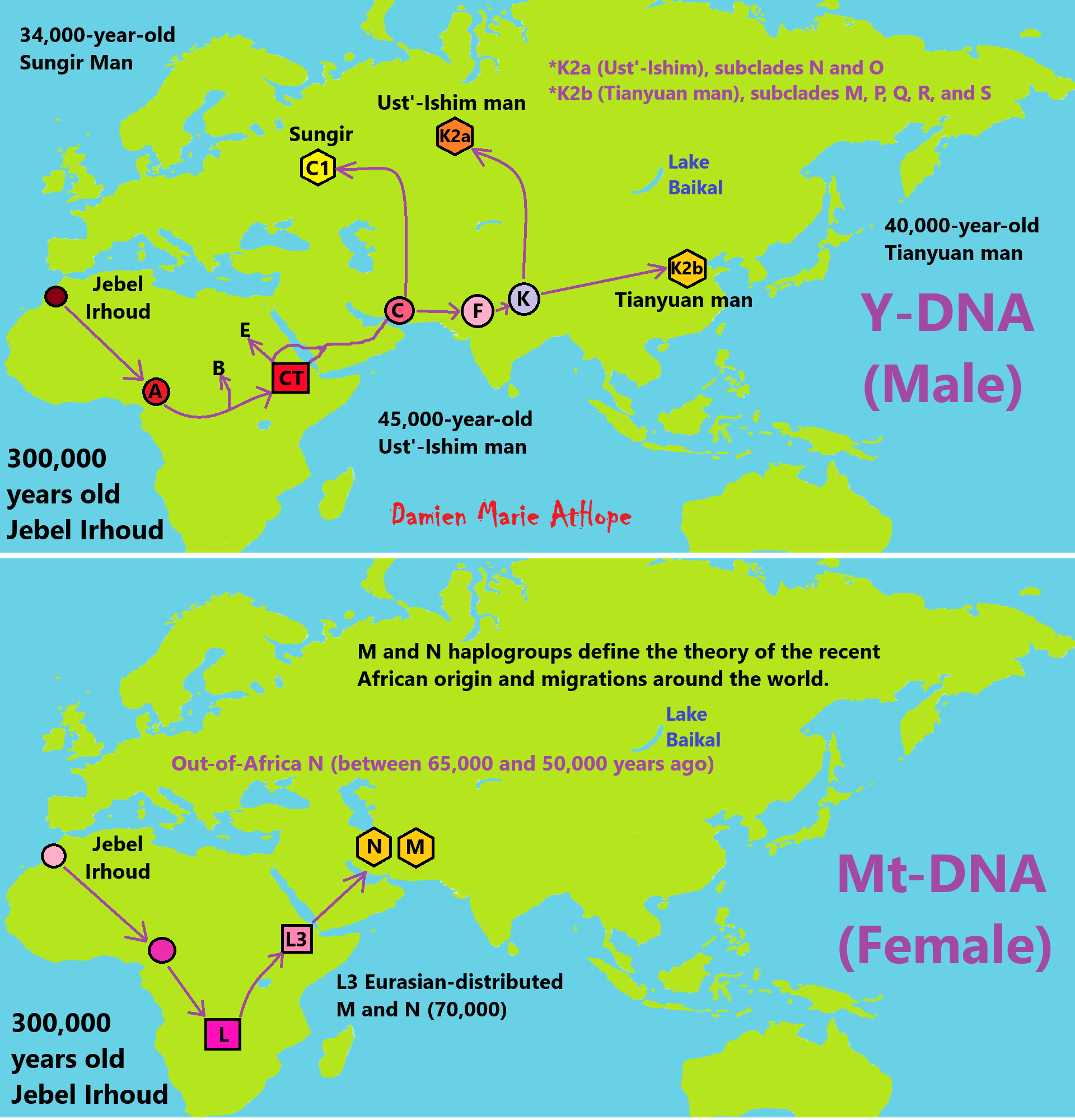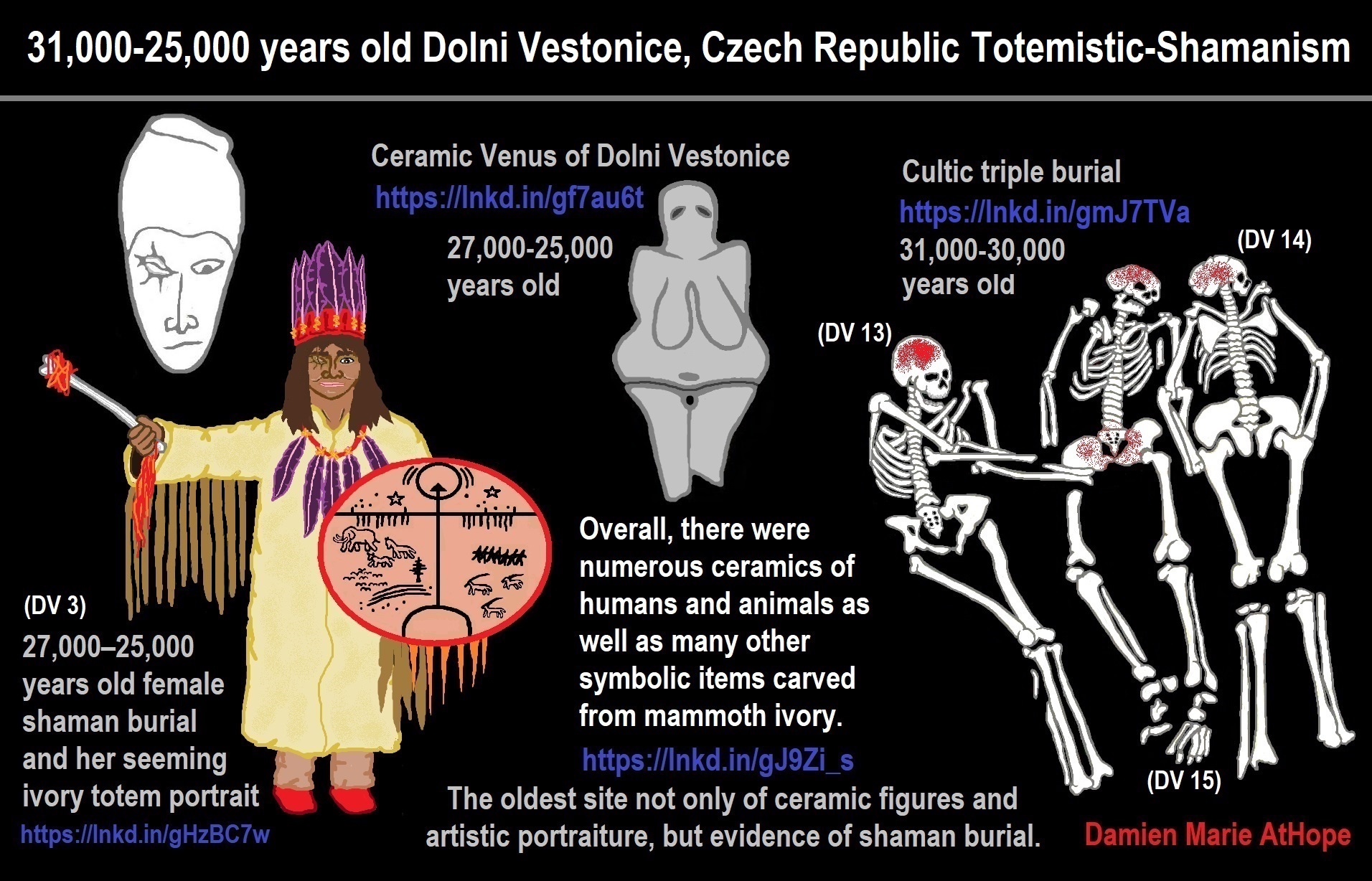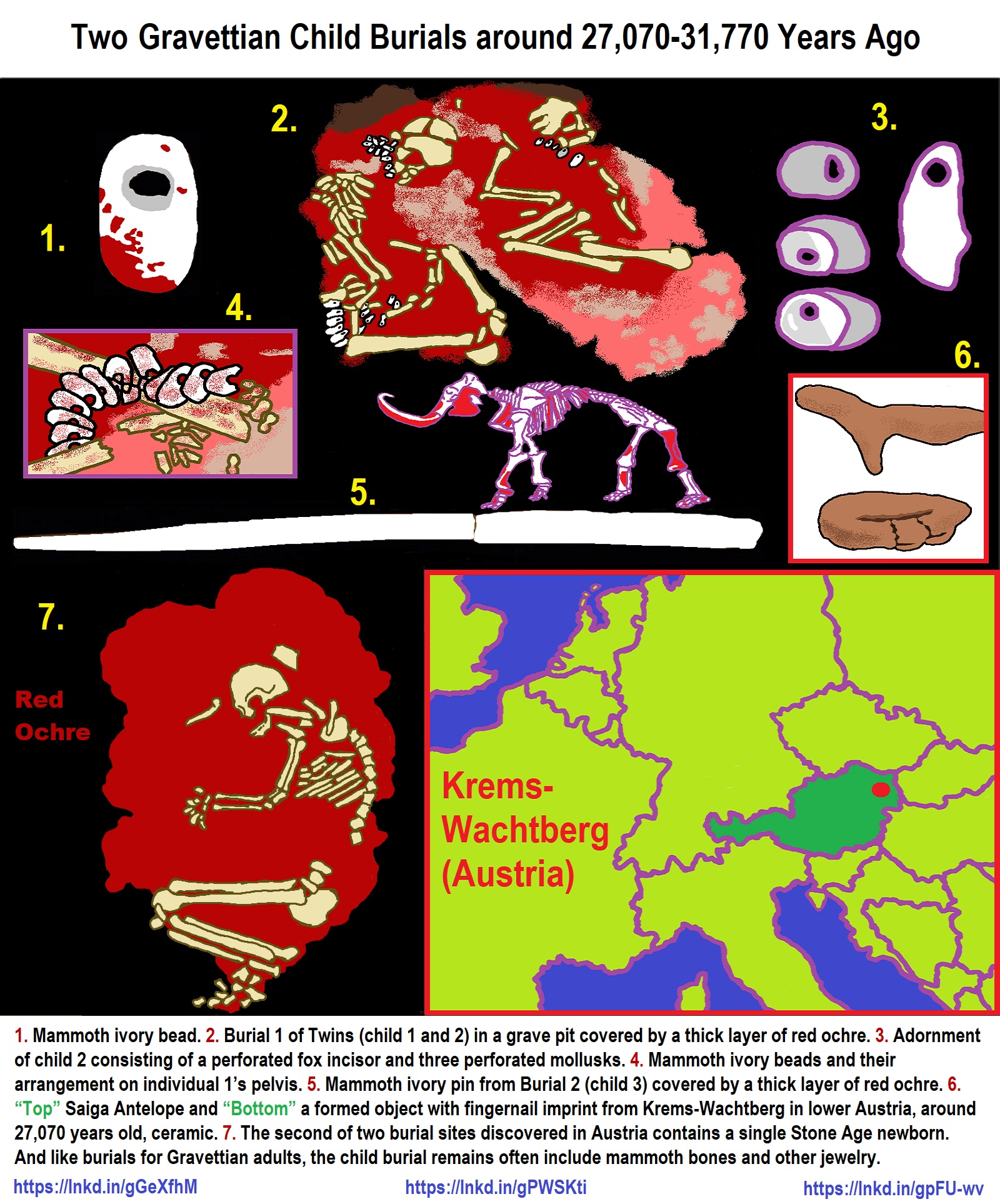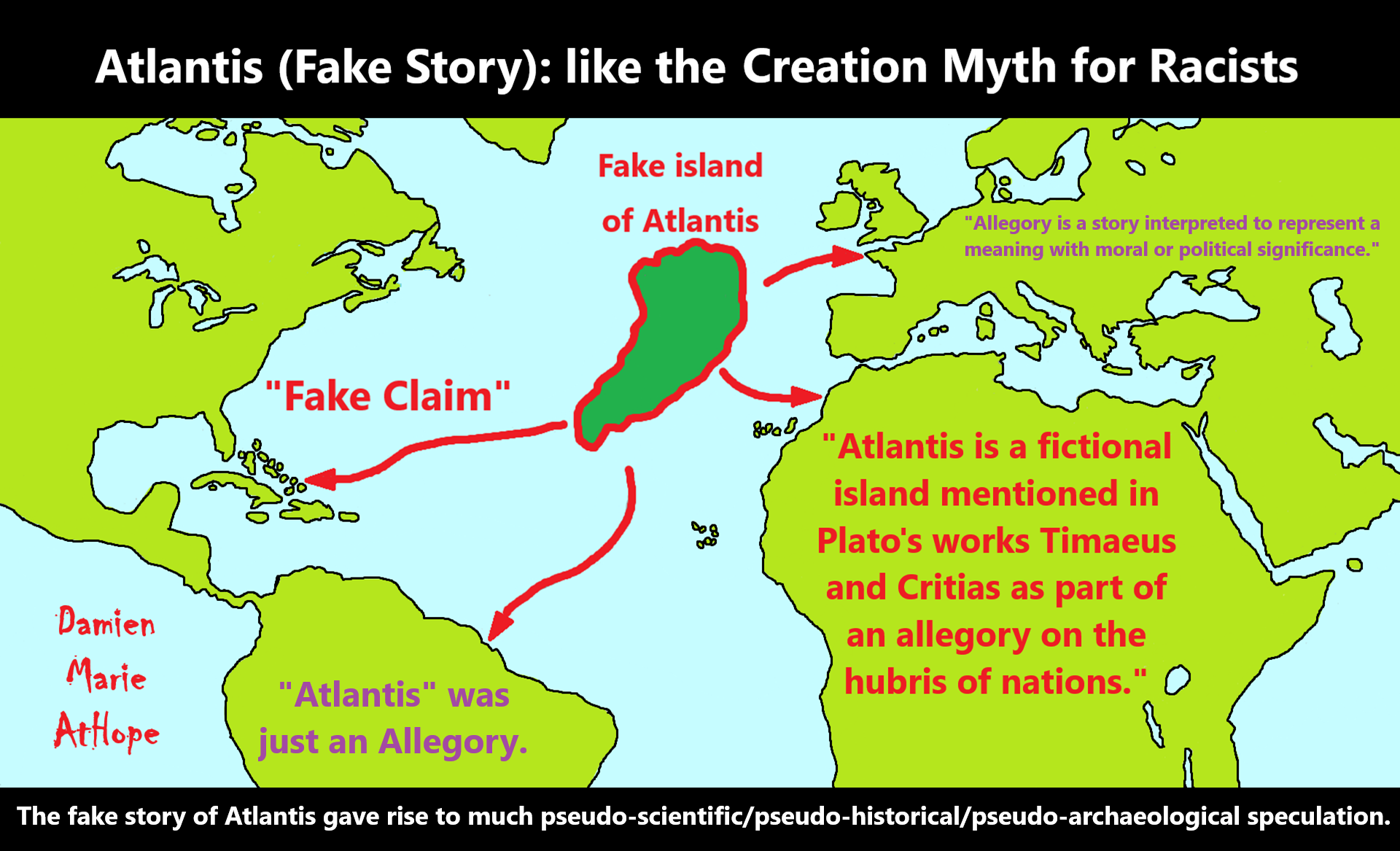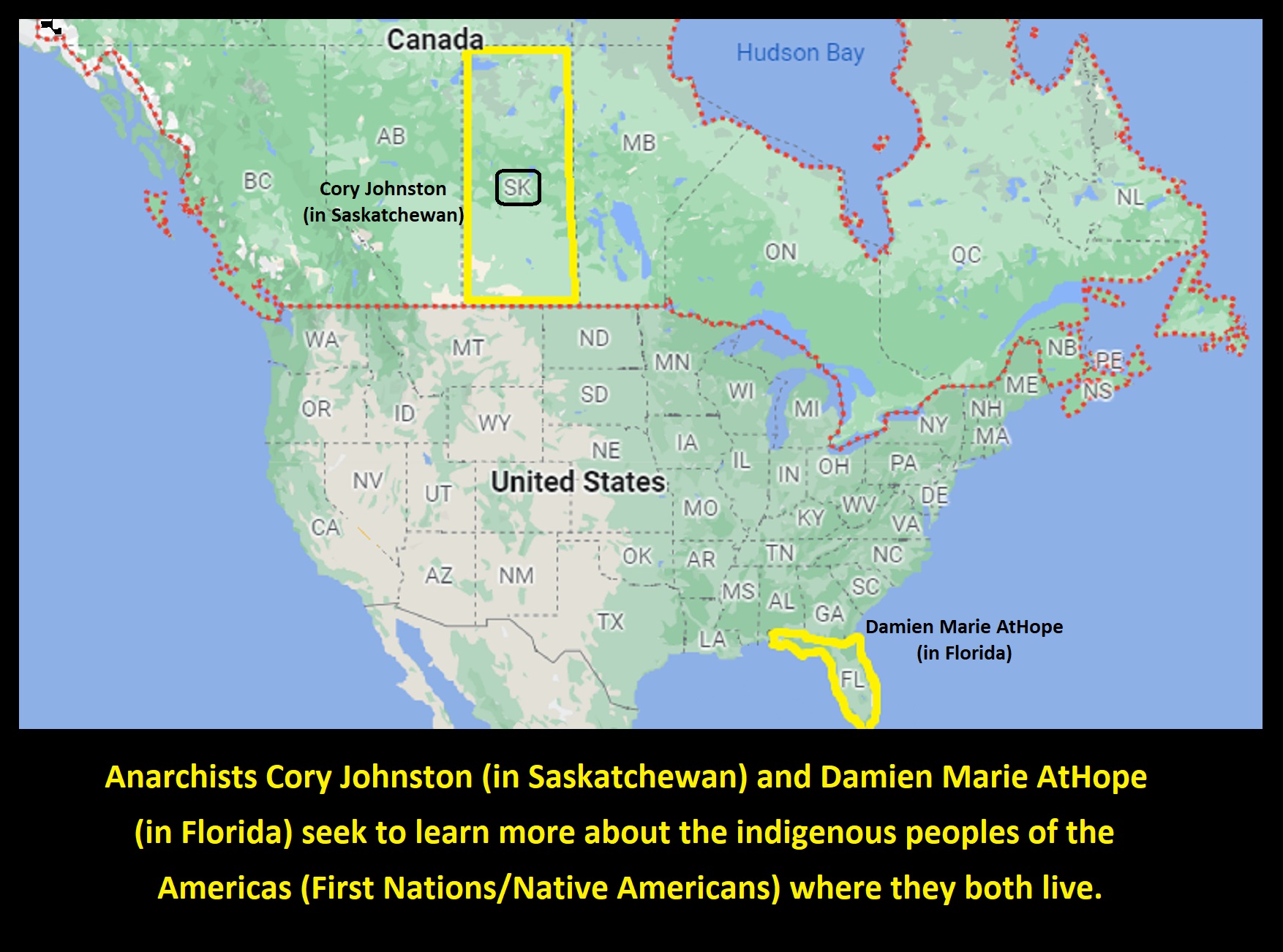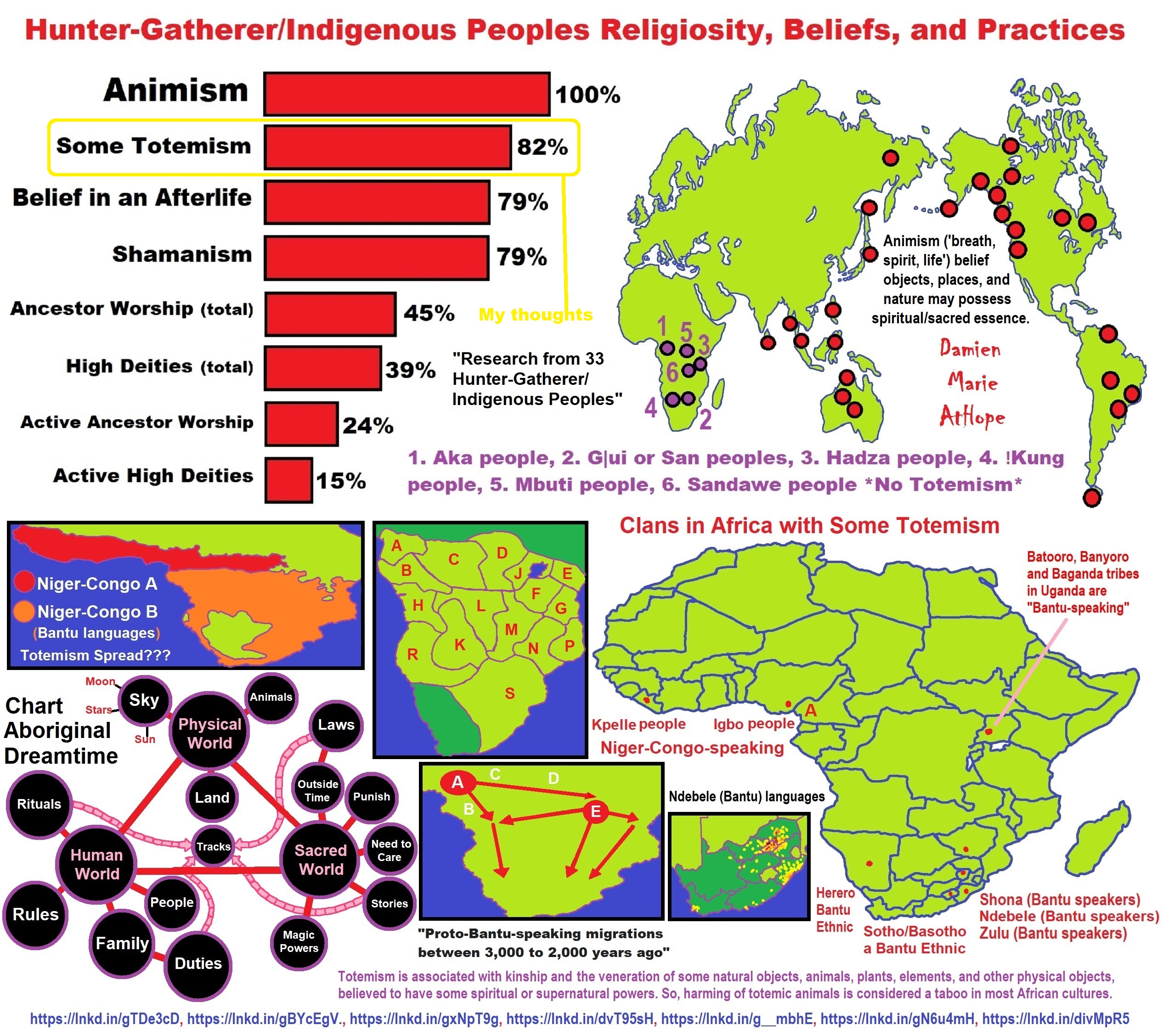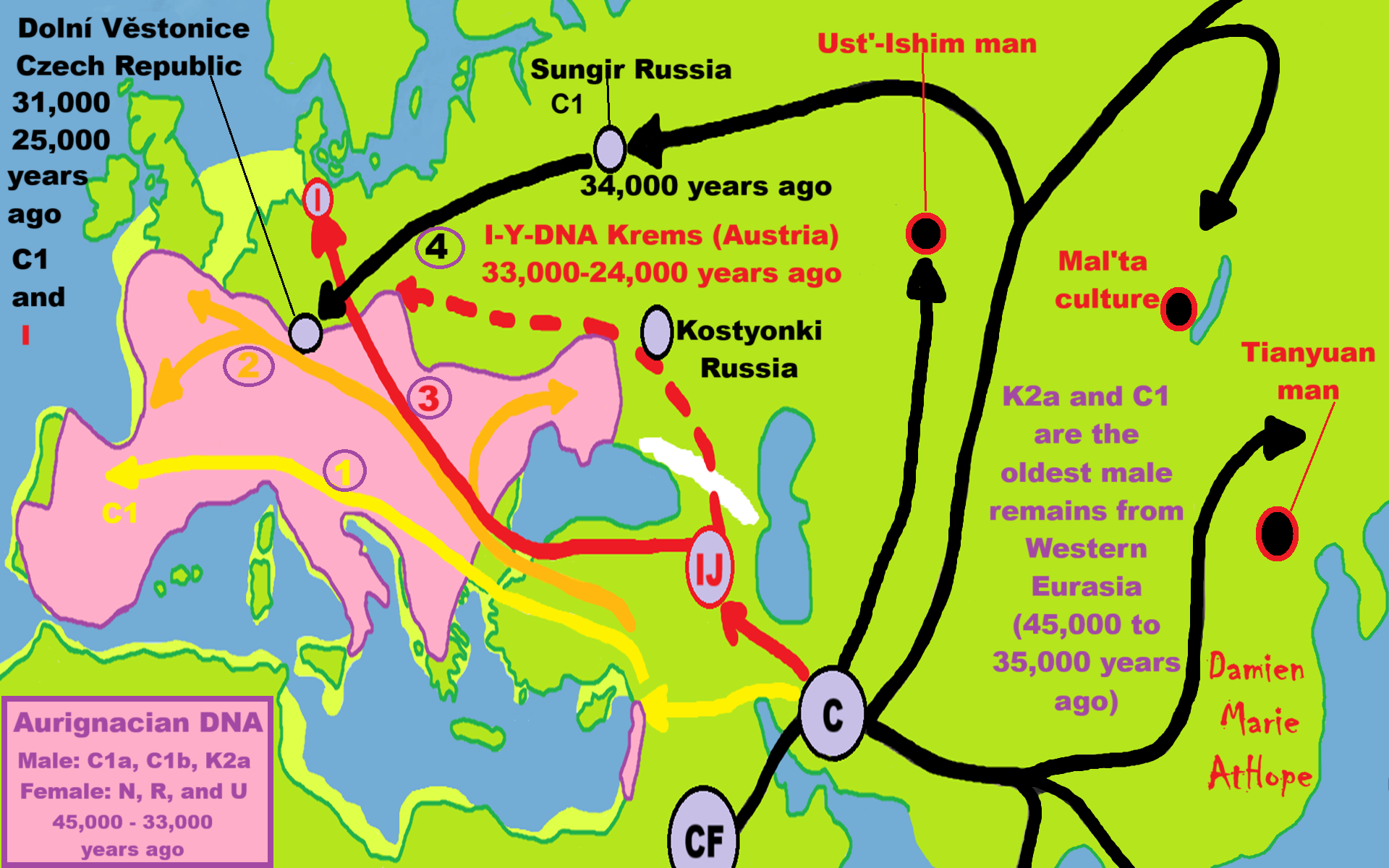
I received this message, and it inspired this blog post:
“Hello Damien, I’m a Spanish follower of yours. I discovered your artistic work online some time ago, and recently, I found you on “X.” First of all, I want to thank you for your amazing work and art; they have helped me a lot in understanding humanity’s past. I would like to ask you a question I’ve had for a while, and I believe you are the right person to help me solve it. Here’s the thing: I don’t understand the origin of the WHG and its relationship with Cro-Magnon. Is the WHG the evolution of Cro-Magnon? What Y-haplogroup did Cro-Magnon have? If they are not related, what is the origin of the WHG? Thank you very much in advance. Keep up the great work; you’re doing an excellent job! Greetings from the other side of the Atlantic!” – Commemtor
My response, Well, I don’t use the term “Cromagdon.” It is an outdated language from when people were not sure all humanity came from Africa or had bigoted ideas that Europeans came from Europe, not Africa. Cro-Magnons, now stated as “European early modern humans,” were the first early modern humans (Homo sapiens) to settle in Europe. I mainly use the “cultures,” such as the “Aurignacian culture,” an archaeological industry of the Upper Paleolithic associated with early European modern humans lasting from around 45,000 to 25,000 years ago. Or the “Gravettian culture,” an archaeological industry of the Upper Paleolithic associated with early European modern humans lasting from around 35,000 to 20,000 years ago.
They were an early movement of mainly Haplogroup C male DNA. Aurignacian samples are the paternal male haplogroups C1a, C1b, and K2a and female mt-DNA haplogroup M, N, R, and U. It is much more involved, and I will get to it all. The Aurignacian people with male Haplogroup C came from the Middle East through Turkey and the Balkans into France and Germany from 50,000 to 40,000 years ago. Then, a different branch and different culture, now called Gravettian culture, came from the Middle East into Siberia, then turned into East Europe and then Germany 30,000 to 25,000 years ago, male Haplogroup C but different from the Aurignacian culture branch. This was all before Western Hunter-Gatherers, who had yet a different culture and somewhat different DNA.
Western hunter-gatherers (also known as West European hunter-gatherers) date to around 15,000~5,000 years ago and are a distinct ancestral component of modern Europeans. Before them was yet another culture of Europe, Magdalenian refers to a prehistoric European cultural period and toolmaking industry that lasted from around 17,000 to 12,000 years ago. The three samples of Y-DNA included two samples of haplogroup I and one sample of HIJK. All samples of mtDNA belonged to U, including five samples of U8b and one sample of U5b. Western hunter-gatherers came in a different wave of migrations.
WHG-associated remains belonged primarily to the human Y-chromosome haplogroups I-M170 with a lower frequency of C-F3393 (specifically the clade C-V20/C1a2), which has been found commonly among earlier Paleolithic European remains such as Kostenki-14 and Sungir. Kostenki is in Russia, somewhat near the Caucasus Mountains. Sungir is in Russia, somewhat near Moscow. So, migrations from Eastern Europe have DNA similar to that of Aurignacian culture.
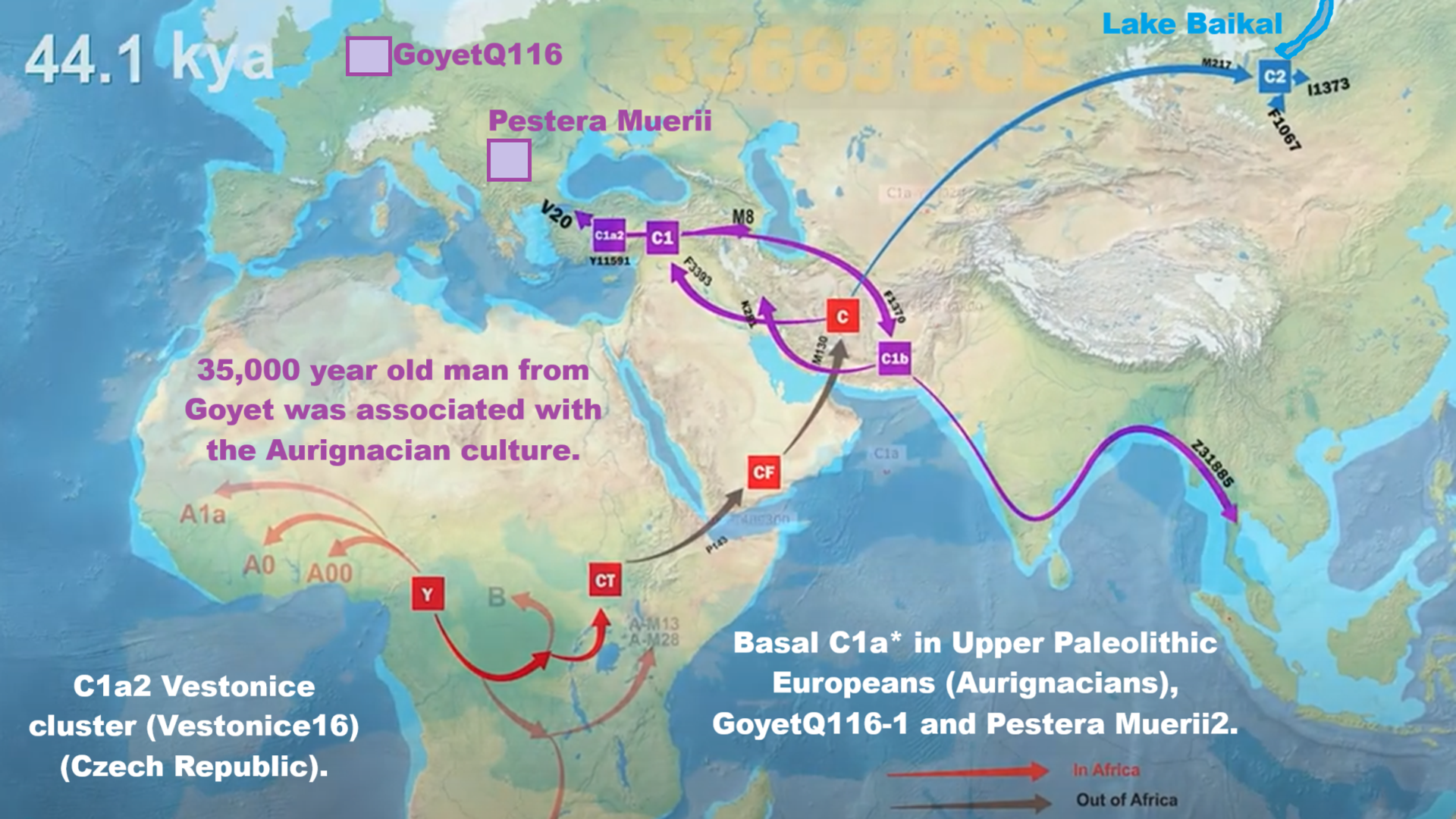
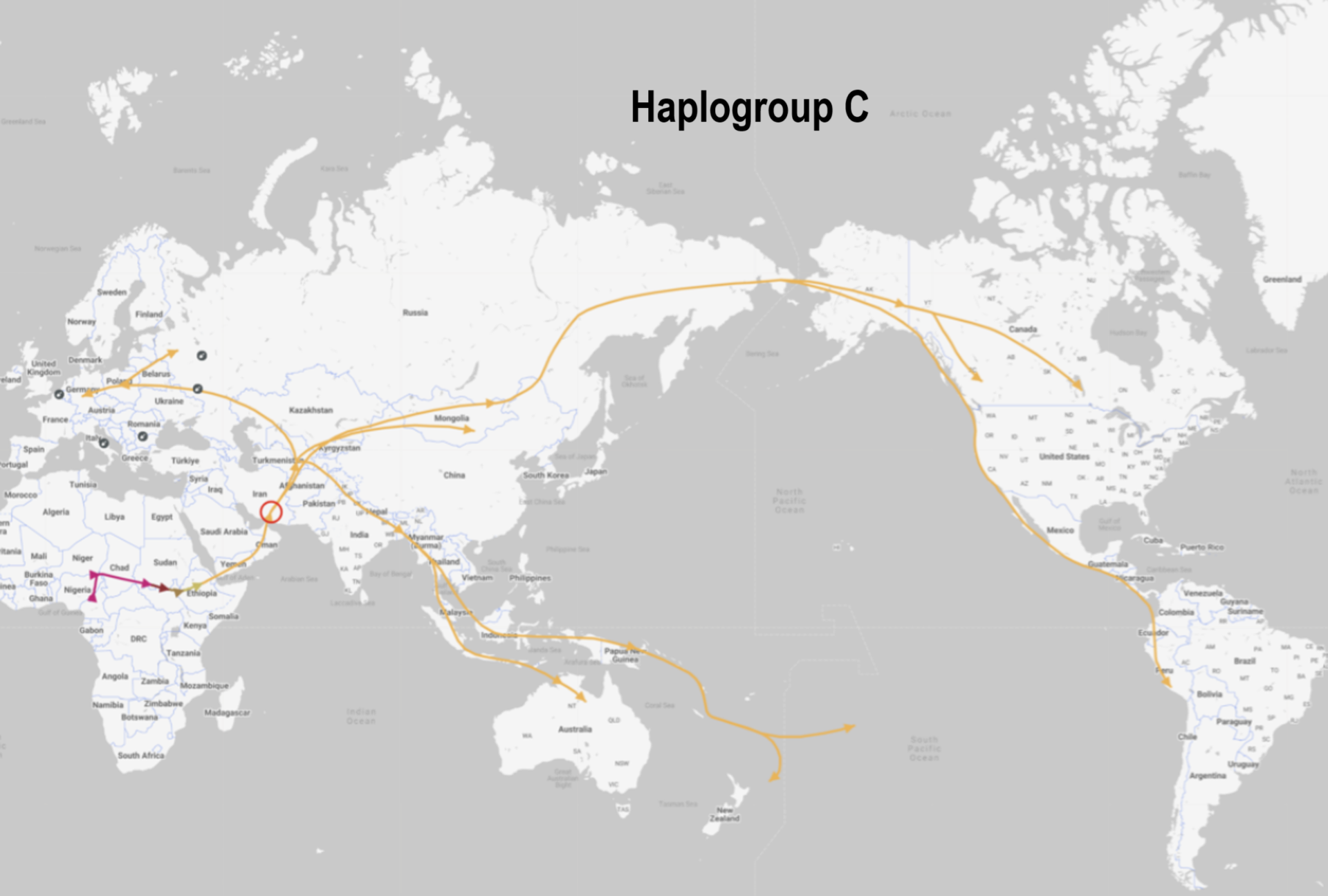
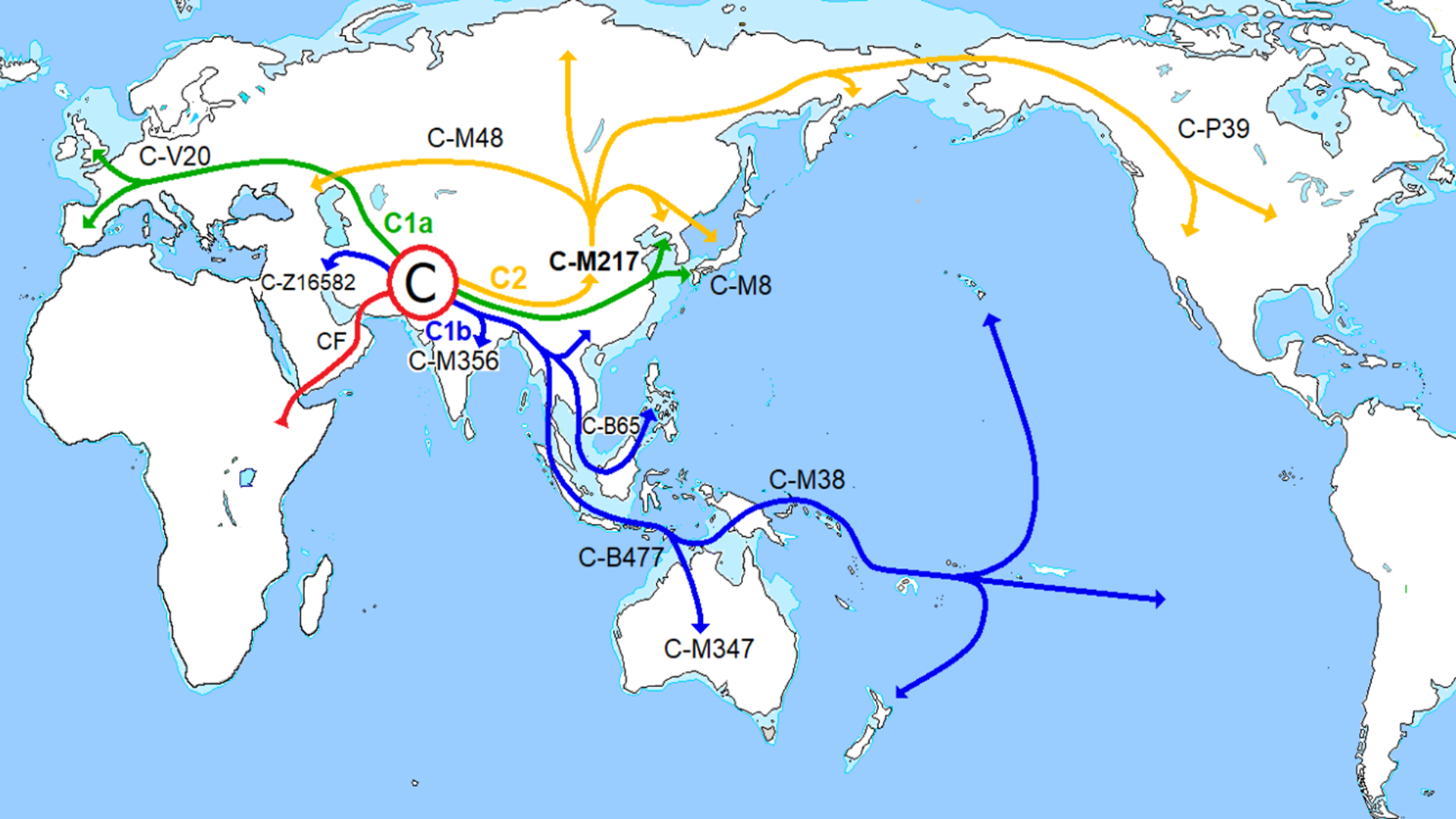
“Haplogroup C is a major Y-chromosome haplogroup, is one of two primary branches of Haplogroup CF alongside Haplogroup F. Haplogroup C is found in ancient populations on every continent except Africa and is the predominant Y-DNA haplogroup among males belonging to many peoples indigenous to East Asia, Central Asia, Siberia, North America, and Australia as well as a some populations in Europe, the Levant, and later Japan. In addition to the basal paragroup C*, this haplogroup now has two major branches: C1 (F3393/Z1426; previously CxC3, i.e. old C1, old C2, old C4, old C5 and old C6) and C2 (M217; the former C3). Basal C1a* (CTS11043) was found in the Upper Paleolithic European (Aurignacian), GoyetQ116-1. C1b was identified in prehistoric remains, dating from 34,000 years BP, found in Russia and known as “Kostenki 14.” C-V20 (C1a2; previously C6) is found at low frequencies amongst Europeans. In 2016, a 35,000-year-old remains of a hunter gatherer from the Goyet Caves (Namur, Belgium) and a 30,000-year-old remains of a hunter gatherer from Dolni Vestonice (Vestonice16, Moravia, Czech Republic) were found with this haplogroup.” ref
“Basal C1a* (CTS11043) was found in an Upper Paleolithic Europeans (Aurignacians), GoyetQ116-1 and Pestera Muerii2. C1a2 was present in the remains in Europe by the Upper Paleolithic, including the Vestonice cluster (Vestonice16) (i.e. remains found in the modern Czech Republic). It was also found in the 7,000-year-old (Mesolithic) remains of a WHG (Western Hunter-Gatherers) known as “La Braña 1”, found in La Braña-Arintero, León, Spain. La Braña 1 was part of the so-called Villabruna cluster, named after a site in northeast Italy. By the time of the Villabruna cluster, however, the dominant Y-DNA haplogroup in Western Europe was I2. (And the balance was again altered by the mass migrations into Europe of Neolithic Middle Eastern farmer and Bronze Age Indo-Europeans.) further: a male from the Great Hungarian Plain, approximately contemporaneous to the La Braña man also carried it, as did the 30,000-year-old remains of a Vestonice Cluster hunter-gatherer from the Pavlov-Dolní Věstonice area (Czech Republic), as well as a 34,000 years old Russian hunter gatherers from Sungir (Sunghir 1/2/3/4). Basal C1b* (F1370) has been identified in the remains of an individual known as Kostenki-14 who died circa 37,000 years BP (Upper Paleolithic) that was found at the Kostyonki archaeological site in western Russia. It has also been found in a small number of males from the Middle East.” ref
K2 Y-DNA
“Ust’-Ishim man“ – the name given to 45,000-year-old remains of one of the early modern humans to inhabit western Siberia. The fossil was named after the Ust’-Ishim District of Siberia, where it had been discovered. Until 2016, Ust’-Ishim man was classified as belonging to Haplogroup K2*. Likewise, “Oase-1“, the remains of an individual who lived approximately 37,800 years ago, in Eastern Europe (modern Romania). Research by Poznik et al. (2016) suggests that Oase 1 Y-DNA belongs to haplogroup K2a*. That is, Oase 1 possesses SNPS similar to Ust’-Ishim man (also K2a*), 45,000-year-old remains from Siberia. After “Oase 1”, the next closest genetic affinity for “Oase 2” among ancient DNA samples is the c. 40kya Tianyuan man from Northern China. Neither “Oase 2” nor “Oase 1″ are particularly close genetically to any modern human populations.” ref, ref, ref
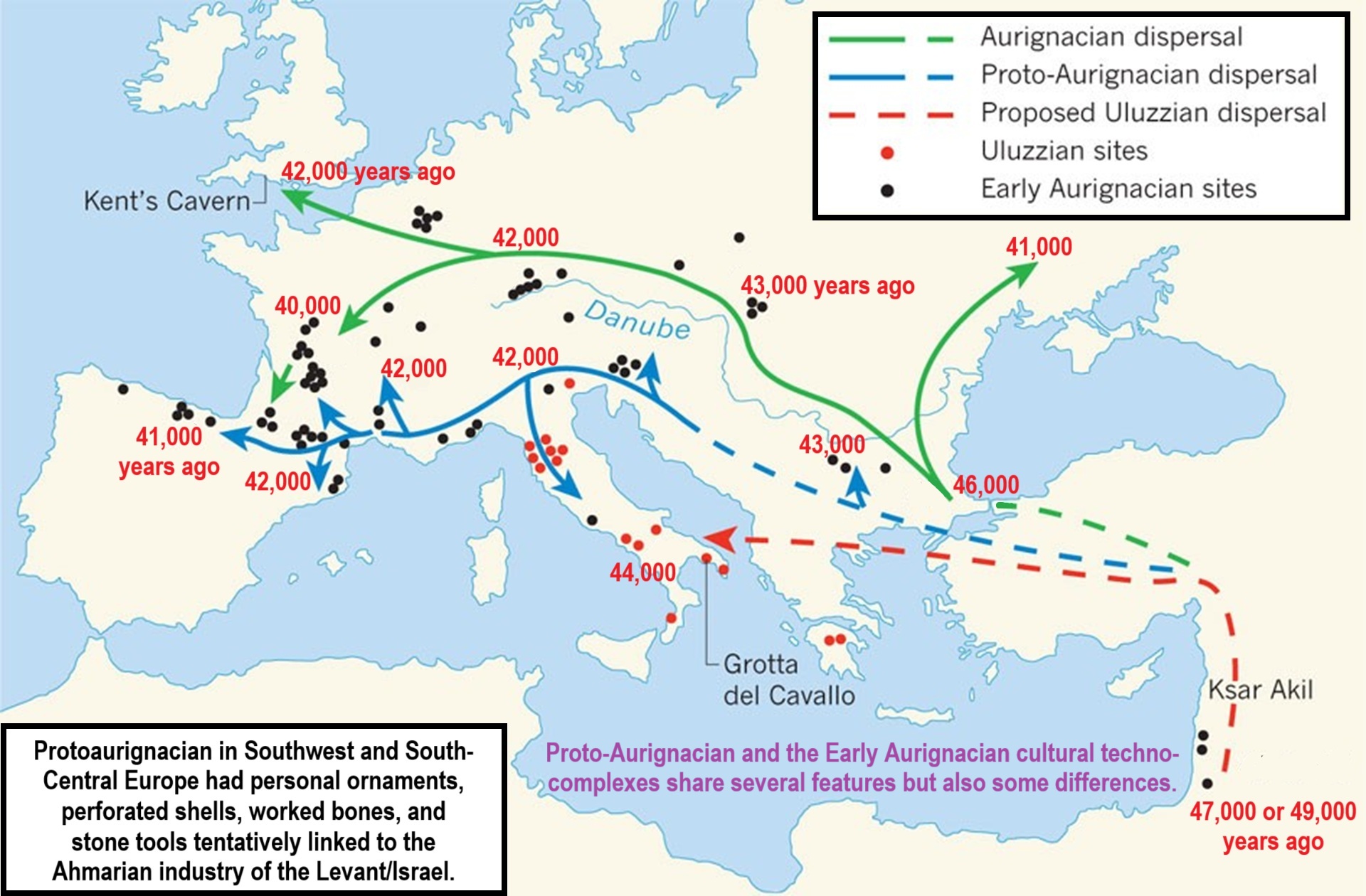
Ksar Akil in Lebanon
“Transitional/Initial Upper Palaeolithic, Ahmarian Northern Facies, Levantine Aurignacian. Excavations showed occupational deposits reaching down to a depth of 23.6 m (77 ft) with one of the longest sequences of Paleolithic flint industries ever found in the Middle East. The first level of 8 m (26 ft) contained Upper Levallois–Mousterian remains with long and triangular Lithic flakes. The level above this showed industries accounting for all six stages of the Upper Paleolithic.” ref
“The Ahmarian culture was a Paleolithic archeological industry in the Levant dated at 46,000–42,000 years ago and thought to be related to Levantine Emiran and younger European Aurignacian cultures. The word “Ahmarian” was adopted from the archaeological site of Erq el-Ahmar (also written Erk el Ahmar), West Bank, Palestine, a rockshelter in the Judean Desert in the northern Dead Sea Rift. The Ahmarian period together with the Emiran period, both from the Levant, are among the first periods of the Upper Paleolithic, corresponding to the first stages of the expansion of Homo sapiens out of Africa. From this stage, the first modern humans migrated to Europe to form the beginning of the European Upper Paleolithic, including the Aurignacian culture, where they were previously known as the Cro-Magnons or now known as European early modern humans (EEMH) were the first early modern humans (Homo sapiens) to settle in Europe.” ref, ref
“The European Bohunician culture, probably linked to the Emiran and Ahmarian, may slightly predate the Ahmarian at 48,000 years ago. There is also a claim that it is roughly contemporary with the Aurignacian and the Gravettian cultures of Europe, all emerging prior to the Atlitian, which was also contemporary with the Solutrean and Magdalenian cultures of Western Europe. Ahmarian technology, which included the complex of blade/bladelet-knapping techniques is also linked to the tools used by the hunter-gatherers of southwestern Asia. The Bohunician industry was a Paleolithic archeological industry in South-Central and Eastern Europe. The artifacts assigned to this culture are dated between roughly 48,000 and 40,000 years ago. They were found at the type site of Brno-Bohunice, Stránská skála (Moravia), Bacho Kiro and Temnata Cave (Bulgaria), Dzierzyslaw (Poland), and others. The Bohunician is “transitional” between the Mousterian and the Aurignacian, and thus a candidate for representing the first wave of anatomically modern humans in Europe.” ref, ref
“It is assumed to be one of the earliest known sites containing Upper Paleolithic technologies including Ahmarian cultural objects. Artifacts recovered from the site include Ksar Akil flakes, the main type of tool found at the site, along with pierced shells and chipped edge modifications that suggest these have been used as pendants or beads. This indicates that the inhabitants were among the first in Western Eurasia to use personal ornaments. Results from radiocarbon dating indicate that the early humans may have lived at the site approximately 45,000 years ago or earlier. The presence of personal ornaments at Ksar Akil is suggestive of modern human behavior. The findings of ornaments at the site are contemporaneous with ornaments found at Late Stone Age sites such as Enkapune Ya Muto.” ref
Levantine Aurignacian
“Carving of a horse with traces of ocher painting; 40,000-18,500 years ago; from the Hayonim Cave, Aurignacian. Israel Museum (Jerusalem) This may be one of the earliest known manifestations of human art, together with the ocher pieces of Blombos Cave, before the outpouring of parietal art in Europe. Similarities with Aurignacian are found in the manufacture of blades and in the processing of bone tools. The Levantine Aurignacian follows chronologically the Emiran and Early Ahmarian in the same area of the Near East, and closely related to them.” ref
“The Levantine Aurignacian (35,000-29,000 to 32,000-26,000 years ago is an Upper Paleolithic culture of the Near-Eastern Levant that evolved from the Emiran culture. It was named so because of the similarity of stone tools with the Aurignacian culture in Europe. The Levantine Aurignacian used to be called Lower and Upper Antelian in old sources, from the site of Wadi Antelias in Lebanon. The most important innovation in this period is the incorporation of some typical elements of Aurignacian, like some types of burins and narrow blade points that resemble the European type of Font-Yves.” ref
“The Levantine Aurignacian is part of the technological shift from the Middle Paleolithic to the Upper Paleolithic, but the arrival of modern humans Homo sapiens in the Levant still predates the Levantine Aurignacian by tens of thousands of years. The earliest Upper Paleolithic entity is the local Ahmarian, with the first full-fledged blade/bladelet technology, to which the Levantine Aurignacian succeeds, possibly after a few thousand years of co-existence. The Emiran period and the Ahmarian period form the very first periods of the Upper Paleolithic, corresponding to the first stages of the expansion of Homo sapiens out of Africa. From this stage, the first modern humans probably migrated to Europe to form the beginning of the European Upper Paleolithic, including the Aurignacian culture. There is a possibility that the Levantine Aurignacian was the result of reverse influence from the European Aurignacian, but this remains unsettled.” ref
Aurignacian
“The Aurignacians are part of the wave of anatomically modern humans thought to have spread from Africa through the Near East into Paleolithic Europe, and became known as European early modern humans, or Cro-Magnons. This wave of anatomically modern humans includes fossils of the Ahmarian, Bohunician, Aurignacian, Gravettian, Solutrean and Magdalenian cultures, extending throughout the Last Glacial Maximum (LGM), covering the period of roughly 48,000 to 15,000 years ago. In terms of population, the Aurignacian cultural complex is chronologically associated with the human remains of Goyet Q116-1, while the subsequent eastern Gravettian is associated with the Vestonice cluster. Aurignacian figurines have been found depicting faunal representations of the time period associated with now-extinct mammals, including mammoths, rhinoceros, and tarpan, along with anthropomorphized depictions that may be interpreted as some of the earliest evidence of religion.” ref
“In a genetic study published in Nature in May 2016, the remains of an early Aurignacian individual, Goyet Q116-1 from modern-day Belgium, were examined. He belonged to the paternal haplogroup C1a and the maternal haplogroup M. Haplogroups identified in other Aurignacian samples are the paternal haplogroups C1b and K2a; and mt-DNA haplogroup N, R, and U. The Aurignacian material culture is associated with the expansion of ‘early West Eurasians’ during the Upper Paleolithic (UP), replacing or merging with previous Initial Upper Paleolithic (IUP) cultures to which possibly relates the European Châtelperronian. Evidence for at least some IUP legacy among later UP Europeans is the presence of Ancient East Eurasian ancestry (c. 23%) among the GoyetQ116-1 specimen, possibly represented by the preceding Bacho Kiro cave specimen, who, together with the Oase specimens, are closer to ancient and modern East Eurasian populations.” ref
“A 2023 study found that the Aurignacians are closely related to the Gravettians, Solutreans and later Magdalenians. Gravettian-producing peoples belonged to two genetically distinct clusters. Fournol in the west (France and Spain) and Věstonice in the east (Czech Republic, Poland, Austria, and Italy), both tracing their descent from producers of the earlier Aurignacian culture. The Aurignacian, Gravettian, and Solutrean cultures would merge and give rise to the Magdalenian culture. The genes of seven Magdalenians, the El Miron Cluster in Iberia, showed a close relationship to the Aurignacian population that lived in northern Europe some 20,000 years earlier. The analyses suggested that 70-80% of the ancestry of these individuals was from the population represented by Goyet Q116-1, associated with the Aurignacian culture.” ref
“The Upper Paleolithic Aurignacian, Gravettian, Solutrean and Magdalenian cultures, became subsequently absorbed by the Epigravettian wave from Western Asia (Anatolia). In a genetic study published in Nature in March 2023, the authors found that the ancestors of the Western Hunter-Gatherers (WHGs) were populations associated with the Epigravettian culture, which largely replaced populations associated with the Magdalenian culture about 14,000 years ago, and which were more closely related to ancient and modern peoples in the Middle East and the Caucasus than earlier European Cro-Magnons.” ref
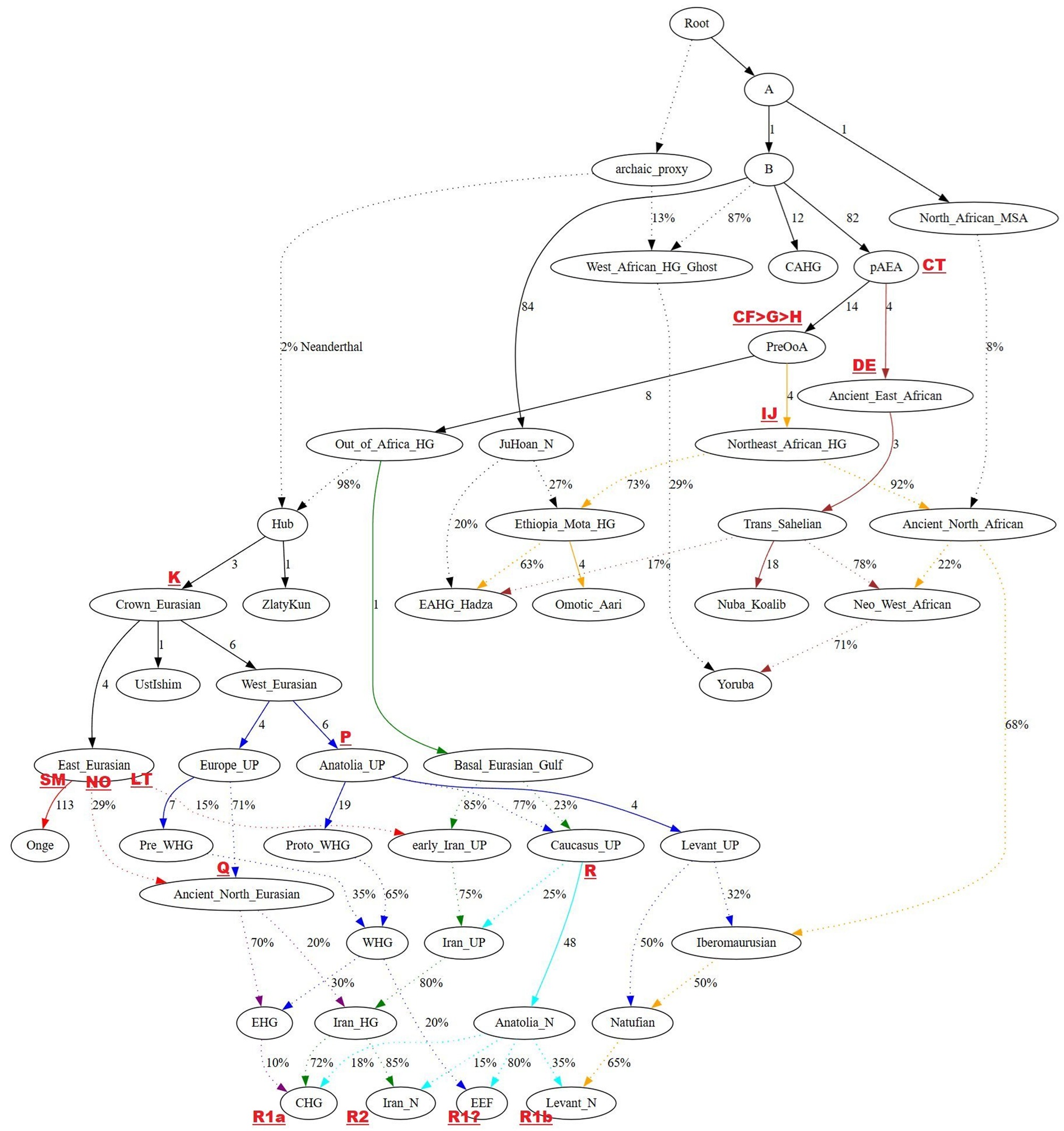
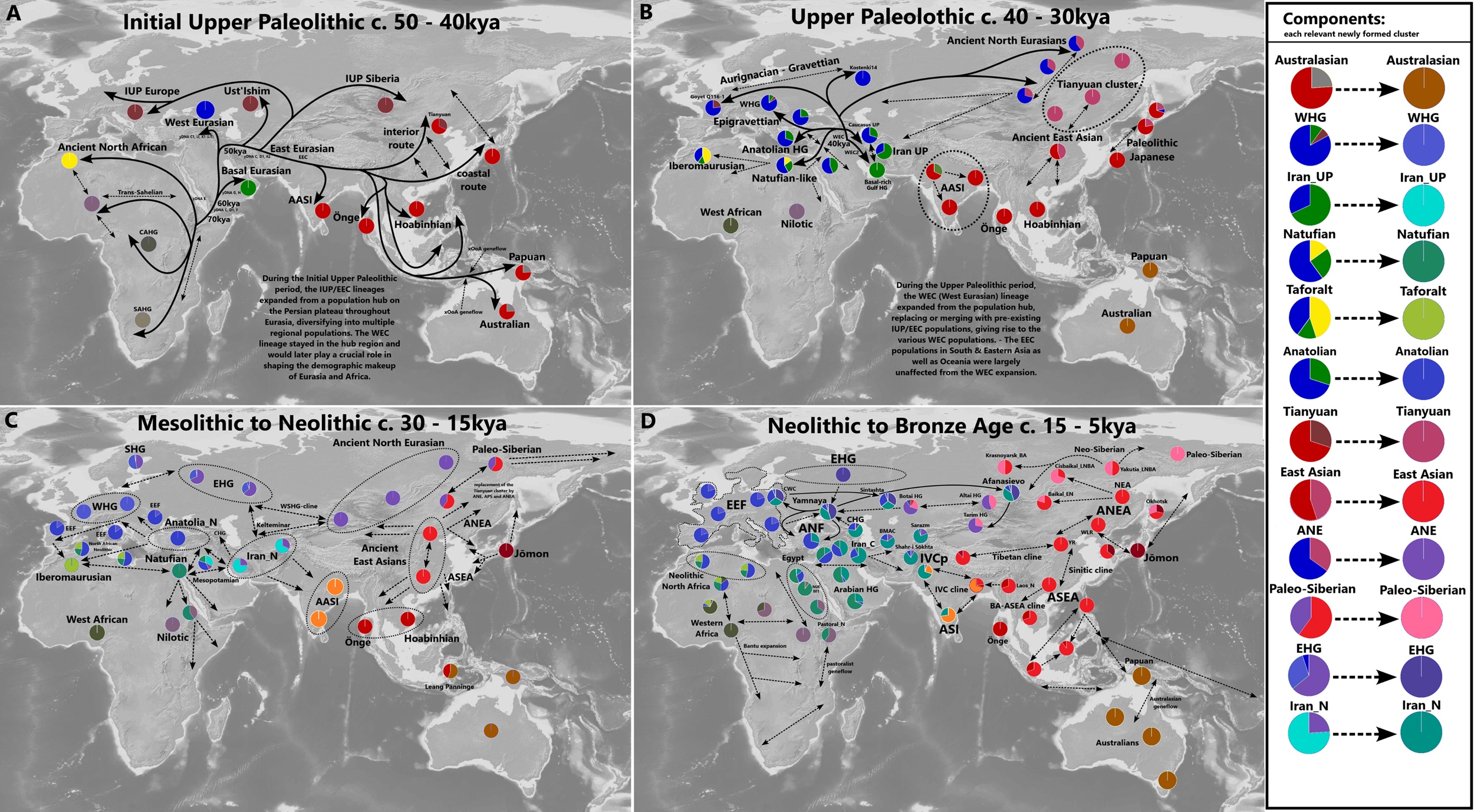
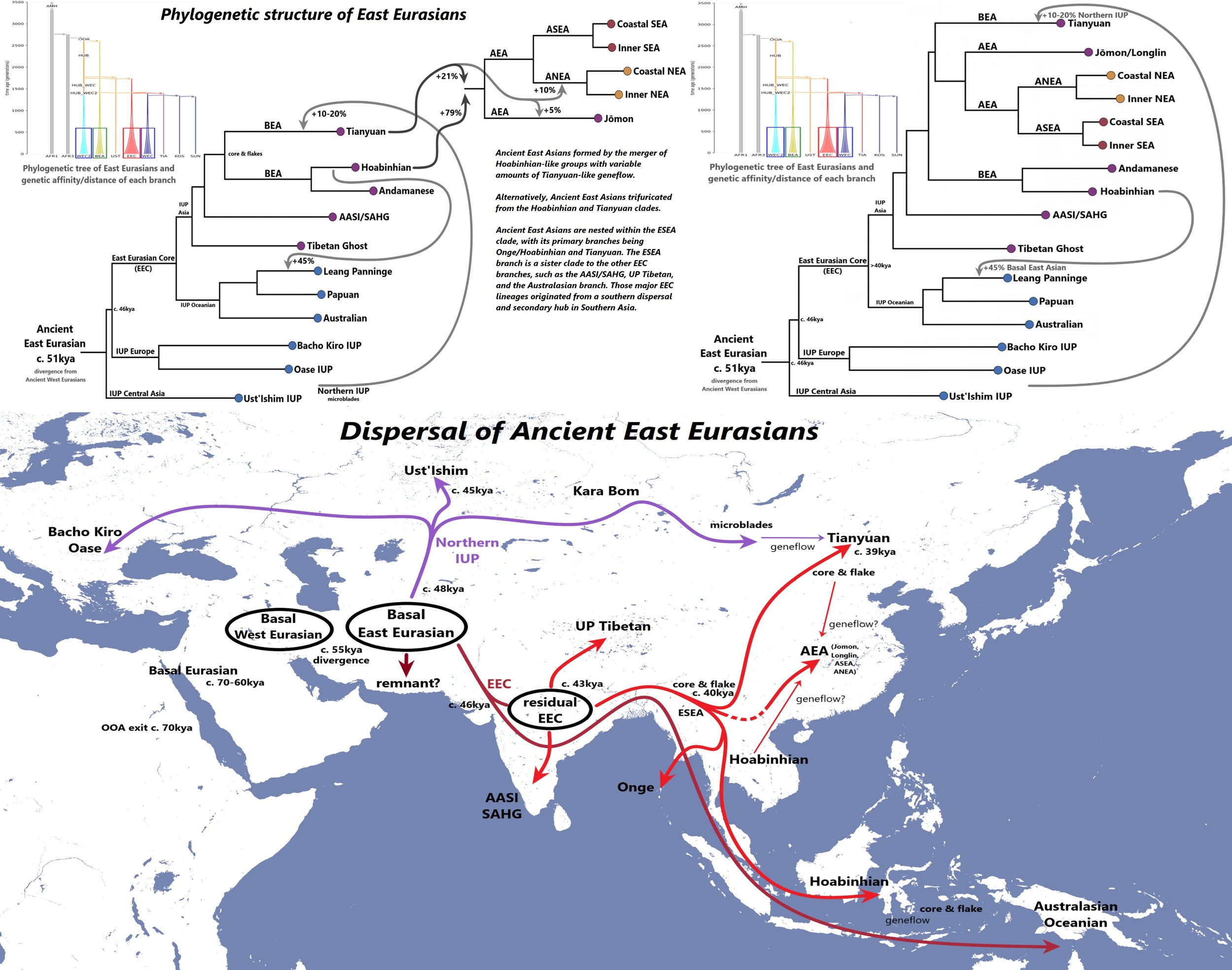
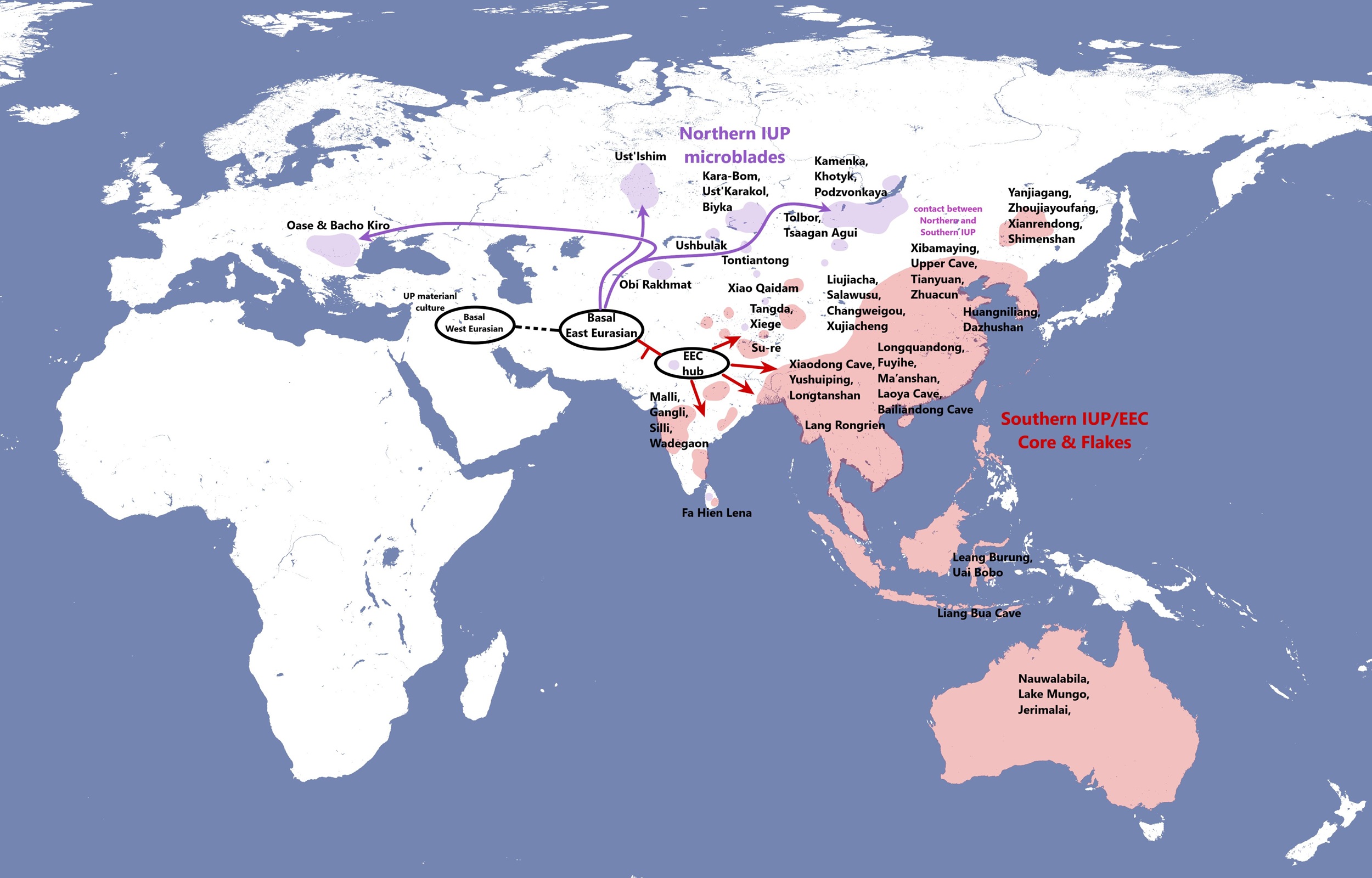
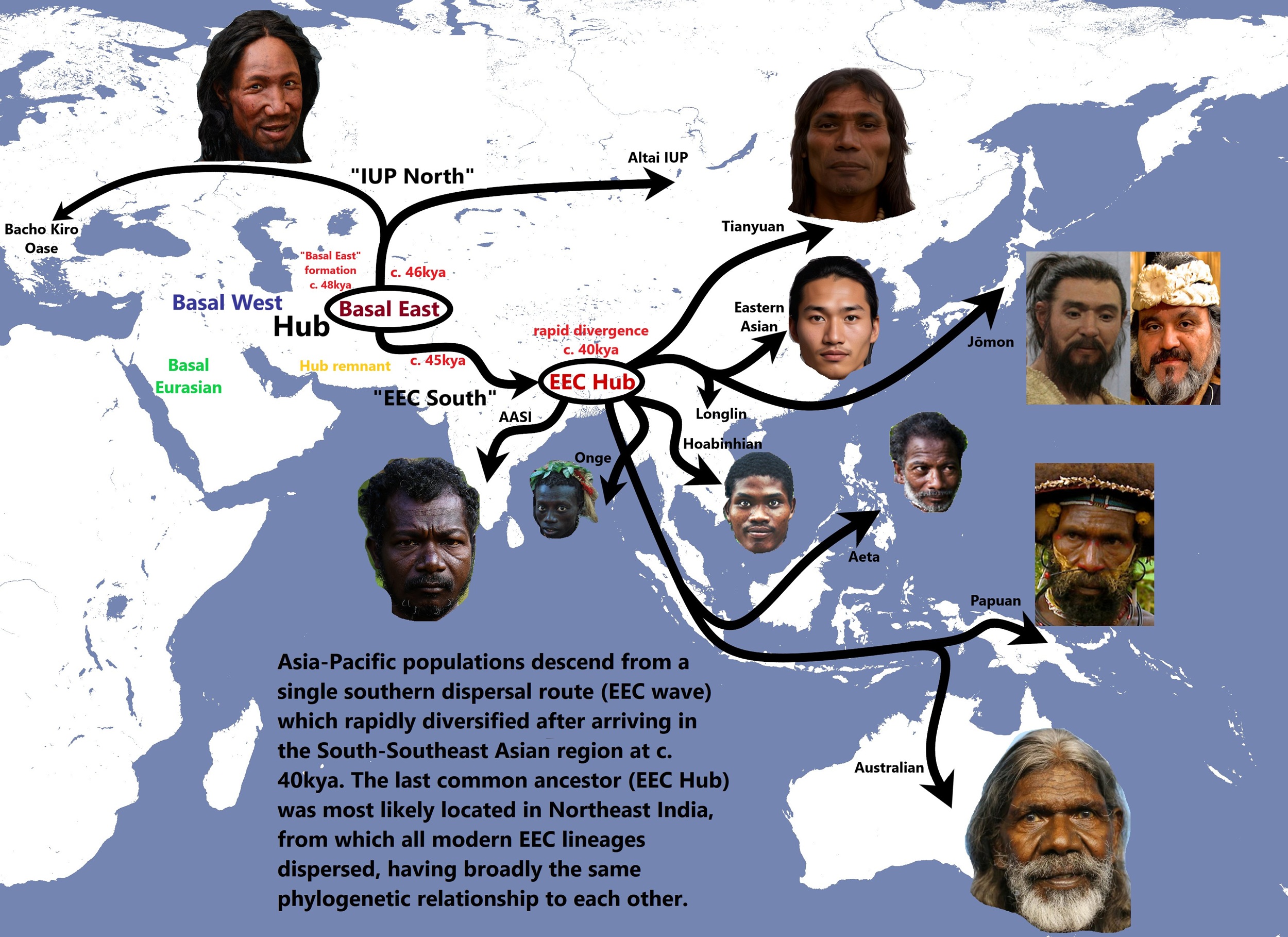
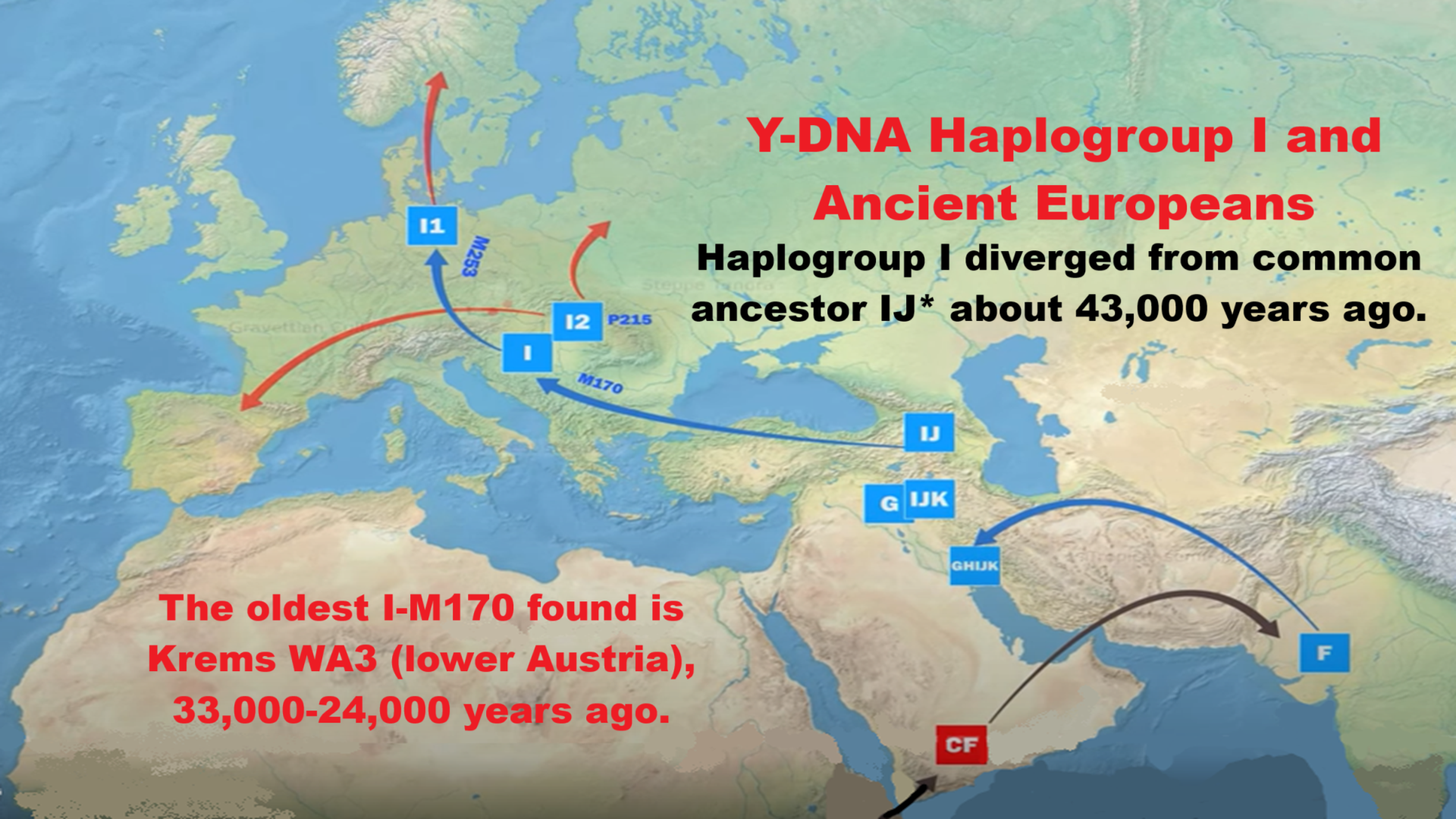
Haplogroup IJ
“Haplogroup IJ (M429/P125) is a human Y-chromosome DNA haplogroup, an immediate descendant of Haplogroup IJK (formerly known as Haplogroup F-L15). IJK is a branch of Haplogroup HIJK. The immediate descendants of IJ are Haplogroup I and Haplogroup J. Its sole sibling is K (which includes most of the world’s male population). Haplogroup IJ derived populations account for a significant proportion of the pre-modern populations of Europe (especially Scandinavia and the Balkans), Anatolia, the Caucasus, the Middle East (especially Arabia, Levant and Mesopotamia) and coastal North Africa. As a result of mass migrations during the modern era, they are now also significant in The Americas and Australasia.” ref
“Haplogroup I appears to have arisen in Europe, so far being found in Palaeolithic sites throughout Europe, but not outside it. It diverged from common ancestor IJ* about 43,000 years ago. Early evidence for haplogroup J has been found in the Caucasus and Iran. In addition, living examples of the precursor Haplogroup IJ* have been found only in ethnicities living in modern day Iran. This may indicate that IJ originated in West Asia. A 2008 estimate suggested that the most recent common ancestor of haplogroup IJ could have lived 30,500–46,200 years ago, while another estimate suggests 43,000–45,700 years. Both of the primary branches of haplogroup IJ – I-M170 and J-M304 – are found among modern populations of the Caucasus, Anatolia, and Southwest Asia. This tends to suggest that Haplogroup IJ branched from IJK in West Asia, Caucasus, and/or the Middle East.” ref
“Examples of the basal/paragroup Haplogroup IJ* (M429) were first reported in a 2012 study of genetic diversity in Iran, by Grugni et al. These individuals were reported to be positive for M429 and negative for the SNPs M170 and M304, which define haplogroup I and haplogroup J respectively. However, because the researchers filtered for relatively few SNPs, these individuals may have carried less well-known SNPs equivalent to M170 and M304. Given the limited scope of the testing – and the small number of haplogroup IJ samples that were discovered – few firm conclusions have yet been drawn.” ref
“An inference may also be made that both IJ (M429) and its sole sibling, Haplogroup K (M9) diverged from the parent Haplogroup IJK closer to the Caucasus and the Middle East than to East Asia, due to the evolutionary distance of IJK from its direct ancestor, haplogroup HIJK. IJ split in a typically disjunctive, almost mutually-exclusive geographical pattern, with J-M304 far more common in the Caucasus, and I-M170 far more common in Europe; the age of IJ and its subclades suggest that IJ probably entered Europe through the Balkans, some time before the last glacial maximum (about 26,500 years ago). I1 Typical of populations of Scandinavia and Northwest Europe, with a moderate distribution throughout Eastern Europe.” ref
Haplogroup I-M170
“Possible time of origin is ~42,900 Years ago. Haplogroup I (M170) is a Y-chromosome DNA haplogroup. It is a subgroup of haplogroup IJ, which itself is a derivative of the haplogroup IJK. Subclades I1 and I2 can be found in most present-day European populations, with peaks in some Northern European and Southeastern European countries. Haplogroup I most likely arose in Europe, with it so far found in Palaeolithic sites throughout Europe, but not outside it. It diverged from common ancestor IJ* about 43,000 years ago. Early evidence for haplogroup J has been found in the Caucasus and Iran. In addition, living examples of the precursor Haplogroup IJ* have been found only in Iran, among the Mazandarani and ethnic Persians from Fars. This may indicate that IJ originated in South West Asia.” ref
“The oldest example found was originally that of Paglicci133 from Italy, which is at least 31,000 years old, however, in a later study this was changed, and instead Dolní Věstonice (DV14) from the Czech Republic was reported as the oldest, being at least 30,800 years old. Haplogroup I has been found in multiple individuals belonging to the Gravettian culture. The Gravettians expanded westwards from the far corner of Eastern Europe, likely Russia, to Central Europe. They are associated with a genetic cluster that is normally called the Věstonice cluster.” ref
“Available evidence suggests that I-M170 was preceded into areas in which it would later become dominant by haplogroups K2a (K-M2308) and C1 (Haplogroup C-F3393). K2a and C1 have been found in the oldest sequenced male remains from Western Eurasia (dating from circa 45,000 to 35,000 years ago), such as: Ust’-Ishim man (modern west Siberia) K2a*, Oase 1 (Romania) K2a*, Kostenki 14 (south west Russia) C1b, and Goyet Q116-1 (Belgium) C1a. The oldest I-M170 found is that of an individual known as Krems WA3 (lower Austria), dating from circa 33,000-24,000 BP. At the same site, two twin boys were also found, both were assigned to haplogroup I*.” ref
“Haplogroup IJ was in the Middle East and/or Europe about 40,000 years ago. The TMRCA (time to most recent common ancestor) for I-M170 was estimated by Karafet and colleagues in 2008 to be 22,200 years ago, with a confidence interval between 15,300 and 30,000 years ago. This would make the founding event of I-M170 approximately contemporaneous with the Last Glacial Maximum (LGM), which lasted from 26,500 years ago until approximately 19,500 years ago. TMRCA is an estimate of the time of subclade divergence. Rootsi and colleagues in 2004 also note two other dates for a clade, age of STR variation, and time since population divergence.” ref
“These last two dates are roughly associated, and occur somewhat after subclade divergence. For Haplogroup I-M170 they estimate time to STR variation as 24,000 ±7,100 years ago and time to population divergence as 23,000 ±7,700 years ago. These estimates are consistent with those of Karafet 2008 cited above. However, Underhill and his colleagues calculate the time to subclade divergence of I1 and I2 to be 28,400 ±5,100 years ago, although they calculate the STR variation age of I1 at only 8,100 ±1,500 years ago. Semino (2000) speculated that the initial dispersion of this population corresponds to the diffusion of the Gravettian culture. Later the haplogroup, along with two cases of Haplogroup C, was found in human remains belonging to the previously mentioned Gravettian culture and in individuals of the Magdalenian and Azilian cultures. Rootsi and colleagues in 2004 suggested that each of the ancestral populations now dominated by a particular subclade of Haplogroup I-M170 experienced an independent population expansion immediately after the Last Glacial Maximum.” ref
“The five known cases of Haplogroup I from Upper Paleolithic European human remains make it one of the most frequent haplogroup from that period. In 2016, the 31,210–34,580-year-old remains of a hunter-gatherer from Paglicci Cave, Apulia, Italy were found to carry I-M170. So far, only Haplogroup F* and Haplogroup C1b have been documented, once each, on older remains in Europe. I2 subclade of I-M170 is the main haplogroup found on male remains in Mesolithic Europe, until circa 6,000 BCE, when mass migration into Europe of Anatolian farmers carrying Y-DNA G2a happened. Due to the arrival of so-called Early European Farmers (EEFs), I-M170 is outnumbered by Haplogroup G among Neolithic European remains and by Haplogroup R in later remains.” ref
“It would seem to be that separate waves of population movement impacted Southeastern Europe. The role of the Balkans as a long-standing corridor to Europe from Anatolia and/or the Caucasus is shown by the common phylogenetic origins of both haplogroups I and J in the parent haplogroup IJ (M429). This common ancestry suggests that the subclades of IJ entered the Balkans from Anatolia or the Caucasus, some time before the Last Glacial Maximum. I and J were subsequently distributed in Asia and Europe in a disjunctive phylogeographic pattern typical of “sibling” haplogroups.” ref
“A natural geographical corridor like the Balkans is likely to have been used later by members of other subclades of IJ, as well as other haplogroups, including those associated with Early European Farmers. The existence of Haplogroup IJK – the ancestor of both haplogroups IJ and K (M9) – and its evolutionary distance from other subclades of Haplogroup F (M89), supports the inference that haplogroups IJ and K both arose in Southwestern Asia. Living carriers of F* and IJ* have been reported from the Iranian Plateau.” ref
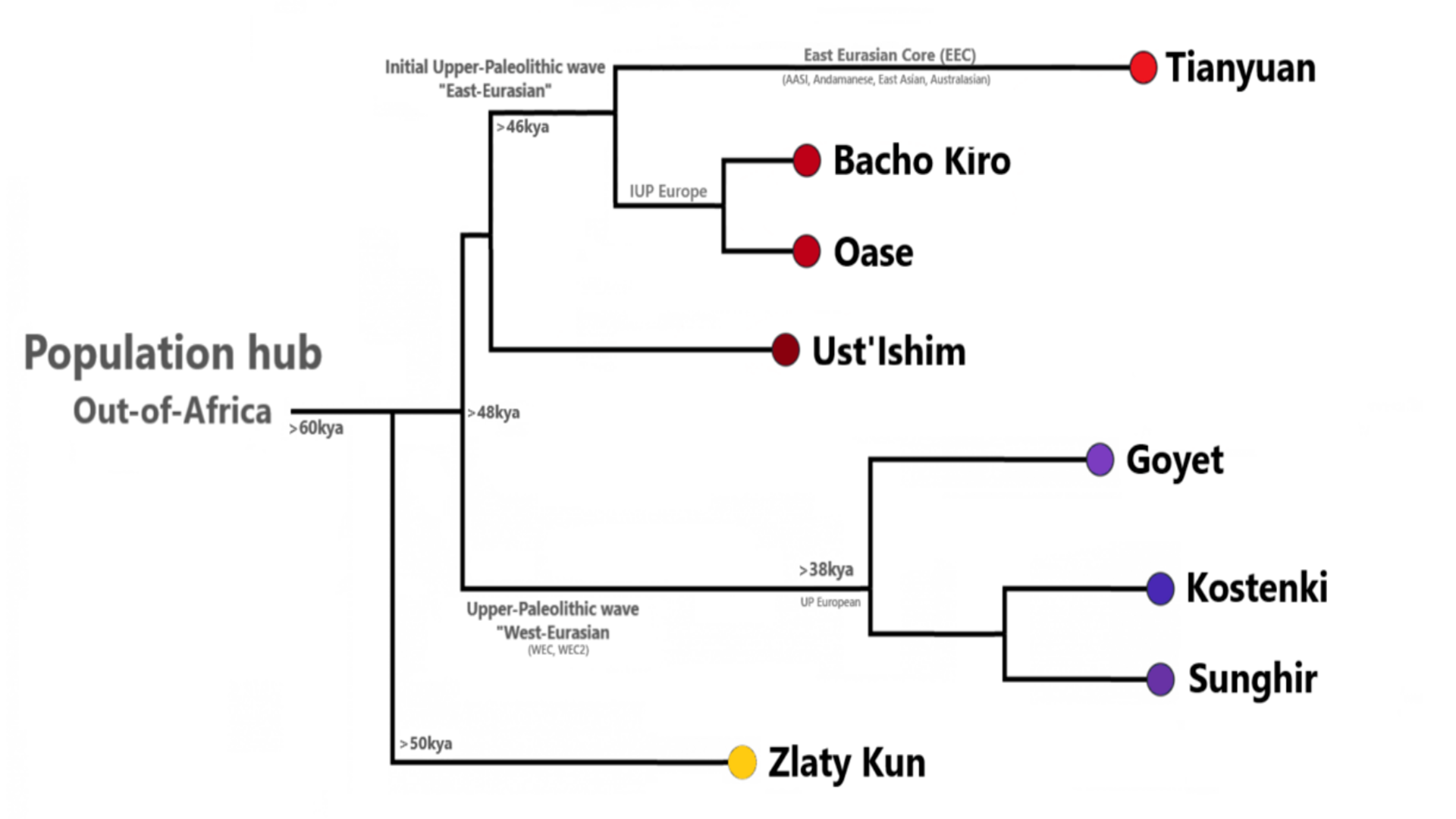
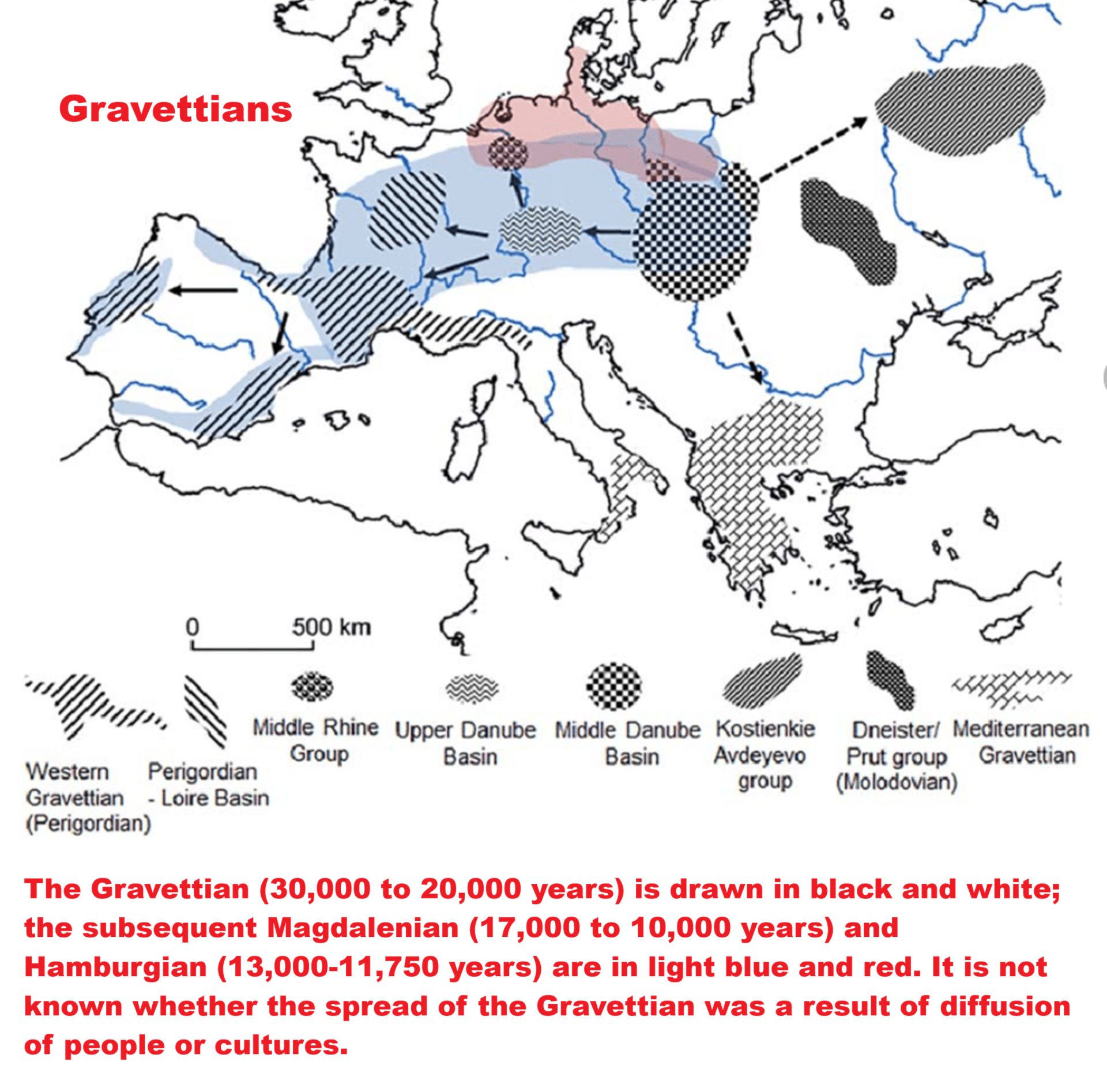
“The Gravettian (30,000 to 20,000 years) is drawn in black and white; the subsequent Magdalenian (17,000 to 10,000 years) and Hamburgian (13,000-11,750 years) are in light blue and red. It is not known whether the spread of the Gravettian was a result of the diffusion of people or cultures. This figure illustrates the possible monocentric origins of the Gravettian, in which the Gravettian is hypothesized to have its origin in the Middle Danube Basin, first spreading west (solid lines) and later spreading east and southeast (dashed lines). This scenario is largely based on the chronology of sites. Thus far, genome-wide data has been collected from only three of the ten Gravettian regions indicated on the map. These regions are northern Austria (1 sample), the Czech Republic (6), southern Italy (3), and Belgium (3), indicating that they all share a genomic ancestry. However, it is unknown whether samples from the remaining regions also share a close genomic ancestry. Some skeletal remains associated with the Gravettian that could be investigated paleogenomically are from Sungir (Russia) 112; Laghar Velho (central Portugal) 113; Cussac Cave 114; Les Garennes, near Vilhonneur 115; and Level 2 at Abri Pataud 116 (western France). Light blue and light red regions represent the approximate distributions of the Magdalenian Culture and the Hamburgian Culture (13,000-11,750 years).” ref
Gravettian
“The Gravettian is an archaeological industry of the European Upper Paleolithic that succeeded the Aurignacian circa 33,000 years ago. It is archaeologically the last European culture many consider unified, and had mostly disappeared by c. 22,000 years ago, close to the Last Glacial Maximum, although some elements lasted until c. 17,000 years ago. In modern-day Portugal, Spain and France, it was succeeded by the Solutrean and by the Epigravettian in Italy, the Balkans, Ukraine, and Russia.” ref
“The Gravettian culture is known for their artistic works including the famous Venus figurines, which were typically carved from either ivory or limestone. The culture was first identified at the site of La Gravette in the southwestern French department of Dordogne. While historically assumed to represent a genetically homogenous group, recent analysis of ancient DNA sequences suggests that the Gravettian was produced by multiple genetically divergent groups of hunter-gatherers. Eastern Gravettian-producing groups belong to the Věstonice cluster, while western Gravettian-producing groups belong to the Fournol cluster, both of which have genetic continuity from producers of the earlier Aurignacian. Fournol cluster-related groups are thought to be the ancestors of the producers of the following Solutrean and Magdalenian cultures present in Western Europe after the Last Glacial Maximum, while the producers of the Epigravettian are genetically distinct from Gravettian-producing groups.” ref
“The Gravettians were hunter-gatherers who lived in a bitterly cold period of European prehistory, and the Gravettian lifestyle was shaped by the climate. Pleniglacial environmental changes forced them to adapt. West and Central Europe were extremely cold during this period. Archaeologists usually describe two regional variants: the western Gravettian, known mainly from cave sites in France, Spain and Britain, and the eastern Gravettian in Central Europe and Russia. The eastern Gravettians, which include the Pavlovian culture, were specialized mammoth hunters, whose remains are usually found not in caves but in open air sites. Gravettian culture extends across a large geographic region, as far as Estremadura in Portugal. but is relatively homogeneous until about 27,000 years ago. They developed burial rites, which included simple, purpose-built offerings and/or personal ornaments owned by the deceased, placed within the grave or tomb.” ref
Surviving Gravettian art includes numerous cave paintings and small, portable Venus figurines made from clay or ivory, as well as jewelry objects. The fertility deities mostly date from the early period; there are over 100 known surviving examples. They conform to a very specific physical type, with large breasts, broad hips and prominent posteriors. The statuettes tend to lack facial details, and their limbs are often broken off. During the post glacial period, evidence of the culture begins to disappear from northern Europe but was continued in areas around the Mediterranean.” ref
“The Mal’ta Culture (c. 24,000 years ago) in Siberia is often considered as belonging to the Gravettian, due to its similar characteristics, particularly its Venus figurines, but any hypothetical connection would have to be cultural and not genetic: a 2016 genomic study showed that the Mal’ta people have no genetic connections with the people of the European Gravettian culture (the Vestonice Cluster).” ref
“Fu et al. (2016) examined the remains of fourteen Gravettians. The eight males included three samples of Y-chromosomal haplogroup CT, one of I, one IJK, one BT, one C1a2, and one sample of F. Of the fourteen samples of mtDNA, there were thirteen samples of U and one sample of M. The majority of the sample of U belonged to the U5 and U2. Teschler et al. (2020) examined the remains of one adult male and two twin boys from a Gravettian site in Austria. All belonged to haplogroup Y-Haplogroup I. and all had the same mtDNA, U5. According to Scorrano et al. (2022), “the genome of an early European individual from Kostenki 14, dated to around 37,000 years ago, demonstrated that the ancestral European gene pool was already established by that time.” ref
“A 2023 study found that Gravettian-producing peoples belonged to two genetically distinct clusters. Fournol in the west (France and Spain) and Věstonice in the east (Czech Republic, Poland, Austria, and Italy) both of whom traced their descent from producers of the earlier Aurignacian culture. Some individuals showed mixed ancestry from both clusters where the range of the two clusters bordered. The study found that members of the western Fournol cluster were ancestral to later Western European Cro-Magnon groups that existed after the Last Glacial Maximum, the producers of the Solutrean and Magdalenian cultures. All Gravettian-producing peoples are strongly genetically distinct from the producers of the later Epigravettian, who are genetically referred to as the Villabruna cluster, who show a greater affinity to ancient and modern peoples in West Asia than other Palaeolithic European hunter-gatherer groups. There is evidence of some genetic affinity between the Villabruna and Věstonice clusters, which may reflect shared common ancestry from the Balkans region.” ref
Sungir (Russian: Сунгирь, sometimes spelled Sunghir) is an Upper Paleolithic archaeological site in Russia and one of the earliest records of modern Homo sapiens in Eurasia. It is situated about 200 kilometers (120 mi) east of Moscow, on the outskirts of Vladimir, near the Klyazma River. It is dated by calibrated carbon analysis to between 32,050 and 28,550 BCE. Additional pollen finds suggest the relative warm spell of the “Greenland interstadial (GI) 5” between the 30,500 and 30,000 BCE as most probable dates. The settlement area was found to have four burials: the remains of an older man and two adolescent children are particularly well-preserved, and the nature of the rich and extensive burial goods suggests they belonged to the same class. In addition, a skull and two fragments of human femur were also found at the settlement area, and two human skeletons outside the settlement area without cultural remains.” ref
“The site is one of the earliest examples of ritual burials and constitutes important evidence of the antiquity of human religious practices. The extraordinary collection of grave goods, the position of the bodies, and other factors all indicate it was a burial of high importance. Two other remains at the site are partial skeletons. In 2017, researchers successfully sequenced the DNA of multiple individuals from Sungir (c. 34,000 years ago), including one from Burial 1 (Sunghir I) and three from Burial 2: the two adolescent burials (Sunghir II and Sunghir III) and the adult femur accompanying the burial (Sunghir IV). The younger adolescent from Burial 2, Sunghir III, yielded high coverage genomes. Sungir III was previously thought to be female; however, genetic analysis shows that all four of the tested individuals at Sungir were male. Contrary to previous interpretations of the burials, genetic analysis shows that none of the individuals are closely related (none of the individuals were third-degree relatives or closer).” ref
“However, when compared against other populations, the individuals at Sungir are genetically closest to each other. The individuals at Sungir show closest genetic affinity to the individuals from Kostenki, with closer affinity to the individual from Kostenki 12 than to the individual from Kostenki 14. The closer affinity between Kostenki 12 and Sungir individuals was mutual, with Kostenki 12 being closer to the Sungir remains than to Kostenki 14. The Sungir individuals are inferred to have descended from a lineage that was forming a sister branch to Kostenki 14. The Sungir individuals also show close genetic affinity to various individuals belonging to Vestonice Cluster buried in a Gravettian context, such as those excavated from Dolní Věstonice. In terms of their Y-chromosome, they all belonged to a subclade of haplogroup C1 (C1a2), which was common among early West Eurasian specimens, such as the ones in Kostenki (C1b*), but today rare among Europeans. The maternal haplogroups of S I belonged to U8c, while S II, S III, and S IV belonged to a subclade of U2, which is close to the ones observed among the Kostenki specimens.” ref
“Dolní Věstonice (often without diacritics as Dolni Vestonice) is an Upper Paleolithic archaeological site near the village of Dolní Věstonice in the South Moravian Region of the Czech Republic, at the base of Mount Děvín, 550 metres (1,800 ft). It dates to approximately 26,000 years ago, as supported by radiocarbon dating. The site is unique in that it has been a particularly abundant source of prehistoric artifacts (especially art) dating from the Gravettian period, which spanned roughly from 27,000 to 20,000 BCE. In addition to the abundance of art, this site also includes carved representations of men, women, and animals, along with personal ornaments, human burials, and enigmatic engravings.” ref
“The Dolní Věstonice artifacts also include some of the earliest examples of fired clay sculptures, including the Venus of Dolní Věstonice, and date back to 26,000 years ago. The female figurine is a ceramic statuette depiction of a wide-hipped, nude female. This figurine is similar to other figurines found throughout the area at nearby archaeological sites such as Willendorf and the Caves of Grimaldi (see Grimaldi Man). A carved ivory figure in the shape of a female head was discovered near the huts. The left side of the figure’s face was distorted.” ref
“One of the burials, located near the huts, revealed a human female skeleton aged to 40+ years old, ritualistically placed beneath a pair of mammoth scapulae, one leaning against the other. Surprisingly, the left side of the skull was disfigured in the same manner as the aforementioned carved ivory figure, indicating that the figure was an intentional depiction of this specific individual. The bones and the earth surrounding the body contained traces of red ochre, a flint spearhead had been placed near the skull, and one hand held the body of a fox. This evidence suggests that this was the burial site of a shaman. This is the oldest site not only of ceramic figurines and artistic portraiture, but also of evidence of female shamans.” ref
“The remains of three male individuals were found. It was initially believed that the middle of the three bodies was a female, but recent DNA evidence has proved the body was a male. The bodies were lying in an extended lengthwise position, covered by burnt spruce logs and branches. The body in the middle was placed first, being partially covered by the other two. The other two were in different positions. One was faced down and the other on his side with hands reaching the pubic region of the middle body. The heads of all three were covered with red ochre, the central body also having red ochre around his pubis. All three individuals are theorized to be related based on three rare traits: unilateral absence of the frontal sinus, specific auditory exostoses, and impaction of the upper wisdom teeth. Each individual is believed to be about 16–25 years old at the time of death. The central body suffers from a genetic pathology resulting in the curved form of his legs. Red ochre, a pigment commonly used for rituals, was found over the pelvis.” ref
“Three inhabitants of Dolní Věstonice, lived 31,155 years ago (calibrated date) and were found to have mitochondrial haplogroup U, and one inhabitant mitochondrial haplogroup U8. The Věstonice individuals form a distinct genetic cluster which is the result of an admixture between ‘Western’ and ‘Eastern’ lineages, represented by the genomes of the c. 35,000 year-old Goyet Q116-1 individual from Belgium and the c. 34,000 year-old Sunghir individuals from Western Russia, respectively. The Věstonice individuals show greater affinity to the Sunghir individuals than to the Goyet Q116-1 individual, and can be modelled as approximately 64% Sunghir-related and 36% Goyet-Q116-related ancestry. The Y-chromosome observed among Vestonice 16 belonged to haplogroup C1a2 (V20+, V86+). In the Vestonice 13 sample, the Y chromosomal haplogroup CT (not IJK-L16) (CTS109+, CTS5318+, CTS6327+, CTS8243+, CTS9556+, Z17718+, Y1571+, M5831+) was determined, for the Vestonice 14 sample, the Y chromosome haplogroup I (L758+), for the Vestonice 15 sample, the Y chromosome haplogroup BT (PF1178+), and for the Vestonice 43 sample, the Y chromosome haplogroup F (not I) (P145+, P158+).” ref
Kostyonki
“The Kostyonki–Borshchyovo archaeological complex is an area where numerous Upper Paleolithic archaeological sites have been found, located around the villages of Kostyonki (also Kostenki) and Borshchyovo (also Borshchevo). The area is found on the western (right) bank of the Don River in Khokholsky District, Voronezh Oblast, Russia, some 25 km south of the city of Voronezh. The 26 Paleolithic sites of the area are numbered Kostenki 1–21 and Borshchevo 1–5. It is known for its high concentration of cultural remains of anatomically modern humans from the beginning of the Upper Paleolithic era, before 40,000 years ago. Finds are on exhibit in situ, at the State Archaeological Museum–Reserve Kostyonki built atop the mammoth bone circle Kostenki 11. Kostyonki is considered as belonging to the Aurignacian culture. A layer of Campanian volcanic ash, earlier dated to about 45,000 years ago, has been found above some of the finds, showing that humans inhabited the site before this.” ref
“Kostenki 1/1, Kostenki 4/2, Kostyonki 8/2 and Kostenki 21/3 belong to the eastern Gravettian (24 to 22 ka). Kostenki 2, Kostenki 3, Kostenki 11-1a and Kostenki-19 belong to the Zamyatino culture (22 to 17 ka). Kostenki 8/2 (Telmanskaya) is eponymous of “Telman culture”. In 2009, DNA was extracted from the remains of a male hunter-gatherer from Kostenki-12 who lived circa 30,000 years ago and died aged 20–25. His maternal lineage was found to be mtDNA haplogroup U2. He was buried in an oval pit in a crouched position and covered with red ochre. Kostenki 12 was later found to belong to the patrilineal Y-DNA haplogroup C1* (C-F3393). A male from Kostenki-14 (Markina Gora), who lived approximately 38,700–36,200 years ago, was also found to belong to mtDNA haplogroup U2. His Y-DNA haplogroup was C1b* (F1370).” ref
“The Kostenki-14 genome represents early evidence for the separation of Europeans and East Asian lineages. He was found to have a close relationship to both Paleolithic European and Siberian hunter-gatherers, such as the Sungir specimens from western Russia, the Peștera Muierii woman (34,000 years ago) in Romania, or the “Mal’ta boy” (24,000 years ago) of south-east Siberia (Ancient North Eurasian) and to the later Mesolithic hunter-gatherers of Europe (Western Hunter-Gatherer) and western Siberia, as well as with a basal population ancestral to Early European Farmers, but not to East Asians. Kostenki-14 showed that the main ancestral components of contemporary Europeans were likely already genetically differentiated and related at least 36,200 years ago, with the modern European genomic structure dating back to the Upper Paleolithic. Kostenki-14 had some level of ancient Neanderthal admixture, which has been dated as going back to circa 54,000 years ago.” ref
“The Goyet Caves (French: Grottes de Goyet) are a series of connected caves located in Belgium in a limestone cliff about 15 m (50 ft) above the river Samson near the village of Mozet in the Gesves municipality of the Namur province. The site is a significant locality of regional Neanderthal and European early modern human occupation, as thousands of fossils and artifacts were discovered that are all attributed to a long and contiguous stratigraphic sequence from 120,000 years ago, the Middle Paleolithic to less than 5,000 years ago, the late Neolithic.” ref
“Homo sapiens occupation began around 35,000 years ago. Goyet accounts for fossils of European populations from different junctures, including fossils that are among the earliest branch of modern Europeans (ca. 35,000 years ago). Their damaged but readable DNA has been used in studies of the origin and migration of European ice age populations. Based on mitochondrial DNA of five local fossils it was concluded that the first modern Europeans arrived directly from Africa without a detour via Asia. The 35,000 year old humerus of a man from Goyet has been associated with the Aurignacian culture. Shortly thereafter, the population associated with this culture was ousted by a genetically distinct Gravettian rural population (from 34,000 years ago), but around 25,000 years ago, descendants reappear in Spain in the context of Magdalenian culture. After 19,000 years ago, the population begins to spread all over Europe. The extent to which Neanderthals and Homo sapiens have lived together at Goyet is still under investigation.” ref
“In 2016, researchers successfully extracted DNA from several ancient human fossils at Goyet (with direct dates): GoyetQ116-1 (35,160-34,430 years ago) and GoyetQ376-3 (33,940-33,140 years ago) from the Aurignacian; GoyetQ376-19 (27,720-27,310 years ago), GoyetQ53-1 (28,230-27,720 years ago), GoyetQ55-2 (27,730-27,310 years ago), GoyetQ56-16 (26,600-26,040 years ago) and Goyet2878-21 (27,060-26,270 years ago) from the Gravettian; and GoyetQ-2 (15,230-14,780 years ago) from the Magdalenian. GoyetQ376-19, Goyet53-1 and Goyet56-16 were found to cluster genetically with several other Gravettian individuals from Europe in the Věstonice Cluster, while GoyetQ-2 was found to cluster genetically with several other Magdalenian individuals from Europe in the El Mirón Cluster.” ref
“All later Europeans after GoyetQ116-1 show some genetic affinity for this individual. GoyetQ116-1 also exhibits more genetic affinity for the Tianyuan man than any other ancient individual from West Eurasia. GoyetQ116-1 received geneflow from an Ancient East Eurasian population (c. 23%), possibly represented by the preceding Bacho Kiro cave specimen, who, together with the Oase specimens, are closer to ancient and modern East Eurasian populations, and were part of the Initial Upper Paleolithic (IUP) wave. The IUP groups in Europe were largely absorbed by the later Upper Paleolithic wave (Ancient West Eurasians) at more than 38,000 years ago, resulting in the formation of Upper Paleolithic Europeans such as GoyetQ116-1. Culturally, the Aurignacian cultural complex is chronologically associated with the human remains of Goyet Q116-1, while the subsequent Gravettian is associated with the Vestonice cluster.” ref
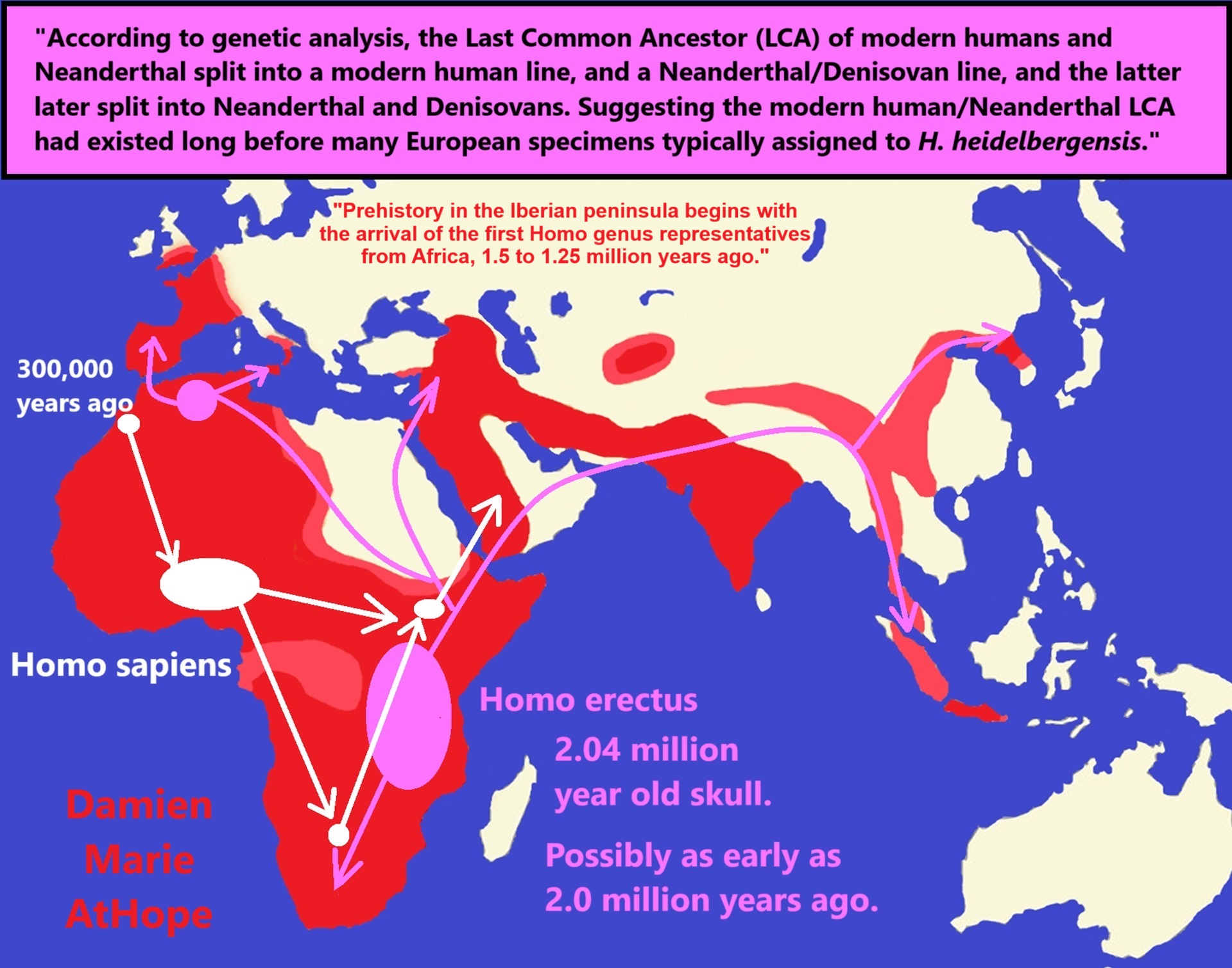
I think that it is most likely that an arcane Homo (from Latin homō ‘human’), the last common ancestor of Homo sapiens/Modern humans, split off of Homo Erectus in Northwest Africa sometime from 2 million to 750,000 years ago, then moved sometime after 750,000 to 550,000 years ago moving into Spain in Europe where it split into the genetics known as (Archaic Humans) Homo Denisovans and Homo Neandertalensis.
Origin of Arcane Homo Erectus to Earliest Modern Humans
I think that it is most likely that an arcane Homo (from Latin homō ‘human’), the last common ancestor of Homo sapiens/Modern humans, split off of Homo Erectus in Northwest Africa sometime from 2 million to 750,000 years ago, then moved sometime after 750,000 to 550,000 years ago moving into Spain in Europe where it split into the genetics known as (Archaic Humans) Homo Denisovans and Homo Neandertalensis. Homo sapiens/Modern humans stayed in North Africa emerging as a distinct Homo around 300,000 years ago.
. Homo sapiens/Modern humans: Jebel Irhoud, Morocco 300,000 years ago. ref
“Homo sapiens appeared 300,000 years ago in North Africa and spread to South and Central Africa then the world’s current population left Africa 70,000 to 65,000 years ago. But there were other exoduses from Africa in waves of older populations that died out.” ref
Northwest Africa, Modern humans: haplogroups mt-DNA L and Y-DNA AOa1 = 320,000 years ago ref
Moves to
West Central Africa, Modern humans: haplogroups mt-DNA L and Y-DNA AOO = 300,000 years ago ref
Moves to
Southern Africa, Modern humans: haplogroups mt-DNA L1 and Y-DNA B = 230,000 (Kabwe and sangoan) ref
Southern Africa, Modern humans: haplogroups mt-DNA L0 and Y-DNA A1 = Middle Stone Age (possibly 280,000 years ago and ended around 50–25,000 years ago) (Florisbad) ref
Moves to
East Central Africa, Modern humans: haplogroups mt-DNA L5 and Y-DNA A3B/B2a = 230,000 (Omo, Herto, Sai, and sangoan-Lupemban) ref
Moves to
Northeast Africa/Middle East, Modern humans: haplogroups mt-DNA L3/L4 and Y-DNA CDEF = 120,000 (Singa, Skhul, Qafzeh, and early Nubian) ref
Modern humans early return to Africa from southwest Asia and with members of other African areas head to southern Africa.
- “67,000 to 40,000 years ago: Neanderthal admixture to Eurasians
- 50,000 years ago: the earliest sewing needle found. Made and used by Denisovans.
- 50,000–30,000 years ago: Mousterian Pluvial in North Africa. The Sahara desert region is wet and fertile. Later Stone Age begins in Africa.
- 45,000–43,000 years ago: European early modern humans.
- 45,000–40,000 years ago: Châtelperronian culture in France.
- 42,000 years ago: Paleolithic flutes in Germany.
- 42,000 years ago: earliest evidence of advanced deep sea fishing technology at the Jerimalai cave site in East Timor—demonstrates high-level maritime skills and by implication the technology needed to make ocean crossings to reach Australia and other islands, as they were catching and consuming large numbers of big deep sea fish such as tuna.
- 41,000 years ago: Denisova hominin lives in the Altai Mountains.
- 40,000 years ago: Aurignacian culture begins in Europe.
- 40,000 years ago: oldest known figurative art the zoomorphic Löwenmensch figurine.
- 40,000–30,000 years ago: human settlement (Aboriginal Australians) in Sydney, Perth, and Melbourne.
- 40,000–20,000 years ago: oldest known ritual cremation, the Mungo Lady, in Lake Mungo, Australia.
- 35,000 years ago: one of the oldest known figurative art of a human figure as opposed to a zoomorphic figure (Venus of Hohle Fels).” ref
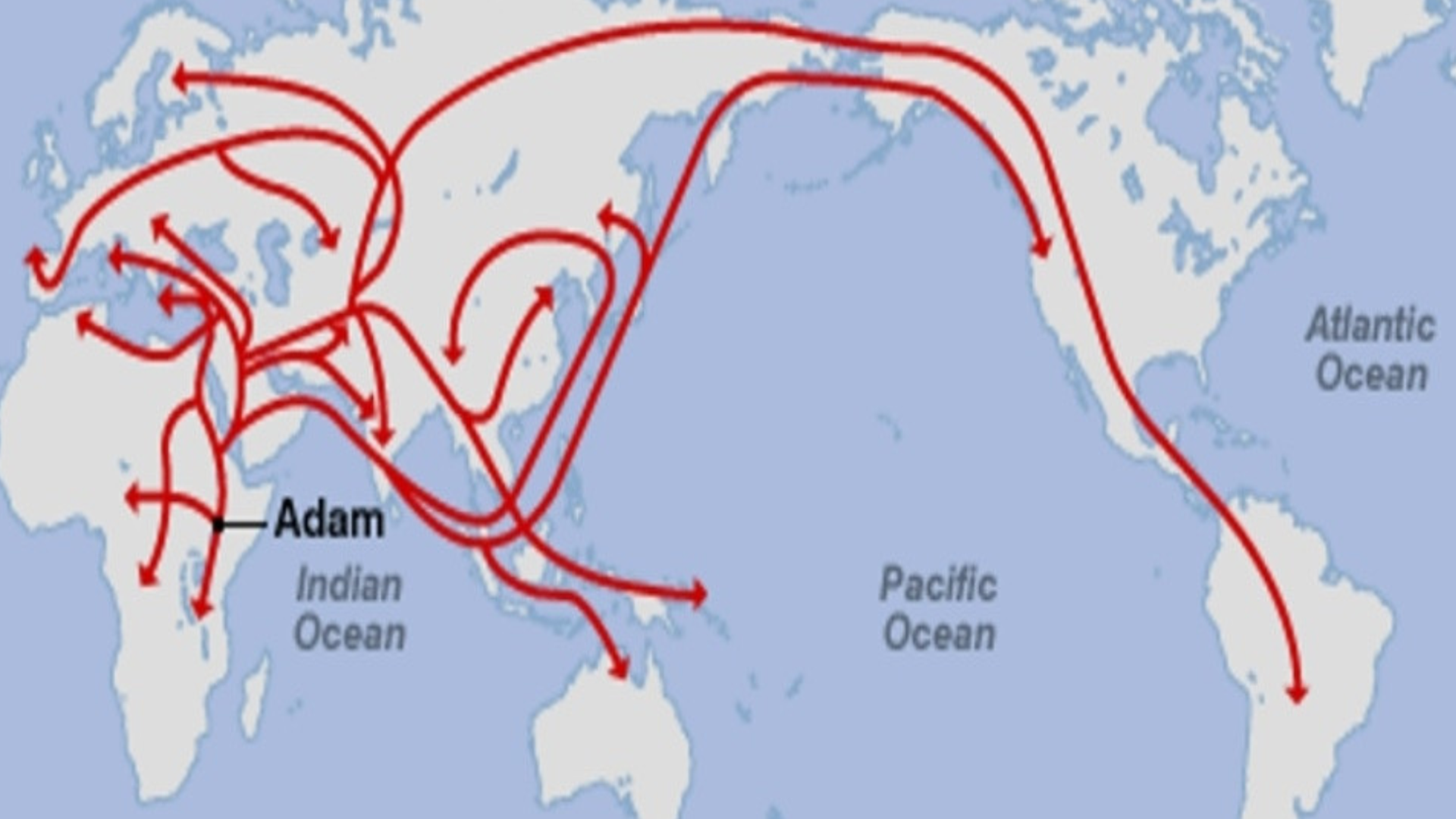
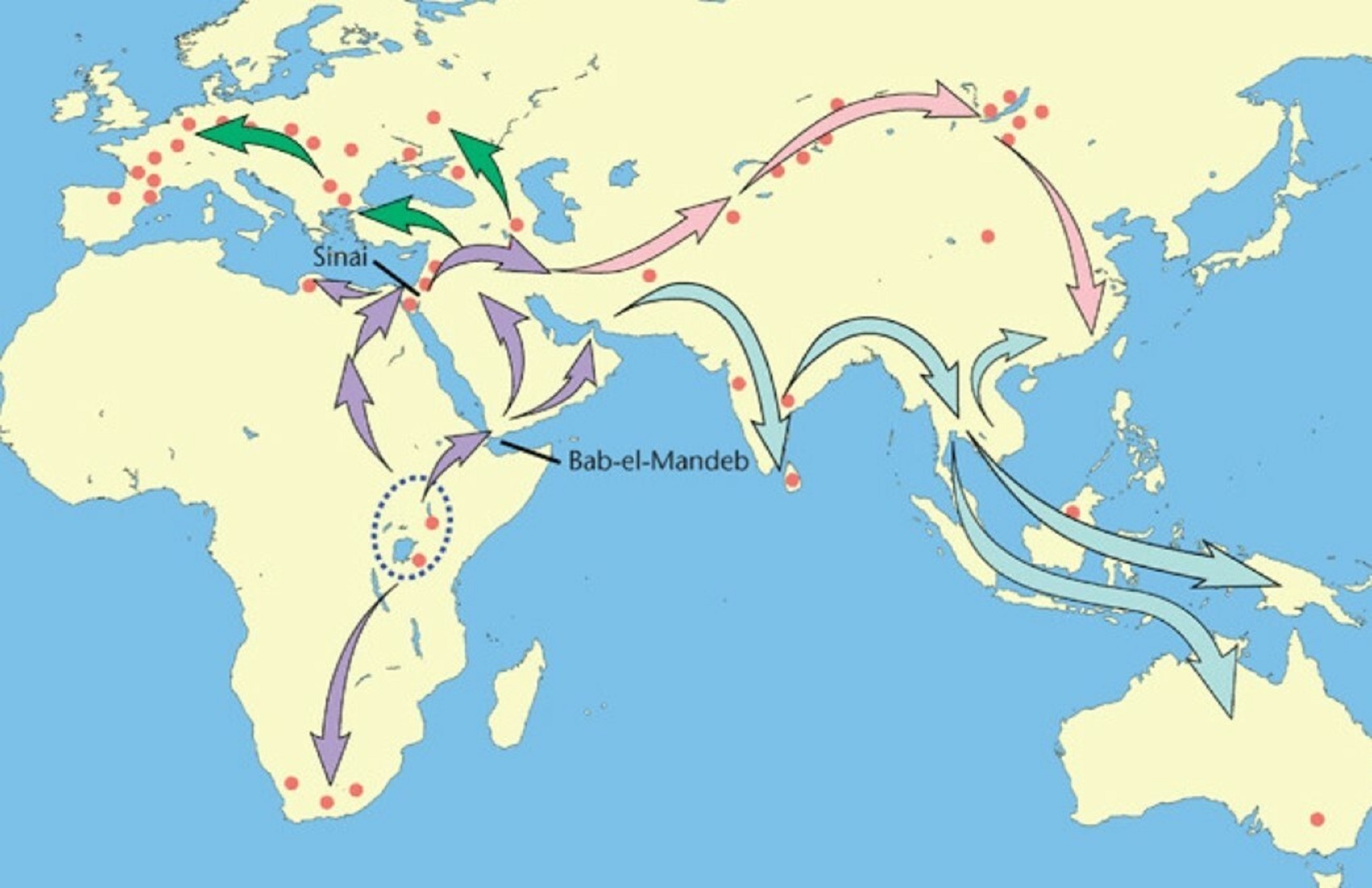
“Possible migration routes taken by ancient humans starting from Africa (purple arrows) people characterized by mtDNA haplogroups l1–3 spread out and gave rise to 3 lineages: European (green arrows) with haplogroups H, I, J, U and X, Central Asian (pink arrows) with haplogroups N and M giving rise to A–D and South Asian where N and M gave rise to P and Q.” ref
I have posts on all my ideas with support for my reasoned speculations from the evidence: Understanding Religion Evolution
Quick Evolution of Religion?
Pre-Animism (at least 300,000 years ago) pre-religion is a beginning that evolves into later Animism. So, Religion as we think of it, to me, all starts in a general way with Animism (Africa: 100,000 years ago) (theoretical belief in supernatural powers/spirits), then this is physically expressed in or with Totemism (Europe: 50,000 years ago) (theoretical belief in mythical relationship with powers/spirits through a totem item), which then enlists a full-time specific person to do this worship and believed interacting Shamanism (Siberia/Russia: 30,000 years ago) (theoretical belief in access and influence with spirits through ritual), and then there is the further employment of myths and gods added to all the above giving you Paganism (Turkey: 12,000 years ago) (often a lot more nature-based than most current top world religions, thus hinting to their close link to more ancient religious thinking it stems from). My hypothesis is expressed with an explanation of the building of a theatrical house (modern religions development). Progressed organized religion (Egypt: 5,000 years ago) with CURRENT “World” RELIGIONS (after 4,000 years ago).
My thoughts on the Evolution of Religion from Animism 100,000 years ago to Paganism 12,000 years ago
Animism (at least 100,000 years ago) possibly Southern Africa or maybe Central Africa
Animism: an approximately 100,000-year-old belief system?
Recent African origin of modern humans leaving Africa:
“Practically all of these early waves seem to have gone extinct or retreated back, and present-day humans outside Africa descend mainly from a single expansion about 70,000–50,000 years ago, via the so-called “Southern Route“. These humans spread rapidly along the coast of Asia and reached Australia by around 65,000–50,000 years ago.” ref
“Around 54,000 years ago, a group of anatomically modern humans forayed into southern France, intruding deep into the stamping ground of Neanderthals. And they came prepared, bearing the first bow and arrow technology to reach Europe, that had started in Southern Africa 80,000 to 60,000 years ago.” ref, ref
Totemism (at least 50,000/45,000 years ago) possibly around Germany, France, or somewhere in West Europe
Totemism: an approximately 50,000-year-old belief system?
Shamanism (at least 30,000/35,000 years ago) possibly West Siberia or East Russia
Shamanism: an approximately 30,000-year-old belief system
Paganism (at least 12,000/13,000 years ago) Turkey And/or Levant: “Israel, Jordan, Lebanon, Palestine, Syria”
“Religion is an Evolved Product” and Yes, Religion is Like Fear Given Wings…
Atheists talk about gods and religions for the same reason doctors talk about cancer, they are looking for a cure, or a firefighter talks about fires because they burn people and they care to stop them. We atheists too often feel a need to help the victims of mental slavery, held in the bondage that is the false beliefs of gods and the conspiracy theories of reality found in religions.
Understanding Religion Evolution:
- Pre-Animism (at least 300,000 years ago)
- Animism (Africa: 100,000 years ago)
- Totemism (Europe: 50,000 years ago)
- Shamanism (Siberia: 30,000 years ago)
- Paganism (Turkey: 12,000 years ago)
- Progressed organized religion (Egypt: 5,000 years ago), (Egypt, the First Dynasty 5,150 years ago)
- CURRENT “World” RELIGIONS (after 4,000 years ago)
- Early Atheistic Doubting (at least by 2,600 years ago)
“An Archaeological/Anthropological Understanding of Religion Evolution”
It seems ancient peoples had to survived amazing threats in a “dangerous universe (by superstition perceived as good and evil),” and human “immorality or imperfection of the soul” which was thought to affect the still living, leading to ancestor worship. This ancestor worship presumably led to the belief in supernatural beings, and then some of these were turned into the belief in gods. This feeble myth called gods were just a human conceived “made from nothing into something over and over, changing, again and again, taking on more as they evolve, all the while they are thought to be special,” but it is just supernatural animistic spirit-belief perceived as sacred.
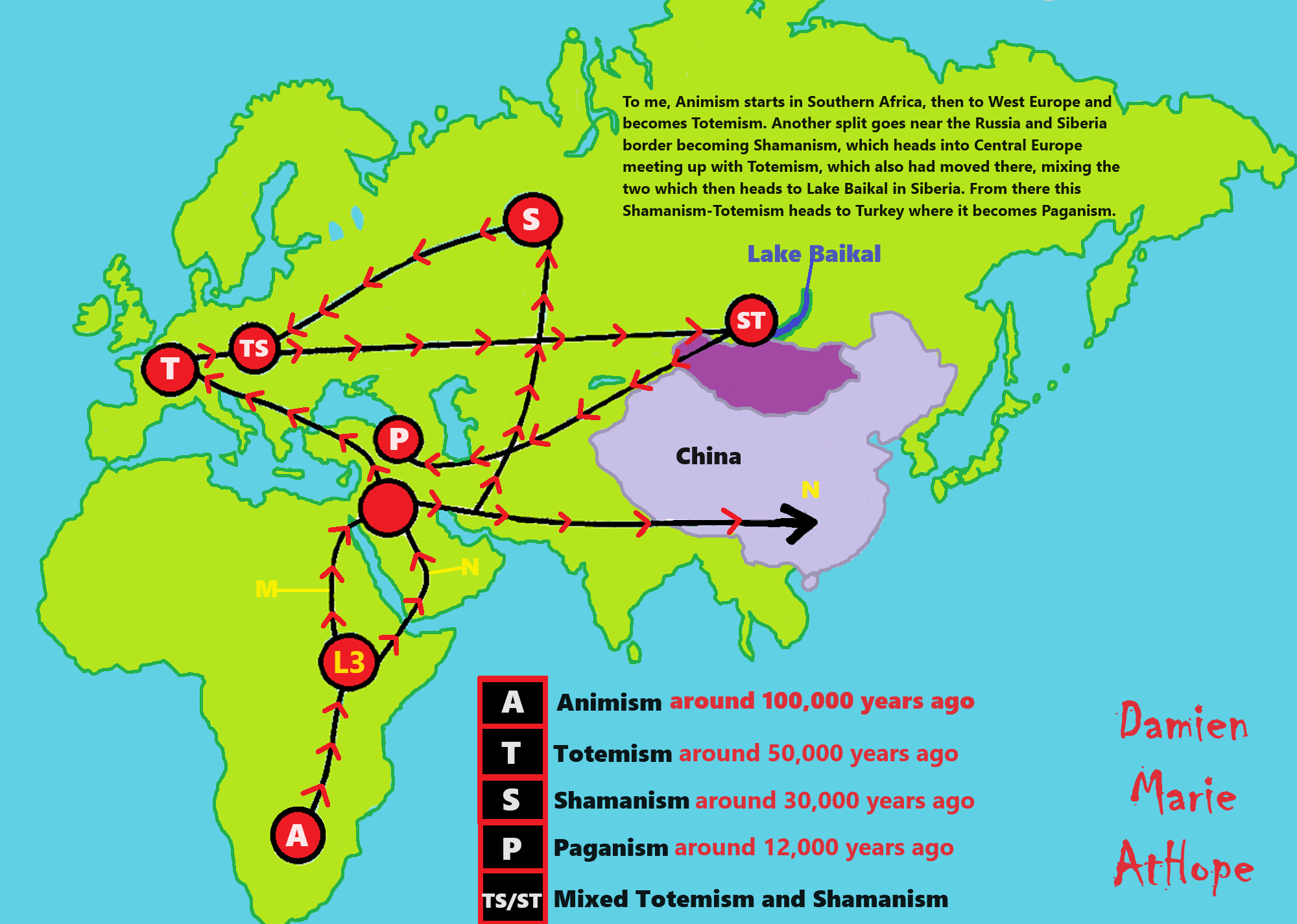
To me, Animism starts in Southern Africa, then to West Europe, and becomes Totemism. Another split goes near the Russia and Siberia border becoming Shamanism, which heads into Central Europe meeting up with Totemism, which also had moved there, mixing the two which then heads to Lake Baikal in Siberia. From there this Shamanism-Totemism heads to Turkey where it becomes Paganism.
Understanding Religion Evolution per Damien’s speculations from the evidence:
Pre-Animism (at least 300,000 years ago) possibly Africa, Middle East, and Eurasia
Animism (at least 100,000 years ago) possibly Southern Africa or maybe Central Africa
Totemism (at least 50,000/45,000 years ago) possibly around Germany, France, or somewhere in West Europe
Shamanism (at least 30,000/35,000 years ago) possibly West Siberia or East Russia
Paganism (at least 12,000/13,000 years ago) Turkey And/or Levant: “Israel, Jordan, Lebanon, Palestine, Syria”
Progressed organized religion (at least 5,000 years ago), (Egypt, the First Dynasty 5,150 years ago)
I think animism started 100,000 years ago, totemism 50,000-45,000 years ago, and shamanism 30,000-35,000 years ago.
Animism (simplified to me as a belief in a perceived spirit world) passably by at least 100,000 years ago “the primal stage of early religion” To me, Animistic Somethingism: You just feel/think there has to be something supernatural/spirit-world or feel/think things are supernatural/spirit-filled.
Totemism (simplified to me, as a belief that these perceived spirits could be managed or related with by created physical expressions) passably by at least 50,000 years ago “progressed stage of early religion” A totem is a representational spirit being, a sacred object, or symbol of a group of people, clan, or tribe.
Shamanism (simplified to me as a belief that some special person can commune with these perceived spirits on the behalf of others by way of rituals) passably by at least 30,000 years ago Shamanism is an otherworld connection belief thought to heal the sick, communicate with spirits/deities, and escort souls of the dead.
Evidence shows earliest modern humans lived 50,000 years ago in the South of France.
“Archaeologists found a 54,000-year-old tooth belonging to a homo sapiens buried at Grotte Mandrin in the Rhone Valley. They also found small, sharp projectiles carved out of stone and which might have been used as spearheads or arrowheads. It was thought that the first humans arrived in what is modern-day Europe around 40,000 years ago. But the latest finds suggest we were here much earlier and mingling with Neanderthals for much longer than had been believed. Prof Chris Stringer, of London’s Natural History Museum, said: “This new find shows there were modern humans there about 54,000 years ago, much earlier than we thought. “And what’s interesting is they seem to come and go.” He added the world was in the grip of an Ice Age at the time, so temperatures would be extremely cold.” ref
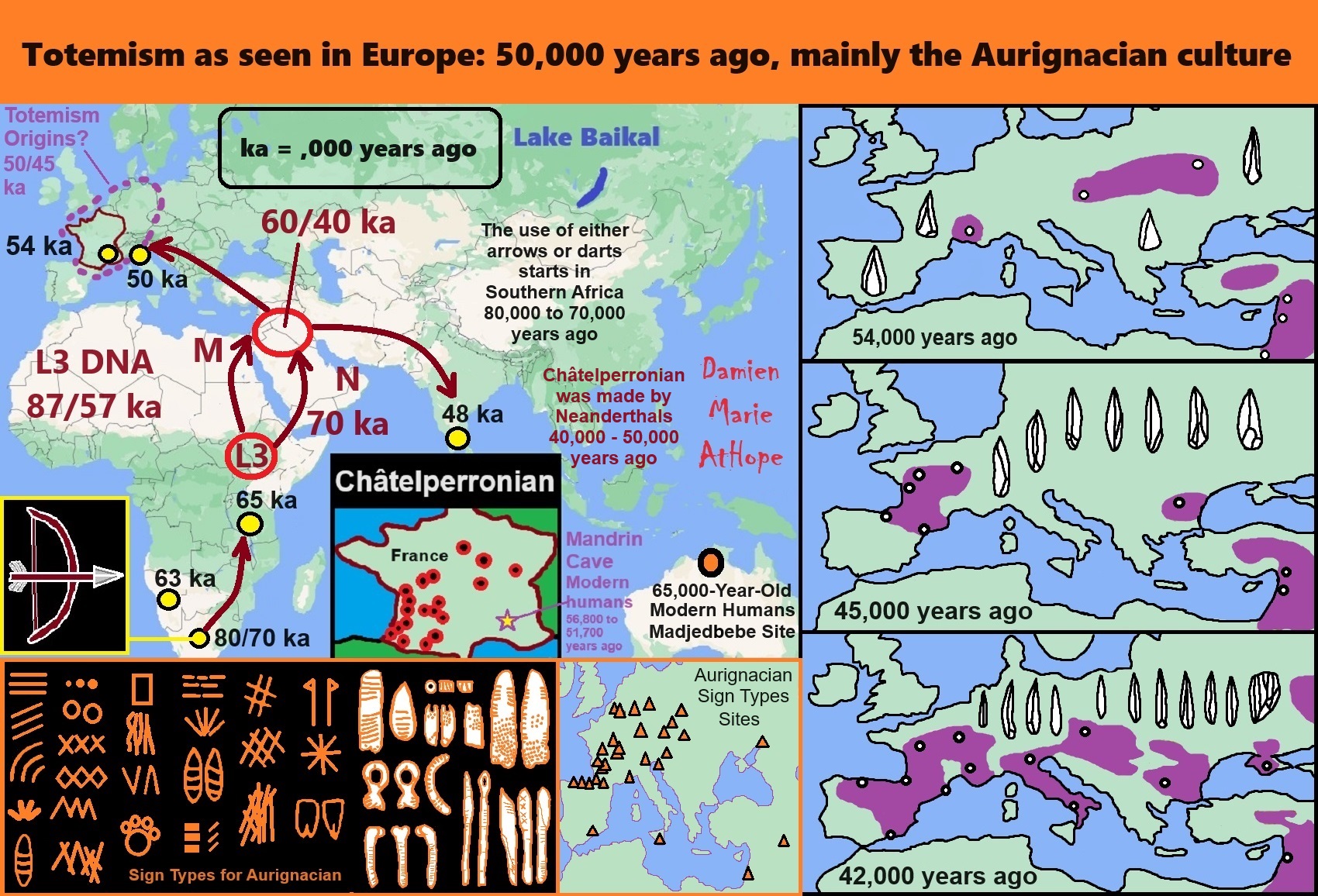
ref, ref, ref, ref, ref, ref, ref, ref, ref, ref, ref, ref, ref, ref, ref, ref, ref, ref, ref, ref, ref, ref, ref
This is my thoughts/speculations on the origins of Totemism
Totemism as seen in Europe: 50,000 years ago, mainly the Aurignacian culture
- Pre-Aurignacian “Châtelperronian” (Western Europe, mainly Spain and France, possible transitional/cultural diffusion between Neanderthals and humans around 50,000-40,000 years ago)
- Archaic–Aurignacian/Proto-Aurignacian (Europe around 46,000-35,000)
- Aurignacian “classical/early to late” (Europe and other areas around 38,000 – 26,000 years ago)
“In the realm of culture, the archeological evidence also supports a Neandertal contribution to Europe’s earliest modern human societies, which feature personal ornaments completely unknown before immigration and are characteristic of such Neandertal-associated archeological entities as the Chatelperronian and the Uluzzian.” – (PDF) Neandertals and Moderns Mixed, and It Matters: Link
Totemism as seen in Europe: 50,000 years ago, mainly the Aurignacian culture
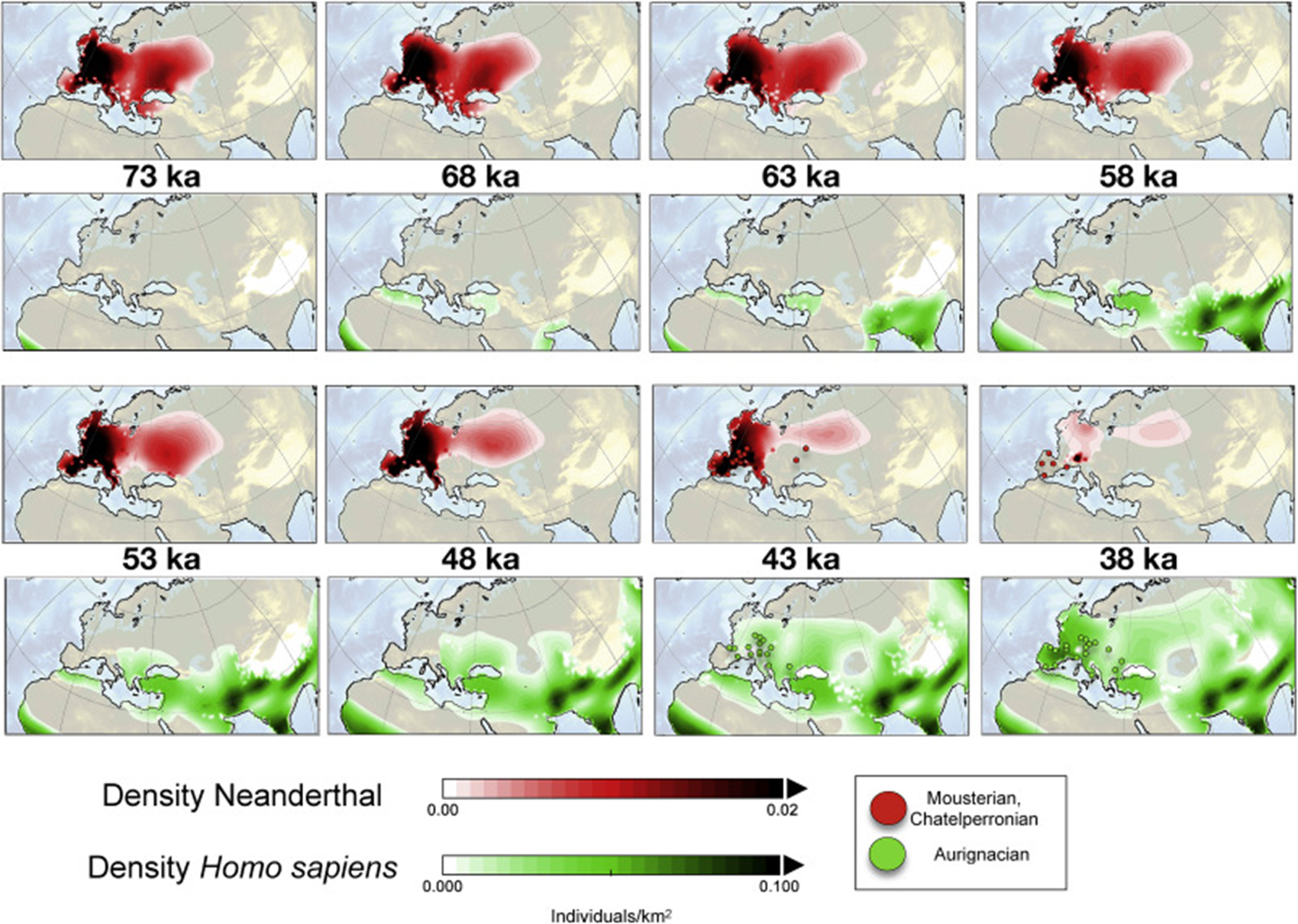
“Quantifying the potential causes of Neanderthal extinction: Abrupt climate change versus competition and interbreeding. Neanderthals experienced rapid population decline due to competitive exclusion. Interbreeding is only a minor contributor to Neanderthal extinction. Abrupt Climate Change was not a major cause for the demise of Neanderthals.” ref
“Anatomically Modern Humans are the sole survivor of a group of hominins that inhabited our planet during the last ice age and that included, among others, Homo neanderthalensis, Homo denisova, and Homo erectus. Whether previous hominin extinctions were triggered by external factors, such as abrupt climate change, volcanic eruptions or whether competition and interbreeding played major roles in their demise still remains unresolved. Here I present a spatially resolved numerical hominin dispersal model (HDM) with empirically constrained key parameters that simulates the migration and interaction of Anatomically Modern Humans and Neanderthals in the rapidly varying climatic environment of the last ice age. The model simulations document that rapid temperature and vegetation changes associated with Dansgaard-Oeschger events were not major drivers of global Neanderthal extinction between 50,000 and 35,000 years ago, but played important roles regionally, in particular over northern Europe. According to a series of parameter sensitivity experiments conducted with the HDM, a realistic extinction of the Neanderthal population can only be simulated when Homo sapiens is chosen to be considerably more effective in exploiting scarce glacial food resources as compared to Neanderthals.” ref
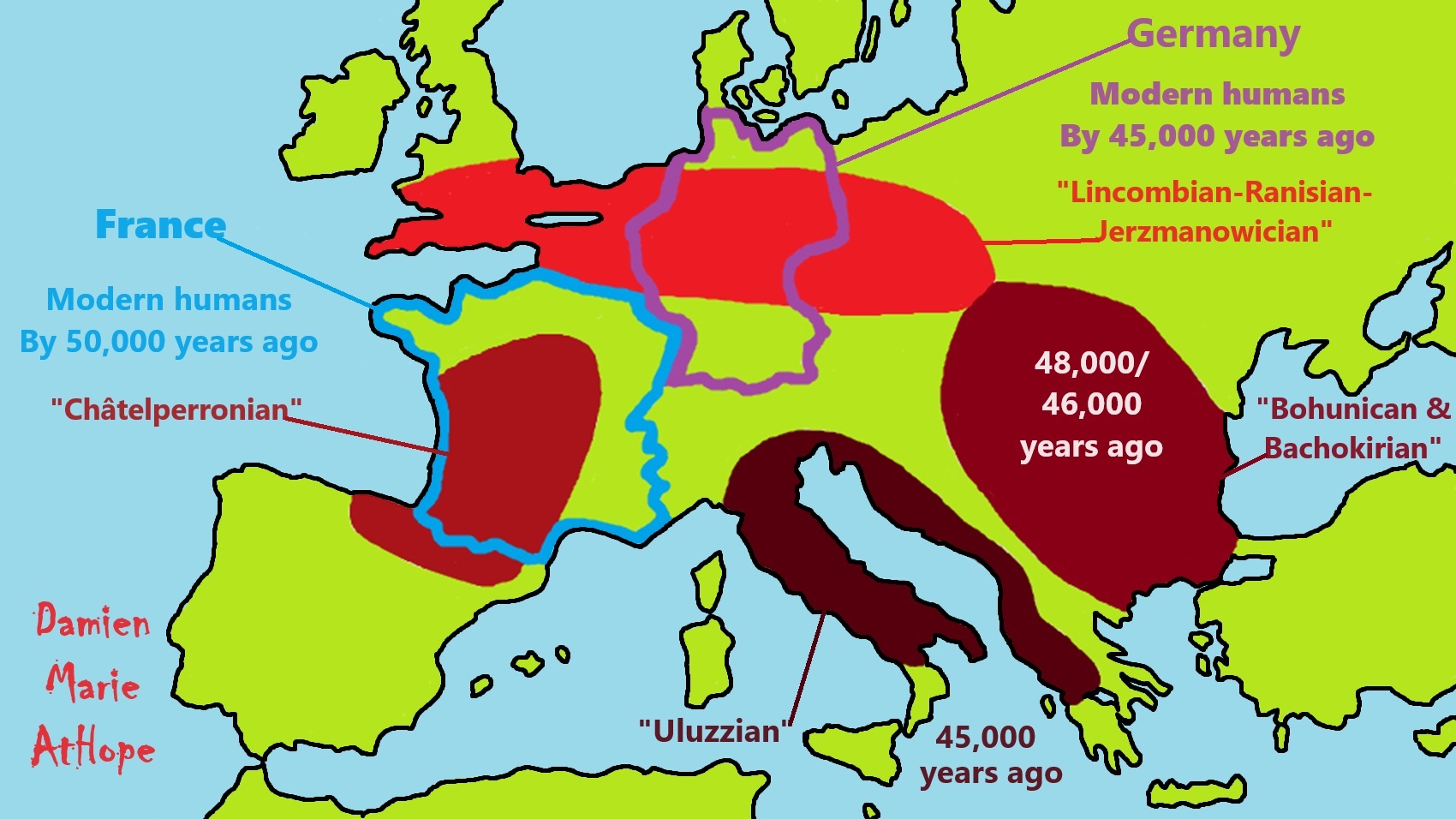
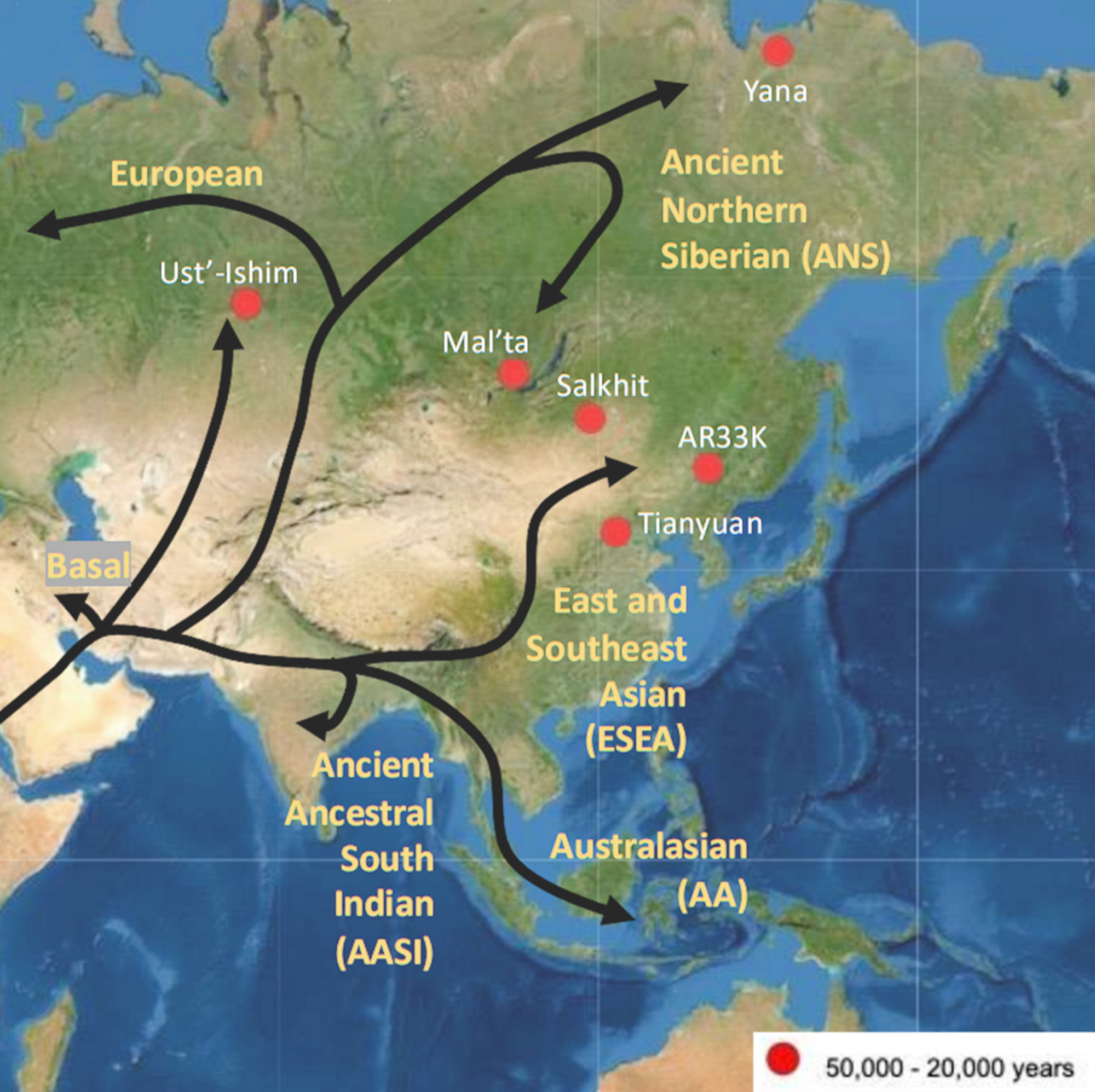
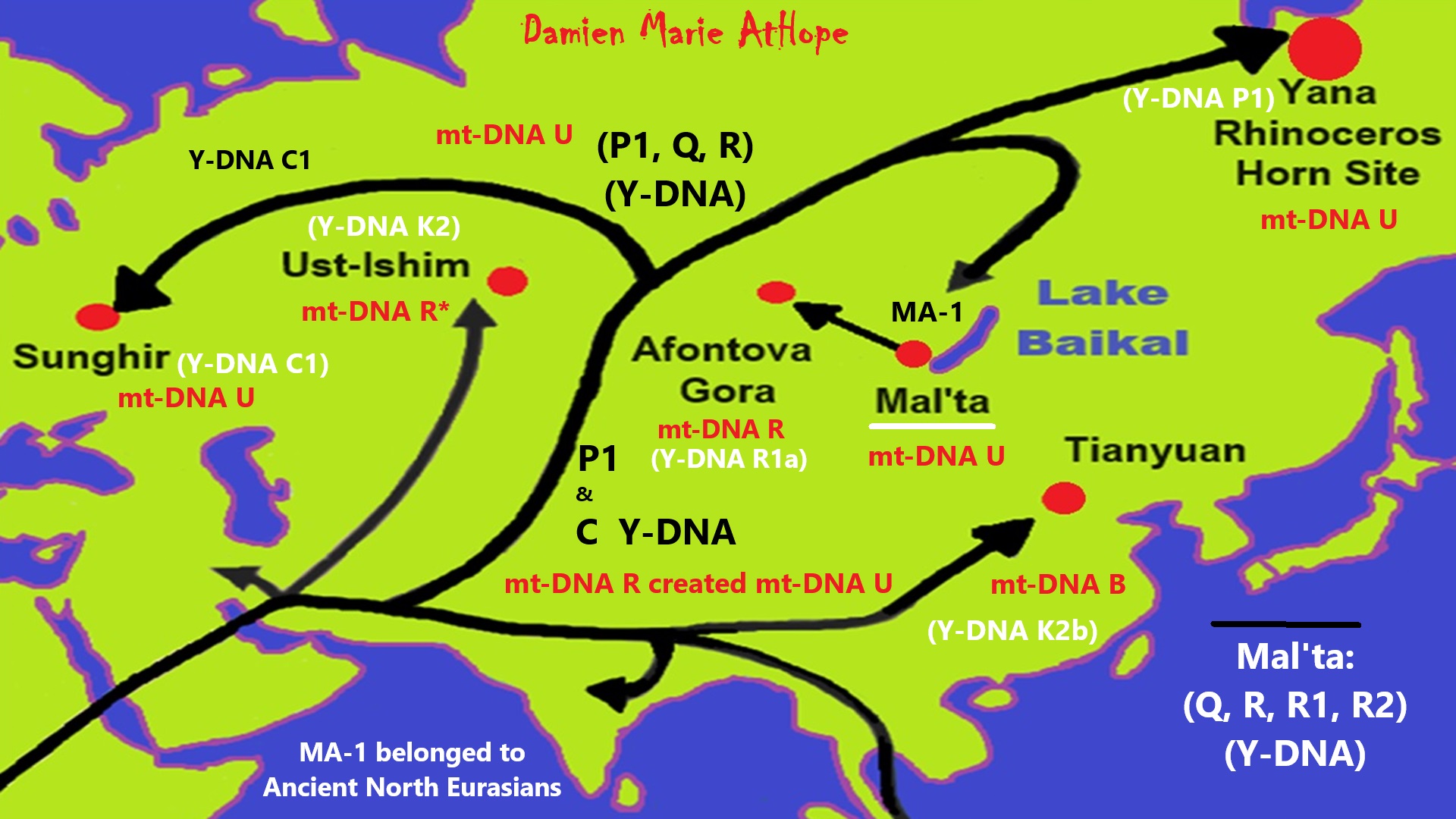
ref, ref, ref, ref, ref, ref, ref, ref, ref, ref, ref, ref, ref
“The genetic prehistory of humans in Asia, based on research using sequence data from humans who lived in Asia as early as 45,000 years ago. Genetic studies comparing present-day Australasians and Asians show that they likely derived from a single dispersal out of Africa, rapidly differentiating into three main lineages: one that persists partially in South Asia, one that is primarily found today in Australasia, and one that is widely represented across Siberia, East Asia, and Southeast Asia. Studies of ancient DNA from human remains in Asia dating from as far back as 45,000 years have greatly increased our understanding of the population dynamics leading to the current Asian populations.” ref
Ust’-Ishim man: Y-DNA haplogroupK2 and mt-DNA haplogroupR*
Tianyuan man: Y-DNA haplogroup K2b and mt-DNA haplogroup B
Yana Rhinoceros Horn Site: Y-DNA haplogroup P1 and mt-DNA haplogroup U
Sungir/Gravettian burials: Y-DNA haplogroup C1 and mt-DNA haplogroups U8c & U2
Ancient North Eurasians: Y-chromosome haplogroups P and its subclades R and Q and mt-DNA haplogroups U and R
Mal’ta–Buret’ culture: basalY-DNA haplogroup R* and mt-DNA haplogroup U
“MA-1 is the only known example of basal Y-DNA R* (R-M207*) – that is, the only member of haplogroup R* that did not belong to haplogroups R1, R2 or secondary subclades of these. The mitochondrial DNA of MA-1 belonged to an unresolved subclade of haplogroup U.” ref
“ANE ancestry has spread throughout Eurasia and the Americas in various migrations since the Upper Paleolithic, and more than half of the world’s population today derives between 5 and 42% of their genomes from the Ancient North Eurasians. Significant ANE ancestry can be found in Native Americans, as well as in Europe, South Asia, Central Asia, and Siberia. It has been suggested that their mythology may have featured narratives shared by both Indo-European and some Native American cultures, such as the existence of a metaphysical world tree and a fable in which a dog guards the path to the afterlife.” ref
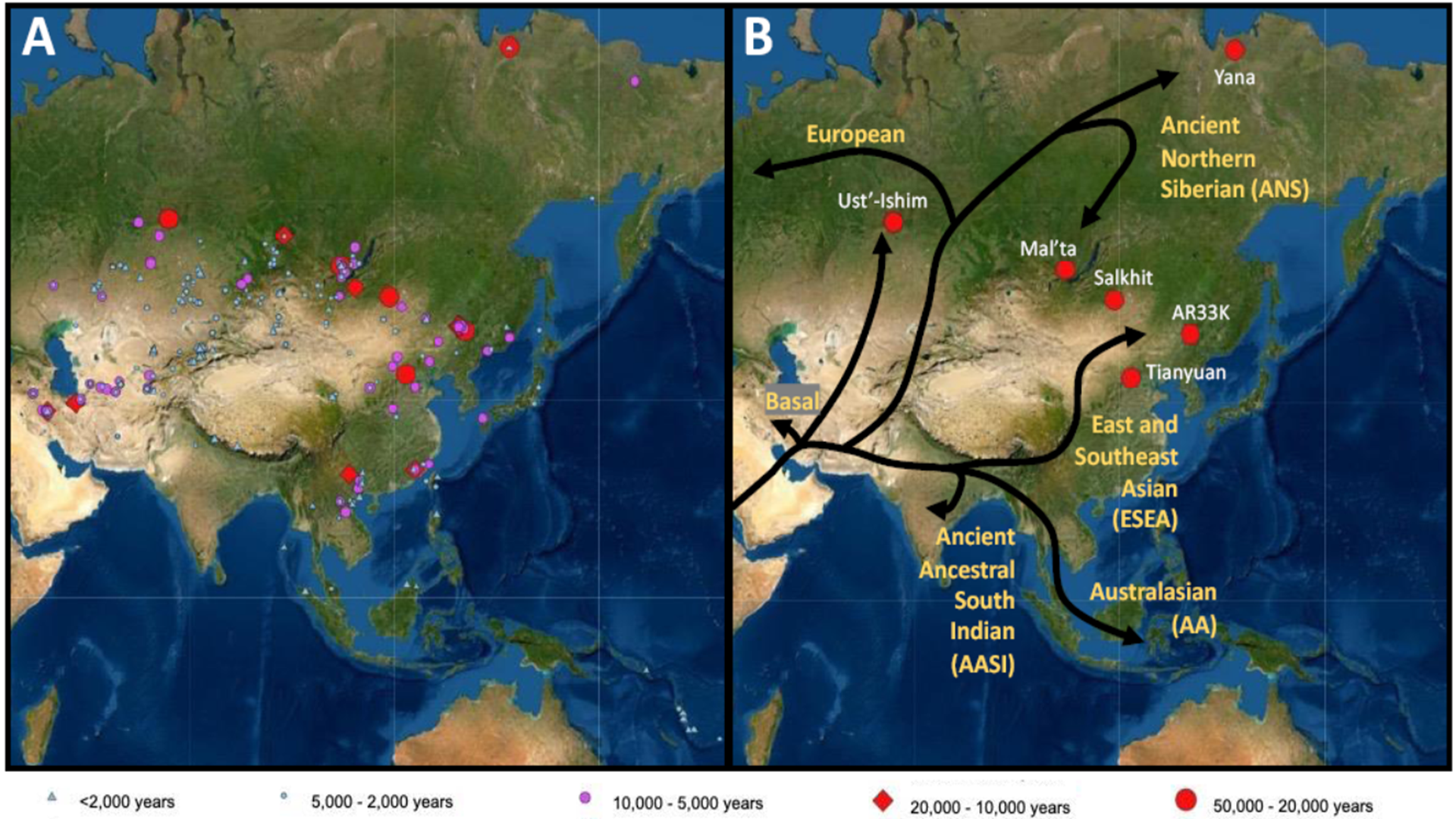
“Maps indicating the location of ancient DNA samples from Asia and the patterns of genetic differentiation in Asia in the Early Upper Paleolithic. (A) Location of ancient individuals from Asia and Australasia who have been sequenced to date. Symbols refer to the age of individuals sequenced from that archaeological site, with the key found at the bottom. Red symbols date to 50,000–10,000 years ago (Upper Paleolithic), purple and blue symbols are younger than 10,000 years. (B) Differentiation after dispersal out of Africa in the Early Upper Paleolithic (45,000–20,000 years ago), with labeled lineages or ancestries in yellow next to the associated branch. The tree diagram shows divergence patterns and is not meant to depict migration routes from the branches or geographic origins of ancestral populations from the internal nodes. The branches predominantly associated with present-day Asian populations include the Ancient Ancestral South Indian (AASI) lineage, Australasian (AA) lineage, and East and Southeast Asian (ESEA) lineage. White labels refer to specific archaeological sites dating to the Early Upper Paleolithic.” ref
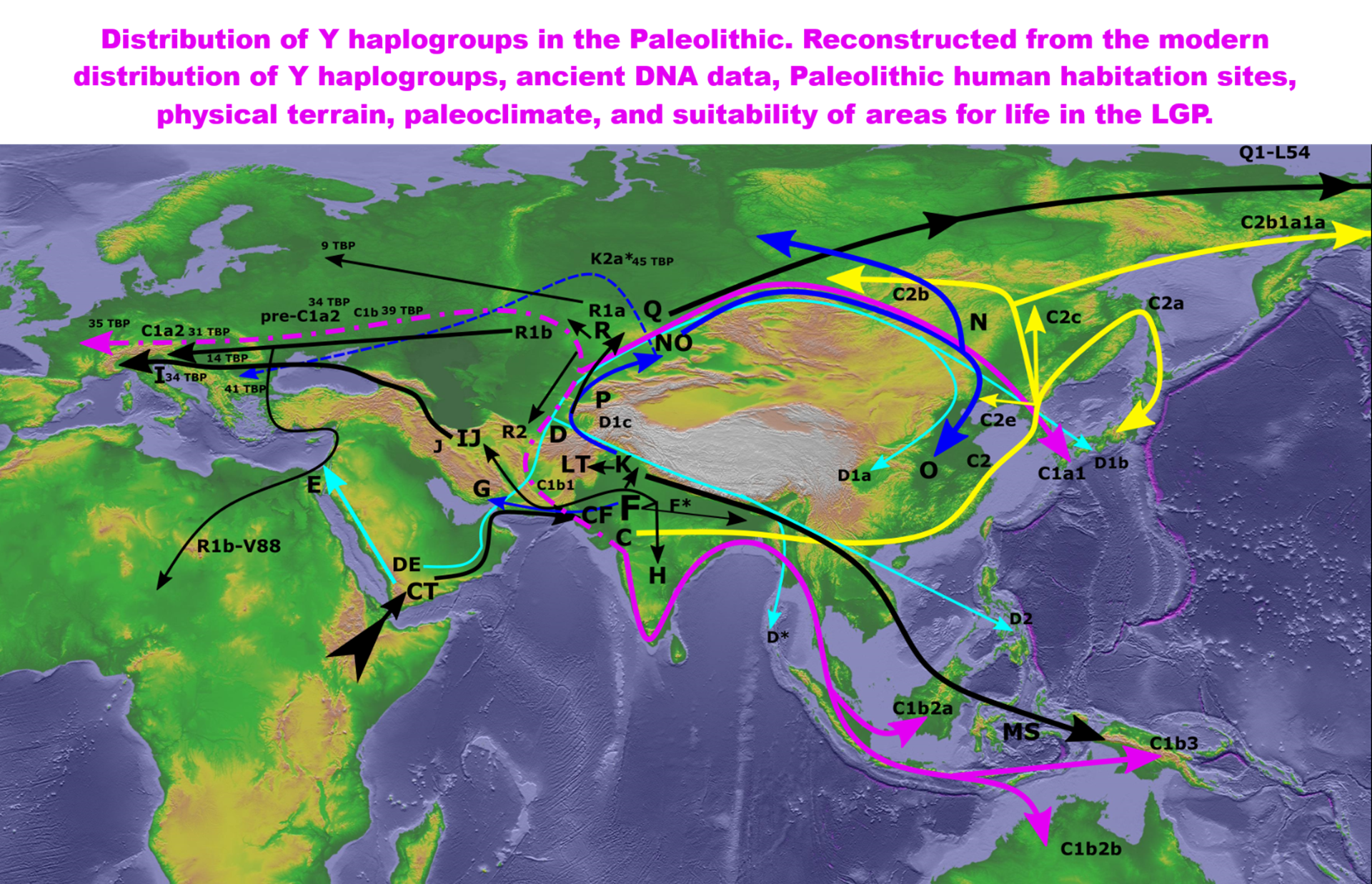
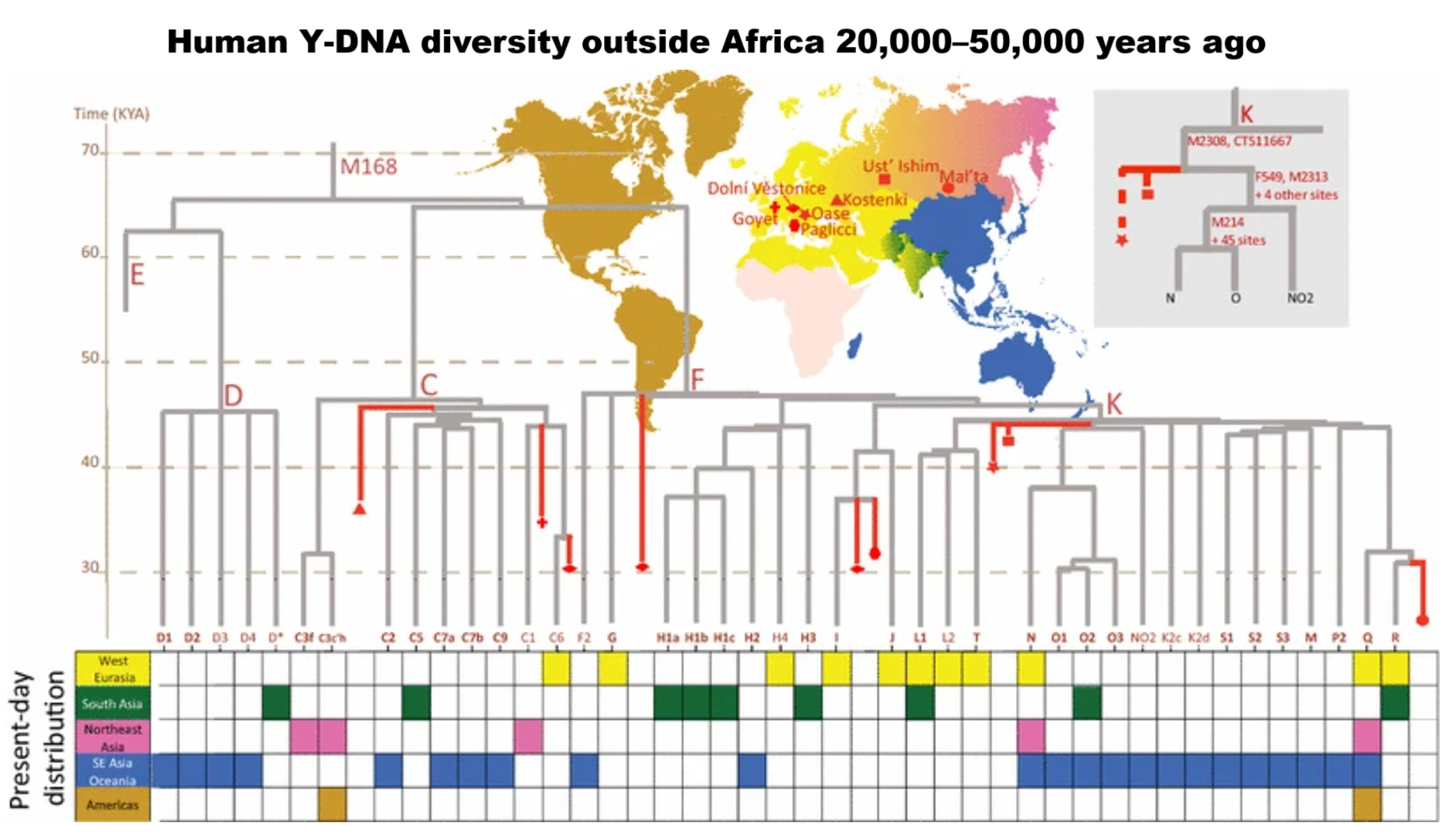
“Human Y chromosome diversity outside Africa 20–50 thousand years ago. The branching structure of 41 extant Y chromosome clades is inferred to be older than 30,000 years. The phylogenetic mapping to this tree of nine late Pleistocene ancient Y chromosomes that predate the Last Glacial Maximum—from Ust’Ishim, Oase, Kostenki, Malt’a, Dolní Věstonice, Goyet, and Paglicci sites—is shown in red. The zoomed-in version of the sub-tree relating Oase, Ust’Ishim with extant variation of the N, O, and NO2 clades is shown with branch-defining marker names next to the geographic map displaying the locations of the four ancient sites. The colour-coded distribution of Y chromosome haplogroups in present-day populations ignores cases of recent admixture.” ref

“Major sub-clades of Y chromosome haplogroup C in ancient and present-day populations. The structure of the major sub-clades is drawn in proportion to their coalescent time (the tip of each triangle) estimated from high-coverage genomes of present-day populations. The phylogenetic mapping of ancient Y chromosomes is shown with red symbols. Haplogroup names are shown in brown font, and haplogroup-defining SNP-marker names are in grey font next to relevant branches. The key areas of the present-day spread of the haplogroups are indicated with colour and white text inside the triangles. PNG Papua New Guinea.” ref
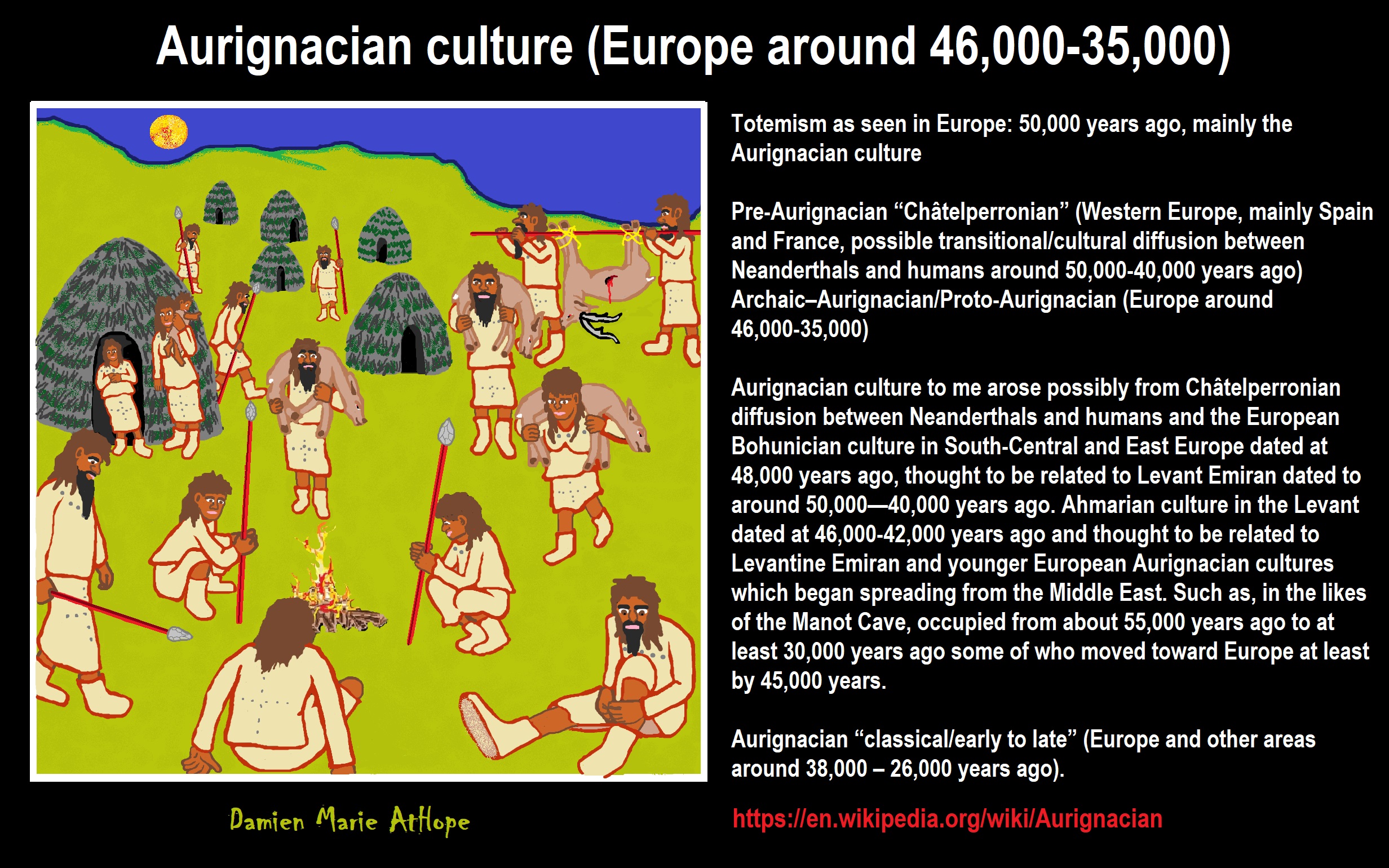
Châtelperronian Culture
“The Châtelperronian is a proposed industry of the Upper Palaeolithic, the existence of which is debated. It represents both the only Upper Palaeolithic industry made by Neanderthals and the earliest Upper Palaeolithic industry in Central and Southwestern France, as well as in Northern Spain. It derives its name from Châtelperron, Allier, France (the closest commune to the type site, the cave La Grotte des Fées). It is preceded by the Mousterian industry, and lasted from c. 45,000 to c. 40,000 years ago. The industry produced denticulate stone tools, and a distinctive flint knife with a single cutting edge and a blunt, curved back. The use of ivory at Châtelperronian sites appears to be more frequent than that of the later Aurignacian, while antler tools have not been found. It is followed by the Aurignacian industry. Scholars who question its existence claim that it is an archaeological mix of Mousterian and Aurignacian layers. The Châtelperronian industry may relate to the origins of the very similar Gravettian culture. French archaeologists have traditionally classified both cultures together under the name Périgordian, Early Perigordian being equivalent to the Châtelperronian and all the other phases corresponding to the Gravettian, though this scheme is not often used by Anglophone authors.” ref
Aurignacian Culture
“Key Issues/Current Debates: Variants of the Aurignacian Across Time and Space… Today, the Aurignacian is separated into many variants that are thought to be temporally or spatially meaningful. The first is the Protoaurignacian (i.e., Proto-Aurignacian, Fumanian) characterized by the production of large (c. 30–45 mm), straight bladelets (subtype
Dufour) from prismatic and pyramidal cores seen by some as the oldest phase of the Aurignacian. In southwest France, northern Italy, and Spain, when found together, the ProtoAurignacian is always superimposed by the Classic (Early)
Aurignacian where bladelets are generally produced from carinated cores. This production method resulted in smaller bladelets (c. 15–20 mm) with characteristic “twisted” profiles that were often retouched into Dufour bladelets (subtype Roc du Combe). However further east, where the ProtoAurignacian is less known, Classic Aurignacian assemblages often
directly follow the Middle Paleolithic and so-called transitional industries and are associated with radiocarbon dates as old as the first occurrence of the ProtoAurignacian in the Mediterranean thus making it difficult to simply consider the two assemblages as successive stages of the same cultural unit. It is also thought by some that the Classic Aurignacian later grew into the Late (Evolved) Aurignacian that is defined as having a larger, more varied tool kit including (backed) micro-
blades. However, such assemblages often share many cultural traits associated with the Gravettian, possibly relating to mechanical admixture, or suggesting that they represent a distinct cultural phenomenon.” ref
“The Aurignacian is an archaeological industry of the Upper Paleolithic associated with European early modern humans (EEMH) lasting from 43,000 to 26,000 years ago. The Upper Paleolithic developed in Europe some time after the Levant, where the Emiran period and the Ahmarian period form the first periods of the Upper Paleolithic, corresponding to the first stages of the expansion of Homo sapiens out of Africa. They then migrated to Europe and created the first European culture of modern humans, the Aurignacian. An Early Aurignacian or Proto-Aurignacian stage is dated between about 43,000 and 37,000 years ago. The Aurignacian proper lasts from about 37,000 to 33,000 years ago. A Late Aurignacian phase transitional with the Gravettian dates to about 33,000 to 26,000 years ago. The type site is the Cave of Aurignac, Haute-Garonne, south-west France. The main preceding period is the Mousterian of the Neanderthals.” ref
“One of the oldest examples of figurative art, the Venus of Hohle Fels, comes from the Aurignacian or Proto-Gravettian and is dated to between 40,000 and 35,000 years ago (though now earlier figurative art may be known, see Lubang Jeriji Saléh). It was discovered in September 2008 in a cave at Schelklingen in Baden-Württemberg in western Germany. The German Lion-man figure is given a similar date range. The Bacho Kiro site in Bulgaria is one of the earliest known Aurignacian burials. A “Levantine Aurignacian” culture is known from the Levant, with a type of blade technology very similar to the European Aurignacian, following chronologically the Emiran and Early Ahmarian in the same area of the Near East, and also closely related to them. The Levantine Aurignacian may have preceded European Aurignacian, but there is a possibility that the Levantine Aurignacian was rather the result of reverse influence from the European Aurignacian: this remains unsettled.” ref
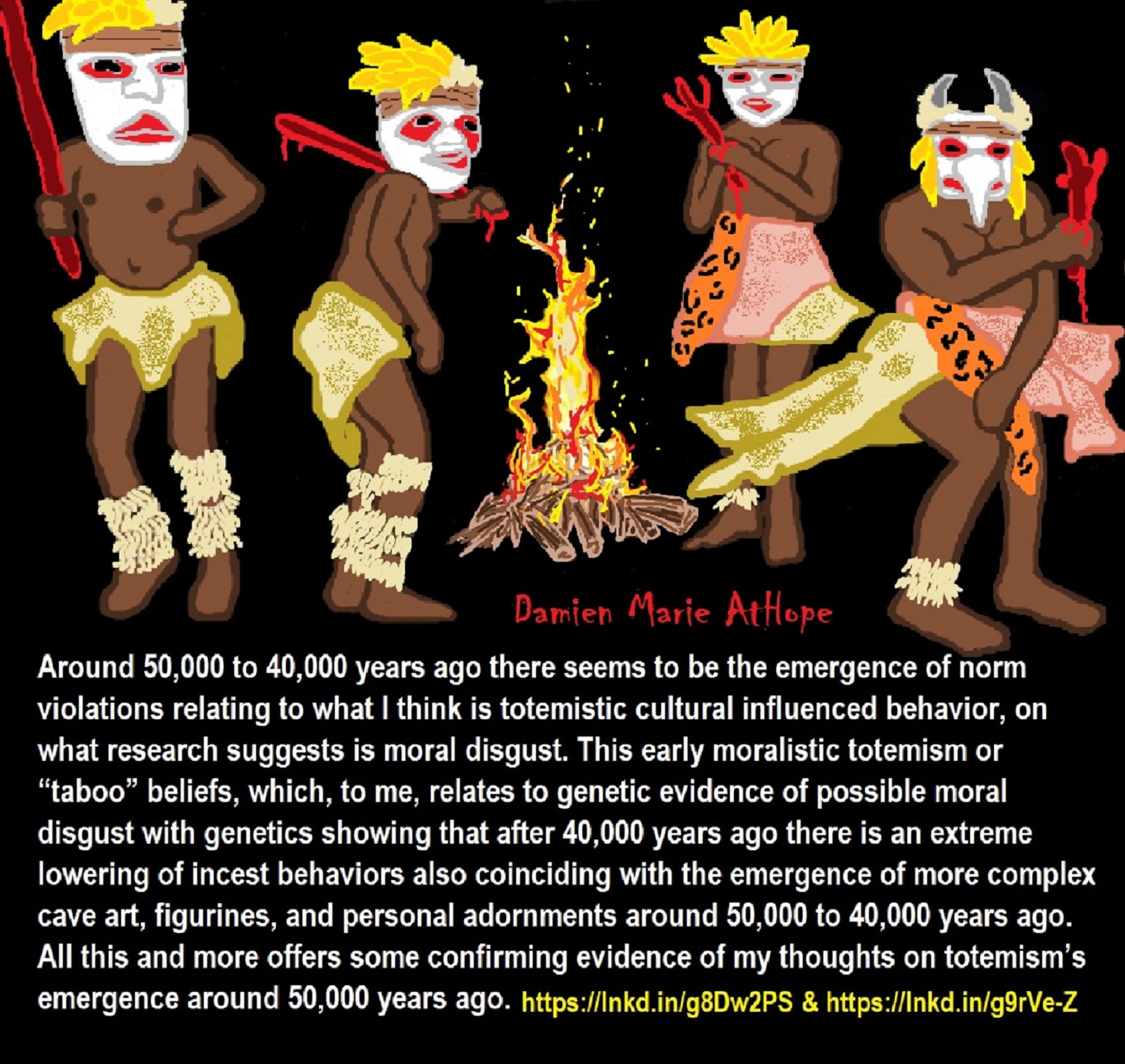
40,000 to 50,000 years ago, the Emergence of Norm Violations
Around 50,000 to 40,000 years ago there seems to be the emergence of norm violations relating to what I think is totemistic cultural influenced behavior, on what research suggests is moral disgust. This early moralistic totemism or “taboo” beliefs, which, to me, relates to genetic evidence of possible moral disgust with genetics showing that after 40,000 years ago there is an extreme lowering of incest behaviors also coinciding with the emergence of more complex cave art, figurines, and personal adornments around 50,000 to 40,000 years ago. All this and more offers some confirming evidence of my thoughts on totemism’s emergence around 50,000 years ago in western Europe, seen in the Pre-Aurignacian Neanderthal “Châtelperronian” and/or by the Early Aurignacian or Proto-Aurignacian times.
In the video “Robert Sapolsky: The Biology of Humans at Our Best and Worst” (17 or so minutes in) states the emergence of norm violations of moral disgust occurred around 40,000 to 50,000 years ago which is about the time that genetics shows after 40,000 years ago there was an extreme lowering of insect behaviors coinciding with the emergence of more complex cave art, figurines, and personal adornments all confirming my thoughts on totemism emerging after 50,000 years ago in Europe by the Early Aurignacian or Proto-Aurignacian stage. And in the video “DNA Mammoths, Neanderthals, and Your Ancestors,” it also quickly including the evidence for early people following incest taboos, are clearly evident after 40,000 years ago by genetics. Which, to me, likely connects to the motivations adopted by societies believing in Totemism. ref, ref
Animism (simplified to me as a belief in a perceived spirit world) passably by at least 100,000 years ago “the primal stage of early religion” To me, Animistic Somethingism: You just feel/think there has to be something supernatural/spirit-world or feel/think things are supernatural/spirit-filled.
Totemism (simplified to me, as a belief that these perceived spirits could be managed or related with by created physical expressions) passably by at least 50,000 years ago “progressed stage of early religion” A totem is a representational spirit being, a sacred object, or symbol of a group of people, clan, or tribe.
Shamanism (simplified to me as a belief that some special person can commune with these perceived spirits on the behalf of others by way of rituals) passably by at least 30,000 years ago Shamanism is an otherworld connection belief thought to heal the sick, communicate with spirits/deities, and escort souls of the dead.
Animism (such as that seen in Africa: 100,000 years ago)
Did Neanderthals teach us “Primal Religion (Pre-Animism/Animism?)” 120,000 Years Ago? Homo sapiens – is known to have reached the Levant between 120,000 and 90,000 years ago, but that exit from Africa evidently went extinct. 100,000 years ago, in Qafzeh, Israel, the oldest intentional burial had 15 African individuals covered in red ocher was from a group who visited and returned back to Africa. 100,000 to 74,000 years ago, at Border Cave in Africa, an intentional burial of an infant with red ochre and a shell ornament, which may have possible connections to the Africans buried in Qafzeh.
Animism is approximately a 100,000-year-old belief system and believe in spirit-filled life and/or afterlife. If you believe like this, regardless of your faith, you are a hidden animist.
The following is evidence of Animism: 100,000 years ago, in Qafzeh, Israel, the oldest intentional burial had 15 African individuals covered in red ocher was from a group who visited and returned back to Africa. 100,000 to 74,000 years ago, at Border Cave in Africa, an intentional burial of an infant with red ochre and a shell ornament, which may have possible connections to the Africans buried in Qafzeh, Israel. 120,000 years ago, did Neanderthals teach us Primal Religion (Pre-Animism/Animism) as they too used red ocher and burials? ref, ref
It seems to me, it may be the Neanderthals who may have transmitted a “Primal Religion (Animism)” or at least burial and thoughts of an afterlife. The Neanderthals seem to express what could be perceived as a Primal “type of” Religion, which could have come first and is supported in how 250,000 years ago, the Neanderthals used red ochre and 230,000 years ago shows evidence of Neanderthal burial with grave goods and possibly a belief in the afterlife. ref
Do you think it is crazy that the Neanderthals may have transmitted a “Primal Religion”? Consider this, it appears that 175,000 years ago, the Neanderthals built mysterious underground circles with broken off stalactites. This evidence suggests that the Neanderthals were the first humans to intentionally bury the dead, doing so in shallow graves along with stone tools and animal bones. Exemplary sites include Shanidar in Iraq, Kebara Cave in Israel and Krapina in Croatia. Other evidence may suggest the Neanderthals had it transmitted to them by Homo heidelbergensis, 350,000 years ago, by their earliest burial in a shaft pit grave in a cave that had a pink stone axe on the top of 27 Homo heidelbergensis individuals and 250,000 years ago, Homo naledi had an intentional cemetery in South Africa cave. ref, ref, ref, ref, ref
Totemism (Europe: 50,000 years ago)
Did Neanderthals Help Inspire Totemism? Because there is Art Dating to Around 65,000 Years Ago in Spain? Totemism as seen in Europe: 50,000 years ago, mainly the Aurignacian culture. Pre-Aurignacian “Châtelperronian” (Western Europe, mainly Spain and France, possible transitional/cultural diffusion between Neanderthals and Humans around 50,000-40,000 years ago). Archaic–Aurignacian/Proto-Aurignacian Humans (Europe around 46,000-35,000). And Aurignacian “classical/early to late” Humans (Europe and other areas around 38,000 – 26,000 years ago).
Totemism is approximately a 50,000-year-old belief system and believe in spirit-filled life and/or afterlife that can be attached to or be expressed in things or objects. If you believe like this, regardless of your faith, you are a hidden totemist.
Toetmism may be older as there is evidence of what looks like a Stone Snake in South Africa, which may be the “first human worship” dating to around 70,000 years ago. Many archaeologists propose that societies from 70,000 to 50,000 years ago such as that of the Neanderthals may also have practiced the earliest form of totemism or animal worship in addition to their presumably religious burial of the dead. Did Neanderthals help inspire Totemism? There is Neanderthals art dating to around 65,000 years ago in Spain. ref, ref
Shamanism (beginning around 30,000 years ago)
Shamanism (such as that seen in Siberia Gravettian culture: 30,000 years ago). Gravettian culture (34,000–24,000 years ago; Western Gravettian, mainly France, Spain, and Britain, as well as Eastern Gravettian in Central Europe and Russia. The eastern Gravettians, which include the Pavlovian culture). And, the Pavlovian culture (31,000 – 25,000 years ago such as in Austria and Poland). 31,000 – 20,000 years ago Oldest Shaman was Female, Buried with the Oldest Portrait Carving.
Shamanism is approximately a 30,000-year-old belief system and believe in spirit-filled life and/or afterlife that can be attached to or be expressed in things or objects and these objects can be used by special persons or in special rituals that can connect to spirit-filled life and/or afterlife. If you believe like this, regardless of your faith, you are a hidden shamanist.
Around 29,000 to 25,000 years ago in Dolní Vestonice, Czech Republic, the oldest human face representation is a carved ivory female head that was found nearby a female burial and belong to the Pavlovian culture, a variant of the Gravettian culture. The left side of the figure’s face was a distorted image and is believed to be a portrait of an elder female, who was around 40 years old. She was ritualistically placed beneath a pair of mammoth scapulae, one leaning against the other. Surprisingly, the left side of the skull was disfigured in the same manner as the aforementioned carved ivory figure, indicating that the figure was an intentional depiction of this specific individual. The bones and the earth surrounding the body contained traces of red ocher, a flint spearhead had been placed near the skull, and one hand held the body of a fox. This evidence suggests that this was the burial site of a shaman. This is the oldest site not only of ceramic figurines and artistic portraiture but also of evidence of early female shamans. Before 5,500 years ago, women were much more prominent in religion.
Archaeologists usually describe two regional variants: the western Gravettian, known namely from cave sites in France, Spain, and Britain, and the eastern Gravettian in Central Europe and Russia. The eastern Gravettians include the Pavlovian culture, which were specialized mammoth hunters and whose remains are usually found not in caves but in open air sites. The origins of the Gravettian people are not clear, they seem to appear simultaneously all over Europe. Though they carried distinct genetic signatures, the Gravettians and Aurignacians before them were descended from the same ancient founder population. According to genetic data, 37,000 years ago, all Europeans can be traced back to a single ‘founding population’ that made it through the last ice age. Furthermore, the so-called founding fathers were part of the Aurignacian culture, which was displaced by another group of early humans members of the Gravettian culture. Between 37,000 years ago and 14,000 years ago, different groups of Europeans were descended from a single founder population. To a greater extent than their Aurignacian predecessors, they are known for their Venus figurines. ref, ref, ref, ref, ref, ref, ref, ref, ref, ref, & ref
Paganism (beginning around 12,000 years ago)
Paganism (such as that seen in Turkey: 12,000 years ago). Gobekli Tepe: “first human-made temple” around 12,000 years ago. Sedentism and the Creation of goddesses around 12,000 years ago as well as male gods after 7,000 years ago. Pagan-Shaman burial in Israel 12,000 years ago and 12,000 – 10,000 years old Paganistic-Shamanistic Art in a Remote Cave in Egypt. Skull Cult around 11,500 to 8,400 Years Ago and Catal Huyuk “first religious designed city” around 10,000 years ago.
Paganism is approximately a 12,000-year-old belief system and believe in spirit-filled life and/or afterlife that can be attached to or be expressed in things or objects and these objects can be used by special persons or in special rituals that can connect to spirit-filled life and/or afterlife and who are guided/supported by a goddess/god, goddesses/gods, magical beings, or supreme spirits. If you believe like this, regardless of your faith, you are a hidden paganist.
Around 12,000 years ago, in Turkey, the first evidence of paganism is Gobekli Tepe: “first human-made temple” and around 9,500 years ago, in Turkey, the second evidence of paganism is Catal Huyuk “first religious designed city”. In addition, early paganism is connected to Proto-Indo-European language and religion. Proto-Indo-European religion can be reconstructed with confidence that the gods and goddesses, myths, festivals, and form of rituals with invocations, prayers, and songs of praise make up the spoken element of religion. Much of this activity is connected to the natural and agricultural year or at least those are the easiest elements to reconstruct because nature does not change and because farmers are the most conservative members of society and are best able to keep the old ways.
The reconstruction of goddesses/gods characteristics may be different than what we think of and only evolved later to the characteristics we know of today. One such characteristic is how a deity’s gender may not be fixed, since they are often deified forces of nature, which tend to not have genders. There are at least 40 deities and the Goddesses that have been reconstructed are: *Pria, *Pleto, *Devi, *Perkunos, *Aeusos, and *Yama.
The reconstruction of myths can be connected to Proto-Indo-European culture/language and by additional research, many of these myths have since been confirmed including some areas that were not accessible to the early writers such as Latvian folk songs and Hittite hieroglyphic tablets. There are at least 28 myths and one of the most widely recognized myths of the Indo-Europeans is the myth, “Yama is killed by his brother Manu” and “the world is made from his body”. Some of the forms of this myth in various Indo-European languages are about the Creation Myth of the Indo-Europeans.
The reconstruction of rituals can be connected to Proto-Indo-European culture/language and is estimated to have been spoken as a single language from around 6,500 years ago. One of the earliest ritual is the construction of kurgans or mound graves as a part of a death ritual. kurgans were inspired by common ritual-mythological ideas. Kurgans are complex structures with internal chambers. Within the burial chamber at the heart of the kurgan, elite individuals were buried with grave goods and sacrificial offerings, sometimes including horses and chariots.
The speakers of Pre-Proto-Indo-European lived in Turkey and it associates the distribution of historical Indo-European languages with the expansion around 9,000 years ago, with a proposed homeland of Proto-Indo-European proper in the Balkans around 7,000 years ago. The Proto-Indo-European Religion seemingly stretches at least back around 6,000 years ago or likely much further back and I believe Paganism is possibly an approximately 12,000-year-old belief system.
The earliest kurgans date to 6,000 years ago and are connected to the Proto-Indo-European in the Caucasus. In fact, around 7,000 years ago, there appears to be pre-kurgan in Siberia. Around 7,000 to 2,500 years ago and beyond, kurgans were built with ancient traditions still active in Southern Siberia and Central Asia, which display the continuity of the archaic forming methods. Kurgan cultures are divided archaeologically into different sub-cultures such as Timber Grave, Pit Grave, Scythian, Sarmatian, Hunnish, and Kuman–Kipchak. Kurgans have been found from the Altay Mountains to the Caucasus, Ukraine, Romania, and Bulgaria. Around 5,000 years ago, kurgans were used in the Ukrainian and Russian flat unforested grasslands and their use spread with migration into eastern, central, northern Europe, Turkey, and beyond. ref, ref, ref, ref, ref, ref, ref, ref, ref, ref, ref, ref, & ref
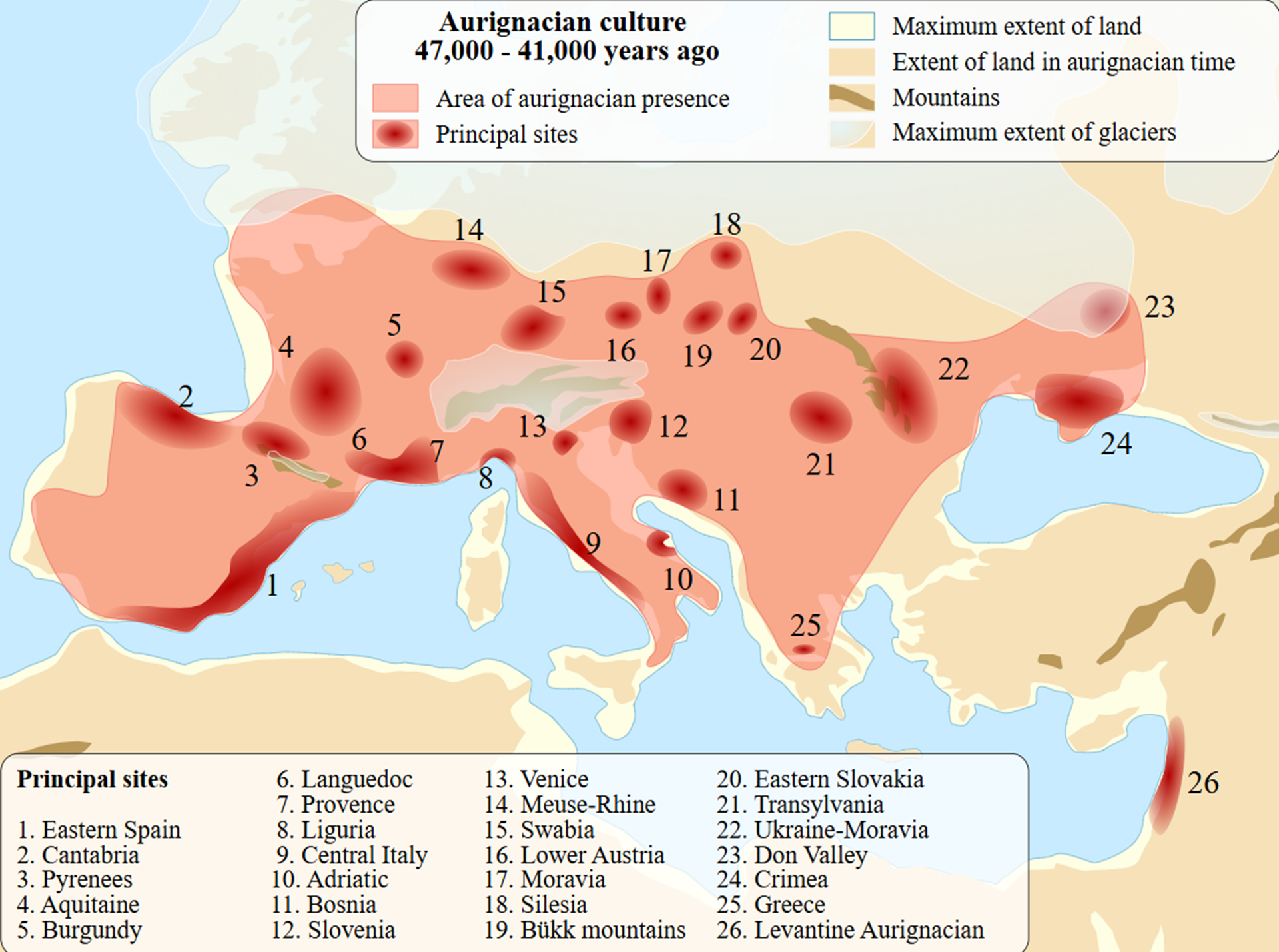
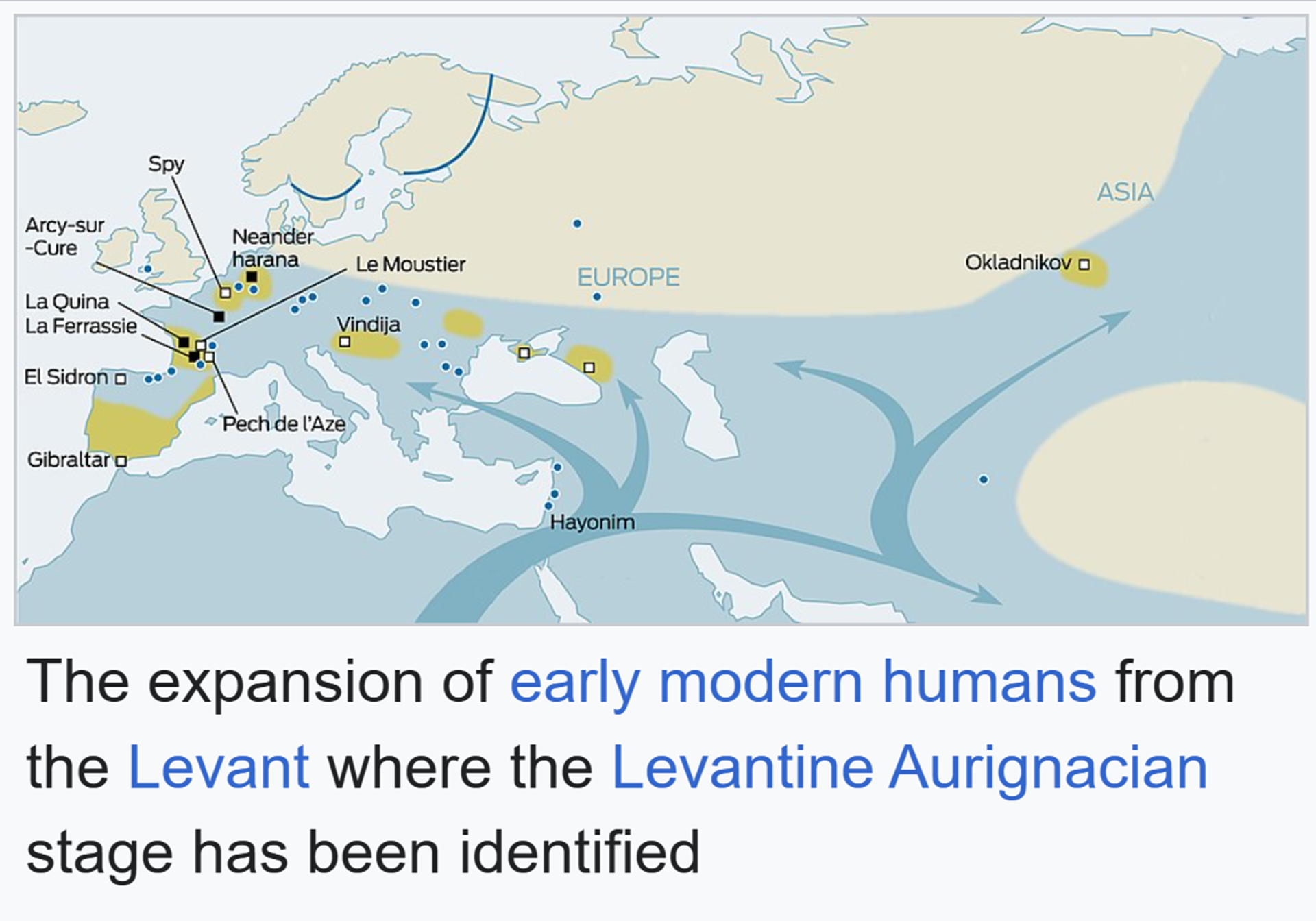
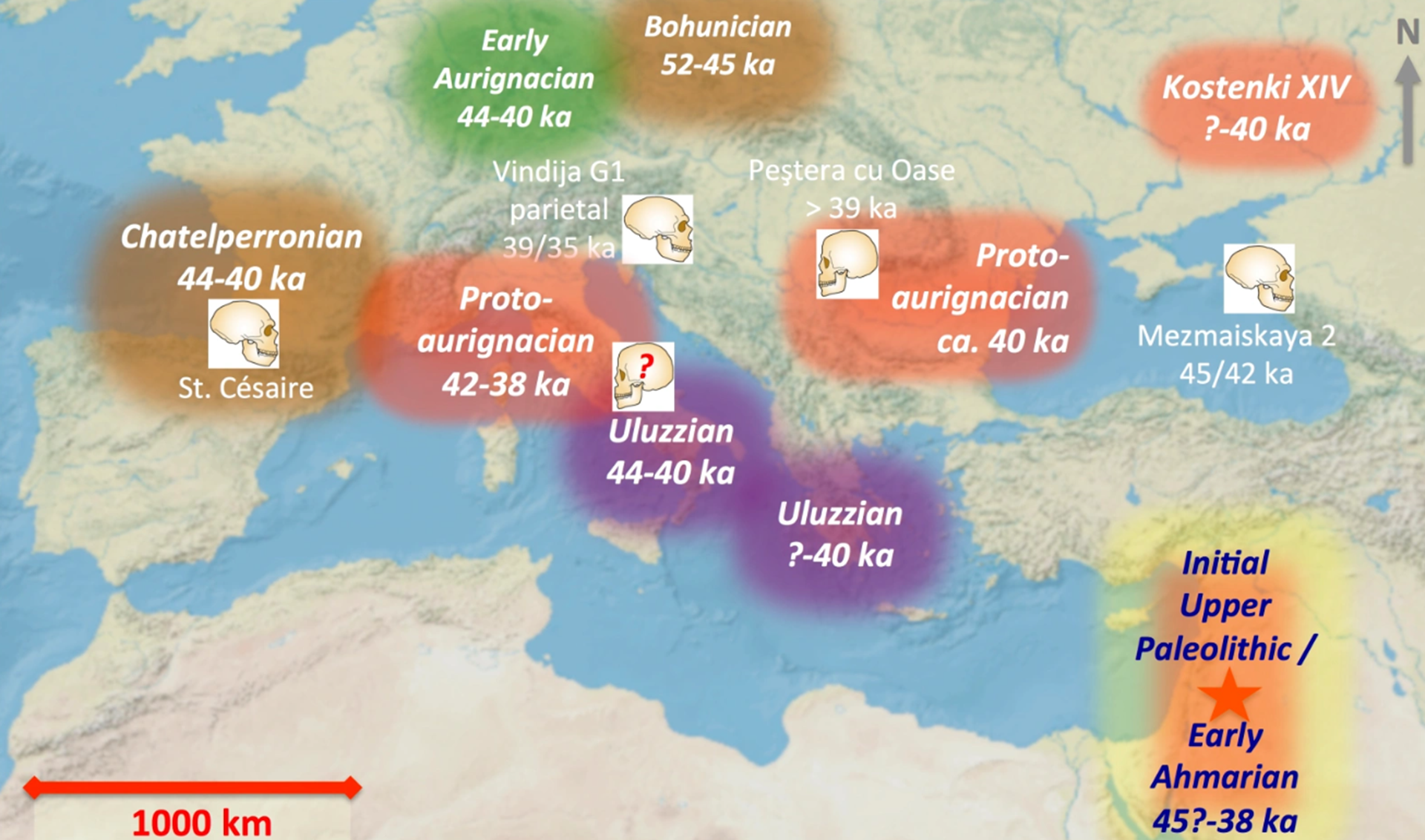
“Protoaurignacian artifact patterns date to ca. 40,000 years ago, with the oldest solidly documented sites at ca. 42,000 years ago. The Protoaurignacian and Protoaurignacian-like technological systems are found from the Levant (where it’s known as the Early Ahmarian technocomplex; from the Kostenki XIV site in central Russia; from Bulgaria and Romania; and northern Italy. Protoaurignacian-like artifact assemblages from northern France, Germany, and Iran may not stretch as far back as 42,000 years ago, but they do date to around 40,000 years ago, and they underscore the geographic extent to which the technological phenomenon spread. However, the Protoaurignacian emerged along side diverse Early Upper Paleolithic technological systems, which vary in the ways that blades and flakes were produced, shaped as tools and points, and resharpened. But especially in the Levant, it is not clear if these named technocomplexes have discrete geographic and temporal boundaries that might reflect corresponding biocultural systems, constituted by socially bounded populations. Thus, in the Levant, an artifact pattern known as the Initial Upper Paleolithic dominates layers that predate 42,000 years ago at several sites. It is important to note that use of the Levallois technique alongside blade production on narrow-fronted cores at the Mughr el-Hamamah site (marked by the red star) likely occurred before 42,000 years ago. This information is based on just-published radiocarbon dates. Thus, IUP and Early Ahmarian technological features may represent alternative stone tool management strategies used by the same social networks of hunter-gatherers in the Levant, from around 45,000-40,000 years ago … and possibly after. It is important to note that the human remains that have either been carefully directly dated or associated with well-dated deposits (anatomically modern human teeth from Uluzzian and Protoaurignacian layers) comprise a mix of diagnostic Neandertals and anatomically modern humans. Moreover, the Protoaurignacian is simply neither the first nor the only technological system that existed in Europe between 45,000-40,000 years ago.” ref
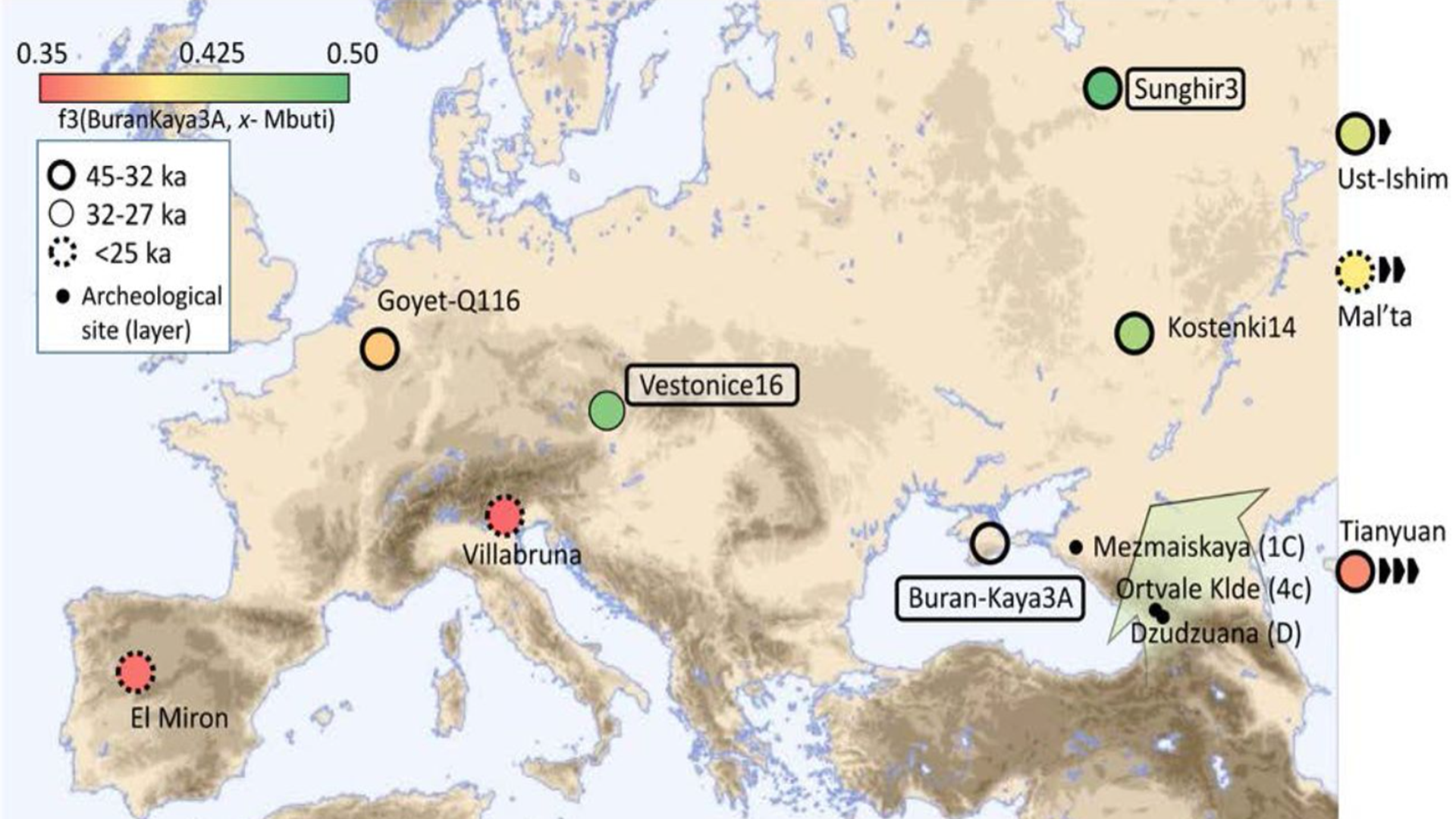
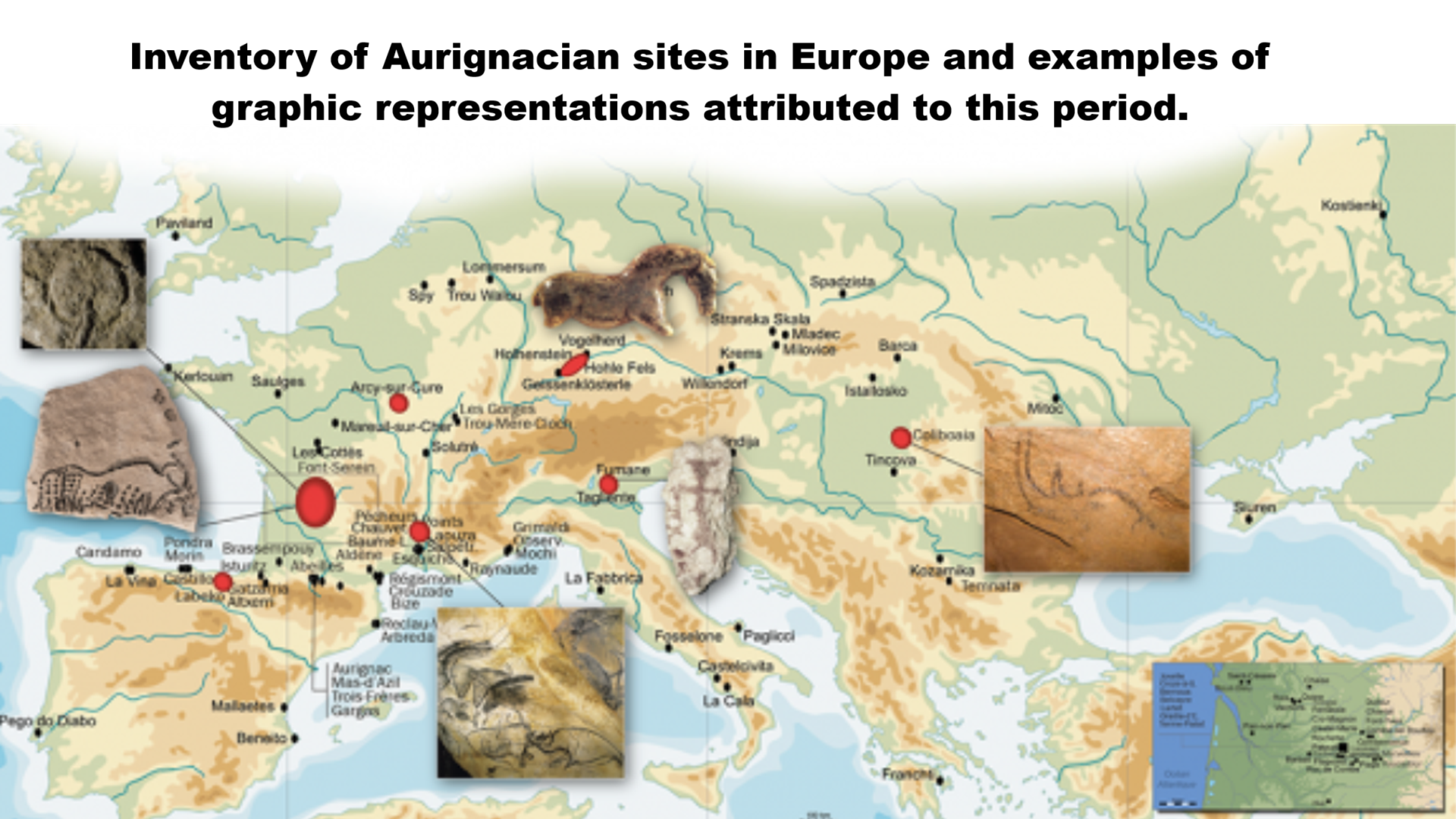
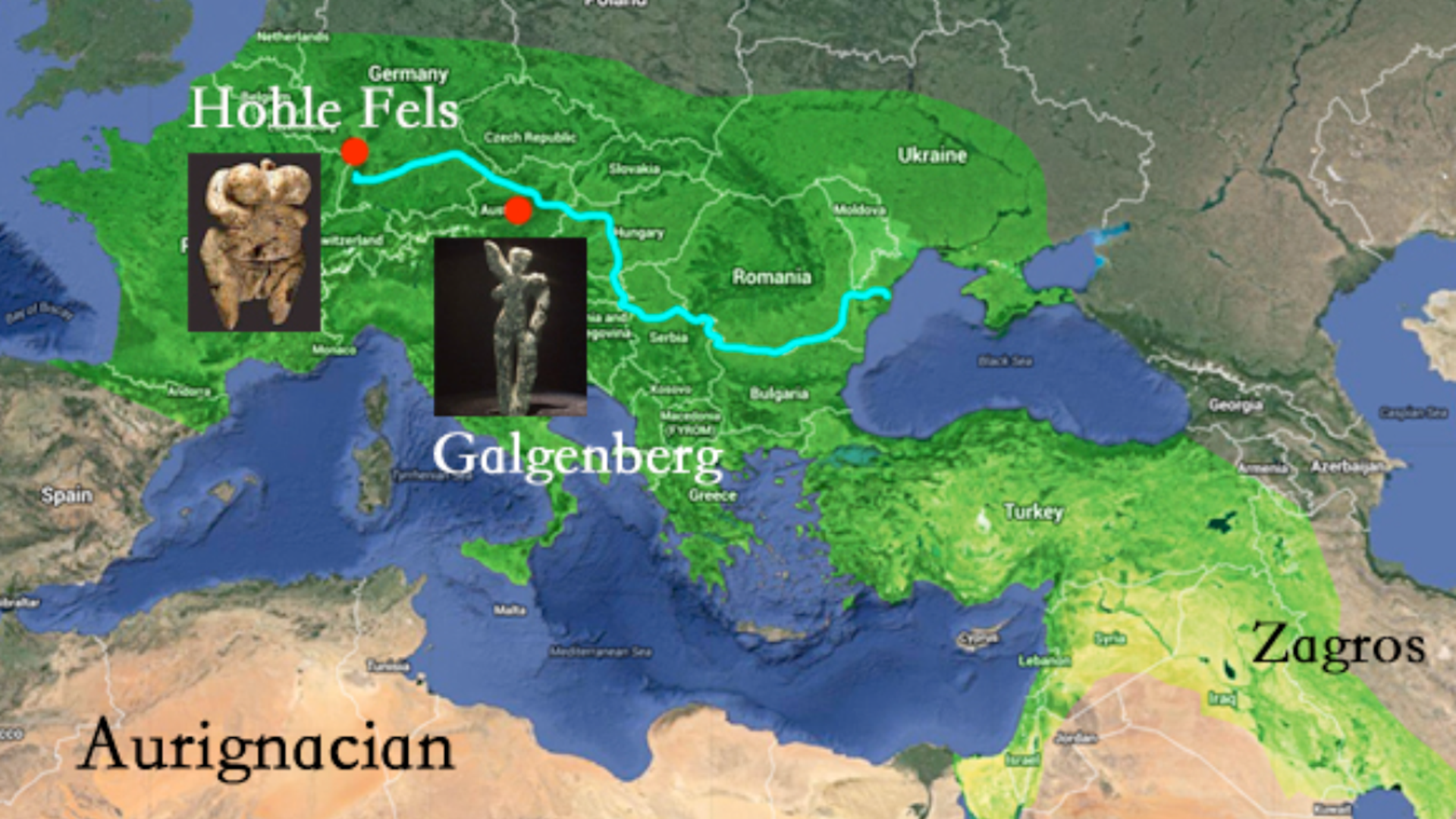

ref, ref, ref, ref, ref, ref, ref, ref, ref, ref, ref, ref, ref, ref, ref, ref, ref, ref, ref, ref, ref, ref
40,000 to 25,000 Years Old Ritual (Venus) Figurines and their Cultural Connections distributed across much of Eurasia, from the Aurignacian to the Gravettian Periods
Venus figurines
(I see them as representing Ancestor spirits/Earth or Nature Spirits/Tutelary spirits, not Deities)
Some also seem to me to represent female shamans: “All these are related to the Mongolian name of Etügen, the hearth goddess, andEtügen Eke‘Mother Earth’.Maria Czaplickapoints out that Siberian languages use words for male shamans from diverse roots, but the words for female shaman are almost all from the same root. She connects this with the theory that women’s practice of shamanism was established earlier than men’s, that “shamans were originally female.” ref
“A Venus figurine is any Upper Palaeolithic statue portraying a woman, usually carved in the round. Most have been unearthed in Europe, but others have been found as far away as Siberia and distributed across much of Eurasia. Most date from the Gravettian period (26,000–21,000 years ago). However, findings are not limited to this period; for example, the Venus of Hohle Fels dates back at least 35,000 years to the Aurignacian era, and the Venus of Monruz dates back about 11,000 years to the Magdalenian. Such figurines were carved from soft stone (such as steatite, calcite or limestone), bone or ivory, or formed of clay and fired. The latter are among the oldest ceramics known to historians. In total, over 200 such figurines are known; virtually all of modest size, between about 3 and 40 cm (1.2 and 15.7 in) in height. These figurines are recognised as some of the earliest works of prehistoric art.” ref
“Most have wide hips and legs that taper to a point. Arms and feet are often absent, and the head is usually small and faceless. Various figurines exaggerate the abdomen, hips, breasts, thighs, or vulva, although many found examples do not reflect these typical characteristics. Depictions of hairstyles can be detailed, and clothing or tattoos may be indicated. The original cultural meaning and purpose of these artefacts is not known. It has frequently been suggested that they may have served a ritual or symbolic function. There are widely varying and speculative interpretations of their use or meaning: they have been seen as religious figures, an expression of health and fertility, grandmother goddesses, or as self-depictions by female artists.” ref
“Upper Palaeolithic female figurines are collectively described as “Venus figurines” in reference to the Roman goddess of beauty Venus. The name was first used in the mid-nineteenth century by the Marquis de Vibraye, who discovered an ivory figurine and named it La Vénus impudique or Venus Impudica (“immodest Venus”). The Marquis then contrasted the ivory figurine to the Aphrodite Of Knidos, a Greco-Roman sculpture depicting Venus covering her naked body with both her hands. In the early 20th century, the general belief among scholars was that the figurines represent an ancient ideal of beauty. Since their discovery, considerable diversity in opinion amongst archaeologists and in palaeoanthropological literature has arisen as to the function and significance of the figures. Most scholars that have differing opinions on the purpose of the figurines, such as anthropologist Randall White, also disapprove of the “Venus” name as a result.” ref
“The use of the name is metaphorical as there is no link between the ancient figurines and the Roman goddess Venus; although they have been interpreted as representations of a primordial female goddess. This perception is said to have derived from the fact that attention is directed to certain features common to most of the figurines, in particular emotionally charged primary and secondary sexual characteristics such as the breasts, stomachs and buttocks. The term has been criticised for being a reflection of modern Western ideas rather than reflecting the beliefs of the sculptures’ original owners, but the original names are unknown as well, so the term Venus has persisted. Like many prehistoric artefacts, the exact cultural meaning of these figures may never be known. Archaeologists speculate, however, that they may be symbolic of security and success, fertility, or a mother goddess. The female figures are a part of Upper Palaeolithic art, specifically the category of Palaeolithic art known as portable art.” ref

“Macro-haplogroup M mtDNA is found mostly in Asia and the Americas. Its descendants are haplogroup M, haplogroup C, haplogroup Z, haplogroup D, haplogroup E, haplogroup G and haplogroup Q. Macro-haplogroup N mtDNA is found mostly in Australia, the Americas and parts of Asia. Its descendants are haplogroup N, haplogroup O, haplogroup A, haplogroup S, haplogroup I, haplogroup W, haplogroup X and haplogroup Y, as well as macro-haplogroup R. Macro-haplogroup R mtDNA is found mostly in Europe, Northern Africa, the Pacific and parts of Asia and the Americas. Its descendants are haplogroup R, haplogroup B, haplogroup F, haplogroup H, haplogroup V, haplogroup J, haplogroup T, haplogroup U and haplogroup K.” ref
Haplogroup U
“Haplogroup U is a human mitochondrial DNA haplogroup (mtDNA). The clade arose from haplogroup R, likely during the early Upper Paleolithic. Its various subclades (labeled U1–U9, diverging over the course of the Upper Paleolithic). Haplogroup U descends from the haplogroup R mtDNA branch of the phylogenetic tree. The defining mutations (A11467G, A12308G, G12372A) are estimated to have arisen between 43,000 and 50,000 years ago, in the early Upper Paleolithic (around 46,530 ± 3,290 years before present, with a 95% confidence interval per Behar et al., 2012). Ancient DNA classified as belonging to the U* mitochondrial haplogroup has been recovered from human skeletal remains found in Western Siberia, which have been dated to c. 45,000 years ago. The mitogenome (33-fold coverage) of the Peştera Muierii 1 individual (PM1) from Romania (35,000 years ago) has been identified as the basal haplogroup U6* not previously found in any ancient or present-day humans.” ref
“Haplogroup U is found in approximately 11% of native Europeans and is held as the oldest maternal haplogroup found in that region. In a 2013 study, all but one of the ancient modern human sequences from Europe belonged to maternal haplogroup U, thus confirming previous findings that haplogroup U was the dominant type of Mitochondrial DNA (mtDNA) in Europe before the spread of agriculture into Europe from the Near East. Subclades are labelled U1–U9; Haplogroup K is a subclade of U8. Basal U was found in the 26,000 years old remains of Ancient North Eurasian, Mal’ta boy (MA1). Haplogroup U1 estimated to have arisen between 26,000 and 37,000 years ago. It is found at very low frequency throughout Europe. It is more often observed in eastern Europe, Anatolia, and the Near East.” ref
“Haplogroup U1 estimated to have arisen between 26,000 and 37,000 years ago. It is found at very low frequency throughout Europe. It is more often observed in eastern Europe, Anatolia and the Near East. It is also found at low frequencies in India. U1 is found in the Svanetia region of Georgia at 4.2%. Subclade U1a is found from India to Europe, but is extremely rare among the northern and Atlantic fringes of Europe including the British Isles and Scandinavia. In India, U1a has been found in the Kerala region. U1b has a similar spread but is rarer than U1a.” ref
“Haplogroup U2 is an extremely old lineage, going back at least 40,000 years, when Homo sapiens first expanded from the Middle East into South Asia and Central Asia, and before they even set foot in Europe. Two of the oldest Homo sapiens DNA samples from Europe tested to date, a 37,000 and a 33,000-year old Cro-Magnons from the Kostenki site on the Don River in the Russia, both belonged to haplogroup U2. Their paternal lineages were identified as Y-haplogroups C1b and CT, two Paleolithic lineages that are now believed to be extinct in Europe. Y-haplogroup C was the first to leave Africa and colonise Eurasia 70,000 years ago. C1b still exists today in the Arabian peninsula, in India and in Polynesia (Hawaii, Micronesia, New Zealand). The extremely wide dispersal of Y-DNA haplogroup C and mtDNA haplogroup U2 attest to their antiquity.” ref
“More U2 samples were identified among other Paleolithic and Mesolithic European hunter-gatherers, including four Gravettian U2* individuals from Goyet Cave in Belgium dating from 22,000 to 24,000 years ago, a 11,000 year-old U2e from Blätterhöhle in Germany, two 9,500 year-old U2e individuals from Karelia in Russia, and two 8,000 year-old U2e1 individuals from Motala in Sweden. Based on these ancient DNA results from Europe and the presence of all basal subclades of U2 in Central Asia, it is likely that U2 people roamed between Central Europe and Central Asia during the Paleolithic and Mesolithic, and perhaps already in other parts of Europe and in South Asia. The steppes of eastern Europe and Central Asia are probably the original geographic location from which such a dispersal was made possible during the Stone Age, and again during the Bronze Age.” ref
“Haplogroup U3 originated over 30,000 years ago, in all likelihood among Middle Eastern nomadic hunter-gatherers. The U3a subclade is thought to have arisen some time between 18,000 and 26,000 years ago, a period corresponding to the Last Glacial Maximum (LGM).” ref
“Haplogroup U4 originated approximately 25,000 years ago, during the Last Glacial Maximum (LGM). U4 appears to have been a relatively common lineage among Mesolithic European hunter-gatherers. It was identified in skeletons from Mesolithic Russia (including some U4a1 samples), Lithuania, Sweden and Germany. Based on the small number of Mesolithic samples tested to date, U4 seems to have been much more common in Northeast Europe than elsewhere. This would make sense since it correlates strongly with Y-haplogroup R1a nowadays.” ref
“The age of U5 is estimated at between 25,000 and 35,000 years old, roughly corresponding to the Gravettian culture. Approximately 11% of Europeans (10% of European-Americans) have some variant of haplogroup U5. The haplogroup most likely originated in Europe. U5 was the predominant mtDNA of mesolithic Western Hunter Gatherers (WHG). U5 has been found in human remains dating from the Mesolithic in England, Germany, Lithuania, Poland, Portugal, Russia, Sweden, France and Spain. Haplogroup U5 and its subclades U5a and U5b today form the highest population concentrations in the far north, among Sami, Finns, and Estonians. However, it is spread widely at lower levels throughout Europe. This distribution, and the age of the haplogroup, indicate individuals belonging to this clade were part of the initial expansion tracking the retreat of ice sheets from Europe around 10,000 years ago.” ref
“Additionally, haplogroup U5 is found in small frequencies and at much lower diversity in the Near East and parts of northern Africa (areas with sizable U6 concentrations), suggesting back-migration of people from Europe toward the south. U5 was the main haplogroup of Mesolithic European hunter gatherers. U haplogroups were present at 83% in European hunter gatherers before influx of Middle Eastern farmer and steppe Indo-European ancestry decreased its frequency to less than 21%. U5a1 arose between 14,000 and 20,000 years ago. Found in an Etruscan individual (700-600 BCE) from southern Etruria, Italy. U5b arose between 19,000 and 26,000 years ago and has polymorphisms in 150 7768 14182 ( + U5 polymorphisms). Found among Siwa Berbers of the Siwa Oasis in Egypt. U5b1 arose between 11,000 and 20,000 years ago. The Cheddar Man from Great Britain is a well-known specimen.” ref
“U5b2 arose between 17,000 and 23,000 years ago and has polymorphisms in 1721 13637( + U5b polymorphisms). The clade has been found in remains dating from prehistoric times in Europe, such as the subclade U5b2c1 of La Braña man (found at the La Braña site in Spain). U5b2 is rare among French Basques (2.5%) and more frequent in the Spanish Basques. U5b2a between 12,000 and 19,000 years ago, prevalent in Central Europe.” ref
“Haplogroup U6 was dated to between 31,000 and 43,000 years ago. Basal U6* was found in a Romanian specimen of ancient DNA (Peștera Muierilor) dated to 35,000 years ago. Evidence for Paleolithic back-migration of Homo sapiens from Eurasia into Africa. The discovery of basal U6* in ancient DNA contributed to setting back the estimated age of U6 to around 46,000 years ago. Usually U6 genetic history is envisioned as a migration from southwest Asia through North Africa. This hypothesis is based on the general origin of haplogroup U sub-clades in Southwest Asia, which is also the center of the geographical distribution of U sub-clades: Europe, India, Central Asia, East Africa and North Africa. Two possible scenarios for the first U6 haplotype (bearing mutations 3348 and 16172) can be advanced: i) these mutations aroused in the founder region but did not leave any genetic legacy in current human populations there; ii) they originated probably somewhere in North Africa, after the arrival of the U6 founder haplotype.” ref
“Within North Africa U6 is only significantly frequent at its western edge (as well as in South-western Europe). More importantly, all the most basal branches are virtually restricted to that region (U6b, U6c and U6d), what could indicate its western origin. Nevertheless, it cannot be excluded the major sub-clade U6a, which shows a richness of sub-clades in Northwest Africa although a few of derivative branches also include sequences from East African and the Middle Eastern populations (e.g. U6a2). Haplogroup U6 is common (with a prevalence of around 10%) in Northwest Africa (with a maximum of 29% in an Algerian Mozabites) and the Canary Islands (18% on average with a peak frequency of 50.1% in La Gomera). It is also found in the Iberian peninsula, where it has the highest diversity (10 out of 19 sublineages are only found in this region and not in Africa), Northeast Africa and occasionally in other locations. U6 is also found at low frequencies in the Chad Basin, including the rare Canarian branch. This suggests that the ancient U6 clade bearers may have inhabited or passed through the Chad Basin on their way westward toward the Canary Islands.” ref
“U6 is thought to have entered North Africa from the Near East around 30,000 years ago. It has been found among Iberomaurusian specimens dating from the Epipaleolithic at the Taforalt prehistoric site. In spite of the highest diversity of Iberian U6, Maca-Meyer argues for a Near East origin of this clade based on the highest diversity of subclade U6a in that region, where it would have arrived from West Asia, with the Iberian incidence primarily representing migration from the Maghreb and not the persistence of a European root population. According to Hernández et al. 2015 “the estimated entrance of the North African U6 lineages into Iberia at 10,000 years ago correlates well with other L African clades, indicating that U6 and some L lineages moved together from Africa to Iberia in the Early Holocene.” ref
“Haplogroup U7 is considered a West Eurasian–specific mtDNA haplogroup, believed to have originated in the Black Sea area approximately 30,000 years ago. In modern populations, U7 occurs at low frequency in the Caucasus, the western Siberian tribes, West Asia (about 4% in the Near East, while peaking with 10% in Iranians), South Asia (about 12% in Gujarat, the westernmost state of India, while for the whole of India its frequency stays around 2%, and 5% in Pakistan), and the Vedda people of Sri Lanka where it reaches it highest frequency of 13.33% (subclade U7a). One third of the West Eurasian-specific mtDNAs found in India are in haplogroups U7, R2, and W.” ref
“The haplogroup U8b’s most common subclade is haplogroup K, which is estimated to date to between 30,000 and 22,000 years ago. Haplogroup K makes up a sizeable fraction of European and West Asian mtDNA lineages. Haplogroup U8a: The Basques mt-DNA has the most ancestral phylogeny in Europe for the mitochondrial haplogroup U8a. This is a rare subgroup of U8, placing the Basque origin of this lineage in the Upper Palaeolithic. The lack of U8a lineages in Africa suggests that their ancestors may have originated from West Asia.” ref
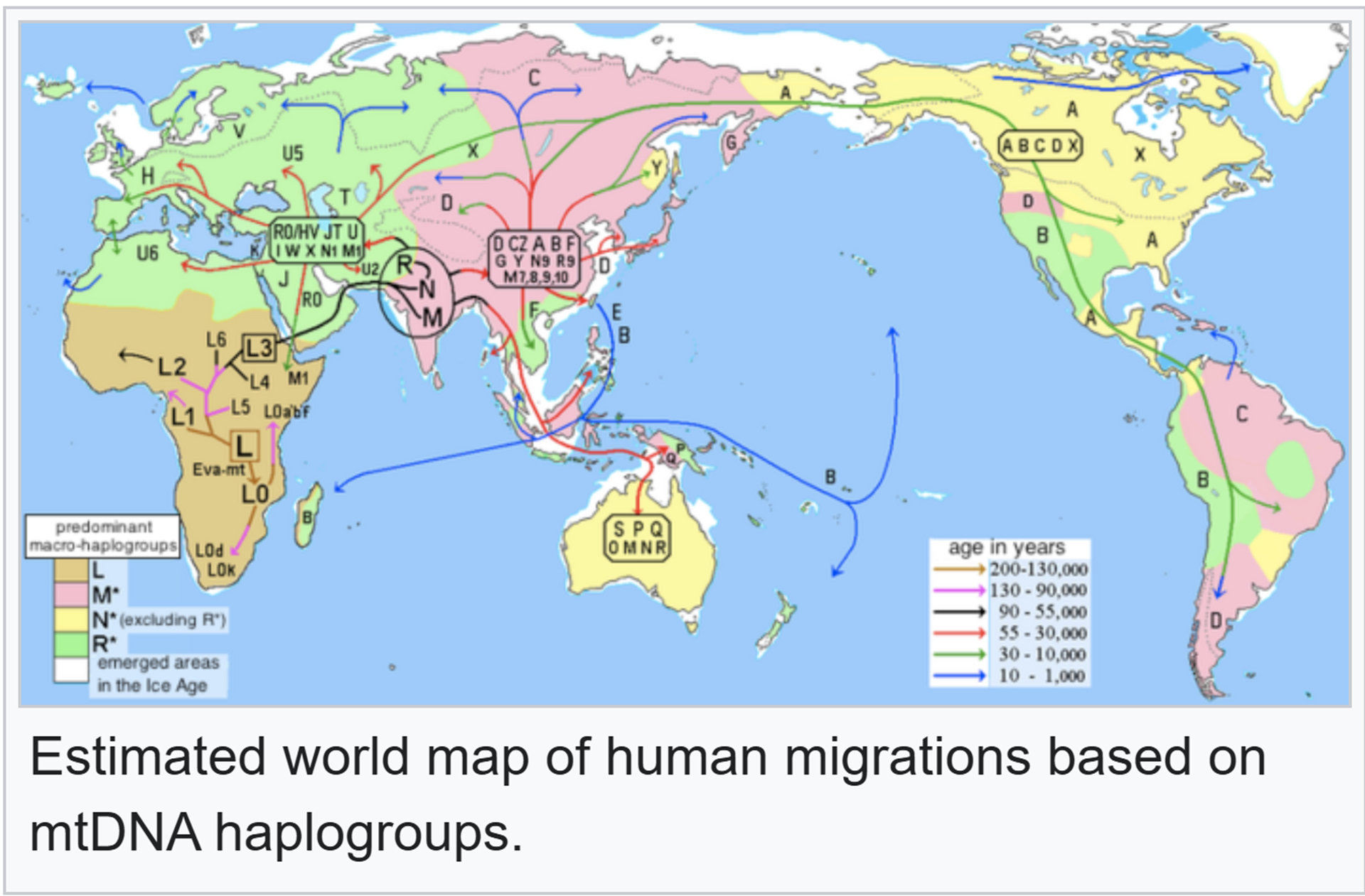
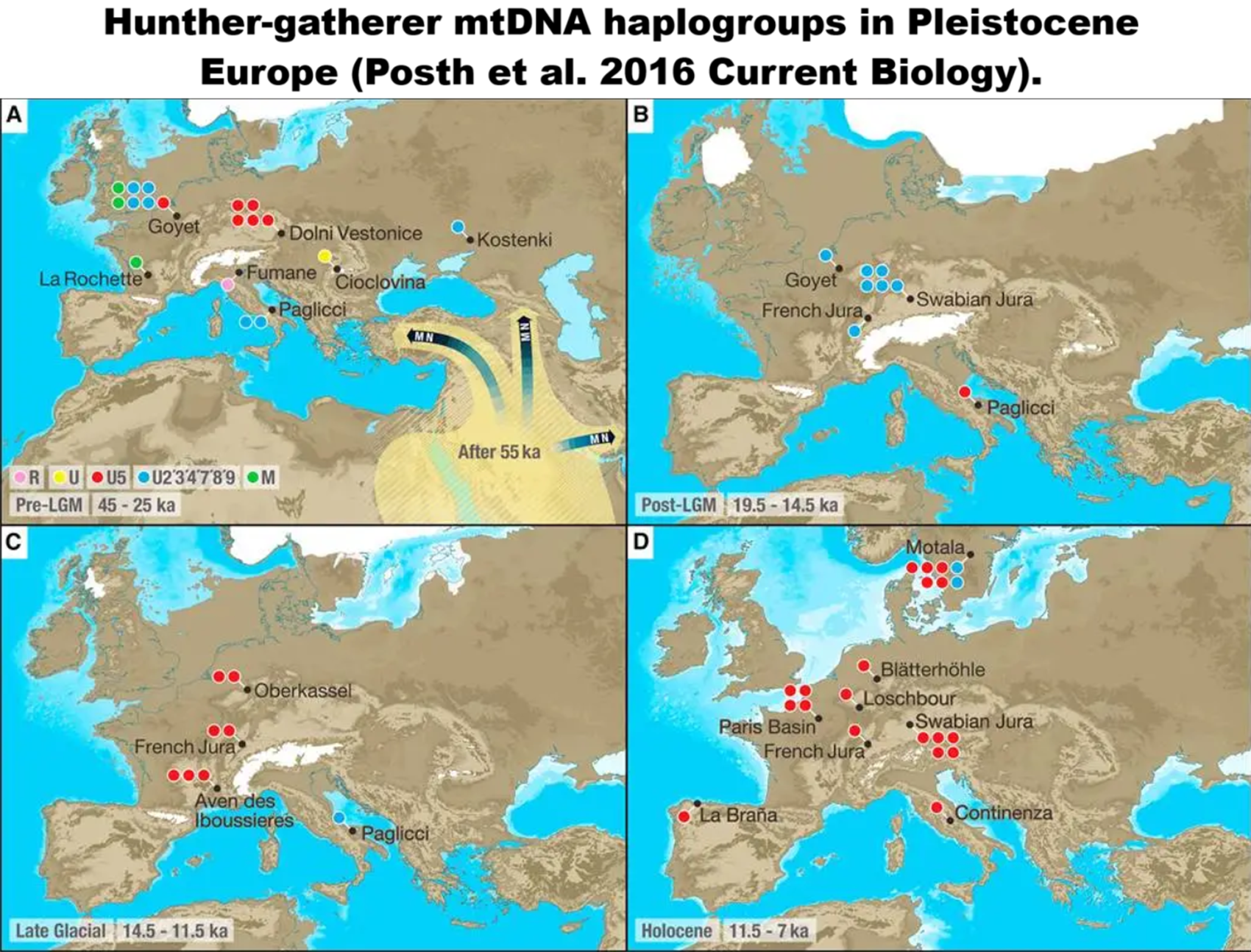
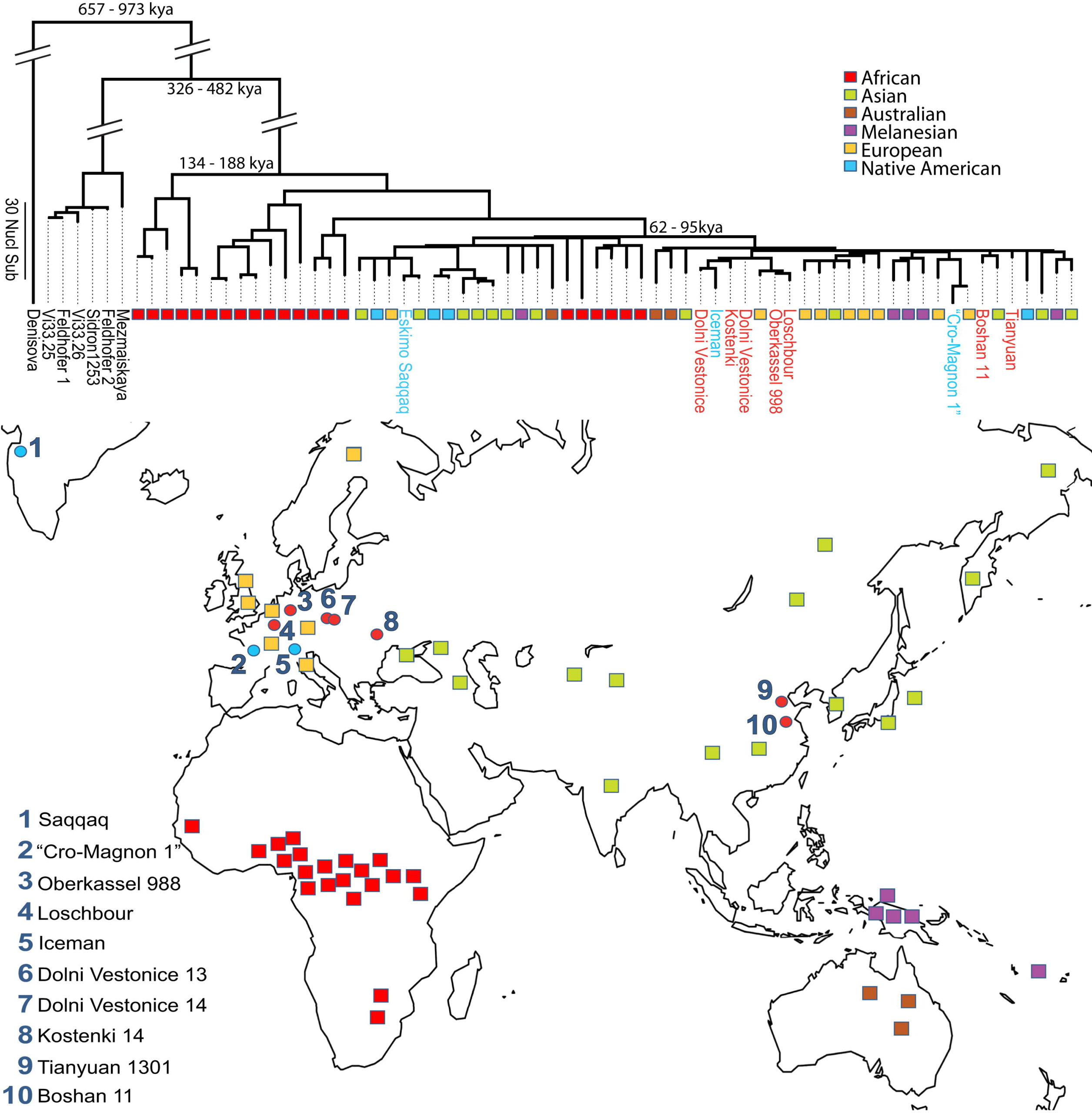
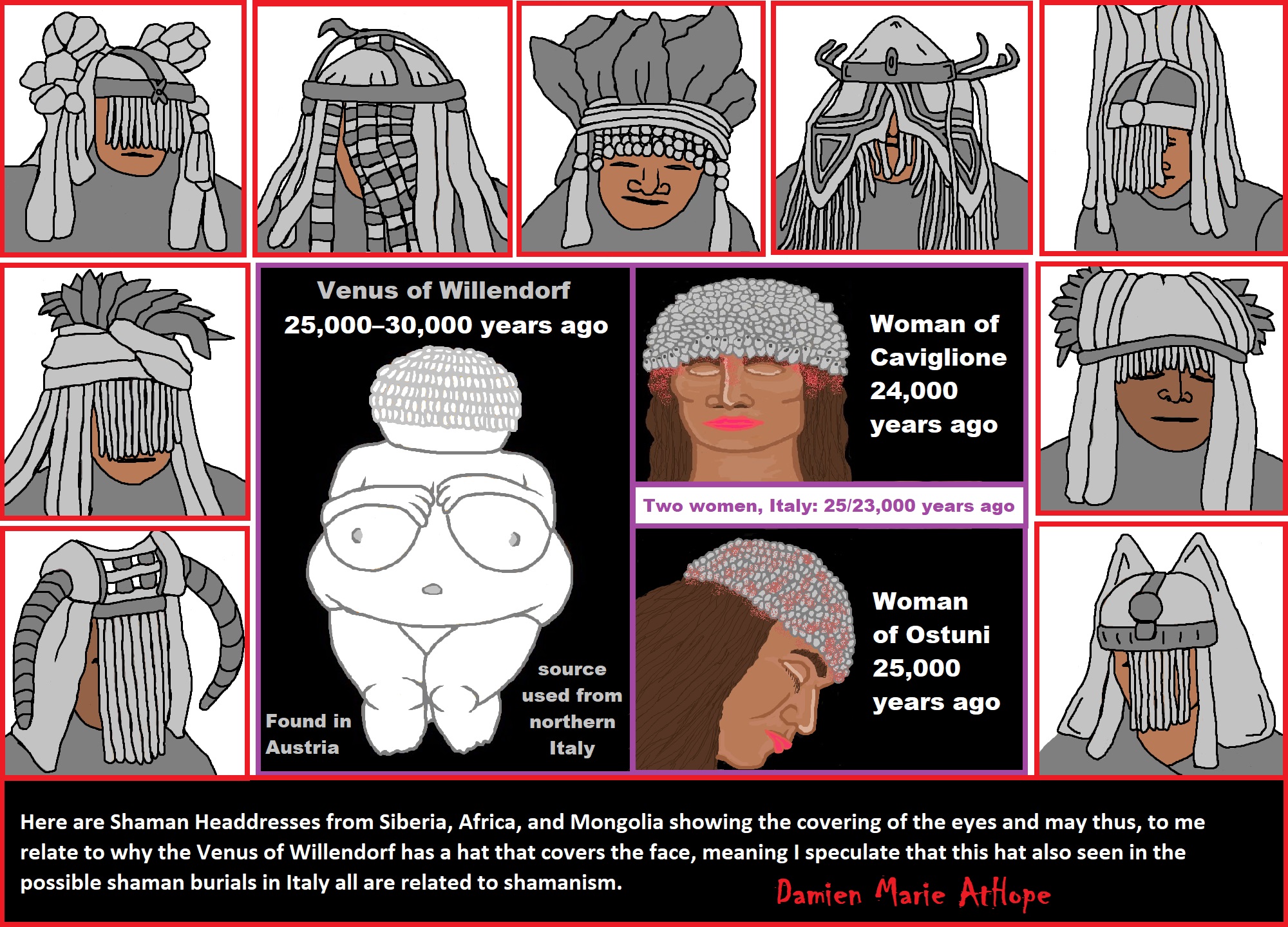
Here are Shaman Headdresses from Siberia, Africa, and Mongolia showing the covering of the eyes and may thus, to me relate to why the Venus of Willendorf has a hat that covers the face, meaning I speculate that this hat, also seen in the possible shaman burials in Italy all are related to shamanism.
“Venus figurines have been unearthed in Europe, Siberia, and much of Eurasia.
Most date from the Gravettian period but start in the Aurignacian era, and lasts to the Magdalenian time.” ref
Venus of Willendorf: Shamanism Headdresses that Cover the Eyes?
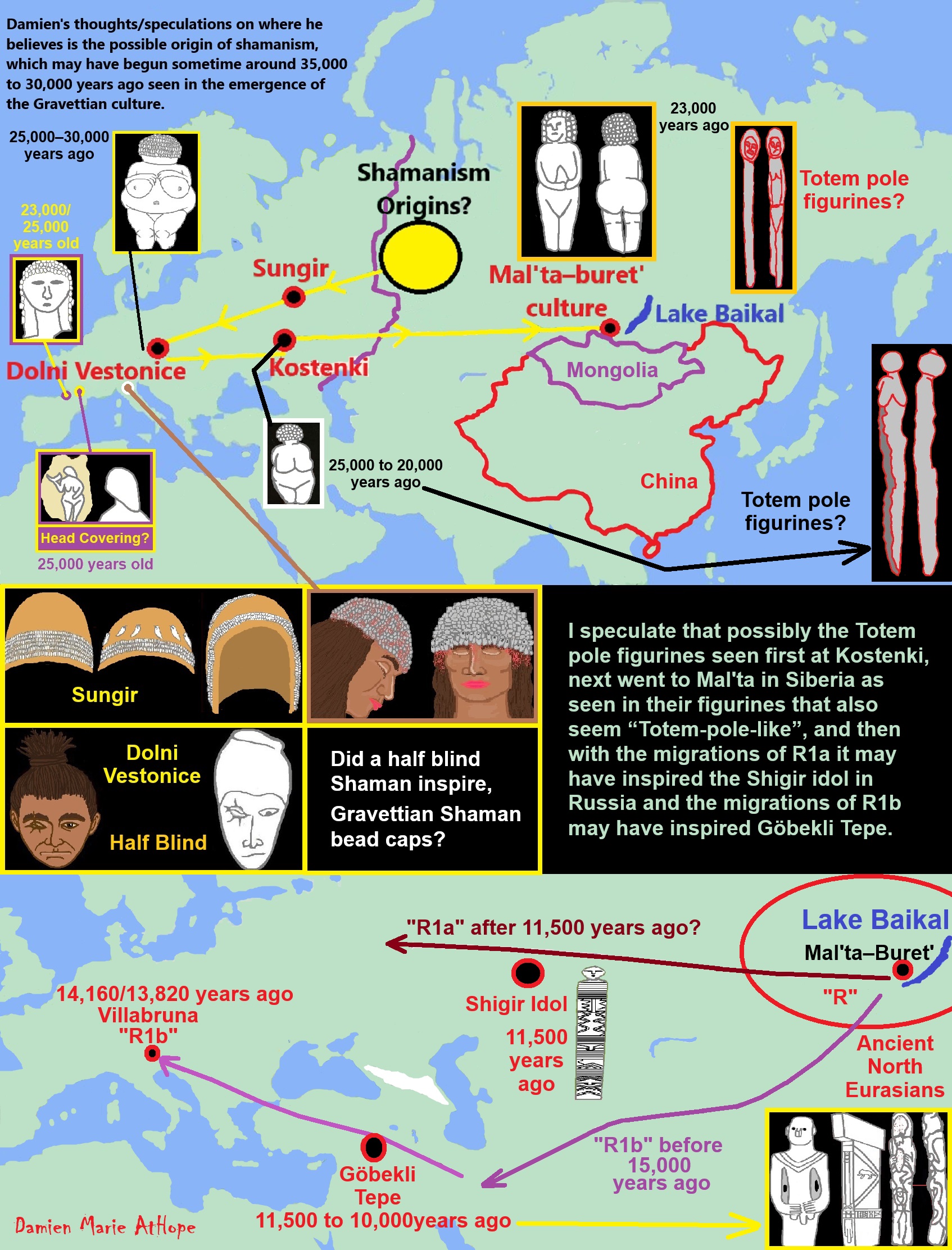
ref, ref, ref, ref, ref, ref, ref, ref, ref, ref, ref, ref, ref, ref, ref, ref, ref, ref, ref
Here are my thoughts/speculations on where I believe is the possible origin of shamanism, which may have begun sometime around 35,000 to 30,000 years ago seen in the emergence of the Gravettian culture, just to outline his thinking, on what thousands of years later led to evolved Asian shamanism, in general, and thus WU shamanism as well. In both Europe-related “shamanism-possible burials” and in Gravettian mitochondrial DNA is a seeming connection to Haplogroup U. And the first believed Shaman proposed burial belonged to Eastern Gravettians/Pavlovian culture at Dolní Věstonice in southern Moravia in the Czech Republic, which is the oldest permanent human settlement that has ever been found. It is at Dolní Věstonice where approximately 27,000-25,000 years ago a seeming female shaman was buried and also there was an ivory totem portrait figure, seemingly of her.
And my thoughts on how cultural/ritual aspects were influenced in the area of Göbekli Tepe. I think it relates to a few different cultures starting in the area before the Neolithic. Two different groups of Siberians first from northwest Siberia with U6 haplogroup 40,000 to 30,000 or so. Then R Haplogroup (mainly haplogroup R1b but also some possible R1a both related to the Ancient North Eurasians). This second group added its “R1b” DNA of around 50% to the two cultures Natufian and Trialetian. To me, it is likely both of these cultures helped create Göbekli Tepe. Then I think the female art or graffiti seen at Göbekli Tepe to me possibly relates to the Epigravettians that made it into Turkey and have similar art in North Italy. I speculate that possibly the Totem pole figurines seen first at Kostenki, next went to Mal’ta in Siberia as seen in their figurines that also seem “Totem-pole-like”, and then with the migrations of R1a it may have inspired the Shigir idol in Russia and the migrations of R1b may have inspired Göbekli Tepe.
Two different groups mix at Dolní Věstonice
“Three inhabitants of Dolní Věstonice, lived 31,155 years ago (calibrated date) and were found to have mitochondrial haplogroup U, and one inhabitant mitochondrial haplogroup U8. The Věstonice individuals form a distinct genetic cluster which is the result of an admixture between ‘Western’ and ‘Eastern’ lineages, represented by the genomes of the c. 35,000 year-old Goyet Q116-1 individual from Belgium and the c. 34,000 year-old Sunghir individuals from Western Russia, respectively. The Věstonice individuals show greater affinity to the Sunghir individuals than to the Goyet Q116-1 individual, and can be modelled as approximately 64% Sunghir-related and 36% Goyet-Q116-related ancestry. The Y-chromosome observed among Vestonice 16 belonged to haplogroup C1a2 (V20+, V86+). In the Vestonice 13 sample, the Y haplogroup CT (not IJK-L16) (CTS109+, CTS5318+, CTS6327+, CTS8243+, CTS9556+, Z17718+, Y1571+, M5831+) was determined, for the Vestonice 14 sample, the Y haplogroup I (L758+), for the Vestonice 15 sample, the Y chromosome haplogroup BT (PF1178+), and for the Vestonice 43 sample, the Y chromosome haplogroup F (not I) (P145+, P158+).” ref
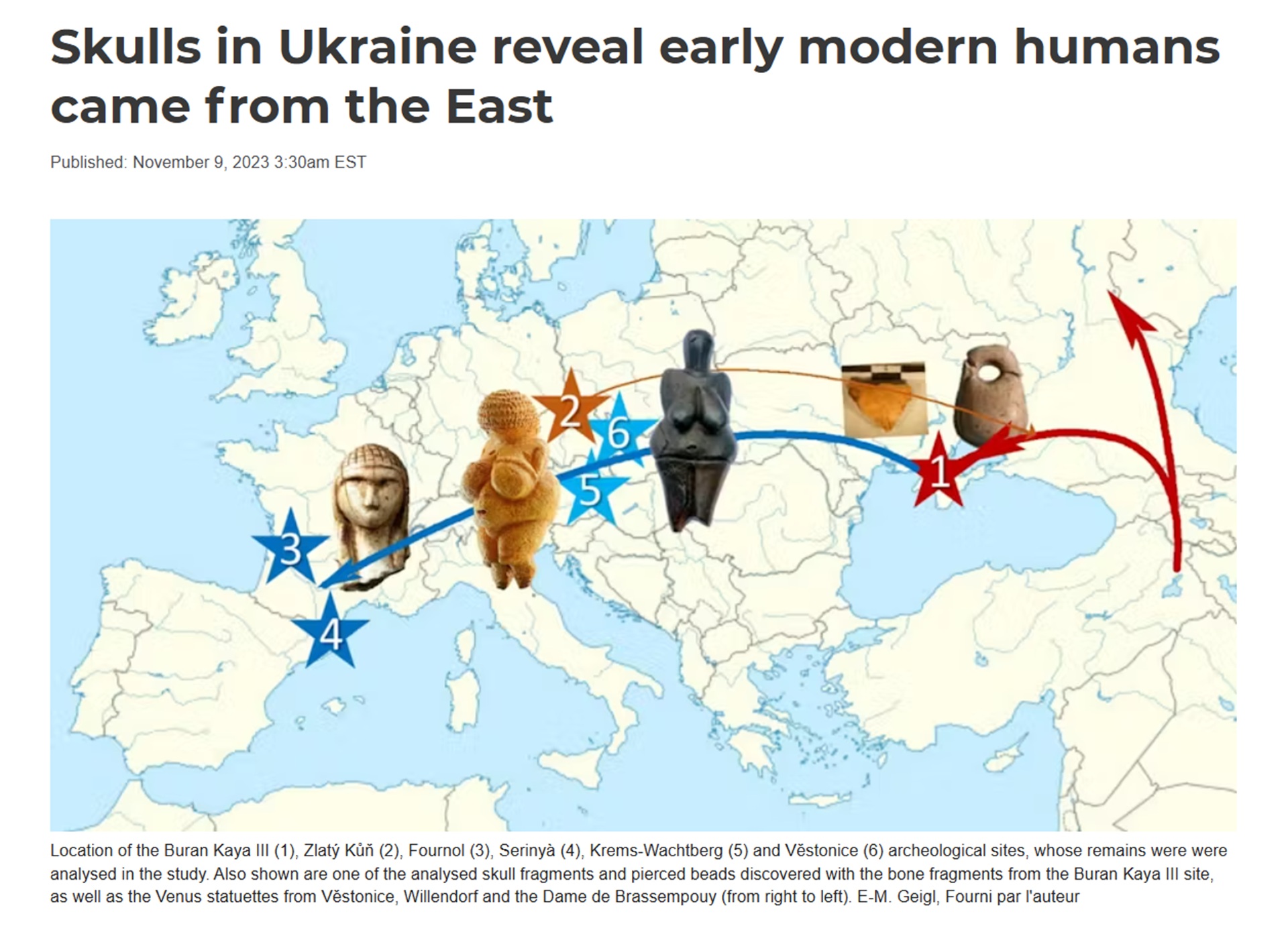
“How did our species, Homo sapiens, arrive in Western Europe? Published in Nature Ecology & Evolution, our new study analyses two skull fragments dating back between 37,000 and 36,000 years to conclude that our ancestors came from Eastern Europe and migrated westwards. These two individuals interbred with Neanderthals and with the very first European Homo sapiens, who arrived around 45,000 years ago and were thought to have become extinct following a major climatic catastrophe. Together with lithic tools and pierced mammoth ivory beads, small skull fragments of the two skulls found in 2009 at an archaeological site in the Crimea, Buran Kaya III, bear witness to the presence of anatomically modern humans in Eastern Europe. Working with French and Ukrainian archaeologists, we were able to put in place a sampling protocol that took special precautions to prevent the fragments from being contaminated by modern human DNA and identify their ancient DNA. The resulting analysis enabled us to generate a broad, up-to-date model of population movements, interactions, and replacements as they settled in Europe during the Upper Palaeolithic, the period from around -40,000 to -12,000 years ago characterized by the expansion of anatomically modern humans around the world. These individuals are the oldest representatives of Western Europeans to have established themselves permanently in Europe and to have left traces in the genomes of present-day Europeans.” ref
“It is estimated they settled in the region after the ice age that took place from 40,000 to 38,000 years ago. In addition to extremely low temperatures, the latter period was also marked by the eruption of a super-volcano in the Phlegrean Fields region near Naples, which left south-eastern and eastern Europe covered in ash. Up to this day, researchers believe that the ensuing ecological crisis wiped out both the last Neanderthal populations and the first populations of sapiens humans of the early Upper Palaeolithic. The latter were the descendants of the Homo sapiens populations that came from Africa around 60,000 years ago and left archaeological remains in Europe from around 45,000 years ago, possibly even earlier. Archaeologically, this was the period of transition between the Middle Palaeolithic (250,000 to 30,000 years ago) and the Upper Palaeolithic (about 50,000–40,000 years ago until about 10,000 years ago), as the lithic industry of the last Neanderthals was replaced by that of the first Homo sapiens. Their skeletal remains are rare, but the few that were found in archaeological sites in the Czech Republic, Romania and Bulgaria have had their genomes partially deciphered. Present-day Europeans bear no trace of the genomes of these first sapiens Europeans, unlike the human populations that lived in Europe after the ecological crisis of 40,000 years ago, some of whose genomes have been sequenced.” ref
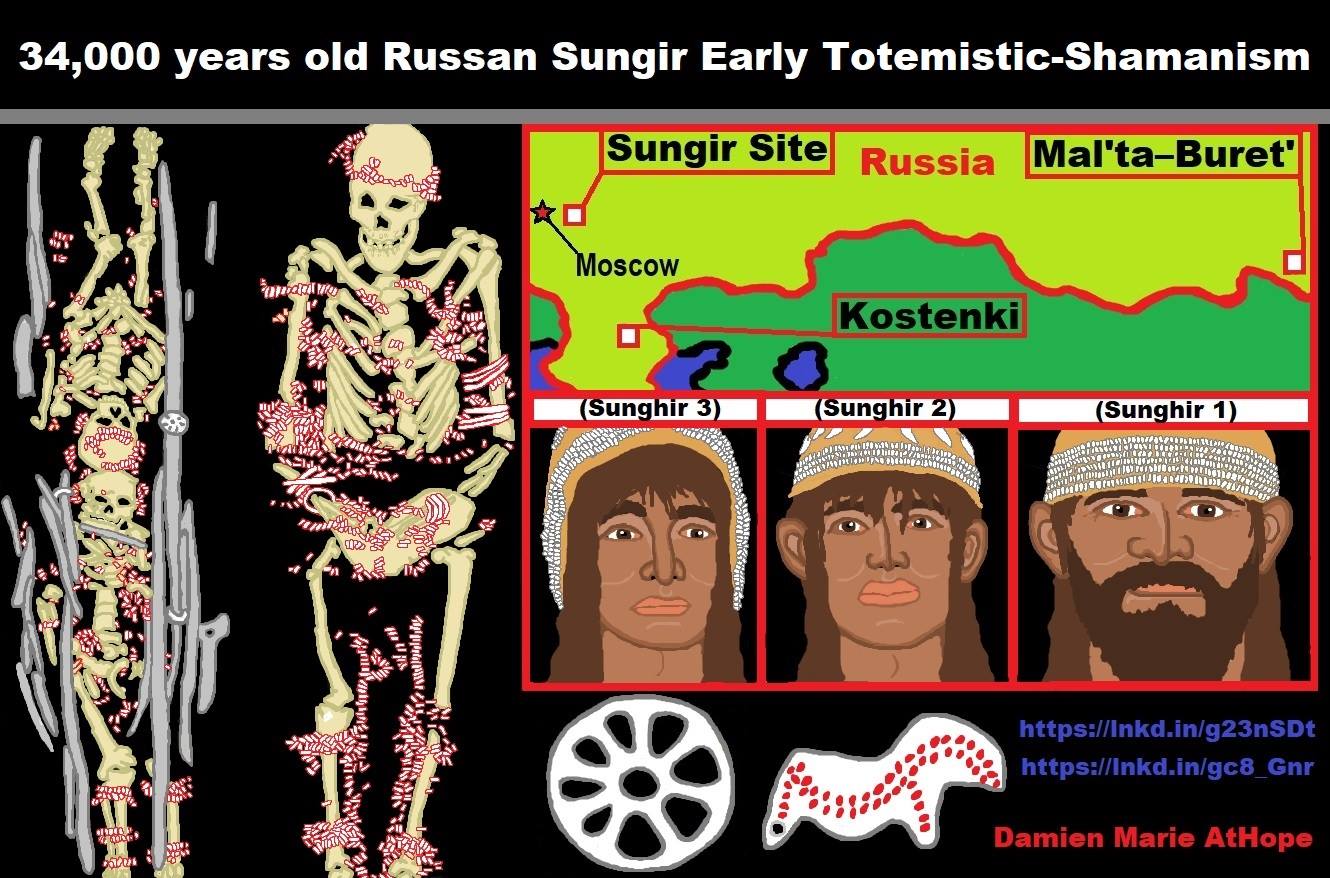
ref, ref, ref, ref, ref, ref, ref, ref, ref, ref, ref
“Probably occupied from as much as around 38,900–32,630 years ago. It had previously been dated at a lower date as low as around 23,000-19,000 years ago which changed.” ref
Sungar “Gravettian culture” (Russia) and related Dolni Vestonice Pavlovian/Gravettian culture (Czech Republic).
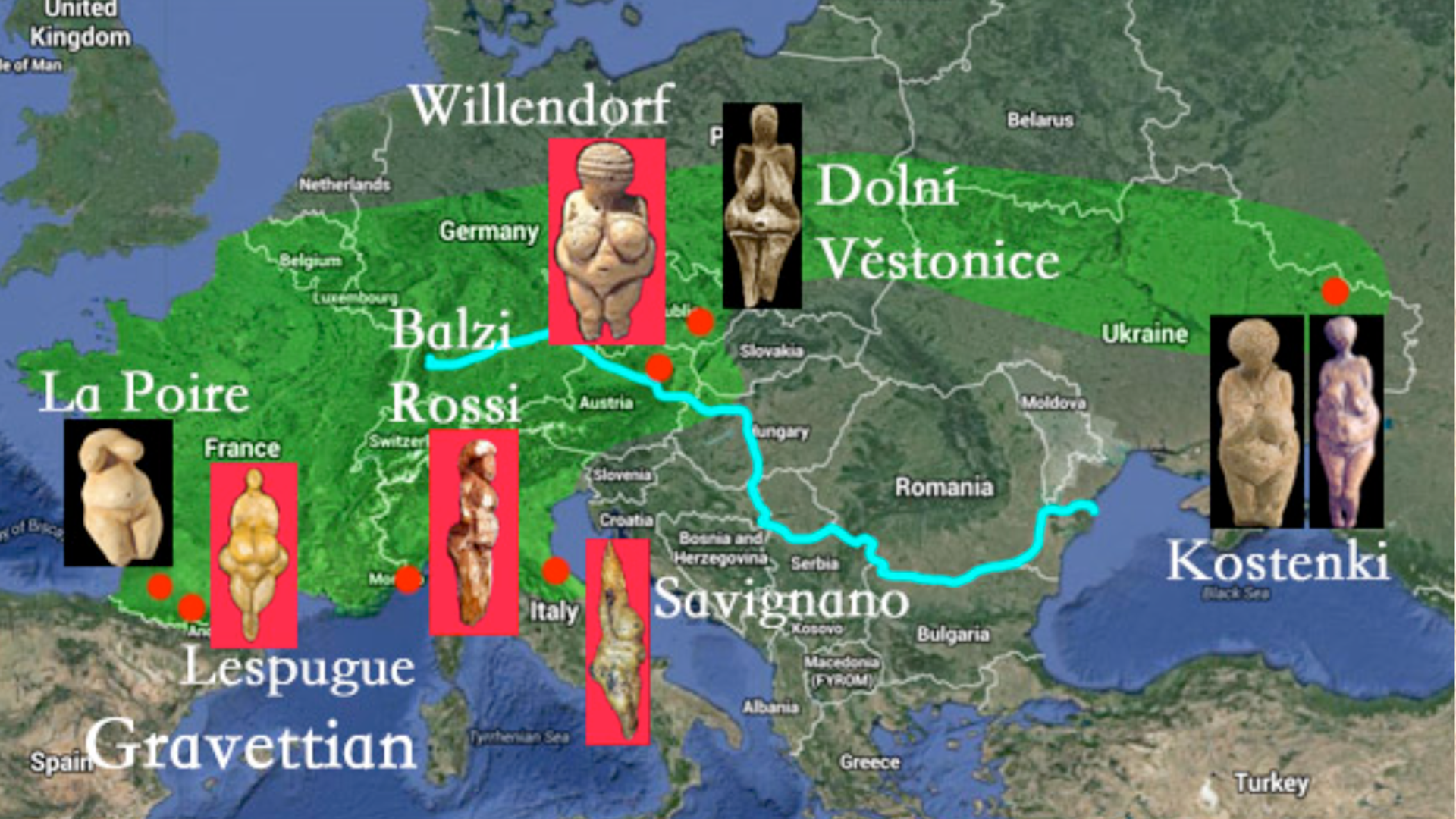
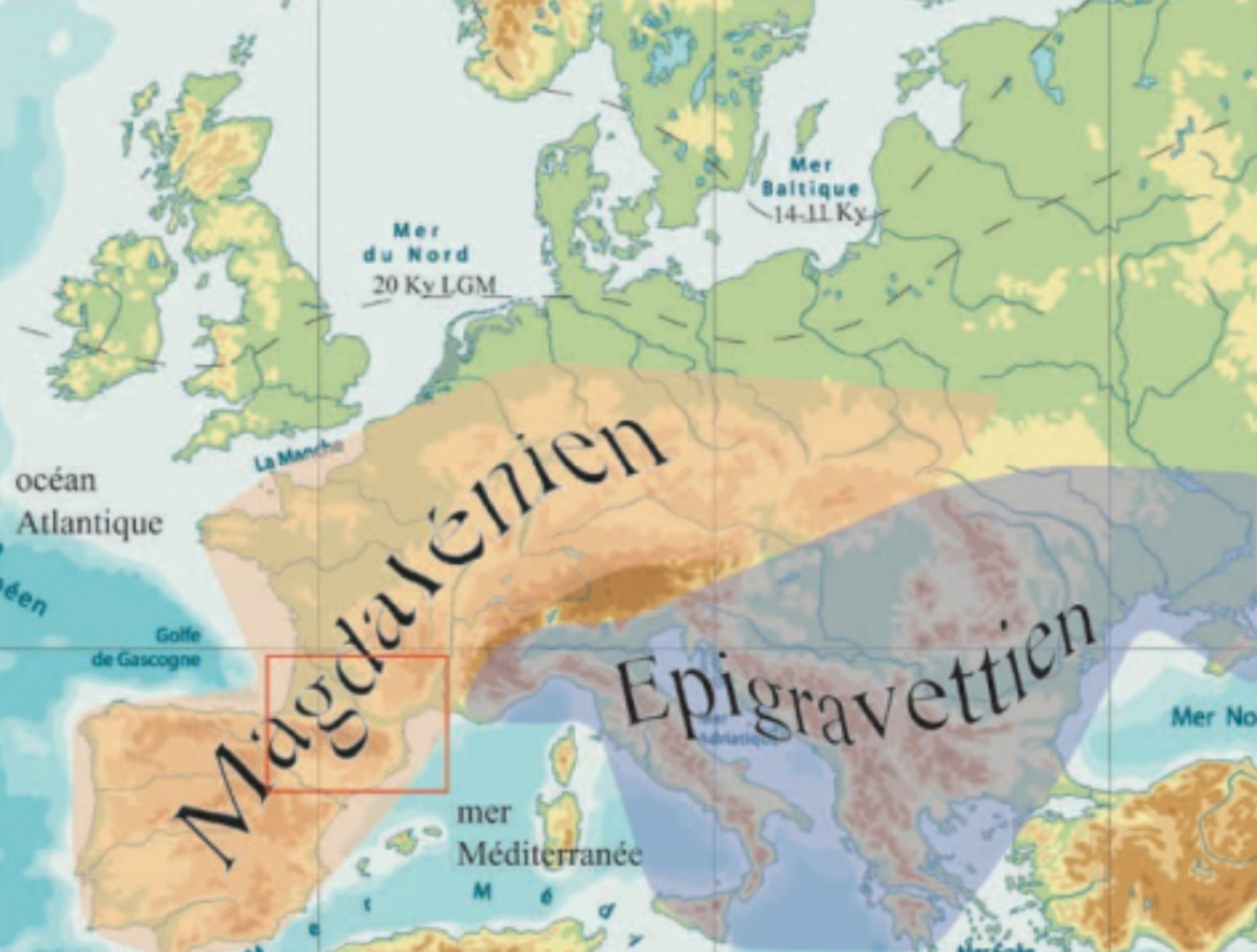
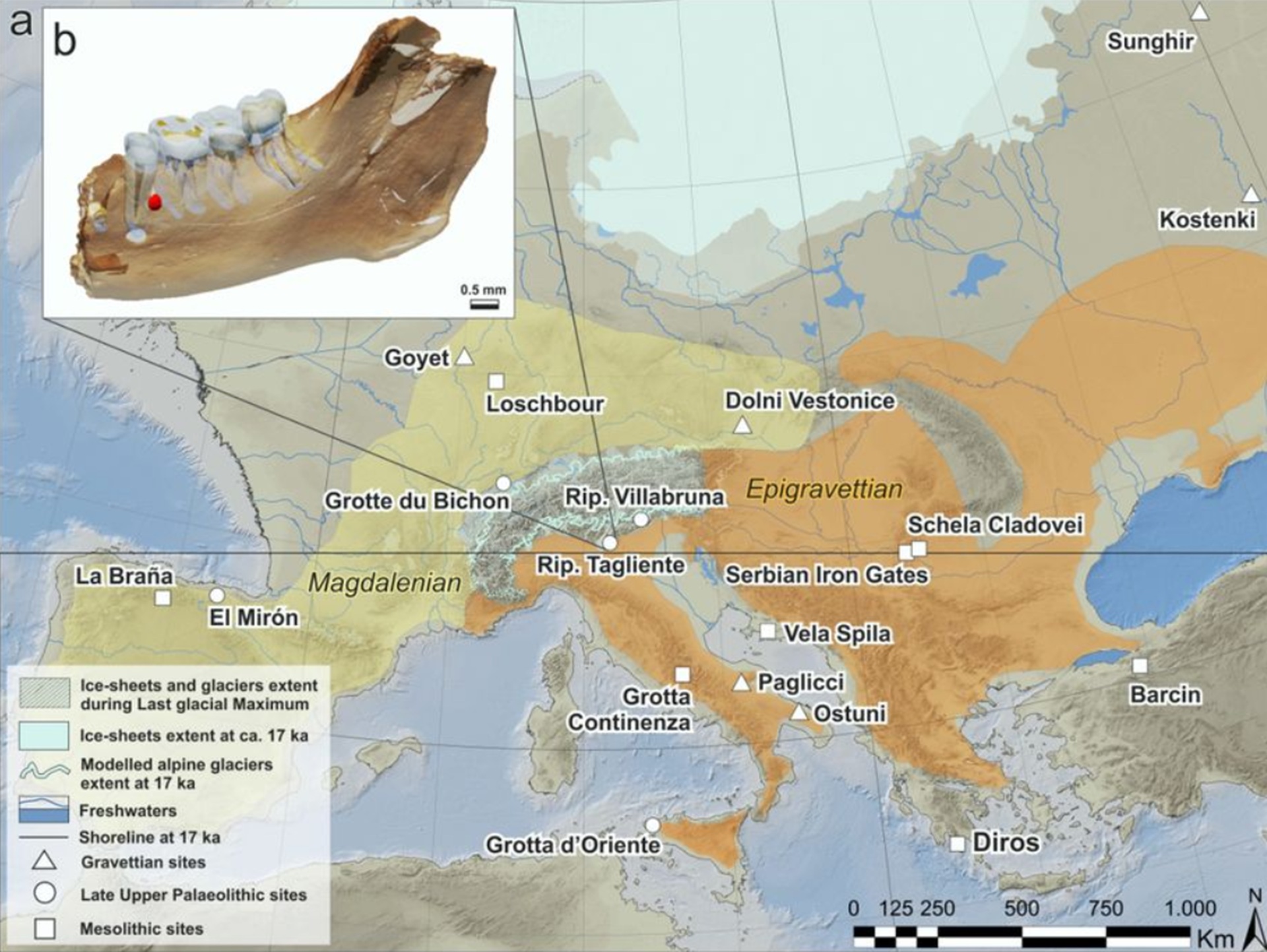
“a) Palaeogeographic map of Europe during the Late Glacial, centered 17,000 years ago. Sea level drop at – 110 m7. Scandinavian and British Islands ice sheets (pale blue) are shown at 17,000 years ago. Alpine glacier extent (dashed outline) was modeled 17,000 years ago. The modeled extension is generally underestimated in the northwestern Alps and overestimated in the eastern and southwestern Alps. Colored areas refer to the distribution of Epigravettian and Magdalenian material culture 17,000 years ago.” ref

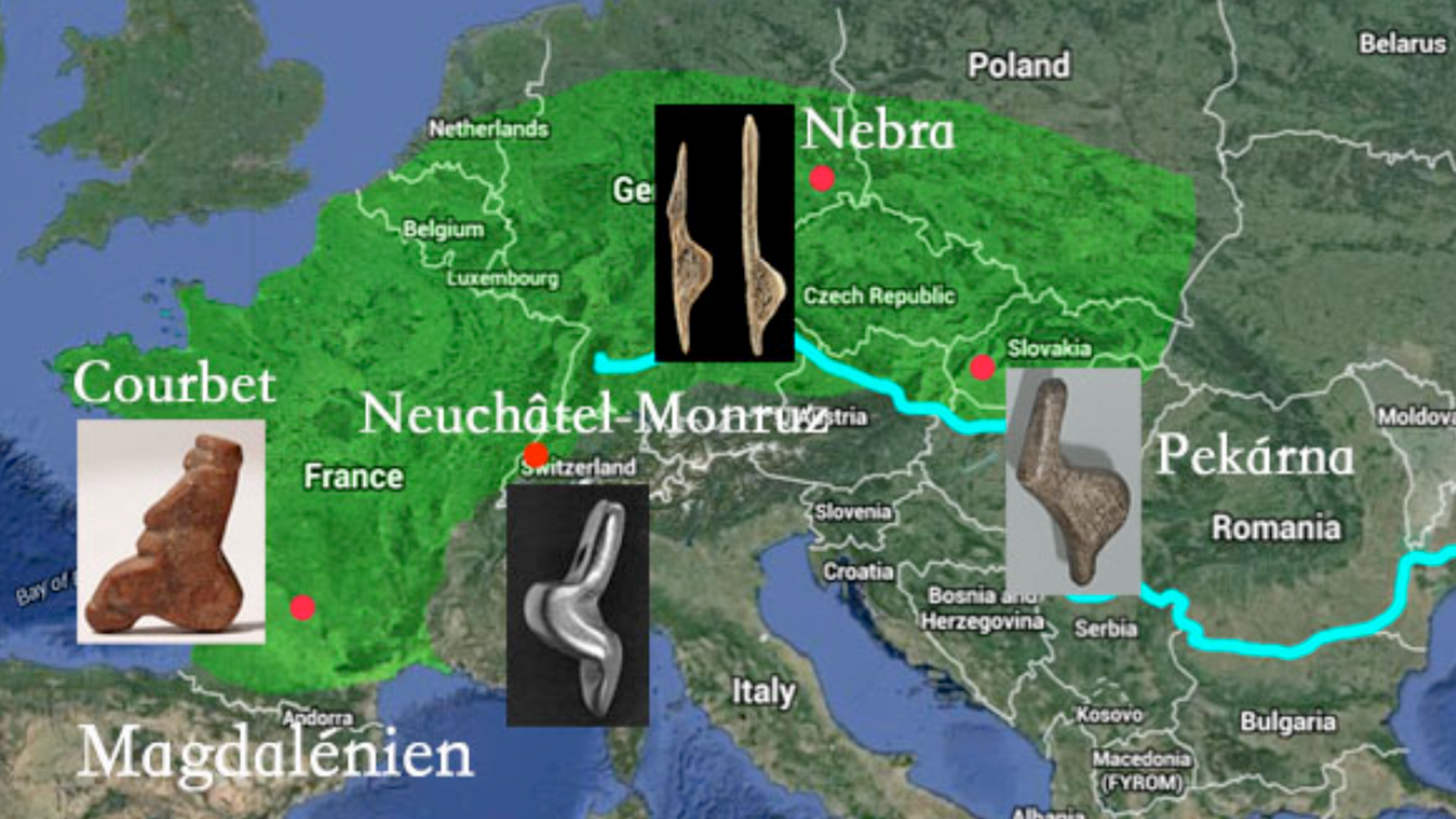
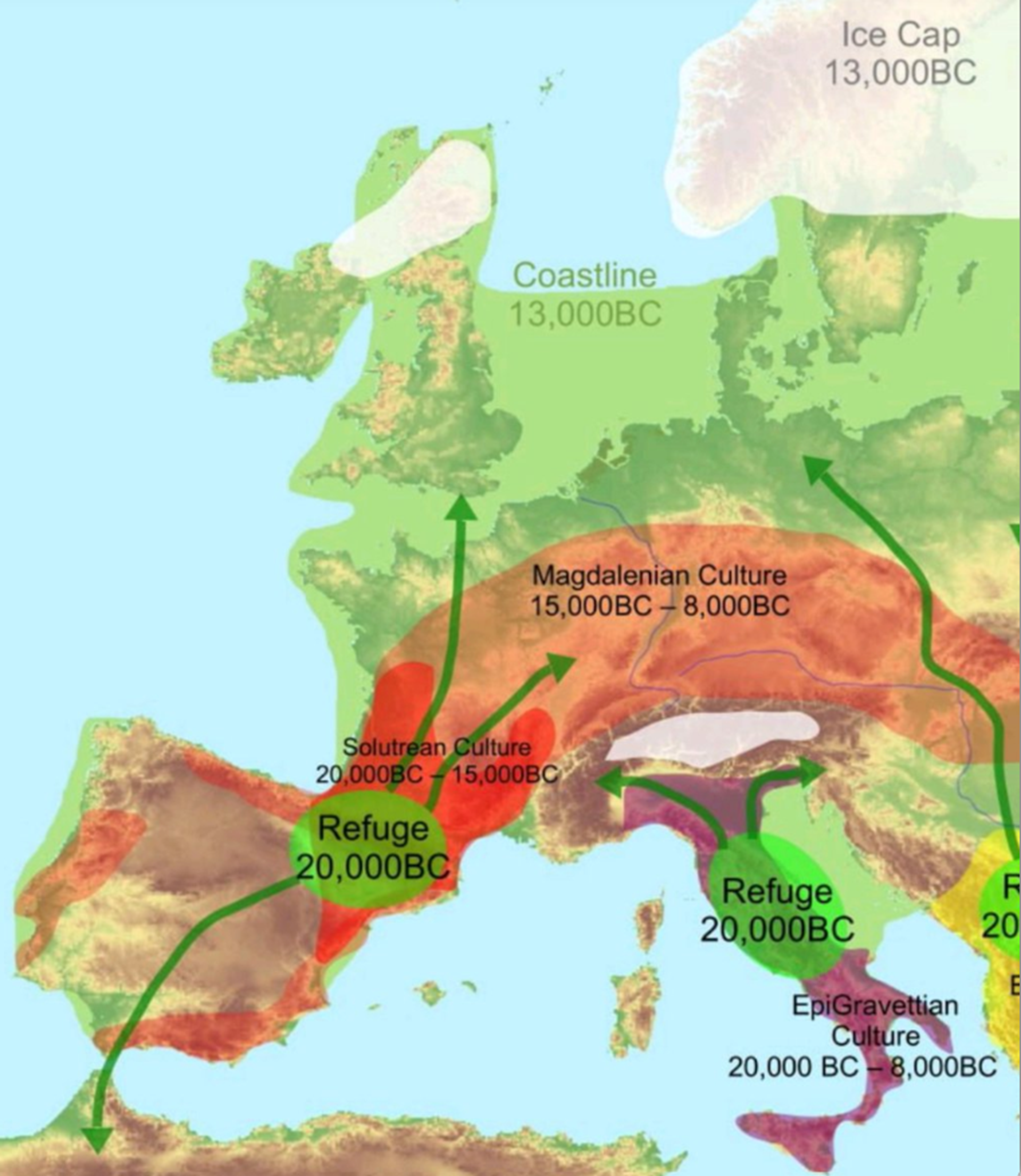
Magdalenian
“Magdalenian cultures (also Madelenian; French: Magdalénien) are later cultures of the Upper Paleolithic and Mesolithic in western Europe. They date from around 17,000 to 12,000 years ago. It is named after the type site of La Madeleine, a rock shelter located in the Vézère valley, commune of Tursac, in France’s Dordogne department. The Magdalenian is associated with reindeer hunters, although Magdalenian sites contain extensive evidence for the hunting of red deer, horses, and other large mammals present in Europe toward the end of the last glacial period. The culture was geographically widespread, and later Magdalenian sites stretched from Portugal in the west to Poland in the east, and as far north as France, the Channel Islands, England, and Wales. Besides La Madeleine, the chief stations of the Magdalenian are Les Eyzies, Laugerie-Basse, and Gorges d’Enfer in the Dordogne; Grotte du Placard in Charente and others in south-west France.” ref
“Magdalenian peoples produced a wide variety of art, including figurines and cave paintings. Evidence has been found suggesting that Magdalenian peoples regularly engaged in (probably ritualistic) cannibalism along with producing skull cups. Genetic studies indicate that the Magdalenian peoples were largely descended from earlier Western European Cro-Magnon groups like the Gravettians that were present in Western Europe over 30,000 years ago prior to the Last Glacial Maximum (LGM), who had retreated to southwestern Europe during the LGM. Madgalenian peoples were largely replaced and in some areas absorbed by Epigravettian-related groups of Villabruna/Western Hunter Gatherer ancestry at the end of the Pleistocene.” ref
“The genes of seven Magdalenians, the El Miron Cluster in Iberia, have shown close relationship to a population who had lived in Northern Europe some 20,000 years previously. The analyses suggested that 70-80% of the ancestry of these individuals was from the population represented by Goyet Q116-1, associated with the Aurignacian culture of about 35,000 BP, from the Goyet Caves in modern Belgium. It has been found that Magdalenians are closely related to Solutreans. It has also been found that Magdalenians are closely related to western Gravettians who inhabited France and Spain prior to the Last Glacial Maximum. The 15,000 year old GoyetQ2 individual from Goyet Caves is often used as a proxy for Magdalenian ancestry. Analysis of genomes of GoyetQ2-related Magdalenians suggest that like earlier Cro-Magnon groups, they probably had a relatively dark skin tone compared to modern Europeans.” ref
“A 2023 study proposed that relative to earlier Western European Cro-Magnon related groups like Goyet Q116-1-related Aurignacian and the Western Gravettian associated Fournol cluster, the Goyet-Q2-related Magdalenians appear to have carried significant (~30% ancestry) from the Villabruna cluster (thought to be of southeastern European origin, and sharing affinities to West Asian peoples not found in earlier European hunter-gatherers) associated with the Epigravettian. The three samples of Y-DNA included two samples of haplogroup I and one sample of HIJK. All samples of mtDNA belonged to U, including five samples of U8b and one sample of U5b. Around 14-12,000 years ago, the Western Hunter-Gatherer cluster (which predominantly descended from the Villabruna cluster, with possible ancestry related to the Goyet-Q2 cluster), expanded northwards across the Alps, largely replacing the Goyet-Q2 cluster associated Magdalenian groups in Western Europe. In France and Spain, significant GoyetQ2-related ancestry persisted into the Mesolithic and Neolithic, with some Neolithic individuals in France and Spain largely of Early European Farmer descent showing significant GoyetQ2 ancestry.” ref
“Debate continues about the nature of the earliest Magdalenian assemblages, and it remains questionable whether the Badegoulian culture is the earliest phase of Magdalenian culture. Similarly, finds from the forest of Beauregard near Paris have been suggested as belonging to the earliest Magdalenian. The earliest Magdalenian sites are in France. The Epigravettian is a similar culture appearing at the same time. Its known range extends from southeast France to the western shores of the Volga River, Russia, with many sites in Italy.” ref
“By the end of the Magdalenian, lithic technology shows a pronounced trend toward increased microlithisation. The bone harpoons and points have the most distinctive chronological markers within the typological sequence. As well as flint tools, Magdalenians are known for their elaborate worked bone, antler and ivory that served both functional and aesthetic purposes, including perforated batons. The sea shells and fossils found in Magdalenian sites may be sourced to relatively precise areas and have been used to support hypotheses of Magdalenian hunter-gatherer seasonal ranges, and perhaps trade routes. In northern Spain and south-west France this tool culture was superseded by the Azilian culture. In northern Europe it was followed by variants of the Tjongerian techno-complex. It has been suggested that key Late-glacial sites in south-western Britain may be attributed to Magdalenian culture, including Kent’s Cavern.” ref
“Some skulls were cleaned of soft tissues, then had the facial regions removed, with the remaining brain case retouched, possibly to make the broken edges more regular. This manipulation suggests the shaping of skulls to produce skull cups. Finds of defleshed (as evidenced by cut marks) and cracked bones with human chewing marks at Gough’s Cave, England suggests that the Magdalenian peoples there engaged in cannibalism. Cannibalism has been suggested at a dozen other Magadelian sites across the culture’s geographic range, representing 25% of all Magdalenian sites, far more than any other European Paleolithic culture.” ref
“It has been suggested that Magdalenian peoples practiced a form of funerary endocannibalism, where upon the death of a member of the community, they were ritually dismembered and consumed by other members of the group, with their skulls being used to create skull cups. At other Magdalenian sites primary burial with no evidence of cannibalism is observed, with a handful of sites showing alternating evidence of cannibalism and primary burial at different occupation layers. At sites with primary burial, genetic analysis of these individuals indicate that they are more closely related to the people of the Epigravettian culture/Villabruna cluster than to the Magdalenians that practiced cannibalism (who belong to the GoyetQ2 cluster).” ref
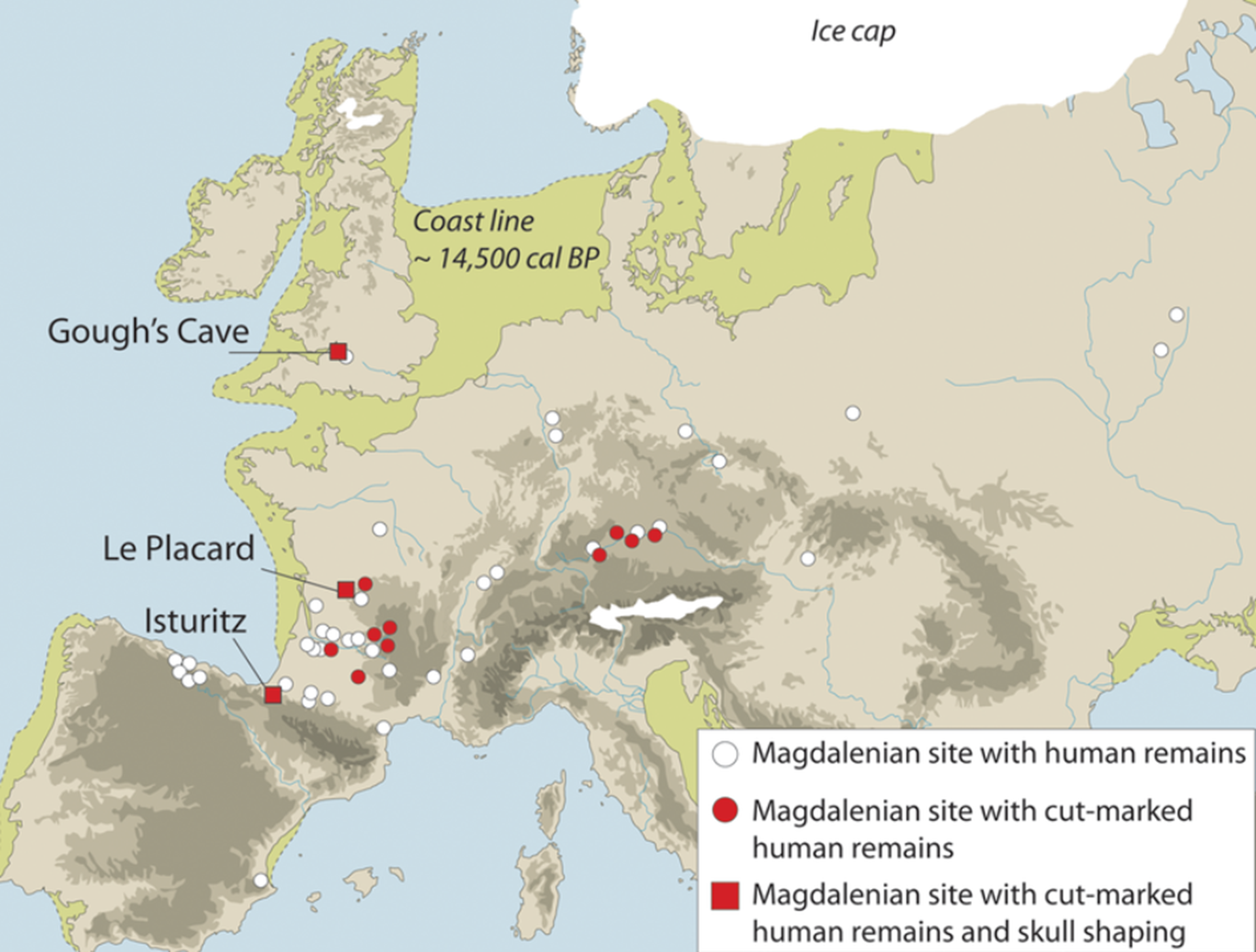
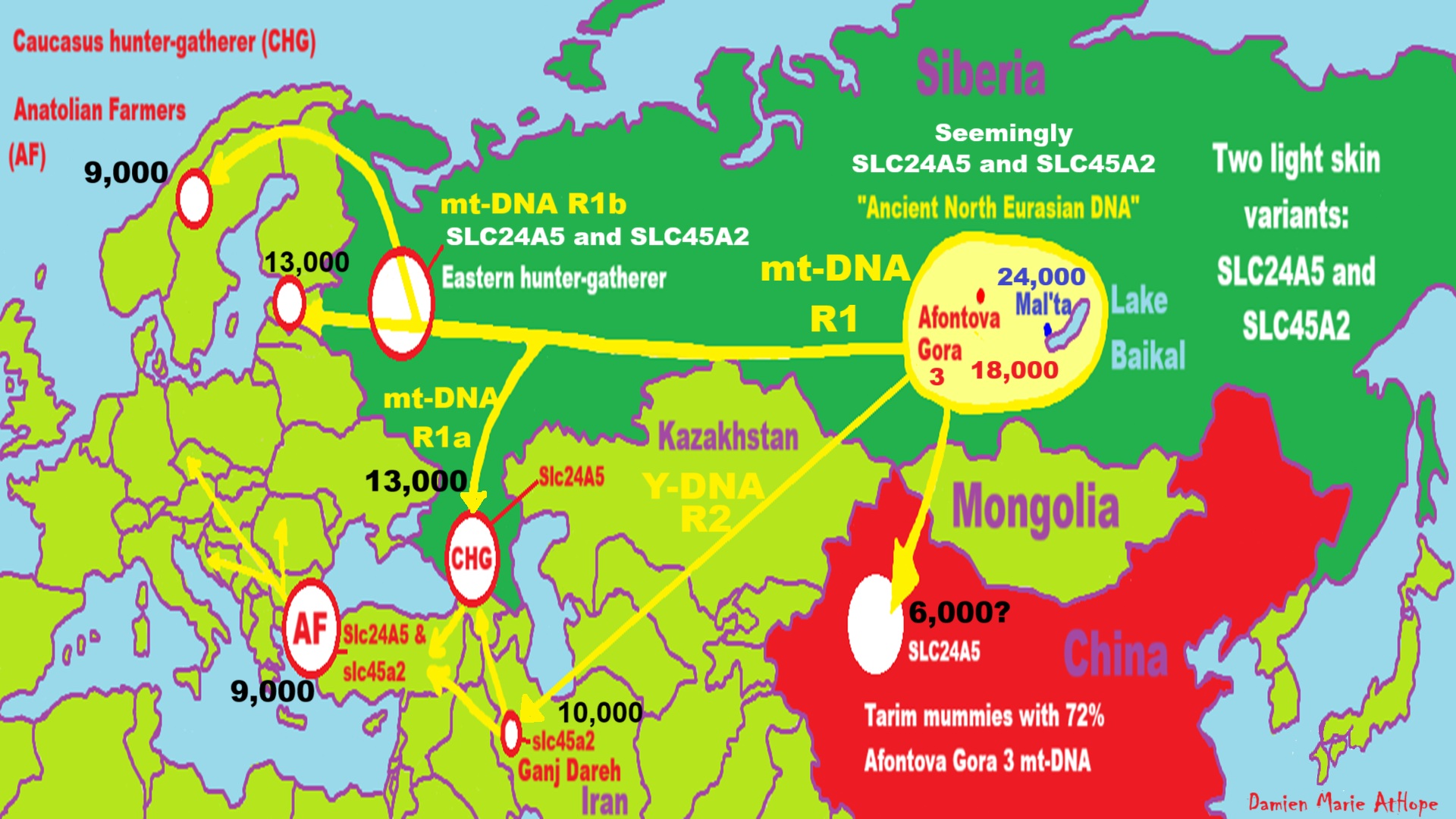
Two genes, SLC24A5 and SLC45A2, are most associated with lighter skin color in modern Europeans.
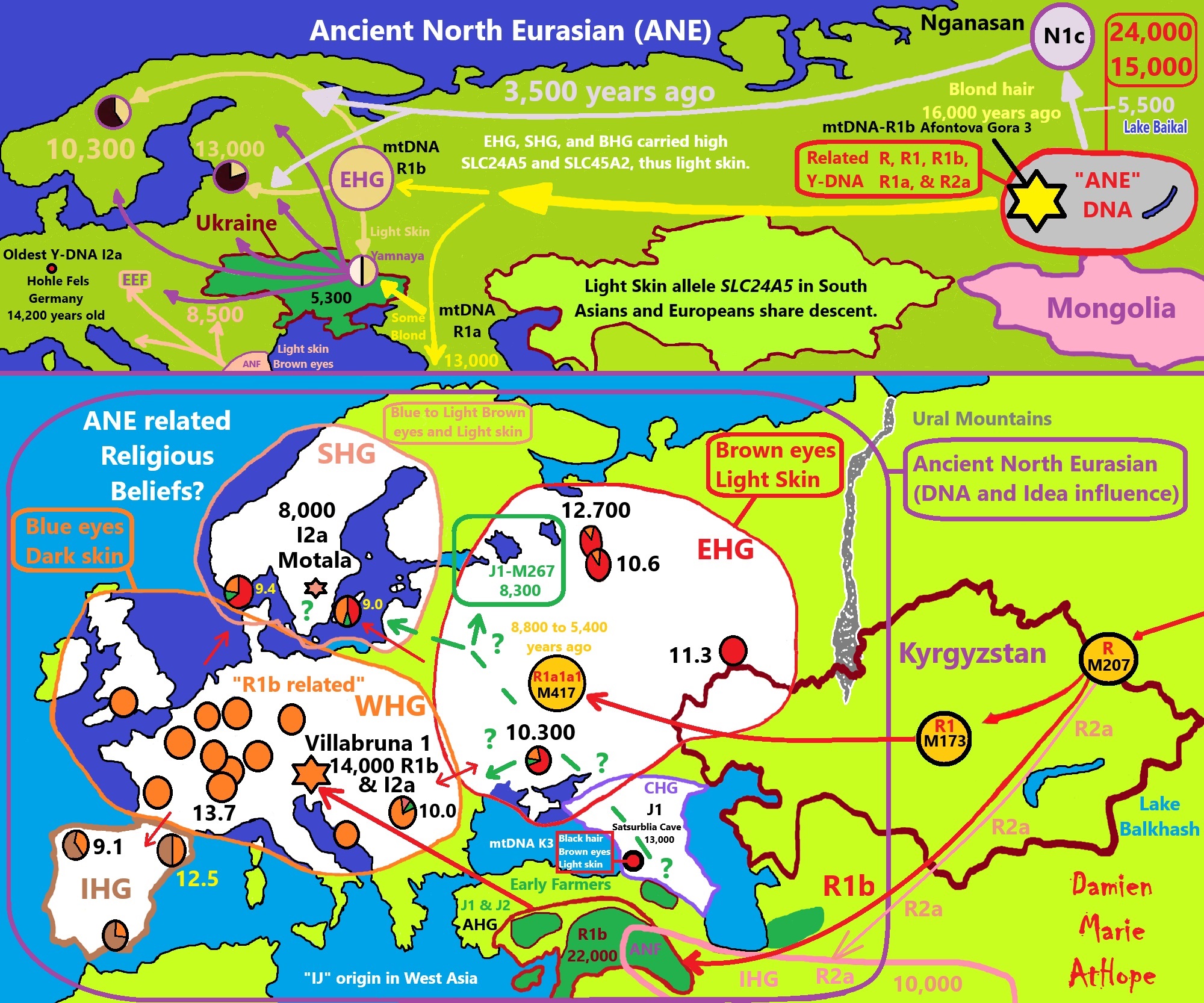
ref, ref, ref, ref, ref, ref, ref, ref, ref, ref, ref, ref, ref, ref, ref, ref, ref, ref, ref, ref, ref, ref, ref, ref, ref, ref, ref
Genetic Relations to Ancient North Eurasians (ANE):
Eastern hunter-gatherer (EHG)
Caucasus hunter-gatherer (CHG)
Zagros/Iranian Hunter-Gatherer (IHG)
Iranian Neolithic Farmers (INF)
Anatolian hunter-gatherer (AHG)
Anatolian Neolithic Farmers (ANF)
Early European Farmers (EEF)
Yamnaya/Steppe Herders (WSH)
Villabruna 1 (burial)/Ripari Villabruna rock shelter in northern Italy (14,000 years old)
Satsurblia Cave (burial) in the Country of Georgia (13,000 years old)
Motala (burial) (8,000 years old)
- Bohunician (48–40 ka)
- Châtelperronian (44.5–36 ka)
- Lincombian-Ranisian-Jerzmanowician (43–32 ka)
- Aurignacian (43–26 ka)
- Szeletian (41,000-37,000)
- Périgordian (35–20 ka)
- Gravettian (33–24 ka)
- Pavlovian (29–25 ka)
- Solutrean (22–17 ka)
- Epigravettian (20–10 ka)
- Magdalenian (17–12 ka)
- Hamburg (15.5–13.1 ka)
- Federmesser (14–12.8 ka)
- Azilian (14–10 ka)
- Ahrensburg (13–12 ka)
- Swiderian (11–8 ka)
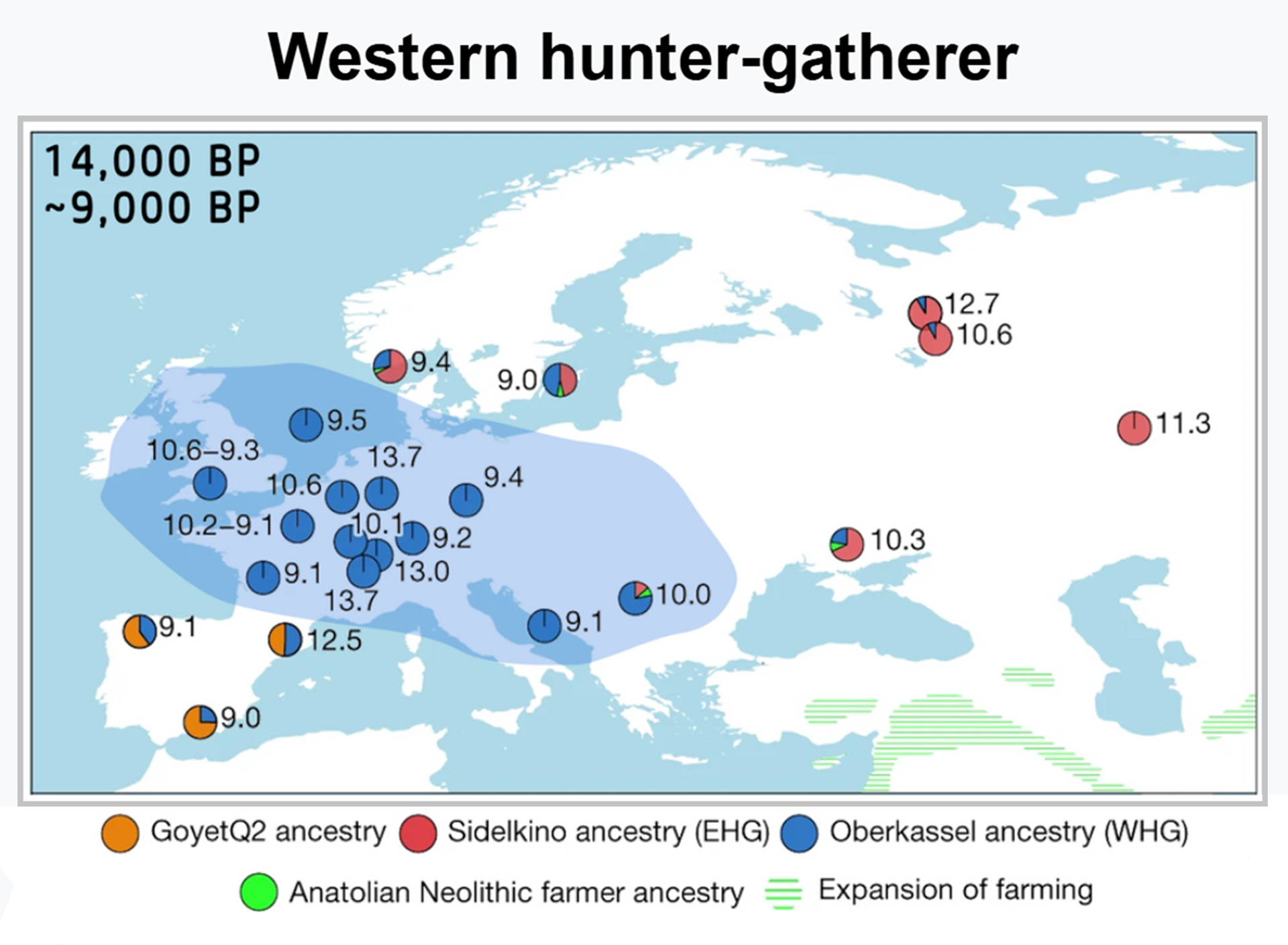
Western Hunter-Gatherer
“In archaeogenetics, western hunter-gatherer (WHG, also known as west European hunter-gatherer, western European hunter-gatherer or Oberkassel cluster) (c. 15,000~5,000 years ago) is a distinct ancestral component of modern Europeans, representing descent from a population of Mesolithic hunter-gatherers who scattered over western, southern and central Europe, from the British Isles in the west to the Carpathians in the east, following the retreat of the ice sheet of the Last Glacial Maximum. It is closely associated and sometimes considered synonymous with the concept of the Villabruna cluster, named after the Ripari Villabruna cave specimen in Italy, known from the terminal Pleistocene of Europe, which is largely ancestral to later WHG populations.” ref
“WHGs share a closer genetic relationship to ancient and modern peoples in the Middle East and the Caucasus than earlier European hunter-gatherers. Their precise relationships to other groups are somewhat obscure, with the origin of the Villabruna cluster likely somewhere in the vicinity of the Balkans. The Villabruna cluster (which is associated with the Epigravettian and other related archaeological cultures) had expanded into the Italian and Iberian Peninsulas by approximately 19,000 years ago, with the WHG cluster subsequently expanding across Western Europe at the end of the Pleistocene around 14-12,000 years ago, largely replacing the Magdalenian peoples who previously dominated the region. These Magdalenian peoples largely descended from earlier Western European Cro-Magnon groups that had arrived in the region over 30,000 years ago, prior to the Last Glacial Maximum.” ref
“WHGs constituted one of the main genetic groups in the postglacial period of early Holocene Europe, along with eastern hunter-gatherers (EHG) in Eastern Europe. The border between WHGs and EHGs ran roughly from the lower Danube, northward along the western forests of the Dnieper towards the western Baltic Sea. EHGs primarily consisted of a mixture of WHG-related and Ancient North Eurasian (ANE) ancestry. Scandinavia was inhabited by Scandinavian hunter-gatherers (SHGs), which were a mixture between WHG and EHG. In the Iberian Peninsula, early Holocene hunter-gathers consisted of a mixture of WHG and Magdalenian Cro-Magnon (GoyetQ2) ancestry. Once the main population throughout Europe, the WHGs were largely replaced by successive expansions of Early European Farmers (EEFs) of Anatolian origin during the early Neolithic, who generally carried a minor amount of WHG ancestry due to admixture with WHG groups during their European expansion. Among modern-day populations, WHG ancestry is most common among populations of the eastern Baltic region. WHGs lacked the light skin genes found in modern Europeans, and it has been suggested they were dark-skinned and had light-coloured eyes.” ref
“WHGs represent a major population shift within Europe at the end of the Ice Age, probably a population expansion into continental Europe, from Southeastern European or West Asian refugia. It is thought that their ancestors separated from eastern Eurasians around 40,000 years ago, and from Ancient North Eurasians (ANE) prior to 24,000 years ago (the estimated age date of the Mal’ta boy). This date was subsequently put further back in time by the findings of the Yana Rhinoceros Horn Site to around 38,000 years ago, shortly after the divergence of West-Eurasian and East-Eurasian lineages. Vallini et al. 2022 argues that the dispersal and split patterns of West Eurasian lineages was not earlier than c. 38,000 years ago, with older Initial Upper Paleolithic European specimens, such as those found in the Zlaty Kun, Peștera cu Oase, and Bacho Kiro caves, being unrelated to Western hunter-gatherers but closer to Ancient East Eurasians or basal to both.” ref
“The relationships of the WHG/Villabruna cluster to other Paleolithic human groups in Europe and West Asia are obscure and subject to conflicting interpretations. A 2022 study proposed that the WHG/Villabruna population genetically diverged from hunter-gatherers in the Middle East and the Caucasus around 26,000 years ago, during the Last Glacial Maximum. WHG genomes display higher affinity for ancient and modern Middle Eastern populations when compared against earlier Paleolithic Europeans such as Gravettians. The affinity for ancient Middle Eastern populations in Europe increased after the Last Glacial Maximum, correlating with the expansion of WHG (Villabruna or Oberkassel) ancestry. There is also evidence for bi-directional geneflow between WHG and Middle Eastern populations as early as 15,000 years ago. WHG associated remains belonged primarily to the human Y-chromosome haplogroups I-M170 with a lower frequency of C-F3393 (specifically the clade C-V20/C1a2), which has been found commonly among earlier Paleolithic European remains such as Kostenki-14 and Sungir.” ref
“The paternal haplogroup C-V20 can still be found in men living in modern Spain, attesting to this lineage’s longstanding presence in Western Europe. The Villabruna cluster also carried the Y-haplogroup R1b (R1b-L754), derived from the Ancient North Eurasian haplogroup R*, indicating “an early link between Europe and the western edge of the Steppe Belt of Eurasia.” Their mitochondrial chromosomes belonged primarily to haplogroup U5. A 2023 study proposed that the Villabruna cluster emerged from the mixing in roughly equal proportions of a divergent West Eurasian ancestry with a West Eurasian ancestry closely related to the 35,000-year-old BK1653 individual from Bacho Kiro Cave in Bulgaria, with this BK1653-related ancestry also significantly (~59%) ancestral to the Věstonice cluster characteristic of eastern Gravettian producing Cro-Magnon groups (which have additional ancestry precluding them from being the direct ancestors of the Villabruna cluster), which may reflect shared ancestry in the Balkan region. Another genetic study models them as a mix of Upper Paleolithic hunter-gatherers from the Caucasus, Europe, and Siberia.” ref
“The earliest known individuals of predominantly WHG/Villabruna ancestry in Europe are known from Italy, dating to around 17,000 years ago, though an individual from El Mirón cave in northern Spain with 43% Villabruna ancestry is known from 19,000 years ago. While not confirmed, the Villabruna cluster was probably present earlier than in the Balkans region than elsewhere in Southern Europe. Early WHG/Villabruna populations are associated with the Epigravettian archaeological culture, which largely replaced populations associated with the Magdalenian culture about 14,000 years ago (the ancestry of Magdalenian-associated Goyet-Q2 cluster primarily descended from the earlier Solutrean, and western Gravettian-producing groups in France and Spain).” ref
“A 2023 study found that relative to earlier Western European Cro-Magnon populations like the Gravettians, that Magdalenian-associated Goyet-Q2 cluster carried significant (~30%) Villabruna ancestry even prior to the major expansion of WHG-related groups north of the Alps. This study also found that relative to earlier members of the Villabruna cluster from Italy, WHG-related groups that appeared north of the Alps beginning around 14,000 years ago carried around 25% ancestry from the Goyet-Q2 cluster (or alternatively 10% from the western Gravettian-associated Fournol cluster). This paper proposed that WHG should be named the Oberkassel cluster, after one of the oldest WHG individuals found north of the Alps.” ref
“The study suggests that Oberkassel ancestry was mostly already formed before expanding, possibly around the west side of the Alps, to Western and Central Europe and Britain, where sampled WHG individuals are genetically homogeneous. This is in contrast to the arrival of Villabruna and Oberkassel ancestry to Iberia, which seems to have involved repeated admixture events with local populations carrying high levels of Goyet-Q2 ancestry. This, and the survival of specific Y-DNA haplogroup C1 clades previously observed among early European hunter-gatherers, suggests relatively higher genetic continuity in southwest Europe during this period.” ref
“The WHG were also found to have contributed ancestry to populations on the borders of Europe such as early Anatolian farmers and Ancient Northwestern Africans, as well as other European groups such as eastern hunter-gatherers. The relationship of WHGs to the EHGs remains inconclusive. EHGs are modeled to derive varying degrees of ancestry from a WHG-related lineage, ranging from merely 25% to up to 91%, with the remainder being linked to geneflow from Paleolithic Siberians (ANE) and perhaps Caucasus hunter-gatherers. Another lineage known as the Scandinavian hunter-gatherers (SHGs) were found to be a mix of EHGs and WHGs.” ref
“In the Iberian Peninsula early Holocene hunter-gathers consisted of populations with a mixture of WHG and Magdalenian Cro-Magnon (GoyetQ2) ancestry. People of the Mesolithic Kunda culture and the Narva culture of the eastern Baltic were a mix of WHG and EHG, showing the closest affinity with WHG. Samples from the Ukrainian Mesolithic and Neolithic were found to cluster tightly together between WHG and EHG, suggesting genetic continuity in the Dnieper Rapids for a period of 4,000 years. The Ukrainian samples belonged exclusively to the maternal haplogroup U, which is found in around 80% of all European hunter-gatherer samples. People of the Pit–Comb Ware culture (CCC) of the eastern Baltic were closely related to EHG. Unlike most WHGs, the WHGs of the eastern Baltic did not receive European farmer admixture during the Neolithic.” ref
“Modern populations of the eastern Baltic thus harbor a larger amount of WHG ancestry than any other population in Europe. SHGs have been found to contain a mix of WHG components who had likely migrated into Scandinavia from the south, and EHGs who had later migrated into Scandinavia from the northeast along the Norwegian coast. This hypothesis is supported by evidence that SHGs from western and northern Scandinavia had less WHG ancestry (ca 51%) than individuals from eastern Scandinavia (ca. 62%). The WHGs who entered Scandinavia are believed to have belonged to the Ahrensburg culture. EHGs and WHGs displayed lower allele frequencies of SLC45A2 and SLC24A5, which cause depigmentation, and OCA/Herc2, which causes light eye color, than SHGs.” ref
“The DNA of eleven WHGs from the Upper Palaeolithic and Mesolithic in Western Europe, Central Europe and the Balkans was analyzed, with regards to their Y-DNA haplogroups and mtDNA haplogroups. The analysis suggested that WHGs were once widely distributed from the Atlantic coast in the West, to Sicily in the South, to the Balkans in the Southeast, for more than six thousand years. The study also included an analysis of a large number of individuals of prehistoric Eastern Europe. Thirty-seven samples were collected from Mesolithic and Neolithic Ukraine (9500-6000 BCE or around 11,500 to 8,000 years ago). These were determined to be an intermediate between EHG and SHG, although WHG ancestry in this population increased during the Neolithic. Samples of Y-DNA extracted from these individuals belonged exclusively to R haplotypes (particularly subclades of R1b1) and I haplotypes (particularly subclades of I2). mtDNA belonged almost exclusively to U (particularly subclades of U5 and U4).” ref
“A large number of individuals from the Zvejnieki burial ground, which mostly belonged to the Kunda culture and Narva culture in the eastern Baltic, were analyzed. These individuals were mostly of WHG descent in the earlier phases, but over time EHG ancestry became predominant. The Y-DNA of this site belonged almost exclusively to haplotypes of haplogroup R1b1a1a and I2a1. The mtDNA belonged exclusively to haplogroup U (particularly subclades of U2, U4 and U5). Forty individuals from three sites of the Iron Gates Mesolithic in the Balkans were also analyzed. These individuals were estimated to be of 85% WHG and 15% EHG descent. The males at these sites carried exclusively haplogroup R1b1a and I (mostly subclades of I2a) haplotypes. mtDNA belonged mostly to U (particularly subclades of U5 and U4). People of the Balkan Neolithic were found to harbor 98% Anatolian ancestry and 2% WHG ancestry. By the Chalcolithic, people of the Cucuteni–Trypillia culture were found to harbor about 20% hunter-gatherer ancestry, which was intermediate between EHG and WHG. People of the Globular Amphora culture were found to harbor ca. 25% WHG ancestry, which is significantly higher than Middle Neolithic groups of Central Europe.” ref
“Haplogroup I2a was the most frequent Y-DNA among Mesolithic Western European hunter-gatherers (WHG) belonging to Villabruna Cluster. A 2015 study found haplogroup I2a in 13,500 year old remains from the Azilian culture (from Grotte du Bichon, modern Switzerland). Subclades of I2a1 (I-P37.2), namely I-M423 and I-M26, have been found in remains of WHGs dating from 10,000 to 8,000 years.” ref
But is Atlantis real?
No. Atlantis (an allegory: “fake story” interpreted to reveal a hidden meaning) can’t be found any more than one can locate the Jolly Green Giant that is said to watch over frozen vegetables. Lol
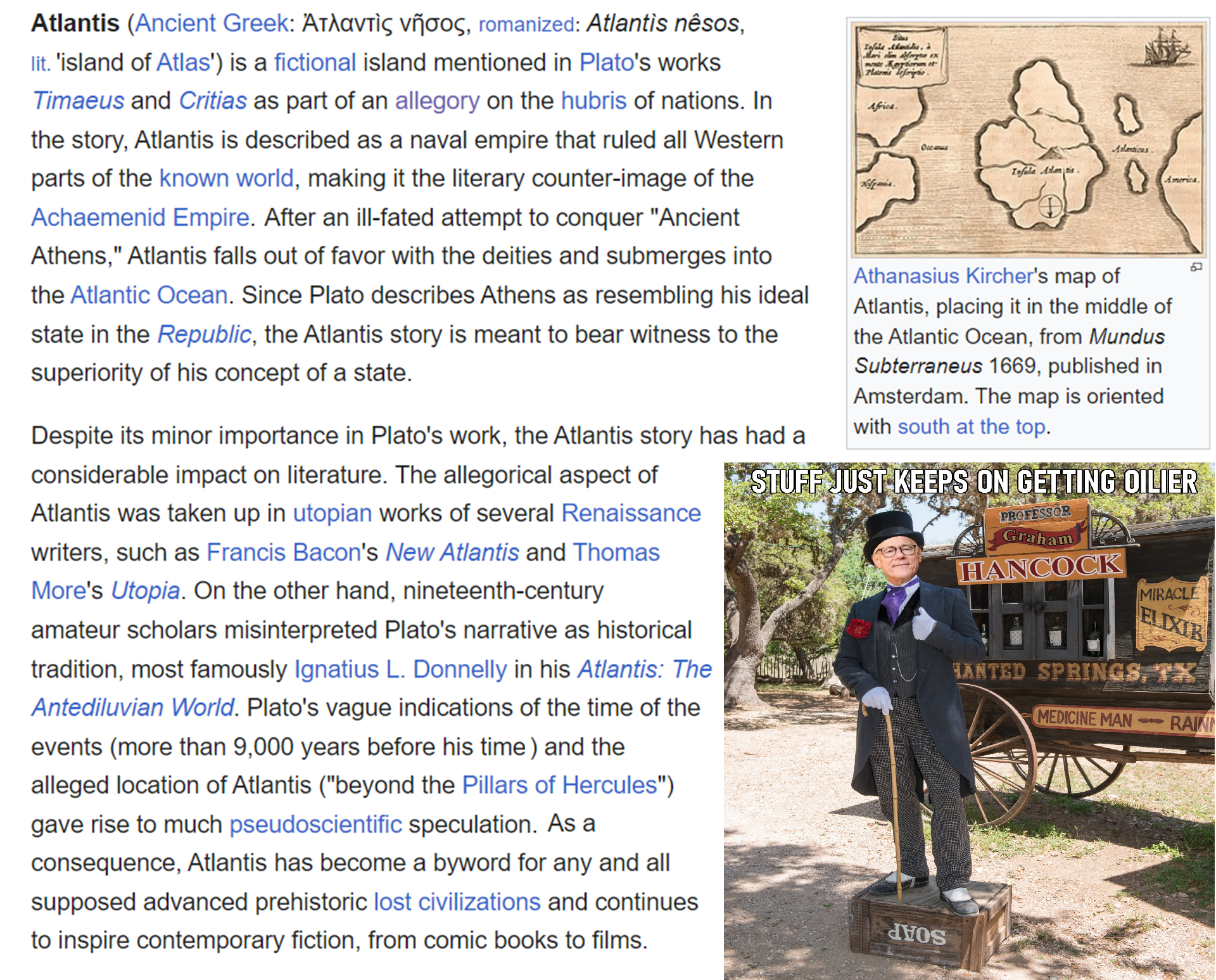

May Reason Set You Free
There are a lot of truly great things said by anarchists in history, and also some deeply vile things, too, from not supporting Women’s rights to Anti-Semitism. There are those who also reject those supporting women’s rights as well as fight anti-Semitism. This is why I push reason as my only master, not anarchist thinking, though anarchism, to me, should see all humans everywhere as equal in dignity and rights.
We—Cory and Damien—are following the greatness that can be found in anarchist thinking.
As an Anarchist Educator, Damien strives to teach the plain truth. Damien does not support violence as my method to change. Rather, I choose education that builds Enlightenment and Empowerment. I champion Dignity and Equality. We rise by helping each other. What is the price of a tear? What is the cost of a smile? How can we see clearly when others pay the cost of our indifference and fear? We should help people in need. Why is that so hard for some people? Rich Ghouls must End. Damien wants “billionaires” to stop being a thing. Tax then into equality. To Damien, there is no debate, Capitalism is unethical. Moreover, as an Anarchist Educator, Damien knows violence is not the way to inspire lasting positive change. But we are not limited to violence, we have education, one of the most lasting and powerful ways to improve the world. We empower the world by championing Truth and its supporters.
Anarchism and Education
“Various alternatives to education and their problems have been proposed by anarchists which have gone from alternative education systems and environments, self-education, advocacy of youth and children rights, and freethought activism.” ref
“Historical accounts of anarchist educational experiments to explore how their pedagogical practices, organization, and content constituted a radical alternative to mainstream forms of educational provision in different historical periods.” ref
“The Ferrer school was an early 20th century libertarian school inspired by the anarchist pedagogy of Francisco Ferrer. He was a proponent of rationalist, secular education that emphasized reason, dignity, self-reliance, and scientific observation. The Ferrer movement’s philosophy had two distinct tendencies: non-didactic freedom from dogma and the more didactic fostering of counter-hegemonic beliefs. Towards non-didactic freedom from dogma, and fulfilled the child-centered tradition.” ref

Teach Real History: all our lives depend on it.
Damien sees lies about history as crimes against humanity. And we all must help humanity by addressing “any and all” who make harmful lies about history.
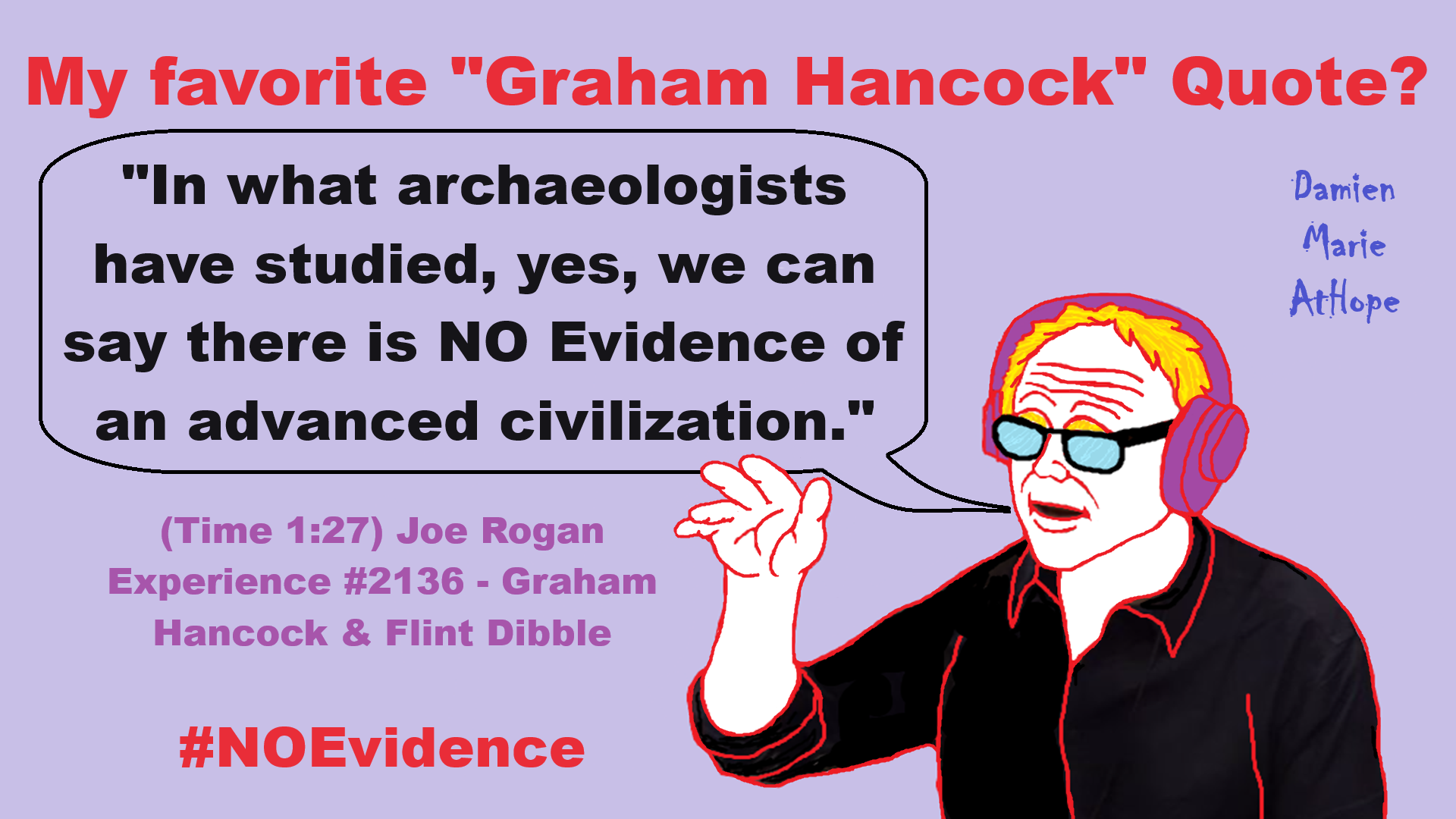
My favorite “Graham Hancock” Quote?
“In what archaeologists have studied, yes, we can say there is NO Evidence of an advanced civilization.” – (Time 1:27) Joe Rogan Experience #2136 – Graham Hancock & Flint Dibble
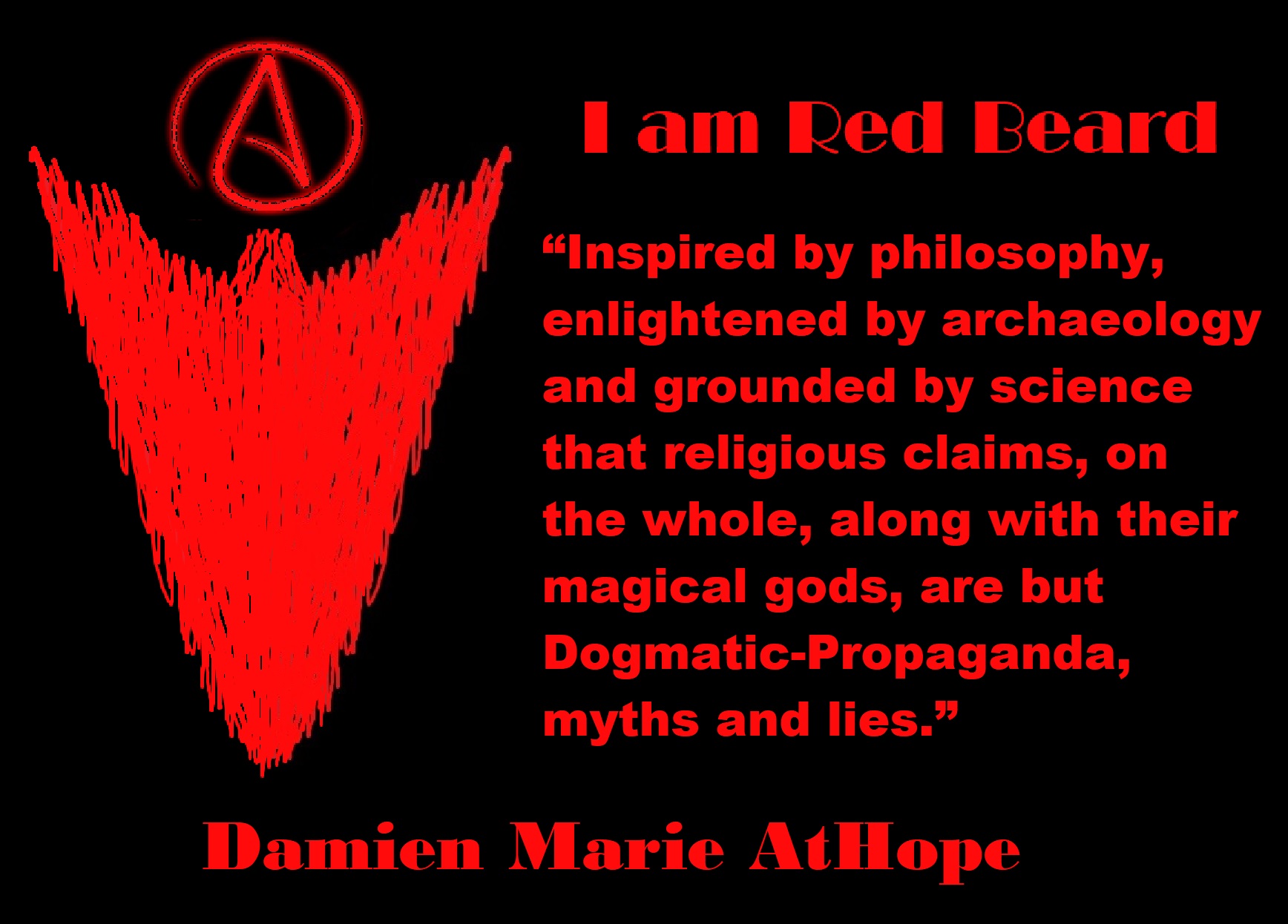
People don’t commonly teach religious history, even that of their own claimed religion. No, rather they teach a limited “pro their religion” history of their religion from a religious perspective favorable to the religion of choice.
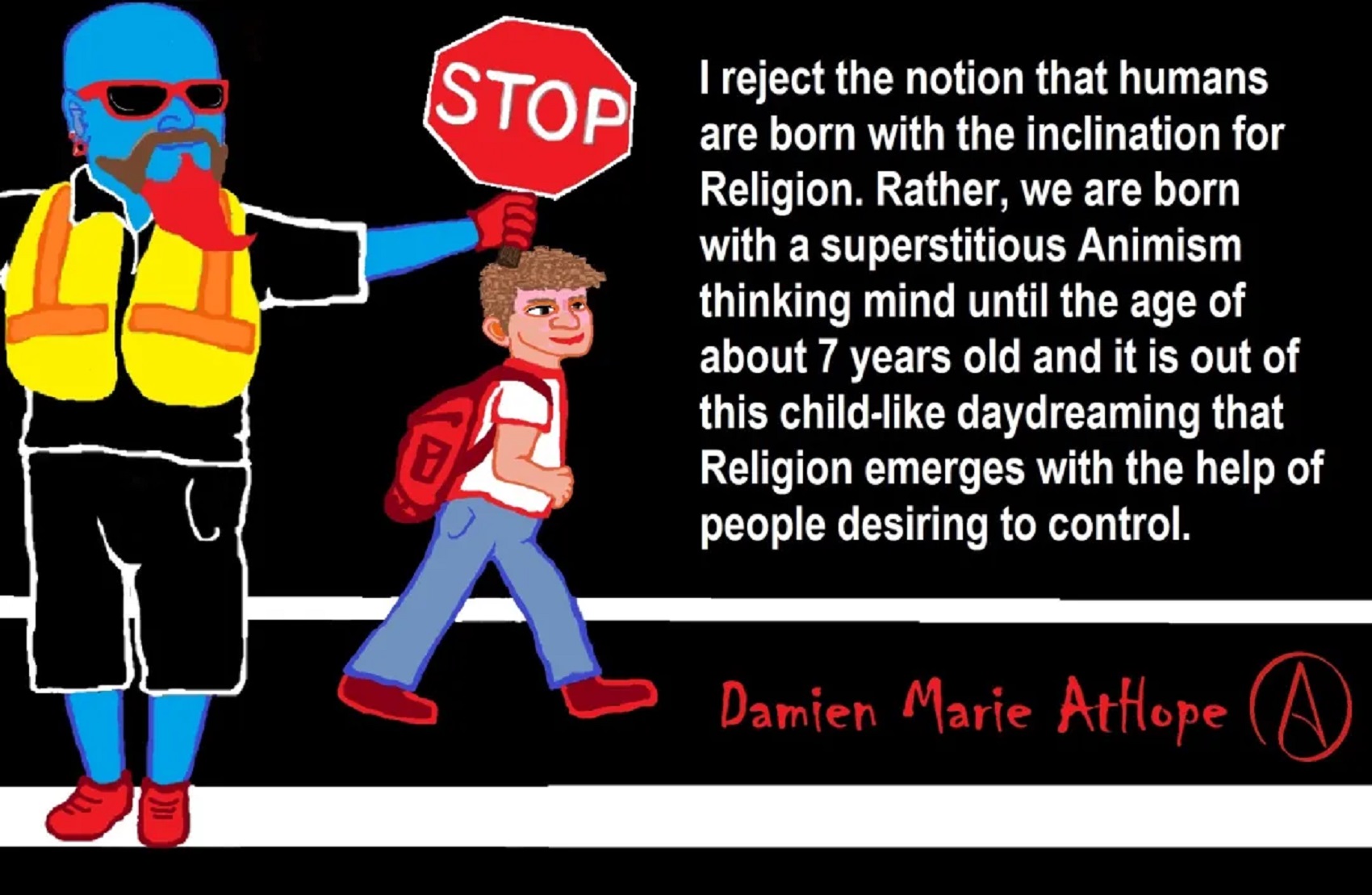
Do you truly think “Religious Belief” is only a matter of some personal choice?
Do you not see how coercive one’s world of choice is limited to the obvious hereditary belief, in most religious choices available to the child of religious parents or caregivers? Religion is more commonly like a family, culture, society, etc. available belief that limits the belief choices of the child and that is when “Religious Belief” is not only a matter of some personal choice and when it becomes hereditary faith, not because of the quality of its alleged facts or proposed truths but because everyone else important to the child believes similarly so they do as well simply mimicking authority beliefs handed to them. Because children are raised in religion rather than being presented all possible choices but rather one limited dogmatic brand of “Religious Belief” where children only have a choice of following the belief as instructed, and then personally claim the faith hereditary belief seen in the confirming to the belief they have held themselves all their lives. This is obvious in statements asked and answered by children claiming a faith they barely understand but they do understand that their family believes “this or that” faith, so they feel obligated to believe it too. While I do agree that “Religious Belief” should only be a matter of some personal choice, it rarely is… End Hereditary Religion!
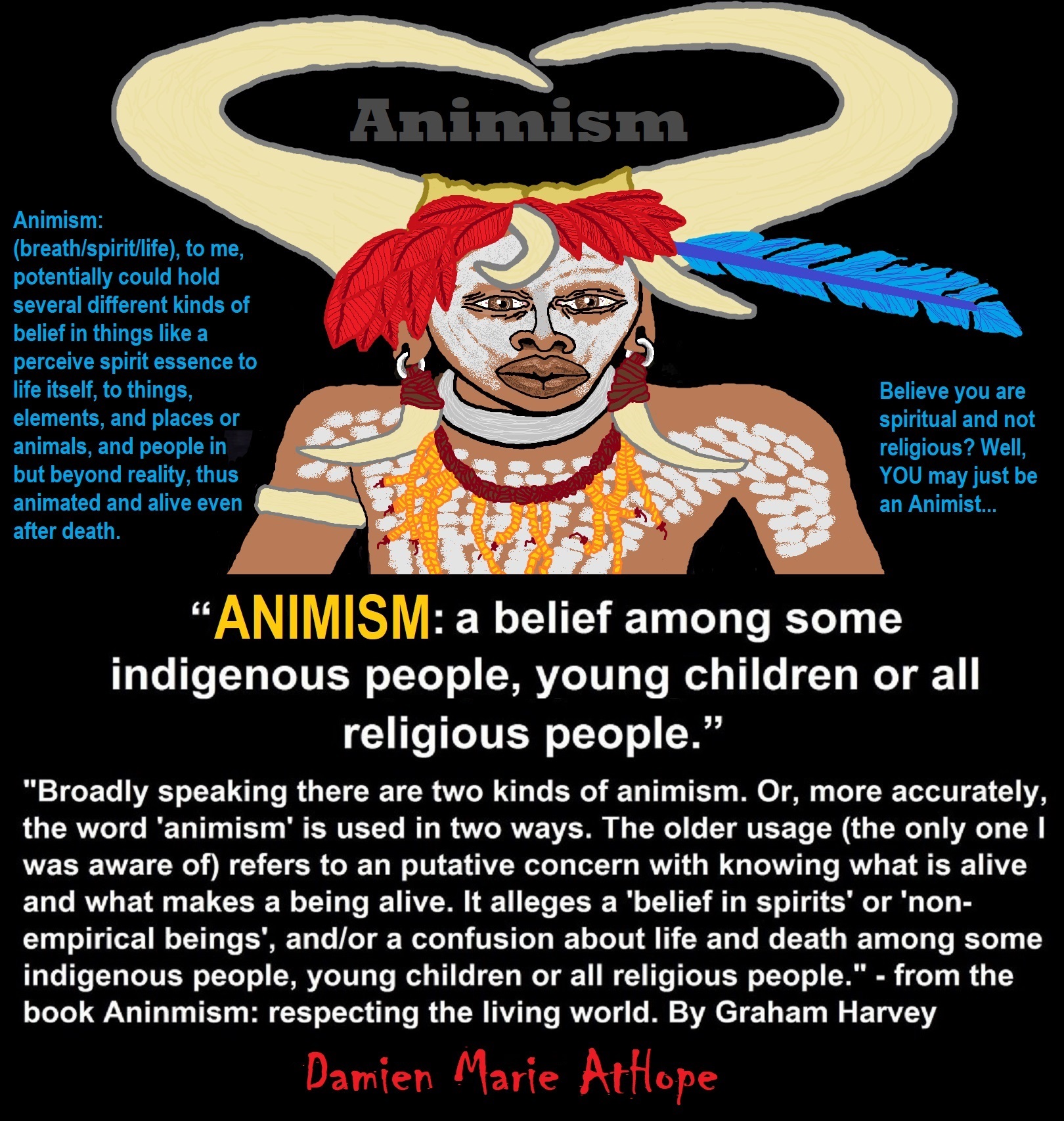
Animism: Respecting the Living World by Graham Harvey
“How have human cultures engaged with and thought about animals, plants, rocks, clouds, and other elements in their natural surroundings? Do animals and other natural objects have a spirit or soul? What is their relationship to humans? In this new study, Graham Harvey explores current and past animistic beliefs and practices of Native Americans, Maori, Aboriginal Australians, and eco-pagans. He considers the varieties of animism found in these cultures as well as their shared desire to live respectfully within larger natural communities. Drawing on his extensive casework, Harvey also considers the linguistic, performative, ecological, and activist implications of these different animisms.” ref

We are like believing machines we vacuum up ideas, like Velcro sticks to almost everything. We accumulate beliefs that we allow to negatively influence our lives, often without realizing it. Our willingness must be to alter skewed beliefs that impend our balance or reason, which allows us to achieve new positive thinking and accurate outcomes.
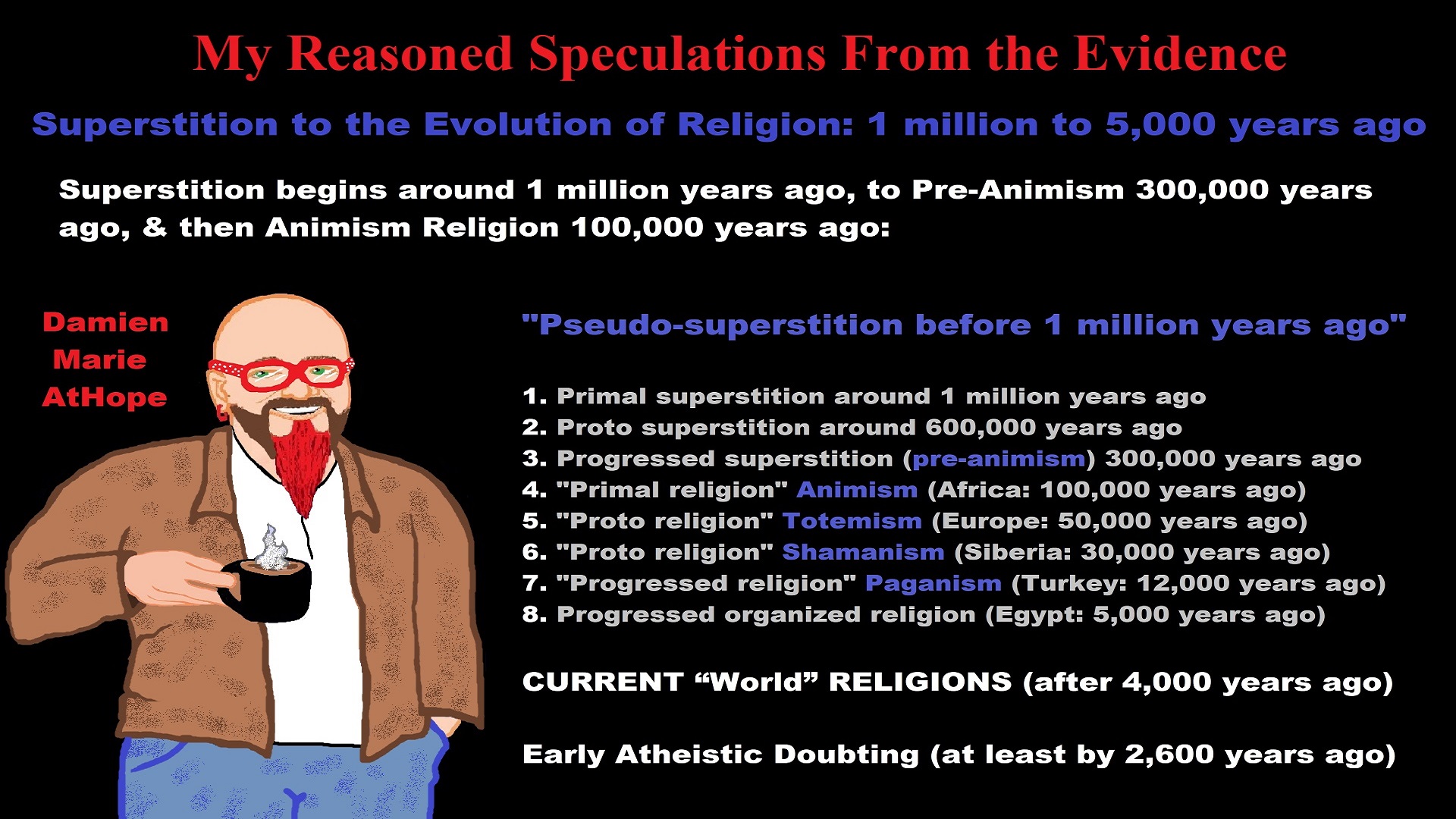
My thoughts on Religion Evolution with external links for more info:
- (Pre-Animism Africa mainly, but also Europe, and Asia at least 300,000 years ago), (Pre-Animism – Oxford Dictionaries)
- (Animism Africa around 100,000 years ago), (Animism – Britannica.com)
- (Totemism Europe around 50,000 years ago), (Totemism – Anthropology)
- (Shamanism Siberia around 30,000 years ago), (Shamanism – Britannica.com)
- (Paganism Turkey around 12,000 years ago), (Paganism – BBC Religion)
- (Progressed Organized Religion “Institutional Religion” Egypt around 5,000 years ago), (Ancient Egyptian Religion – Britannica.com)
- (CURRENT “World” RELIGIONS after 4,000 years ago) (Origin of Major Religions – Sacred Texts)
- (Early Atheistic Doubting at least by 2,600 years ago) (History of Atheism – Wikipedia)
“Religion is an Evolved Product” and Yes, Religion is Like Fear Given Wings…
Atheists talk about gods and religions for the same reason doctors talk about cancer, they are looking for a cure, or a firefighter talks about fires because they burn people and they care to stop them. We atheists too often feel a need to help the victims of mental slavery, held in the bondage that is the false beliefs of gods and the conspiracy theories of reality found in religions.
Understanding Religion Evolution:
- Pre-Animism (at least 300,000 years ago)
- Animism (Africa: 100,000 years ago)
- Totemism (Europe: 50,000 years ago)
- Shamanism (Siberia: 30,000 years ago)
- Paganism (Turkey: 12,000 years ago)
- Progressed organized religion (Egypt: 5,000 years ago), (Egypt, the First Dynasty 5,150 years ago)
- CURRENT “World” RELIGIONS (after 4,000 years ago)
- Early Atheistic Doubting (at least by 2,600 years ago)
“An Archaeological/Anthropological Understanding of Religion Evolution”
It seems ancient peoples had to survived amazing threats in a “dangerous universe (by superstition perceived as good and evil),” and human “immorality or imperfection of the soul” which was thought to affect the still living, leading to ancestor worship. This ancestor worship presumably led to the belief in supernatural beings, and then some of these were turned into the belief in gods. This feeble myth called gods were just a human conceived “made from nothing into something over and over, changing, again and again, taking on more as they evolve, all the while they are thought to be special,” but it is just supernatural animistic spirit-belief perceived as sacred.
Quick Evolution of Religion?
Pre-Animism (at least 300,000 years ago) pre-religion is a beginning that evolves into later Animism. So, Religion as we think of it, to me, all starts in a general way with Animism (Africa: 100,000 years ago) (theoretical belief in supernatural powers/spirits), then this is physically expressed in or with Totemism (Europe: 50,000 years ago) (theoretical belief in mythical relationship with powers/spirits through a totem item), which then enlists a full-time specific person to do this worship and believed interacting Shamanism (Siberia/Russia: 30,000 years ago) (theoretical belief in access and influence with spirits through ritual), and then there is the further employment of myths and gods added to all the above giving you Paganism (Turkey: 12,000 years ago) (often a lot more nature-based than most current top world religions, thus hinting to their close link to more ancient religious thinking it stems from). My hypothesis is expressed with an explanation of the building of a theatrical house (modern religions development). Progressed organized religion (Egypt: 5,000 years ago) with CURRENT “World” RELIGIONS (after 4,000 years ago).
Historically, in large city-state societies (such as Egypt or Iraq) starting around 5,000 years ago culminated to make religion something kind of new, a sociocultural-governmental-religious monarchy, where all or at least many of the people of such large city-state societies seem familiar with and committed to the existence of “religion” as the integrated life identity package of control dynamics with a fixed closed magical doctrine, but this juggernaut integrated religion identity package of Dogmatic-Propaganda certainly did not exist or if developed to an extent it was highly limited in most smaller prehistoric societies as they seem to lack most of the strong control dynamics with a fixed closed magical doctrine (magical beliefs could be at times be added or removed). Many people just want to see developed religious dynamics everywhere even if it is not. Instead, all that is found is largely fragments until the domestication of religion.
Religions, as we think of them today, are a new fad, even if they go back to around 6,000 years in the timeline of human existence, this amounts to almost nothing when seen in the long slow evolution of religion at least around 70,000 years ago with one of the oldest ritual worship. Stone Snake of South Africa: “first human worship” 70,000 years ago. This message of how religion and gods among them are clearly a man-made thing that was developed slowly as it was invented and then implemented peace by peace discrediting them all. Which seems to be a simple point some are just not grasping how devastating to any claims of truth when we can see the lie clearly in the archeological sites.
I wish people fought as hard for the actual values as they fight for the group/clan names political or otherwise they think support values. Every amount spent on war is theft to children in need of food or the homeless kept from shelter.
Here are several of my blog posts on history:
- To Find Truth You Must First Look
- (Magdalenian/Iberomaurusian) Connections to the First Paganists of the early Neolithic Near East Dating from around 17,000 to 12,000 Years Ago
- Natufians: an Ancient People at the Origins of Agriculture and Sedentary Life
- Possible Clan Leader/Special “MALE” Ancestor Totem Poles At Least 13,500 years ago?
- Jewish People with DNA at least 13,200 years old, Judaism, and the Origins of Some of its Ideas
- Baltic Reindeer Hunters: Swiderian, Lyngby, Ahrensburgian, and Krasnosillya cultures 12,020 to 11,020 years ago are evidence of powerful migratory waves during the last 13,000 years and a genetic link to Saami and the Finno-Ugric peoples.
- The Rise of Inequality: patriarchy and state hierarchy inequality
- Fertile Crescent 12,500 – 9,500 Years Ago: fertility and death cult belief system?
- 12,400 – 11,700 Years Ago – Kortik Tepe (Turkey) Pre/early-Agriculture Cultic Ritualism
- Ritualistic Bird Symbolism at Gobekli Tepe and its “Ancestor Cult”
- Male-Homosexual (female-like) / Trans-woman (female) Seated Figurine from Gobekli Tepe
- Could a 12,000-year-old Bull Geoglyph at Göbekli Tepe relate to older Bull and Female Art 25,000 years ago and Later Goddess and the Bull cults like Catal Huyuk?
- Sedentism and the Creation of goddesses around 12,000 years ago as well as male gods after 7,000 years ago.
- Alcohol, where Agriculture and Religion Become one? Such as Gobekli Tepe’s Ritualistic use of Grain as Food and Ritual Drink
- Neolithic Ritual Sites with T-Pillars and other Cultic Pillars
- Paganism: Goddesses around 12,000 years ago then Male Gods after 7,000 years ago
- First Patriarchy: Split of Women’s Status around 12,000 years ago & First Hierarchy: fall of Women’s Status around 5,000 years ago.
- Natufians: an Ancient People at the Origins of Agriculture and Sedentary Life
- J DNA and the Spread of Agricultural Religion (paganism)
- Paganism: an approximately 12,000-year-old belief system
- Paganism 12,000 years old: related to “Anarchism and Socialism” (Pre-Capitalism)
- Shaman burial in Israel 12,000 years ago and the Shamanism Phenomena
- Need to Mythicized: gods and goddesses
- 12,000 – 7,000 Years Ago – Paleo-Indian Culture (The Americas)
- 12,000 – 2,000 Years Ago – Indigenous-Scandinavians (Nordic)
- Norse did not wear helmets with horns?
- Pre-Pottery Neolithic Skull Cult around 11,500 to 8,400 Years Ago?
- 10,400 – 10,100 Years Ago, in Turkey the Nevail Cori Religious Settlement
- 9,000-6,500 Years Old Submerged Pre-Pottery/Pottery Neolithic Ritual Settlements off Israel’s Coast
- Catal Huyuk “first religious designed city” around 9,500 to 7,700 years ago (Turkey)
- Cultic Hunting at Catal Huyuk “first religious designed city”
- Special Items and Art as well as Special Elite Burials at Catal Huyuk
- New Rituals and Violence with the appearance of Pottery and People?
- Haplogroup N and its related Uralic Languages and Cultures
- Ainu people, Sámi people, Native Americans, the Ancient North Eurasians, and Paganistic-Shamanism with Totemism
- Ideas, Technology and People from Turkey, Europe, to China and Back again 9,000 to 5,000 years ago?
- First Pottery of Europe and the Related Cultures
- 9,000 years old Neolithic Artifacts Judean Desert and Hills Israel
- 9,000-7,000 years-old Sex and Death Rituals: Cult Sites in Israel, Jordan, and the Sinai
- 9,000-8500 year old Horned Female shaman Bad Dürrenberg Germany
- Neolithic Jewelry and the Spread of Farming in Europe Emerging out of West Turkey
- 8,600-year-old Tortoise Shells in Neolithic graves in central China have Early Writing and Shamanism
- Swing of the Mace: the rise of Elite, Forced Authority, and Inequality begin to Emerge 8,500 years ago?
- Migrations and Changing Europeans Beginning around 8,000 Years Ago
- My “Steppe-Anatolian-Kurgan hypothesis” 8,000/7,000 years ago
- Around 8,000-year-old Shared Idea of the Mistress of Animals, “Ritual” Motif
- Pre-Columbian Red-Paint (red ochre) Maritime Archaic Culture 8,000-3,000 years ago
- 7,522-6,522 years ago Linear Pottery culture which I think relates to Arcane Capitalism’s origins
- Arcane Capitalism: Primitive socialism, Primitive capital, Private ownership, Means of production, Market capitalism, Class discrimination, and Petite bourgeoisie (smaller capitalists)
- 7,500-4,750 years old Ritualistic Cucuteni-Trypillian culture of Moldova, Romania, and Ukraine
- Roots of a changing early society 7,200-6,700 years ago Jordan and Israel
- Agriculture religion (Paganism) with farming reached Britain between about 7,000 to 6,500 or so years ago and seemingly expressed in things like Western Europe’s Long Barrows
- My Thoughts on Possible Migrations of “R” DNA and Proto-Indo-European?
- “Millet” Spreading from China 7,022 years ago to Europe and related Language may have Spread with it leading to Proto-Indo-European
- Proto-Indo-European (PIE), ancestor of Indo-European languages: DNA, Society, Language, and Mythology
- The Dnieper–Donets culture and Asian varieties of Millet from China to the Black Sea region of Europe by 7,022 years ago
- Kurgan 6,000 years ago/dolmens 7,000 years ago: funeral, ritual, and other?
- 7,020 to 6,020-year-old Proto-Indo-European Homeland of Urheimat or proposed home of their Language and Religion
- Ancient Megaliths: Kurgan, Ziggurat, Pyramid, Menhir, Trilithon, Dolman, Kromlech, and Kromlech of Trilithons
- The Mytheme of Ancient North Eurasian Sacred-Dog belief and similar motifs are found in Indo-European, Native American, and Siberian comparative mythology
- Elite Power Accumulation: Ancient Trade, Tokens, Writing, Wealth, Merchants, and Priest-Kings
- Sacred Mounds, Mountains, Kurgans, and Pyramids may hold deep connections?
- Between 7,000-5,000 Years ago, rise of unequal hierarchy elite, leading to a “birth of the State” or worship of power, strong new sexism, oppression of non-elites, and the fall of Women’s equal status
- Paganism 7,000-5,000 years old: related to “Anarchism and Socialism” (Capitalism) (World War 0) Elite & their slaves
- Hell and Underworld mythologies starting maybe as far back as 7,000 to 5,000 years ago with the Proto-Indo-Europeans?
- The First Expression of the Male God around 7,000 years ago?
- White (light complexion skin) Bigotry and Sexism started 7,000 years ago?
- Around 7,000-year-old Shared Idea of the Divine Bird (Tutelary and/or Trickster spirit/deity), “Ritual” Motif
- Nekhbet an Ancient Egyptian Vulture Goddess and Tutelary Deity
- 6,720 to 4,920 years old Ritualistic Hongshan Culture of Inner Mongolia with 5,000-year-old Pyramid Mounds and Temples
- First proto-king in the Balkans, Varna culture around 6,500 years ago?
- 6,500–5,800 years ago in Israel Late Chalcolithic (Copper Age) Period in the Southern Levant Seems to Express Northern Levant Migrations, Cultural and Religious Transfer
- KING OF BEASTS: Master of Animals “Ritual” Motif, around 6,000 years old or older…
- Around 6000-year-old Shared Idea of the Solid Wheel & the Spoked Wheel-Shaped Ritual Motif
- “The Ghassulian Star,” a mysterious 6,000-year-old mural from Jordan; a Proto-Star of Ishtar, Star of Inanna or Star of Venus?
- Religious/Ritual Ideas, including goddesses and gods as well as ritual mounds or pyramids from Northeastern Asia at least 6,000 years old, seemingly filtering to Iran, Iraq, the Mediterranean, Europe, Egypt, and the Americas?
- Maykop (5,720–5,020 years ago) Caucasus region Bronze Age culture-related to Copper Age farmers from the south, influenced by the Ubaid period and Leyla-Tepe culture, as well as influencing the Kura-Araxes culture
- 5-600-year-old Tomb, Mummy, and First Bearded Male Figurine in a Grave
- Kura-Araxes Cultural 5,520 to 4,470 years old DNA traces to the Canaanites, Arabs, and Jews
- Minoan/Cretan (Keftiu) Civilization and Religion around 5,520 to 3,120 years ago
- Evolution Of Science at least by 5,500 years ago
- 5,500 Years old birth of the State, the rise of Hierarchy, and the fall of Women’s status
- “Jiroft culture” 5,100 – 4,200 years ago and the History of Iran
- Stonehenge: Paganistic Burial and Astrological Ritual Complex, England (5,100-3,600 years ago)
- Around 5,000-year-old Shared Idea of the “Tree of Life” Ritual Motif
- Complex rituals for elite, seen from China to Egypt, at least by 5,000 years ago
- Around 5,000 years ago: “Birth of the State” where Religion gets Military Power and Influence
- The Center of the World “Axis Mundi” and/or “Sacred Mountains” Mythology Could Relate to the Altai Mountains, Heart of the Steppe
- Progressed organized religion starts, an approximately 5,000-year-old belief system
- China’s Civilization between 5,000-3,000 years ago, was a time of war and class struggle, violent transition from free clans to a Slave or Elite society
- Origin of Logics is Naturalistic Observation at least by around 5,000 years ago.
- Paganism 5,000 years old: progressed organized religion and the state: related to “Anarchism and Socialism” (Kings and the Rise of the State)
- Ziggurats (multi-platform temples: 4,900 years old) to Pyramids (multi-platform tombs: 4,700 years old)
- Did a 4,520–4,420-year-old Volcano In Turkey Inspire the Bible God?
- Finland’s Horned Shaman and Pre-Horned-God at least 4,500 years ago?
- 4,000-year-Old Dolmens in Israel: A Connected Dolmen Religious Phenomenon?
- Creation myths: From chaos, Ex nihilo, Earth-diver, Emergence, World egg, and World parent
- Bronze Age “Ritual” connections of the Bell Beaker culture with the Corded Ware/Single Grave culture, which were related to the Yamnaya culture and Proto-Indo-European Languages/Religions
- Low Gods (Earth/ Tutelary deity), High Gods (Sky/Supreme deity), and Moralistic Gods (Deity enforcement/divine order)
- The exchange of people, ideas, and material-culture including, to me, the new god (Sky Father) and goddess (Earth Mother) religion between the Cucuteni-Trypillians and others which is then spread far and wide
- Koryaks: Indigenous People of the Russian Far East and Big Raven myths also found in Tlingit, Haida, Tsimshian, and other Indigenous People of North America
- 42 Principles Of Maat (Egyptian Goddess of the justice) around 4,400 years ago, 2000 Years Before Ten Commandments
- “Happy Easter” Well Happy Eostre/Ishter
- 4,320-3,820 years old “Shimao” (North China) site with Totemistic-Shamanistic Paganism and a Stepped Pyramid
- 4,250 to 3,400 Year old Stonehenge from Russia: Arkaim?
- 4,100-year-old beaker with medicinal & flowering plants in a grave of a woman in Scotland
- Early European Farmer ancestry, Kelif el Boroud people with the Cardial Ware culture, and the Bell Beaker culture Paganists too, spread into North Africa, then to the Canary Islands off West Africa
- Flood Accounts: Gilgamesh epic (4,100 years ago) Noah in Genesis (2,600 years ago)
- Paganism 4,000 years old: related to “Anarchism and Socialism” (First Moralistic gods, then the Origin time of Monotheism)
- When was the beginning: TIMELINE OF CURRENT RELIGIONS, which start around 4,000 years ago.
- Early Religions Thought to Express Proto-Monotheistic Systems around 4,000 years ago
- Kultepe? An archaeological site with a 4,000 years old women’s rights document.
- Single God Religions (Monotheism) = “Man-o-theism” started around 4,000 years ago with the Great Sky Spirit/God Tiān (天)?
- Confucianism’s Tiān (Shangdi god 4,000 years old): Supernaturalism, Pantheism or Theism?
- Yes, Your Male God is Ridiculous
- Mythology, a Lunar Deity is a Goddess or God of the Moon
- Sacred Land, Hills, and Mountains: Sami Mythology (Paganistic Shamanism)
- Horse Worship/Sacrifice: mythical union of Ruling Elite/Kingship and the Horse
- The Amorite/Amurru people’s God Amurru “Lord of the Steppe”, relates to the Origins of the Bible God?
- Bronze Age Exotic Trade Routes Spread Quite Far as well as Spread Religious Ideas with Them
- Sami and the Northern Indigenous Peoples Landscape, Language, and its Connection to Religion
- Prototype of Ancient Analemmatic Sundials around 3,900-3,150 years ago and a Possible Solar Connection to gods?
- Judaism is around 3,450 or 3,250 years old. (“Paleo-Hebrew” 3,000 years ago and Torah 2,500 years ago)
- The Weakening of Ancient Trade and the Strengthening of Religions around 3000 years ago?
- Are you aware that there are religions that worship women gods, explain now religion tears women down?
- Animistic, Totemistic, and Paganistic Superstition Origins of bible god and the bible’s Religion.
- Myths and Folklore: “Trickster gods and goddesses”
- Jews, Judaism, and the Origins of Some of its Ideas
- An Old Branch of Religion Still Giving Fruit: Sacred Trees
- Dating the BIBLE: naming names and telling times (written less than 3,000 years ago, provable to 2,200 years ago)
- Did a Volcano Inspire the bible god?
- Dené–Yeniseian language, Old Copper Complex, and Pre-Columbian Mound Builders?
- No “dinosaurs and humans didn’t exist together just because some think they are in the bible itself”
- Sacred Shit and Sacred Animals?
- Everyone Killed in the Bible Flood? “Nephilim” (giants)?
- Hey, Damien dude, I have a question for you regarding “the bible” Exodus.
- Archaeology Disproves the Bible
- Bible Battle, Just More, Bible Babble
- The Jericho Conquest lie?
- Canaanites and Israelites?
- Accurate Account on how did Christianity Began?
- Let’s talk about Christianity.
- So the 10 commandments isn’t anything to go by either right?
- Misinformed christian
- Debunking Jesus?
- Paulism vs Jesus
- Ok, you seem confused so let’s talk about Buddhism.
- Unacknowledged Buddhism: Gods, Savior, Demons, Rebirth, Heavens, Hells, and Terrorism
- His Foolishness The Dalai Lama
- Yin and Yang is sexist with an ORIGIN around 2,300 years ago?
- I Believe Archaeology, not Myths & Why Not, as the Religious Myths Already Violate Reason!
- Archaeological, Scientific, & Philosophic evidence shows the god myth is man-made nonsense.
- Aquatic Ape Theory/Hypothesis? As Always, Just Pseudoscience.
- Ancient Aliens Conspiracy Theorists are Pseudohistorians
- The Pseudohistoric and Pseudoscientific claims about “Bakoni Ruins” of South Africa
- Why do people think Religion is much more than supernaturalism and superstitionism?
- Religion is an Evolved Product
- Was the Value of Ancient Women Different?
- 1000 to 1100 CE, human sacrifice Cahokia Mounds a pre-Columbian Native American site
- Feminist atheists as far back as the 1800s?
- Promoting Religion as Real is Mentally Harmful to a Flourishing Humanity
- Screw All Religions and Their Toxic lies, they are all fraud
- Forget Religions’ Unfounded Myths, I Have Substantiated “Archaeology Facts.”
- Religion Dispersal throughout the World
- I Hate Religion Just as I Hate all Pseudoscience
- Exposing Scientology, Eckankar, Wicca and Other Nonsense?
- Main deity or religious belief systems
- Quit Trying to Invent Your God From the Scraps of Science.
- Archaeological, Scientific, & Philosophic evidence shows the god myth is man-made nonsense.
- Ancient Alien Conspiracy Theorists: Misunderstanding, Rhetoric, Misinformation, Fabrications, and Lies
- Misinformation, Distortion, and Pseudoscience in Talking with a Christian Creationist
- Judging the Lack of Goodness in Gods, Even the Norse God Odin
- Challenging the Belief in God-like Aliens and Gods in General
- A Challenge to Christian use of Torture Devices?
- Yes, Hinduism is a Religion
- Trump is One of the Most Reactionary Forces of Far-right Christian Extremism
- Was the Bull Head a Symbol of God? Yes!
- Primate Death Rituals
- Christian – “God and Christianity are objectively true”
- Australopithecus afarensis Death Ritual?
- You Claim Global Warming is a Hoax?
- Doubter of Science and Defamer of Atheists?
- I think that sounds like the Bible?
- History of the Antifa (“anti-fascist”) Movements
- Indianapolis Anti-Blasphemy Laws #Free Soheil Rally
- Damien, you repeat the golden rule in so many forms then you say religion is dogmatic?
- Science is a Trustable Methodology whereas Faith is not Trustable at all!
- Was I ever a believer, before I was an atheist?
- Atheists rise in reason
- Mistrust of science?
- Open to Talking About the Definition of ‘God’? But first, we address Faith.
- ‘United Monarchy’ full of splendor and power – Saul, David, and Solomon? Most likely not.
- Is there EXODUS ARCHAEOLOGY? The short answer is “no.”
- Lacking Proof of Bigfoots, Unicorns, and Gods is Just a Lack of Research?
- Religion and Politics: Faith Beliefs vs. Rational Thinking
- Hammer of Truth that lying pig RELIGION: challenged by an archaeologist
- “The Hammer of Truth” -ontology question- What do You Mean by That?
- Navigation of a bad argument: Ad Hominem vs. Attack
- Why is it Often Claimed that Gods have a Gender?
- Why are basically all monotheistic religions ones that have a male god?
- Shifting through the Claims in support of Faith
- Dear Mr. AtHope, The 20th Century is an Indictment of Secularism and a Failed Atheist Century
- An Understanding of the Worldwide Statistics and Dynamics of Terrorist Incidents and Suicide Attacks
- Intoxication and Evolution? Addressing and Assessing the “Stoned Ape” or “Drunken Monkey” Theories as Catalysts in Human Evolution
- Sacred Menstrual cloth? Inanna’s knot, Isis knot, and maybe Ma’at’s feather?
- Damien, why don’t the Hebrews accept the bible stories?
- Dealing with a Troll and Arguing Over Word Meaning
- Knowledge without Belief? Justified beliefs or disbeliefs worthy of Knowledge?
- Afrocentrism and African Religions
- Crecganford @crecganford offers history & stories of the people, places, gods, & culture
- Empiricism-Denier?
I am not an academic. I am a revolutionary that teaches in public, in places like social media, and in the streets. I am not a leader by some title given but from my commanding leadership style of simply to start teaching everywhere to everyone, all manner of positive education.
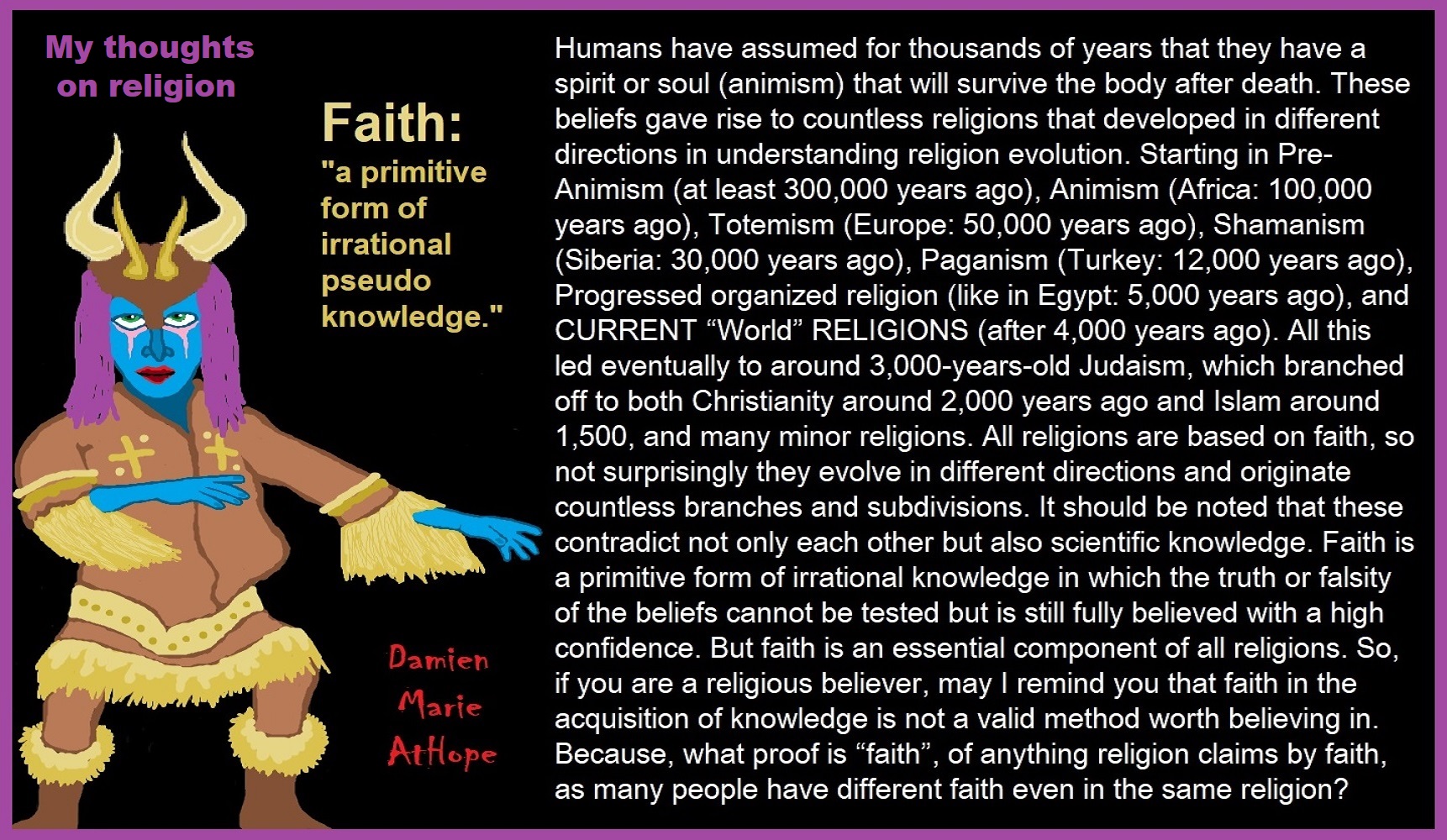
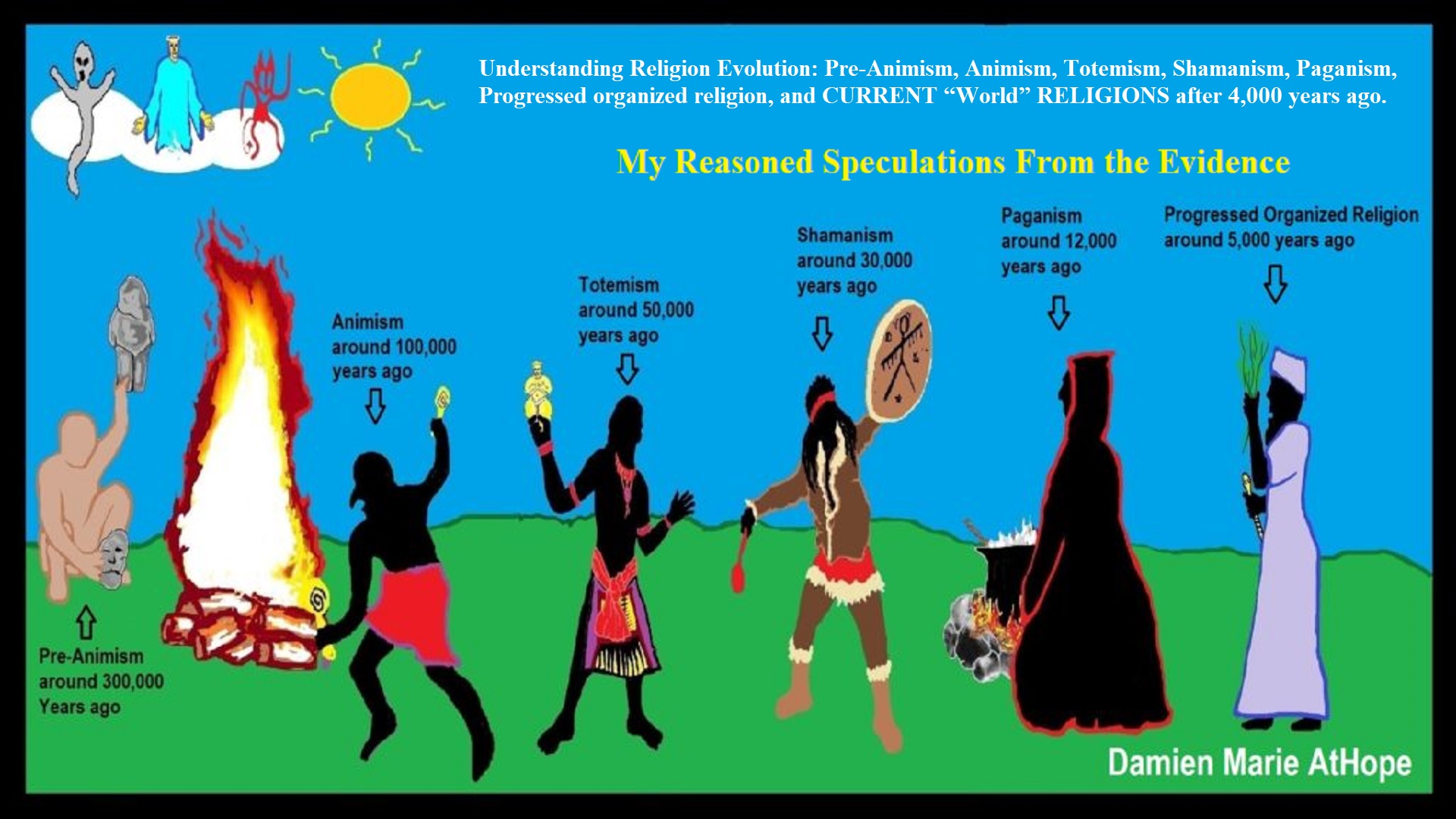

To me, Animism starts in Southern Africa, then to West Europe, and becomes Totemism. Another split goes near the Russia and Siberia border becoming Shamanism, which heads into Central Europe meeting up with Totemism, which also had moved there, mixing the two which then heads to Lake Baikal in Siberia. From there this Shamanism-Totemism heads to Turkey where it becomes Paganism.

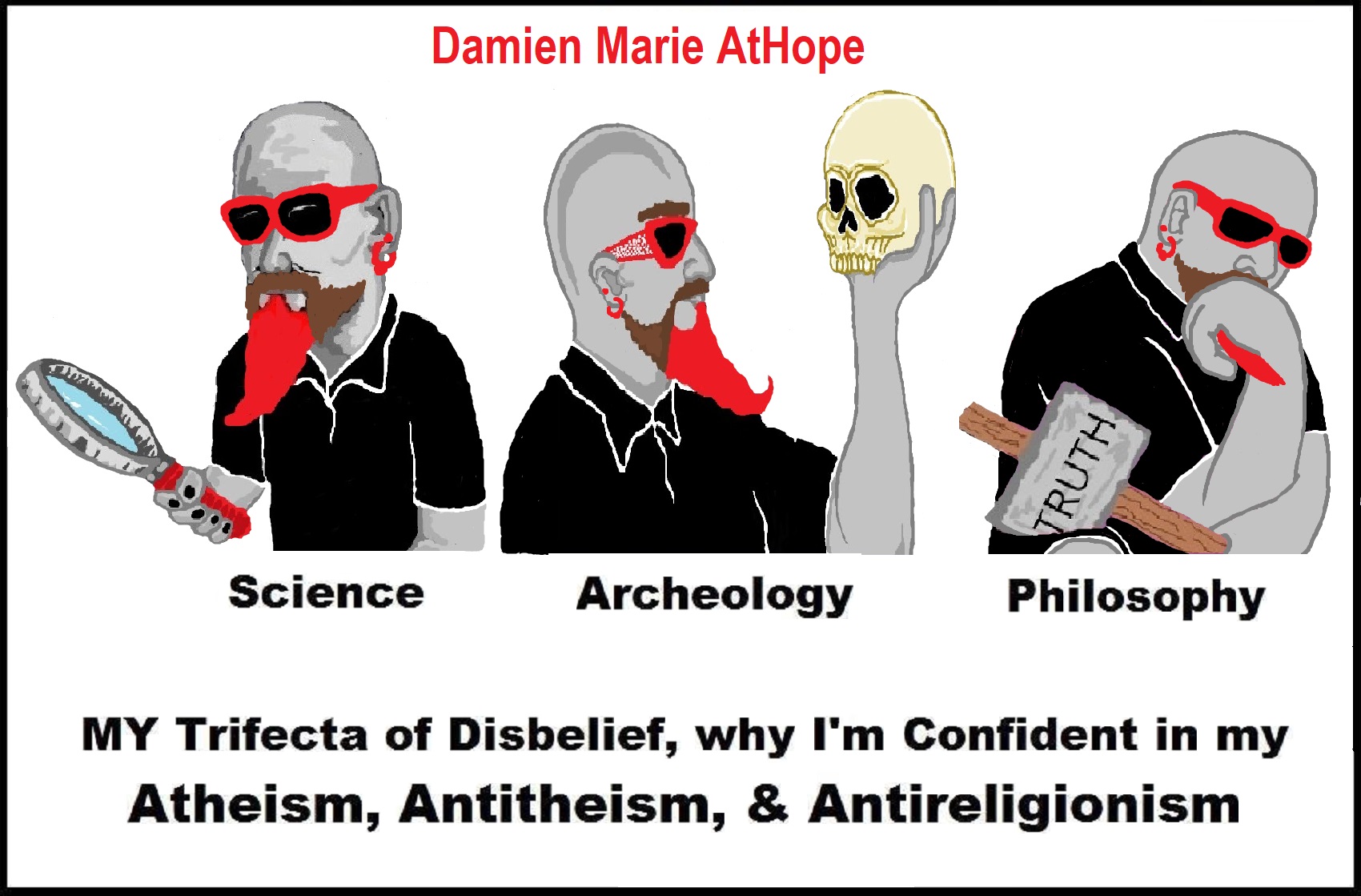
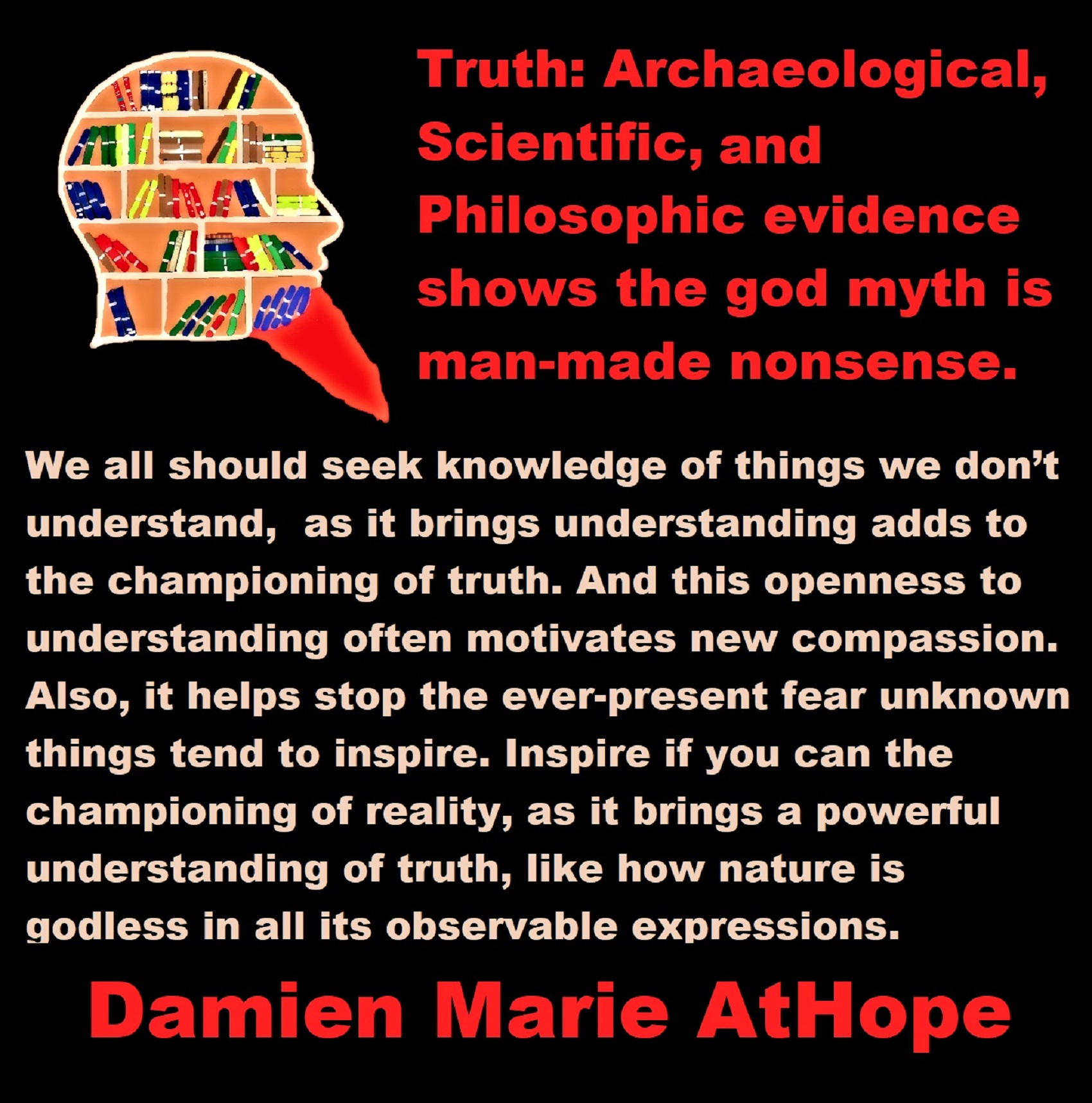
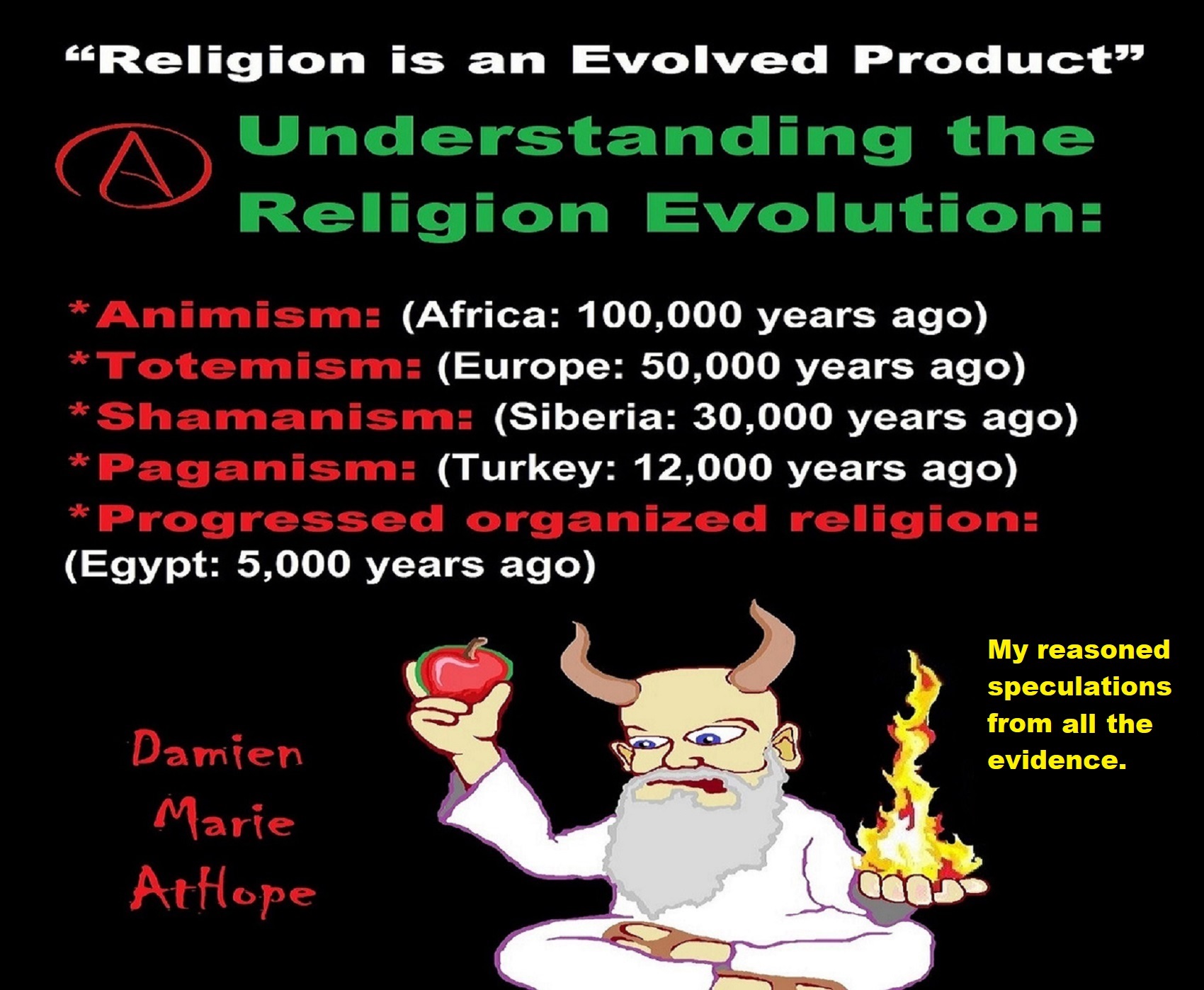
Not all “Religions” or “Religious Persuasions” have a god(s) but
All can be said to believe in some imaginary beings or imaginary things like spirits, afterlives, etc.
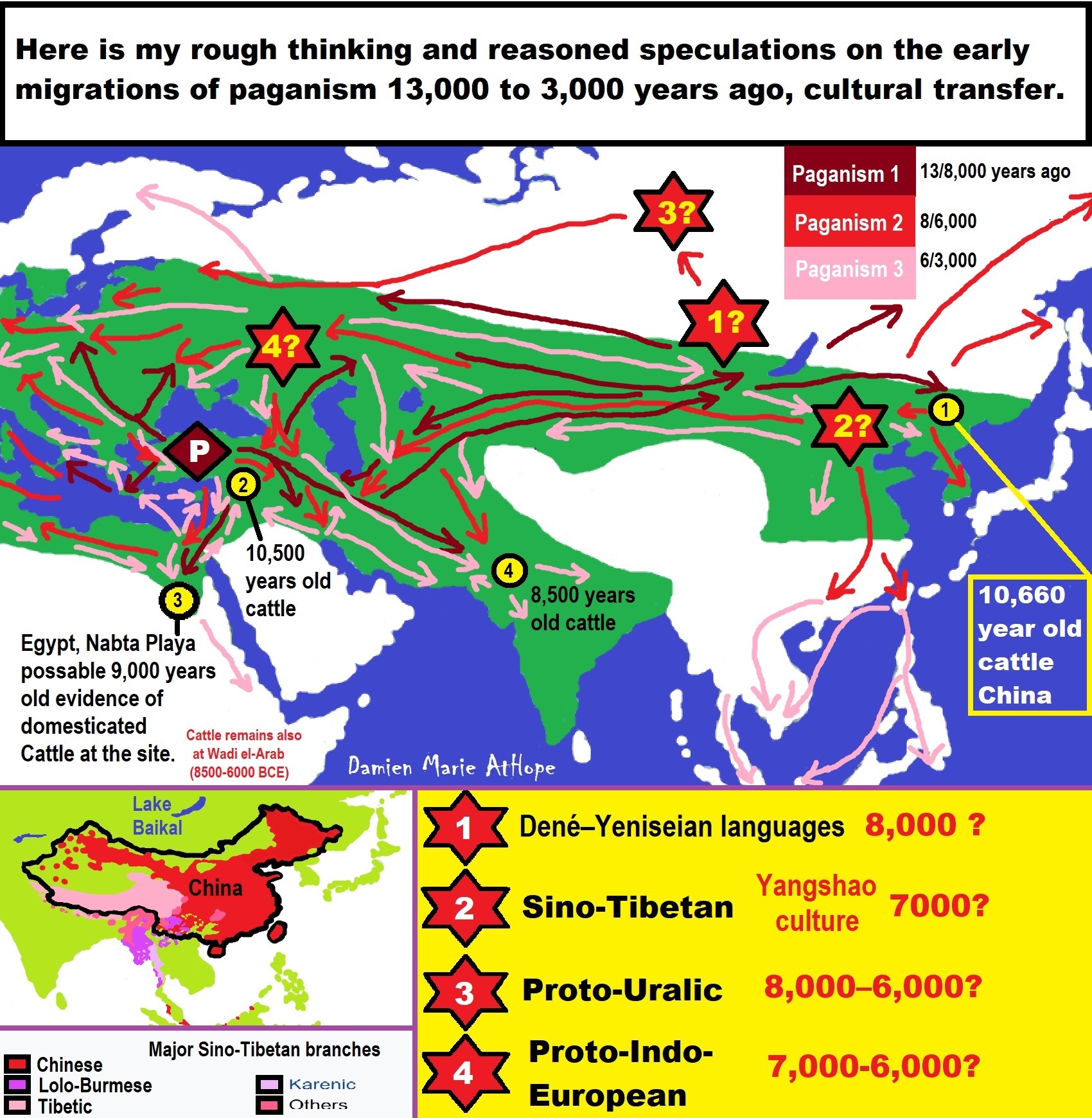
Paganism 12,000-4,000 years old
12,000-7,000 years old: related to (Pre-Capitalism)
7,000-5,000 years old: related to (Capitalism) (World War 0) Elite and their slaves!
5,000 years old: related to (Kings and the Rise of the State)
4,000 years old: related to (First Moralistic gods, then the Origin time of Monotheism)
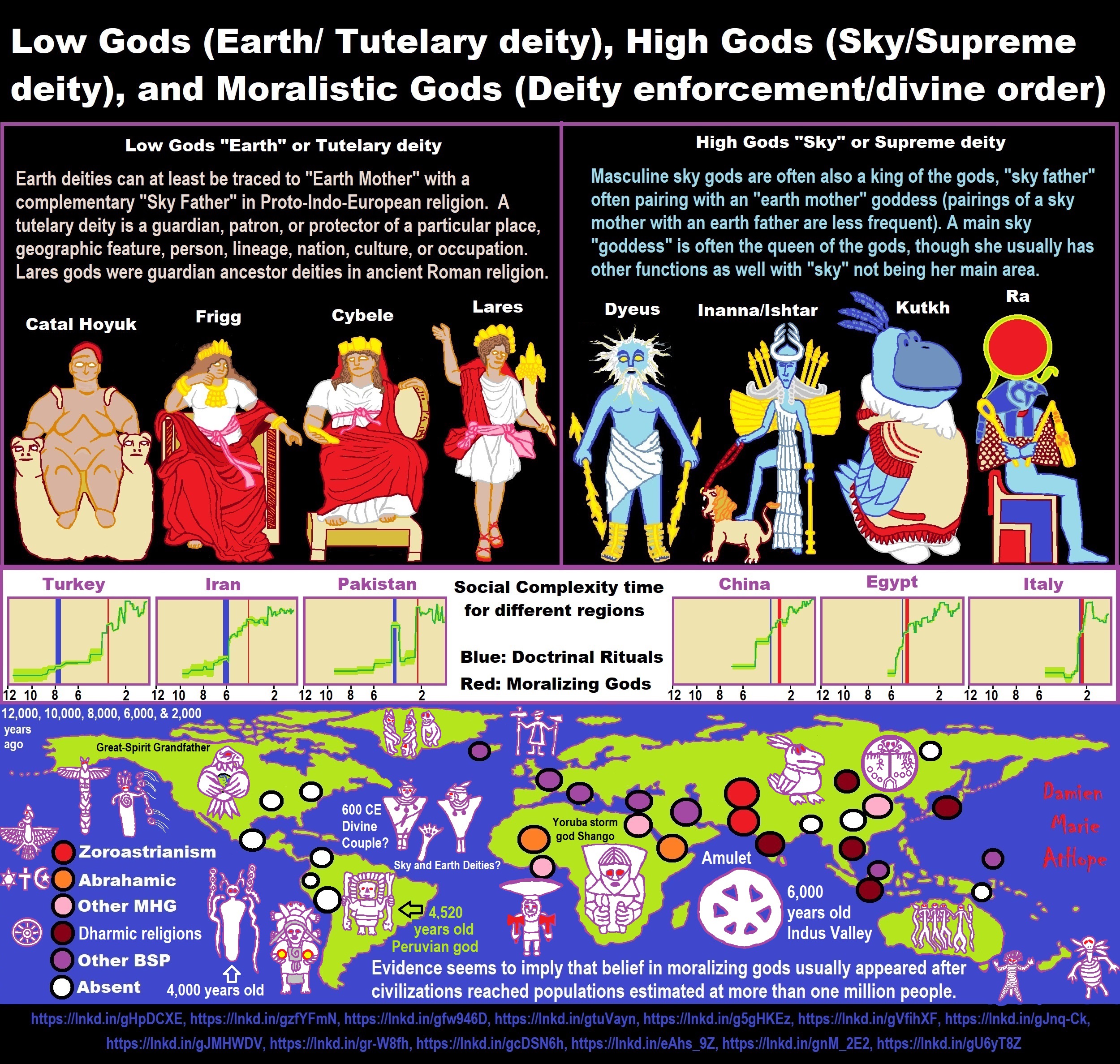
ref, ref, ref, ref, ref, ref, ref, ref, ref, ref, ref, ref, ref, ref, ref, ref, ref, ref, ref, ref, ref
Low Gods “Earth” or Tutelary deity and High Gods “Sky” or Supreme deity
“An Earth goddess is a deification of the Earth. Earth goddesses are often associated with the “chthonic” deities of the underworld. Ki and Ninhursag are Mesopotamian earth goddesses. In Greek mythology, the Earth is personified as Gaia, corresponding to Roman Terra, Indic Prithvi/Bhūmi, etc. traced to an “Earth Mother” complementary to the “Sky Father” in Proto-Indo-European religion. Egyptian mythology exceptionally has a sky goddess and an Earth god.” ref
“A mother goddess is a goddess who represents or is a personification of nature, motherhood, fertility, creation, destruction or who embodies the bounty of the Earth. When equated with the Earth or the natural world, such goddesses are sometimes referred to as Mother Earth or as the Earth Mother. In some religious traditions or movements, Heavenly Mother (also referred to as Mother in Heaven or Sky Mother) is the wife or feminine counterpart of the Sky father or God the Father.” ref
“Any masculine sky god is often also king of the gods, taking the position of patriarch within a pantheon. Such king gods are collectively categorized as “sky father” deities, with a polarity between sky and earth often being expressed by pairing a “sky father” god with an “earth mother” goddess (pairings of a sky mother with an earth father are less frequent). A main sky goddess is often the queen of the gods and may be an air/sky goddess in her own right, though she usually has other functions as well with “sky” not being her main. In antiquity, several sky goddesses in ancient Egypt, Mesopotamia, and the Near East were called Queen of Heaven. Neopagans often apply it with impunity to sky goddesses from other regions who were never associated with the term historically. The sky often has important religious significance. Many religions, both polytheistic and monotheistic, have deities associated with the sky.” ref
“In comparative mythology, sky father is a term for a recurring concept in polytheistic religions of a sky god who is addressed as a “father”, often the father of a pantheon and is often either a reigning or former King of the Gods. The concept of “sky father” may also be taken to include Sun gods with similar characteristics, such as Ra. The concept is complementary to an “earth mother“. “Sky Father” is a direct translation of the Vedic Dyaus Pita, etymologically descended from the same Proto-Indo-European deity name as the Greek Zeûs Pater and Roman Jupiter and Germanic Týr, Tir or Tiwaz, all of which are reflexes of the same Proto-Indo-European deity’s name, *Dyēus Ph₂tḗr. While there are numerous parallels adduced from outside of Indo-European mythology, there are exceptions (e.g. In Egyptian mythology, Nut is the sky mother and Geb is the earth father).” ref
Tutelary deity
“A tutelary (also tutelar) is a deity or spirit who is a guardian, patron, or protector of a particular place, geographic feature, person, lineage, nation, culture, or occupation. The etymology of “tutelary” expresses the concept of safety and thus of guardianship. In late Greek and Roman religion, one type of tutelary deity, the genius, functions as the personal deity or daimon of an individual from birth to death. Another form of personal tutelary spirit is the familiar spirit of European folklore.” ref
“A tutelary (also tutelar) in Korean shamanism, jangseung and sotdae were placed at the edge of villages to frighten off demons. They were also worshiped as deities. Seonangshin is the patron deity of the village in Korean tradition and was believed to embody the Seonangdang. In Philippine animism, Diwata or Lambana are deities or spirits that inhabit sacred places like mountains and mounds and serve as guardians. Such as: Maria Makiling is the deity who guards Mt. Makiling and Maria Cacao and Maria Sinukuan. In Shinto, the spirits, or kami, which give life to human bodies come from nature and return to it after death. Ancestors are therefore themselves tutelaries to be worshiped. And similarly, Native American beliefs such as Tonás, tutelary animal spirit among the Zapotec and Totems, familial or clan spirits among the Ojibwe, can be animals.” ref
“A tutelary (also tutelar) in Austronesian beliefs such as: Atua (gods and spirits of the Polynesian peoples such as the Māori or the Hawaiians), Hanitu (Bunun of Taiwan‘s term for spirit), Hyang (Kawi, Sundanese, Javanese, and Balinese Supreme Being, in ancient Java and Bali mythology and this spiritual entity, can be either divine or ancestral), Kaitiaki (New Zealand Māori term used for the concept of guardianship, for the sky, the sea, and the land), Kawas (mythology) (divided into 6 groups: gods, ancestors, souls of the living, spirits of living things, spirits of lifeless objects, and ghosts), Tiki (Māori mythology, Tiki is the first man created by either Tūmatauenga or Tāne and represents deified ancestors found in most Polynesian cultures). ” ref, ref, ref, ref, ref, ref, ref
Mesopotamian Tutelary Deities can be seen as ones related to City-States
“Historical city-states included Sumerian cities such as Uruk and Ur; Ancient Egyptian city-states, such as Thebes and Memphis; the Phoenician cities (such as Tyre and Sidon); the five Philistine city-states; the Berber city-states of the Garamantes; the city-states of ancient Greece (the poleis such as Athens, Sparta, Thebes, and Corinth); the Roman Republic (which grew from a city-state into a vast empire); the Italian city-states from the Middle Ages to the early modern period, such as Florence, Siena, Ferrara, Milan (which as they grew in power began to dominate neighboring cities) and Genoa and Venice, which became powerful thalassocracies; the Mayan and other cultures of pre-Columbian Mesoamerica (including cities such as Chichen Itza, Tikal, Copán and Monte Albán); the central Asian cities along the Silk Road; the city-states of the Swahili coast; Ragusa; states of the medieval Russian lands such as Novgorod and Pskov; and many others.” ref
“The Uruk period (ca. 4000 to 3100 BCE; also known as Protoliterate period) of Mesopotamia, named after the Sumerian city of Uruk, this period saw the emergence of urban life in Mesopotamia and the Sumerian civilization. City-States like Uruk and others had a patron tutelary City Deity along with a Priest-King.” ref
“Chinese folk religion, both past, and present, includes myriad tutelary deities. Exceptional individuals, highly cultivated sages, and prominent ancestors can be deified and honored after death. Lord Guan is the patron of military personnel and police, while Mazu is the patron of fishermen and sailors. Such as Tu Di Gong (Earth Deity) is the tutelary deity of a locality, and each individual locality has its own Earth Deity and Cheng Huang Gong (City God) is the guardian deity of an individual city, worshipped by local officials and locals since imperial times.” ref
“A tutelary (also tutelar) in Hinduism, personal tutelary deities are known as ishta-devata, while family tutelary deities are known as Kuladevata. Gramadevata are guardian deities of villages. Devas can also be seen as tutelary. Shiva is the patron of yogis and renunciants. City goddesses include: Mumbadevi (Mumbai), Sachchika (Osian); Kuladevis include: Ambika (Porwad), and Mahalakshmi. In NorthEast India Meitei mythology and religion (Sanamahism) of Manipur, there are various types of tutelary deities, among which Lam Lais are the most predominant ones. Tibetan Buddhism has Yidam as a tutelary deity. Dakini is the patron of those who seek knowledge.” ref
“A tutelary (also tutelar) The Greeks also thought deities guarded specific places: for instance, Athena was the patron goddess of the city of Athens. Socrates spoke of hearing the voice of his personal spirit or daimonion:
You have often heard me speak of an oracle or sign which comes to me … . This sign I have had ever since I was a child. The sign is a voice which comes to me and always forbids me to do something which I am going to do, but never commands me to do anything, and this is what stands in the way of my being a politician.” ref
“Tutelary deities who guard and preserve a place or a person are fundamental to ancient Roman religion. The tutelary deity of a man was his Genius, that of a woman her Juno. In the Imperial era, the Genius of the Emperor was a focus of Imperial cult. An emperor might also adopt a major deity as his personal patron or tutelary, as Augustus did Apollo. Precedents for claiming the personal protection of a deity were established in the Republican era, when for instance the Roman dictator Sulla advertised the goddess Victory as his tutelary by holding public games (ludi) in her honor.” ref
“Each town or city had one or more tutelary deities, whose protection was considered particularly vital in time of war and siege. Rome itself was protected by a goddess whose name was to be kept ritually secret on pain of death (for a supposed case, see Quintus Valerius Soranus). The Capitoline Triad of Juno, Jupiter, and Minerva were also tutelaries of Rome. The Italic towns had their own tutelary deities. Juno often had this function, as at the Latin town of Lanuvium and the Etruscan city of Veii, and was often housed in an especially grand temple on the arx (citadel) or other prominent or central location. The tutelary deity of Praeneste was Fortuna, whose oracle was renowned.” ref
“The Roman ritual of evocatio was premised on the belief that a town could be made vulnerable to military defeat if the power of its tutelary deity were diverted outside the city, perhaps by the offer of superior cult at Rome. The depiction of some goddesses such as the Magna Mater (Great Mother, or Cybele) as “tower-crowned” represents their capacity to preserve the city. A town in the provinces might adopt a deity from within the Roman religious sphere to serve as its guardian, or syncretize its own tutelary with such; for instance, a community within the civitas of the Remi in Gaul adopted Apollo as its tutelary, and at the capital of the Remi (present-day Rheims), the tutelary was Mars Camulus.” ref
Household deity (a kind of or related to a Tutelary deity)
“A household deity is a deity or spirit that protects the home, looking after the entire household or certain key members. It has been a common belief in paganism as well as in folklore across many parts of the world. Household deities fit into two types; firstly, a specific deity – typically a goddess – often referred to as a hearth goddess or domestic goddess who is associated with the home and hearth, such as the ancient Greek Hestia.” ref
“The second type of household deities are those that are not one singular deity, but a type, or species of animistic deity, who usually have lesser powers than major deities. This type was common in the religions of antiquity, such as the Lares of ancient Roman religion, the Gashin of Korean shamanism, and Cofgodas of Anglo-Saxon paganism. These survived Christianisation as fairy-like creatures existing in folklore, such as the Anglo-Scottish Brownie and Slavic Domovoy.” ref
“Household deities were usually worshipped not in temples but in the home, where they would be represented by small idols (such as the teraphim of the Bible, often translated as “household gods” in Genesis 31:19 for example), amulets, paintings, or reliefs. They could also be found on domestic objects, such as cosmetic articles in the case of Tawaret. The more prosperous houses might have a small shrine to the household god(s); the lararium served this purpose in the case of the Romans. The gods would be treated as members of the family and invited to join in meals, or be given offerings of food and drink.” ref
“In many religions, both ancient and modern, a god would preside over the home. Certain species, or types, of household deities, existed. An example of this was the Roman Lares. Many European cultures retained house spirits into the modern period. Some examples of these include:
- Brownie (Scotland and England) or Hob (England) / Kobold (Germany) / Goblin / Hobgoblin
- Domovoy (Slavic)
- Nisse (Norwegian or Danish) / Tomte (Swedish) / Tonttu (Finnish)
- Húsvættir (Norse)” ref
“Although the cosmic status of household deities was not as lofty as that of the Twelve Olympians or the Aesir, they were also jealous of their dignity and also had to be appeased with shrines and offerings, however humble. Because of their immediacy they had arguably more influence on the day-to-day affairs of men than the remote gods did. Vestiges of their worship persisted long after Christianity and other major religions extirpated nearly every trace of the major pagan pantheons. Elements of the practice can be seen even today, with Christian accretions, where statues to various saints (such as St. Francis) protect gardens and grottos. Even the gargoyles found on older churches, could be viewed as guardians partitioning a sacred space.” ref
“For centuries, Christianity fought a mop-up war against these lingering minor pagan deities, but they proved tenacious. For example, Martin Luther‘s Tischreden have numerous – quite serious – references to dealing with kobolds. Eventually, rationalism and the Industrial Revolution threatened to erase most of these minor deities, until the advent of romantic nationalism rehabilitated them and embellished them into objects of literary curiosity in the 19th century. Since the 20th century this literature has been mined for characters for role-playing games, video games, and other fantasy personae, not infrequently invested with invented traits and hierarchies somewhat different from their mythological and folkloric roots.” ref
“In contradistinction to both Herbert Spencer and Edward Burnett Tylor, who defended theories of animistic origins of ancestor worship, Émile Durkheim saw its origin in totemism. In reality, this distinction is somewhat academic, since totemism may be regarded as a particularized manifestation of animism, and something of a synthesis of the two positions was attempted by Sigmund Freud. In Freud’s Totem and Taboo, both totem and taboo are outward expressions or manifestations of the same psychological tendency, a concept which is complementary to, or which rather reconciles, the apparent conflict. Freud preferred to emphasize the psychoanalytic implications of the reification of metaphysical forces, but with particular emphasis on its familial nature. This emphasis underscores, rather than weakens, the ancestral component.” ref
“William Edward Hearn, a noted classicist, and jurist, traced the origin of domestic deities from the earliest stages as an expression of animism, a belief system thought to have existed also in the neolithic, and the forerunner of Indo-European religion. In his analysis of the Indo-European household, in Chapter II “The House Spirit”, Section 1, he states:
The belief which guided the conduct of our forefathers was … the spirit rule of dead ancestors.” ref
“In Section 2 he proceeds to elaborate:
It is thus certain that the worship of deceased ancestors is a vera causa, and not a mere hypothesis. …
In the other European nations, the Slavs, the Teutons, and the Kelts, the House Spirit appears with no less distinctness. … [T]he existence of that worship does not admit of doubt. … The House Spirits had a multitude of other names which it is needless here to enumerate, but all of which are more or less expressive of their friendly relations with man. … In [England] … [h]e is the Brownie. … In Scotland this same Brownie is well known. He is usually described as attached to particular families, with whom he has been known to reside for centuries, threshing the corn, cleaning the house, and performing similar household tasks. His favorite gratification was milk and honey.” ref
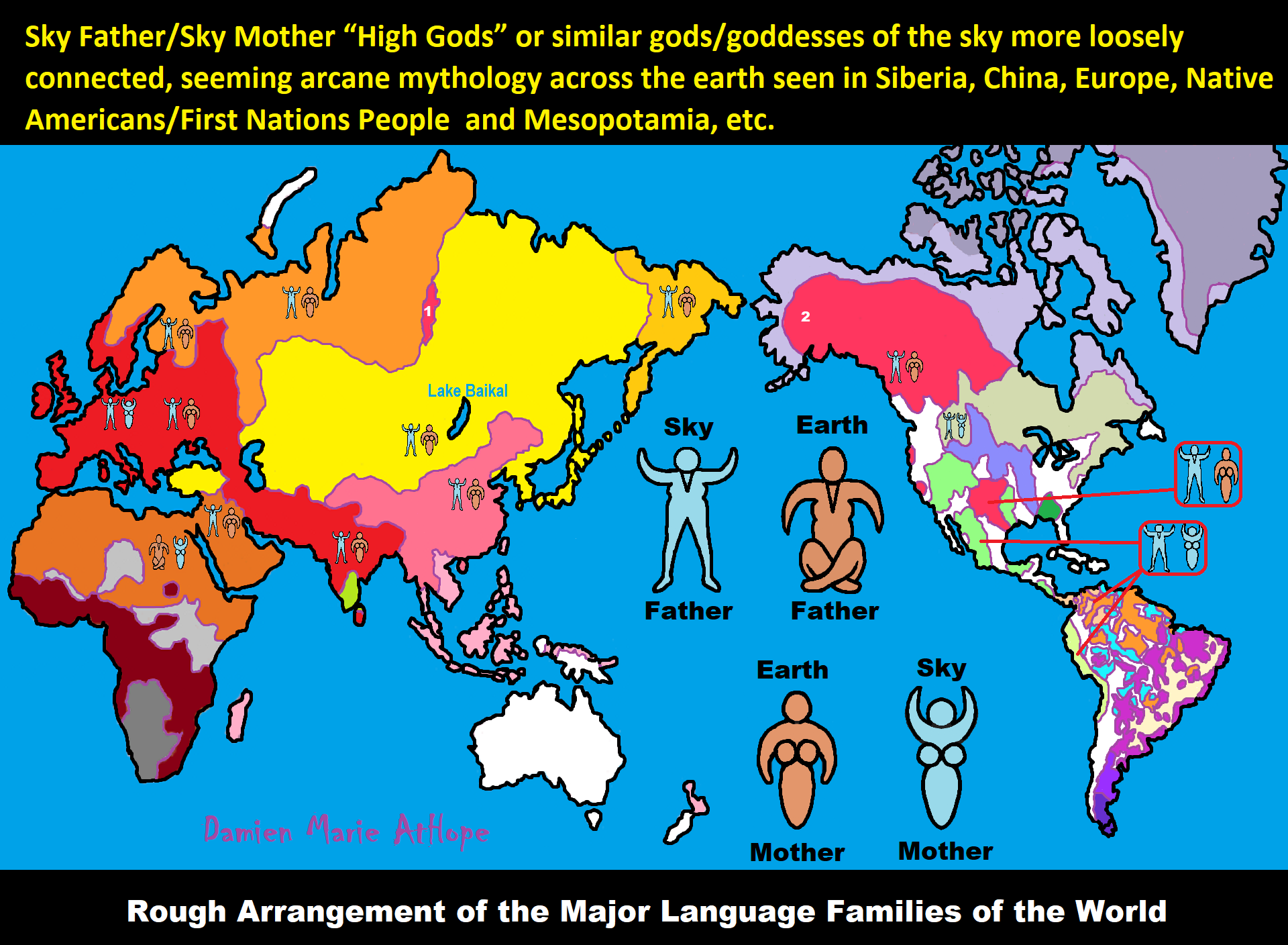
ref, ref, ref, ref, ref, ref, ref, ref, ref, ref, ref, ref, ref, ref, ref, ref, ref
“These ideas are my speculations from the evidence.”
I am still researching the “god‘s origins” all over the world. So you know, it is very complicated but I am smart and willing to look, DEEP, if necessary, which going very deep does seem to be needed here, when trying to actually understand the evolution of gods and goddesses. I am sure of a few things and less sure of others, but even in stuff I am not fully grasping I still am slowly figuring it out, to explain it to others. But as I research more I am understanding things a little better, though I am still working on understanding it all or something close and thus always figuring out more.
Sky Father/Sky God?
“Egyptian: (Nut) Sky Mother and (Geb) Earth Father” (Egypt is different but similar)
Turkic/Mongolic: (Tengri/Tenger Etseg) Sky Father and (Eje/Gazar Eej) Earth Mother *Transeurasian*
Hawaiian: (Wākea) Sky Father and (Papahānaumoku) Earth Mother *Austronesian*
New Zealand/ Māori: (Ranginui) Sky Father and (Papatūānuku) Earth Mother *Austronesian*
Proto-Indo-European: (Dyḗus/Dyḗus ph₂tḗr) Sky Father and (Dʰéǵʰōm/Pleth₂wih₁) Earth Mother
Indo-Aryan: (Dyaus Pita) Sky Father and (Prithvi Mata) Earth Mother *Indo-European*
Italic: (Jupiter) Sky Father and (Juno) Sky Mother *Indo-European*
Etruscan: (Tinia) Sky Father and (Uni) Sky Mother *Tyrsenian/Italy Pre–Indo-European*
Hellenic/Greek: (Zeus) Sky Father and (Hera) Sky Mother who started as an “Earth Goddess” *Indo-European*
Nordic: (Dagr) Sky Father and (Nótt) Sky Mother *Indo-European*
Slavic: (Perun) Sky Father and (Mokosh) Earth Mother *Indo-European*
Illyrian: (Deipaturos) Sky Father and (Messapic Damatura’s “earth-mother” maybe) Earth Mother *Indo-European*
Albanian: (Zojz) Sky Father and (?) *Indo-European*
Baltic: (Perkūnas) Sky Father and (Saulė) Sky Mother *Indo-European*
Germanic: (Týr) Sky Father and (?) *Indo-European*
Colombian-Muisca: (Bochica) Sky Father and (Huythaca) Sky Mother *Chibchan*
Aztec: (Quetzalcoatl) Sky Father and (Xochiquetzal) Sky Mother *Uto-Aztecan*
Incan: (Viracocha) Sky Father and (Mama Runtucaya) Sky Mother *Quechuan*
China: (Tian/Shangdi) Sky Father and (Dì) Earth Mother *Sino-Tibetan*
Sumerian, Assyrian and Babylonian: (An/Anu) Sky Father and (Ki) Earth Mother
Finnish: (Ukko) Sky Father and (Akka) Earth Mother *Finno-Ugric*
Sami: (Horagalles) Sky Father and (Ravdna) Earth Mother *Finno-Ugric*
Puebloan-Zuni: (Ápoyan Ta’chu) Sky Father and (Áwitelin Tsíta) Earth Mother
Puebloan-Hopi: (Tawa) Sky Father and (Kokyangwuti/Spider Woman/Grandmother) Earth Mother *Uto-Aztecan*
Puebloan-Navajo: (Tsohanoai) Sky Father and (Estsanatlehi) Earth Mother *Na-Dene*
ref, ref, ref, ref, ref, ref, ref, ref, ref, ref, ref, ref, ref, ref, ref, ref, ref, ref, ref, ref, ref, ref, ref, ref, ref, ref, ref

Hinduism around 3,700 to 3,500 years old. ref
Judaism around 3,450 or 3,250 years old. (The first writing in the bible was “Paleo-Hebrew” dated to around 3,000 years ago Khirbet Qeiyafa is the site of an ancient fortress city overlooking the Elah Valley. And many believe the religious Jewish texts were completed around 2,500) ref, ref
Judaism is around 3,450 or 3,250 years old. (“Paleo-Hebrew” 3,000 years ago and Torah 2,500 years ago)
“Judaism is an Abrahamic, its roots as an organized religion in the Middle East during the Bronze Age. Some scholars argue that modern Judaism evolved from Yahwism, the religion of ancient Israel and Judah, by the late 6th century BCE, and is thus considered to be one of the oldest monotheistic religions.” ref
“Yahwism is the name given by modern scholars to the religion of ancient Israel, essentially polytheistic, with a plethora of gods and goddesses. Heading the pantheon was Yahweh, the national god of the Israelite kingdoms of Israel and Judah, with his consort, the goddess Asherah; below them were second-tier gods and goddesses such as Baal, Shamash, Yarikh, Mot, and Astarte, all of whom had their own priests and prophets and numbered royalty among their devotees, and a third and fourth tier of minor divine beings, including the mal’ak, the messengers of the higher gods, who in later times became the angels of Judaism, Christianity and Islam. Yahweh, however, was not the ‘original’ god of Israel “Isra-El”; it is El, the head of the Canaanite pantheon, whose name forms the basis of the name “Israel”, and none of the Old Testament patriarchs, the tribes of Israel, the Judges, or the earliest monarchs, have a Yahwistic theophoric name (i.e., one incorporating the name of Yahweh).” ref
“El is a Northwest Semitic word meaning “god” or “deity“, or referring (as a proper name) to any one of multiple major ancient Near Eastern deities. A rarer form, ‘ila, represents the predicate form in Old Akkadian and in Amorite. The word is derived from the Proto-Semitic *ʔil-, meaning “god”. Specific deities known as ‘El or ‘Il include the supreme god of the ancient Canaanite religion and the supreme god of East Semitic speakers in Mesopotamia’s Early Dynastic Period. ʼĒl is listed at the head of many pantheons. In some Canaanite and Ugaritic sources, ʼĒl played a role as father of the gods, of creation, or both. For example, in the Ugaritic texts, ʾil mlk is understood to mean “ʼĒl the King” but ʾil hd as “the god Hadad“. The Semitic root ʾlh (Arabic ʾilāh, Aramaic ʾAlāh, ʾElāh, Hebrew ʾelōah) may be ʾl with a parasitic h, and ʾl may be an abbreviated form of ʾlh. In Ugaritic the plural form meaning “gods” is ʾilhm, equivalent to Hebrew ʾelōhîm “powers”. In the Hebrew texts this word is interpreted as being semantically singular for “god” by biblical commentators. However the documentary hypothesis for the Old Testament (corresponds to the Jewish Torah) developed originally in the 1870s, identifies these that different authors – the Jahwist, Elohist, Deuteronomist, and the Priestly source – were responsible for editing stories from a polytheistic religion into those of a monotheistic religion. Inconsistencies that arise between monotheism and polytheism in the texts are reflective of this hypothesis.” ref
Jainism around 2,599 – 2,527 years old. ref
Confucianism around 2,600 – 2,551 years old. ref
Buddhism around 2,563/2,480 – 2,483/2,400 years old. ref
Christianity around 2,o00 years old. ref
Shinto around 1,305 years old. ref
Islam around 1407–1385 years old. ref
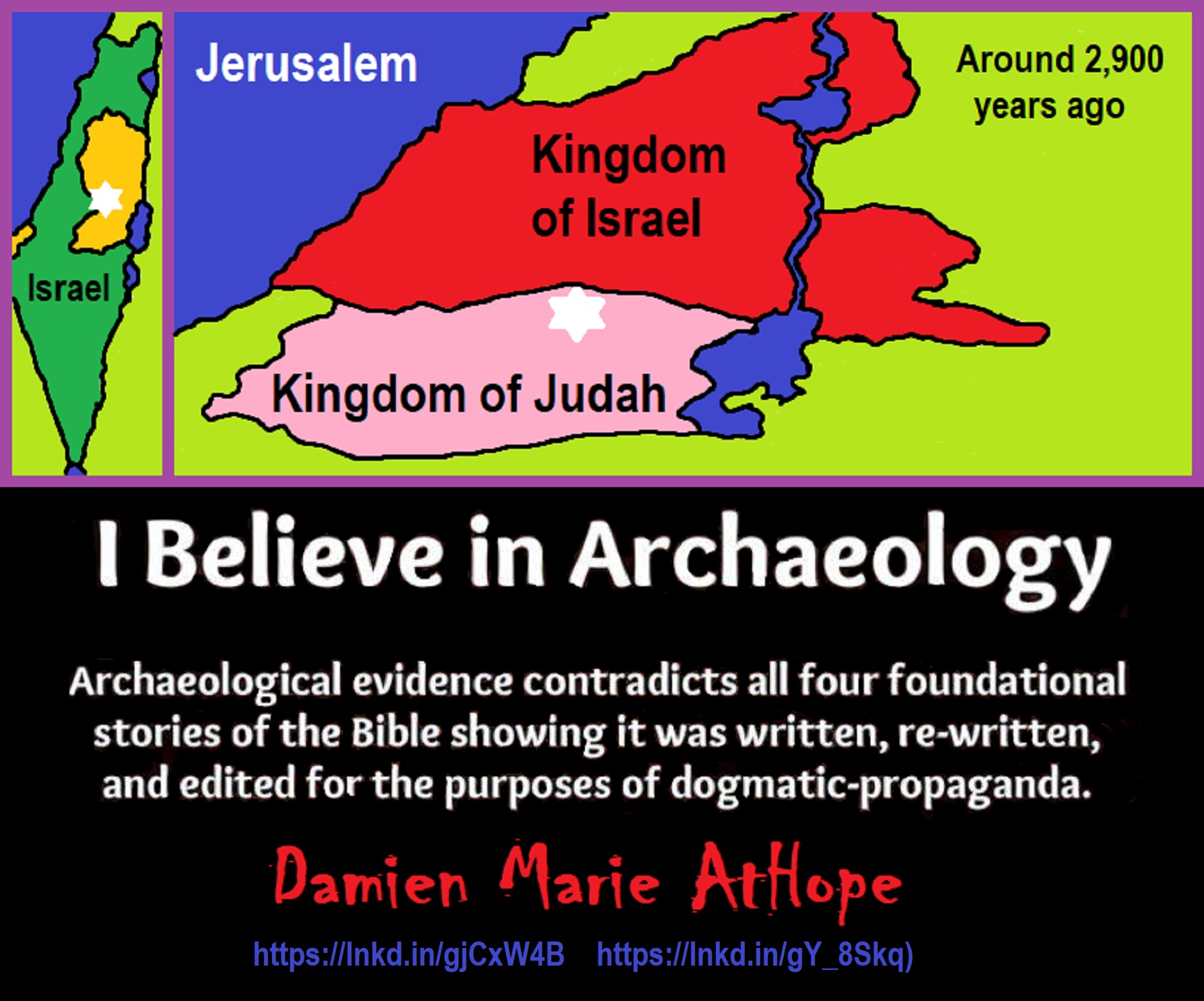
Knowledge to Ponder:
Stars/Astrology:
- Possibly, around 30,000 years ago (in simpler form) to 6,000 years ago, Stars/Astrology are connected to Ancestors, Spirit Animals, and Deities.
- The star also seems to be a possible proto-star for Star of Ishtar, Star of Inanna, or Star of Venus.
- Around 7,000 to 6,000 years ago, Star Constellations/Astrology have connections to the “Kurgan phenomenon” of below-ground “mound” stone/wood burial structures and “Dolmen phenomenon” of above-ground stone burial structures.
- Around 6,500–5,800 years ago, The Northern Levant migrations into Jordon and Israel in the Southern Levant brought new cultural and religious transfer from Turkey and Iran.
- “The Ghassulian Star,” a mysterious 6,000-year-old mural from Jordan may have connections to the European paganstic kurgan/dolmens phenomenon.
“Astrology is a range of divinatory practices, recognized as pseudoscientific since the 18th century, that claim to discern information about human affairs and terrestrial events by studying the apparent positions of celestial objects. Different cultures have employed forms of astrology since at least the 2nd millennium BCE, these practices having originated in calendrical systems used to predict seasonal shifts and to interpret celestial cycles as signs of divine communications. Most, if not all, cultures have attached importance to what they observed in the sky, and some—such as the Hindus, Chinese, and the Maya—developed elaborate systems for predicting terrestrial events from celestial observations. Western astrology, one of the oldest astrological systems still in use, can trace its roots to 19th–17th century BCE Mesopotamia, from where it spread to Ancient Greece, Rome, the Islamicate world and eventually Central and Western Europe. Contemporary Western astrology is often associated with systems of horoscopes that purport to explain aspects of a person’s personality and predict significant events in their lives based on the positions of celestial objects; the majority of professional astrologers rely on such systems.” ref
Around 5,500 years ago, Science evolves, The first evidence of science was 5,500 years ago and was demonstrated by a body of empirical, theoretical, and practical knowledge about the natural world. ref
Around 5,000 years ago, Origin of Logics is a Naturalistic Observation (principles of valid reasoning, inference, & demonstration) ref
Around 4,150 to 4,000 years ago: The earliest surviving versions of the Sumerian Epic of Gilgamesh, which was originally titled “He who Saw the Deep” (Sha naqba īmuru) or “Surpassing All Other Kings” (Shūtur eli sharrī) were written. ref
Hinduism:
- 3,700 years ago or so, the oldest of the Hindu Vedas (scriptures), the Rig Veda was composed.
- 3,500 years ago or so, the Vedic Age began in India after the collapse of the Indus Valley Civilization.
Judaism:
- around 3,000 years ago, the first writing in the bible was “Paleo-Hebrew”
- around 2,500 years ago, many believe the religious Jewish texts were completed
Myths: The bible inspired religion is not just one religion or one myth but a grouping of several religions and myths
- Around 3,450 or 3,250 years ago, according to legend, is the traditionally accepted period in which the Israelite lawgiver, Moses, provided the Ten Commandments.
- Around 2,500 to 2,400 years ago, a collection of ancient religious writings by the Israelites based primarily upon the Hebrew Bible, Tanakh, or Old Testament is the first part of Christianity’s bible.
- Around 2,400 years ago, the most accepted hypothesis is that the canon was formed in stages, first the Pentateuch (Torah).
- Around 2,140 to 2,116 years ago, the Prophets was written during the Hasmonean dynasty, and finally the remaining books.
- Christians traditionally divide the Old Testament into four sections:
- The first five books or Pentateuch (Torah).
- The proposed history books telling the history of the Israelites from their conquest of Canaan to their defeat and exile in Babylon.
- The poetic and proposed “Wisdom books” dealing, in various forms, with questions of good and evil in the world.
- The books of the biblical prophets, warning of the consequences of turning away from God:
- Henotheism:
- Exodus 20:23 “You shall not make other gods besides Me (not saying there are no other gods just not to worship them); gods of silver or gods of gold, you shall not make for yourselves.”
- Polytheism:
- Judges 10:6 “Then the sons of Israel again did evil in the sight of the LORD, served the Baals and the Ashtaroth, the gods of Aram, the gods of Sidon, the gods of Moab, the gods of the sons of Ammon, and the gods of the Philistines; thus they forsook the LORD and did not serve Him.”
- 1 Corinthians 8:5 “For even if there are so-called gods whether in heaven or on earth, as indeed there are many gods and many lords.”
- Monotheism:
- Isaiah 43:10 “You are my witnesses,” declares the LORD, “and my servant whom I have chosen, so that you may know and believe me and understand that I am he. Before me no god was formed, nor will there be one after me.
Around 2,570 to 2,270 Years Ago, there is a confirmation of atheistic doubting as well as atheistic thinking, mainly by Greek philosophers. However, doubting gods is likely as old as the invention of gods and should destroy the thinking that belief in god(s) is the “default belief”. The Greek word is apistos (a “not” and pistos “faithful,”), thus not faithful or faithless because one is unpersuaded and unconvinced by a god(s) claim. Short Definition: unbelieving, unbeliever, or unbelief.
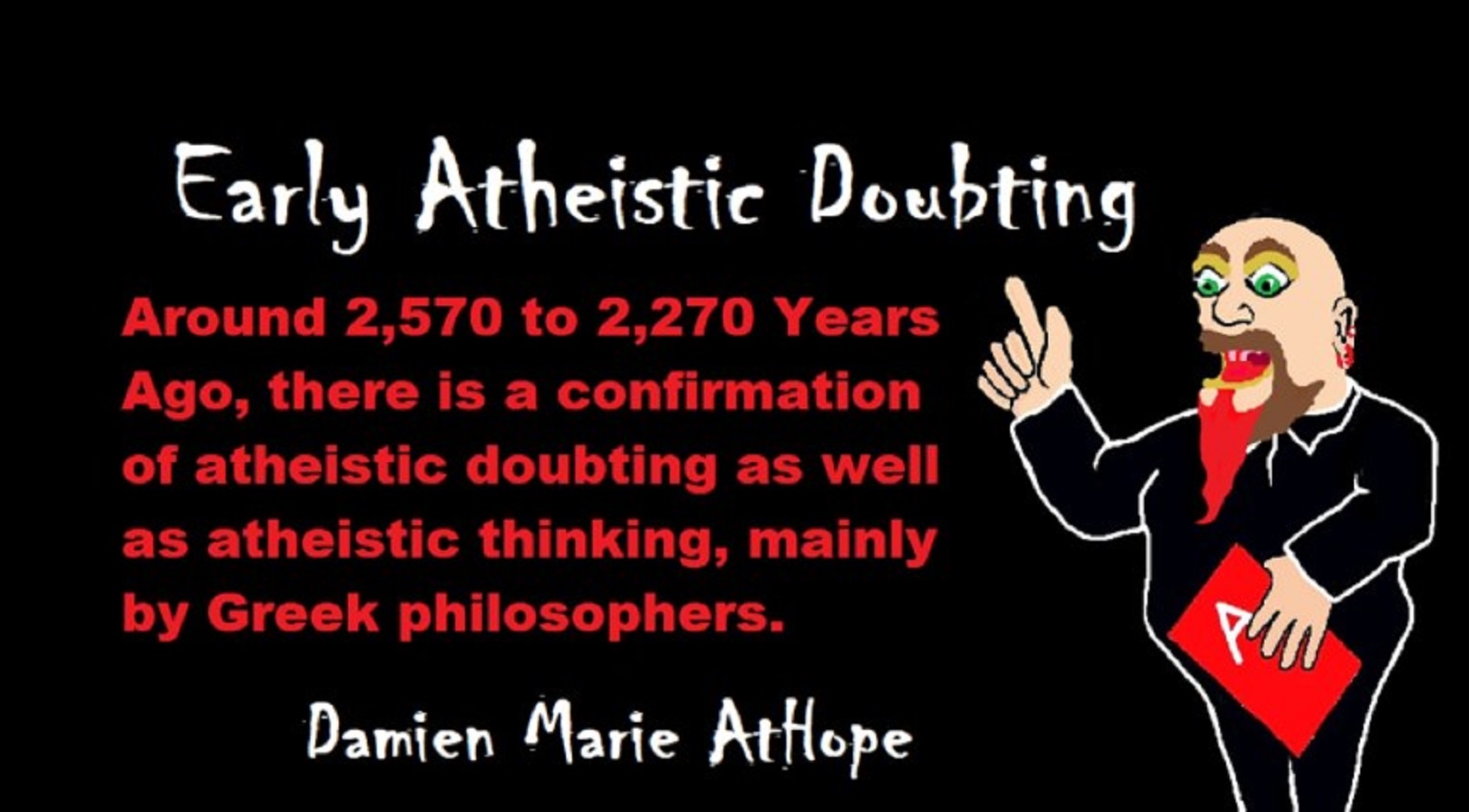
Expressions of Atheistic Thinking:
- Around 2,600 years ago, Ajita Kesakambali, ancient Indian philosopher, who is the first known proponent of Indian materialism. ref
- Around 2,535 to 2,475 years ago, Heraclitus, Greek pre-Socratic philosopher, a native of the Greek city Ephesus, Ionia, on the coast of Anatolia, also known as Asia Minor or modern Turkey. ref
- Around 2,500 to 2,400 years ago, according to The Story of Civilization book series certain African pygmy tribes have no identifiable gods, spirits, or religious beliefs or rituals, and even what burials accrue are without ceremony. ref
- Around 2,490 to 2,430 years ago, Empedocles, Greek pre-Socratic philosopher and a citizen of Agrigentum, a Greek city in Sicily. ref
- Around 2,460 to 2,370 years ago, Democritus, Greek pre-Socratic philosopher considered to be the “father of modern science” possibly had some disbelief amounting to atheism. ref
- Around 2,399 years ago or so, Socrates, a famous Greek philosopher was tried for sinfulness by teaching doubt of state gods. ref
- Around 2,341 to 2,270 years ago, Epicurus, a Greek philosopher known for composing atheistic critics and famously stated, “Is God willing to prevent evil, but not able? Then he is not omnipotent. Is he able, but not willing? Then he is malevolent. Is he both able and willing? Then whence cometh evil? Is he neither able nor willing? Then why call him god?” ref
This last expression by Epicurus, seems to be an expression of Axiological Atheism. To understand and utilize value or actually possess “Value Conscious/Consciousness” to both give a strong moral “axiological” argument (the problem of evil) as well as use it to fortify humanism and positive ethical persuasion of human helping and care responsibilities. Because value-blindness gives rise to sociopathic/psychopathic evil.

“Theists, there has to be a god, as something can not come from nothing.”
Well, thus something (unknown) happened and then there was something. This does not tell us what the something that may have been involved with something coming from nothing. A supposed first cause, thus something (unknown) happened and then there was something is not an open invitation to claim it as known, neither is it justified to call or label such an unknown as anything, especially an unsubstantiated magical thinking belief born of mythology and religious storytelling.
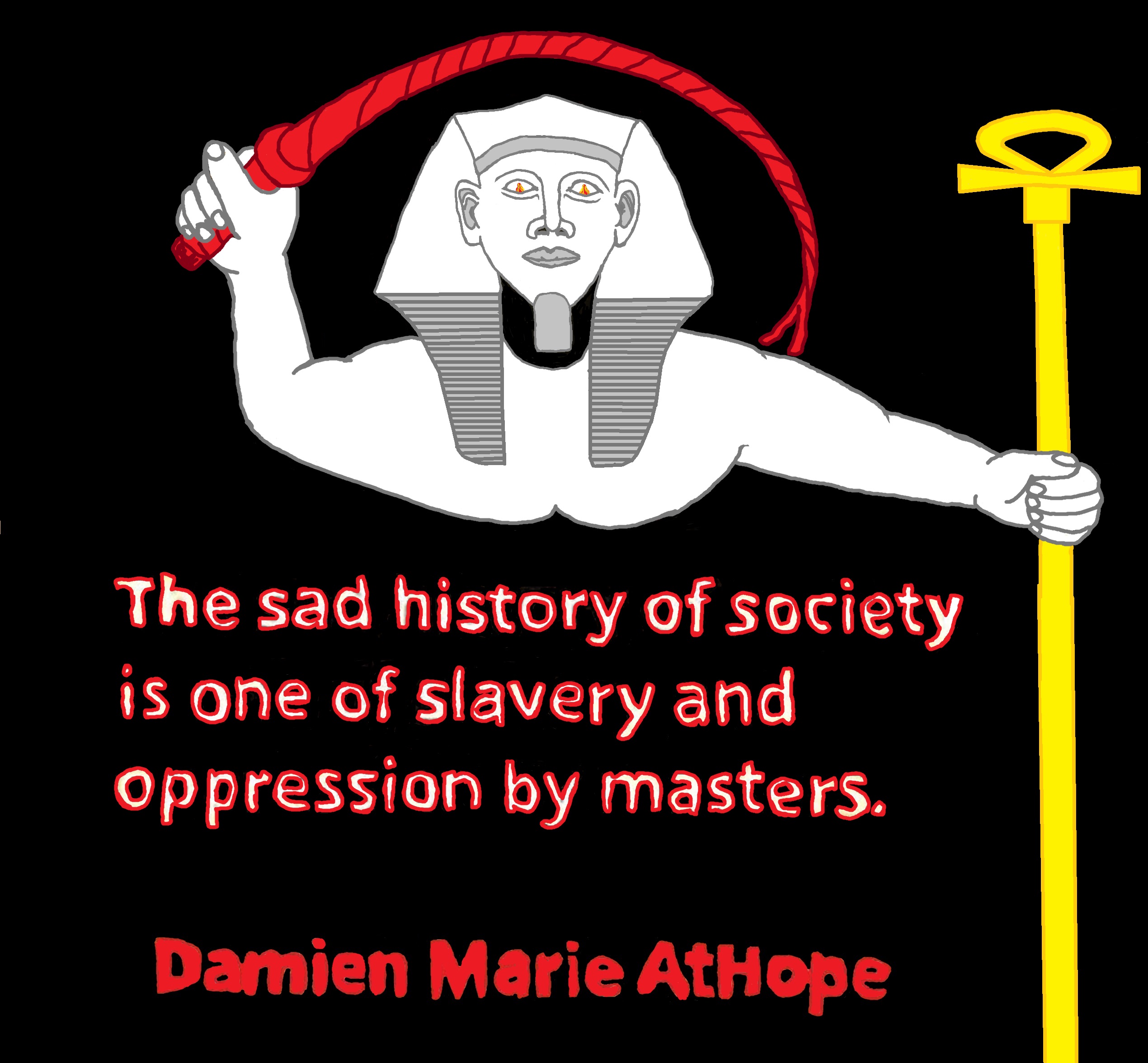
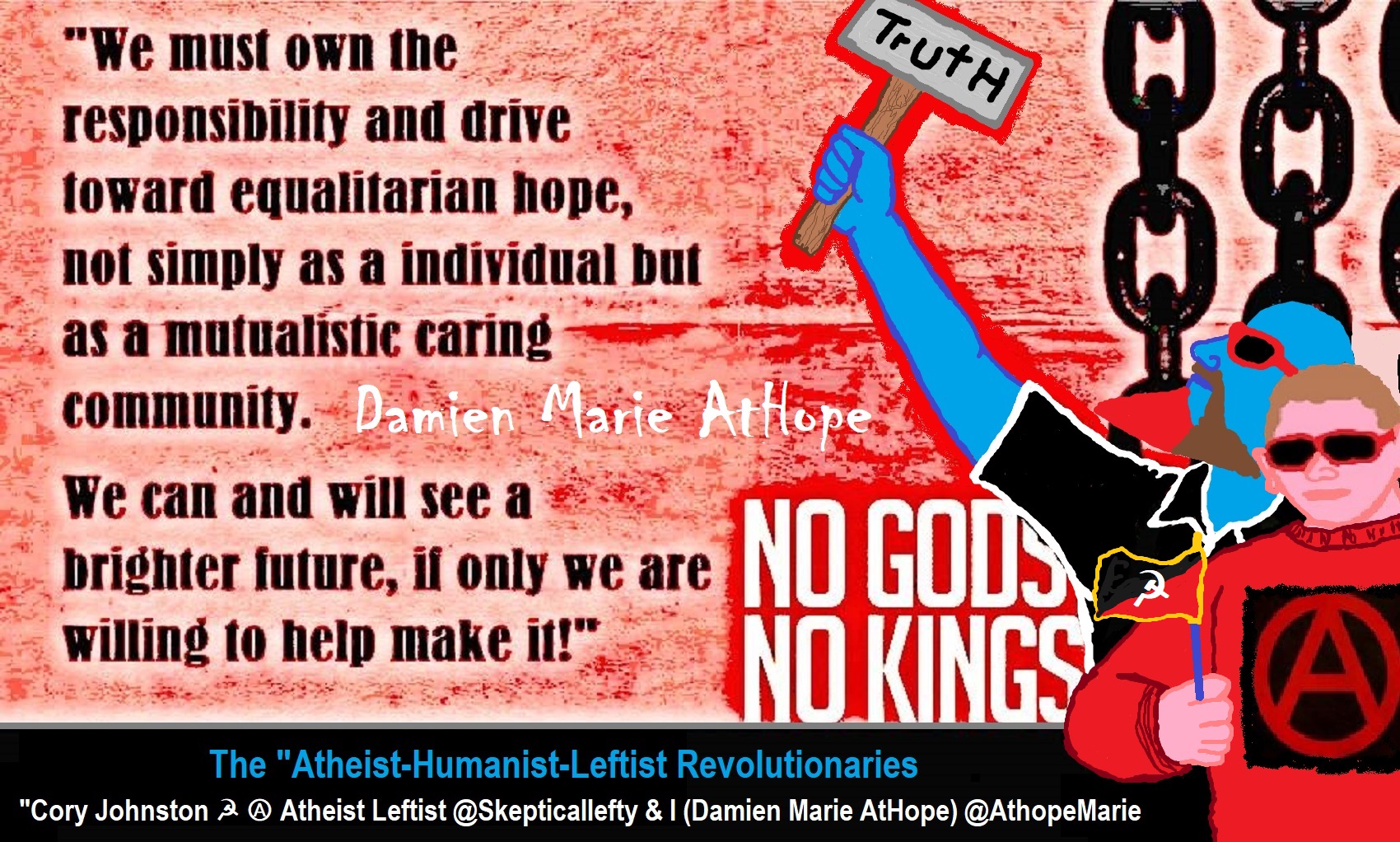
While hallucinogens are associated with shamanism, it is alcohol that is associated with paganism.
The Atheist-Humanist-Leftist Revolutionaries Shows in the prehistory series:
Show two: Pre-animism 300,000 years old and animism 100,000 years old: related to “Anarchism and Socialism”
Show tree: Totemism 50,000 years old: related to “Anarchism and Socialism”
Show four: Shamanism 30,000 years old: related to “Anarchism and Socialism”
Show five: Paganism 12,000 years old: related to “Anarchism and Socialism”
Show six: Emergence of hierarchy, sexism, slavery, and the new male god dominance: Paganism 7,000-5,000 years old: related to “Anarchism and Socialism” (Capitalism) (World War 0) Elite and their slaves!
Prehistory: related to “Anarchism and Socialism” the division of labor, power, rights, and recourses: VIDEO
Pre-animism 300,000 years old and animism 100,000 years old: related to “Anarchism and Socialism”: VIDEO
Totemism 50,000 years old: related to “Anarchism and Socialism”: VIDEO
Shamanism 30,000 years old: related to “Anarchism and Socialism”: VIDEO
Paganism 12,000 years old: related to “Anarchism and Socialism” (Pre-Capitalism): VIDEO
Paganism 7,000-5,000 years old: related to “Anarchism and Socialism” (Capitalism) (World War 0) Elite and their slaves: VIEDO
Paganism 5,000 years old: progressed organized religion and the state: related to “Anarchism and Socialism” (Kings and the Rise of the State): VIEDO
Paganism 4,000 years old: related to “Anarchism and Socialism” (First Moralistic gods, then the Origin time of Monotheism): VIEDO
I do not hate simply because I challenge and expose myths or lies any more than others being thought of as loving simply because of the protection and hiding from challenge their favored myths or lies.
The truth is best championed in the sunlight of challenge.
An archaeologist once said to me “Damien religion and culture are very different”
My response, So are you saying that was always that way, such as would you say Native Americans’ cultures are separate from their religions? And do you think it always was the way you believe?
I had said that religion was a cultural product. That is still how I see it and there are other archaeologists that think close to me as well. Gods too are the myths of cultures that did not understand science or the world around them, seeing magic/supernatural everywhere.
I personally think there is a goddess and not enough evidence to support a male god at Çatalhöyük but if there was both a male and female god and goddess then I know the kind of gods they were like Proto-Indo-European mythology.
This series idea was addressed in, Anarchist Teaching as Free Public Education or Free Education in the Public: VIDEO
Our 12 video series: Organized Oppression: Mesopotamian State Force and the Politics of power (9,000-4,000 years ago), is adapted from: The Complete and Concise History of the Sumerians and Early Bronze Age Mesopotamia (7000-2000 BC): https://www.youtube.com/watch?v=szFjxmY7jQA by “History with Cy“
Show #1: Mesopotamian State Force and the Politics of Power (Samarra, Halaf, Ubaid)
Show #2: Mesopotamian State Force and the Politics of Power
Show #3: Mesopotamian State Force and the Politics of Power (Uruk and the First Cities)
Show #4: Mesopotamian State Force and the Politics of Power (First Kings)
Show #5: Mesopotamian State Force and the Politics of Power (Early Dynastic Period)
Show #6: Mesopotamian State Force and the Politics of Power
Show #7: Mesopotamian State Force and the Politics of Power (Sargon and Akkadian Rule)
Show #9: Mesopotamian State Force and the Politics of Power (Gudea of Lagash and Utu-hegal)
Show #12: Mesopotamian State Force and the Politics of Power (Aftermath and Legacy of Sumer)
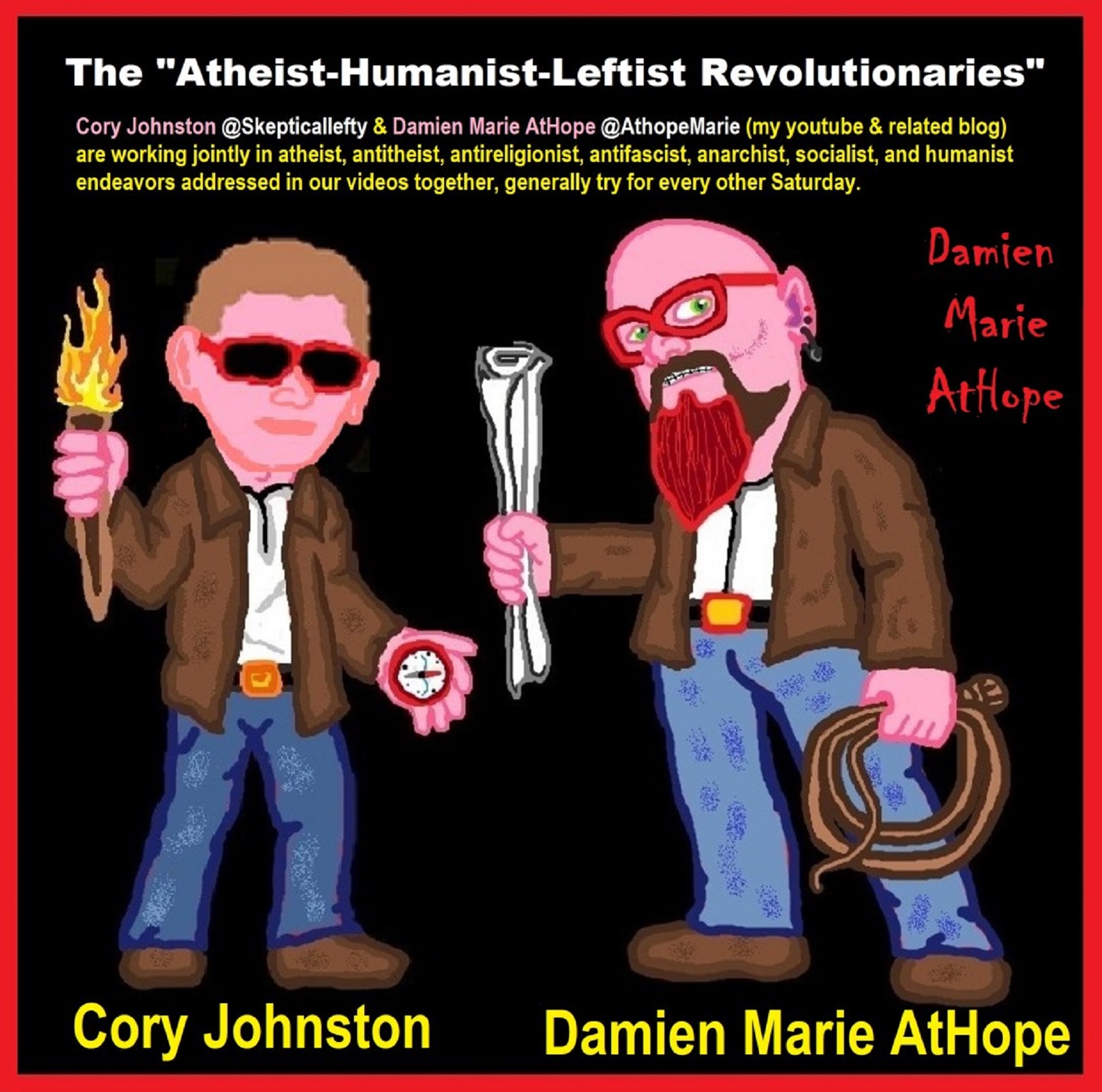
The “Atheist-Humanist-Leftist Revolutionaries”
Cory Johnston ☭ Ⓐ Atheist Leftist @Skepticallefty & I (Damien Marie AtHope) @AthopeMarie (my YouTube & related blog) are working jointly in atheist, antitheist, antireligionist, antifascist, anarchist, socialist, and humanist endeavors in our videos together, generally, every other Saturday.
Why Does Power Bring Responsibility?
Think, how often is it the powerless that start wars, oppress others, or commit genocide? So, I guess the question is to us all, to ask, how can power not carry responsibility in a humanity concept? I know I see the deep ethical responsibility that if there is power their must be a humanistic responsibility of ethical and empathic stewardship of that power. Will I be brave enough to be kind? Will I possess enough courage to be compassionate? Will my valor reach its height of empathy? I as everyone, earns our justified respect by our actions, that are good, ethical, just, protecting, and kind. Do I have enough self-respect to put my love for humanity’s flushing, over being brought down by some of its bad actors? May we all be the ones doing good actions in the world, to help human flourishing.
I create the world I want to live in, striving for flourishing. Which is not a place but a positive potential involvement and promotion; a life of humanist goal precision. To master oneself, also means mastering positive prosocial behaviors needed for human flourishing. I may have lost a god myth as an atheist, but I am happy to tell you, my friend, it is exactly because of that, leaving the mental terrorizer, god belief, that I truly regained my connected ethical as well as kind humanity.
Cory and I will talk about prehistory and theism, addressing the relevance to atheism, anarchism, and socialism.
At the same time as the rise of the male god, 7,000 years ago, there was also the very time there was the rise of violence, war, and clans to kingdoms, then empires, then states. It is all connected back to 7,000 years ago, and it moved across the world.
Cory Johnston: https://damienmarieathope.com/2021/04/cory-johnston-mind-of-a-skeptical-leftist/?v=32aec8db952d
The Mind of a Skeptical Leftist (YouTube)
Cory Johnston: Mind of a Skeptical Leftist @Skepticallefty
The Mind of a Skeptical Leftist By Cory Johnston: “Promoting critical thinking, social justice, and left-wing politics by covering current events and talking to a variety of people. Cory Johnston has been thoughtfully talking to people and attempting to promote critical thinking, social justice, and left-wing politics.” http://anchor.fm/skepticalleft
Cory needs our support. We rise by helping each other.
Cory Johnston ☭ Ⓐ @Skepticallefty Evidence-based atheist leftist (he/him) Producer, host, and co-host of 4 podcasts @skeptarchy @skpoliticspod and @AthopeMarie
Damien Marie AtHope (“At Hope”) Axiological Atheist, Anti-theist, Anti-religionist, Secular Humanist. Rationalist, Writer, Artist, Poet, Philosopher, Advocate, Activist, Psychology, and Armchair Archaeology/Anthropology/Historian.
Damien is interested in: Freedom, Liberty, Justice, Equality, Ethics, Humanism, Science, Atheism, Antiteism, Antireligionism, Ignosticism, Left-Libertarianism, Anarchism, Socialism, Mutualism, Axiology, Metaphysics, LGBTQI, Philosophy, Advocacy, Activism, Mental Health, Psychology, Archaeology, Social Work, Sexual Rights, Marriage Rights, Woman’s Rights, Gender Rights, Child Rights, Secular Rights, Race Equality, Ageism/Disability Equality, Etc. And a far-leftist, “Anarcho-Humanist.”
I am not a good fit in the atheist movement that is mostly pro-capitalist, I am anti-capitalist. Mostly pro-skeptic, I am a rationalist not valuing skepticism. Mostly pro-agnostic, I am anti-agnostic. Mostly limited to anti-Abrahamic religions, I am an anti-religionist.
To me, the “male god” seems to have either emerged or become prominent around 7,000 years ago, whereas the now favored monotheism “male god” is more like 4,000 years ago or so. To me, the “female goddess” seems to have either emerged or become prominent around 11,000-10,000 years ago or so, losing the majority of its once prominence around 2,000 years ago due largely to the now favored monotheism “male god” that grow in prominence after 4,000 years ago or so.
My Thought on the Evolution of Gods?
Animal protector deities from old totems/spirit animal beliefs come first to me, 13,000/12,000 years ago, then women as deities 11,000/10,000 years ago, then male gods around 7,000/8,000 years ago. Moralistic gods around 5,000/4,000 years ago, and monotheistic gods around 4,000/3,000 years ago.
To me, animal gods were likely first related to totemism animals around 13,000 to 12,000 years ago or older. Female as goddesses was next to me, 11,000 to 10,000 years ago or so with the emergence of agriculture. Then male gods come about 8,000 to 7,000 years ago with clan wars. Many monotheism-themed religions started in henotheism, emerging out of polytheism/paganism.
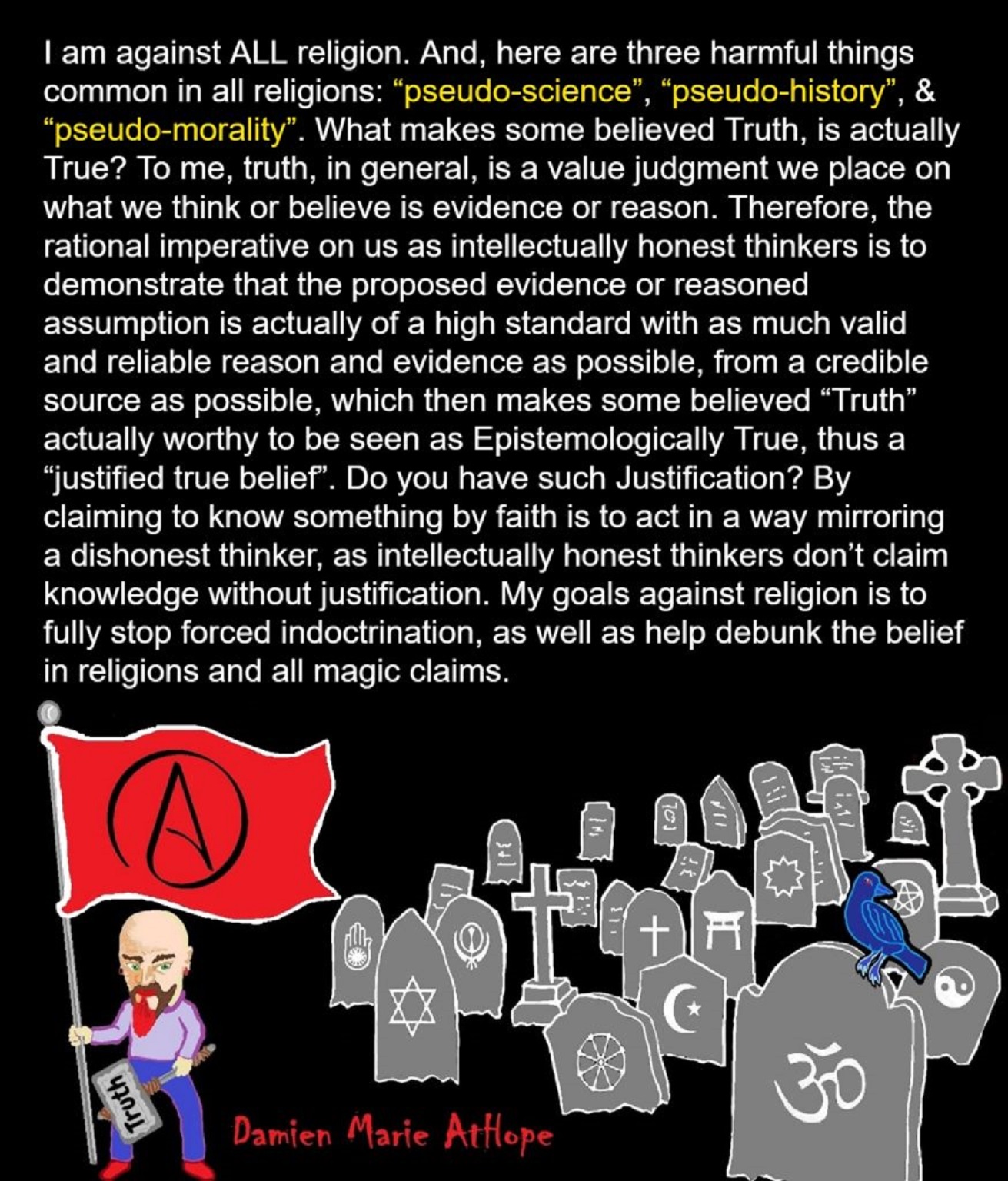

Damien Marie AtHope (Said as “At” “Hope”)/(Autodidact Polymath but not good at math):
Axiological Atheist, Anti-theist, Anti-religionist, Secular Humanist, Rationalist, Writer, Artist, Jeweler, Poet, “autodidact” Philosopher, schooled in Psychology, and “autodidact” Armchair Archaeology/Anthropology/Pre-Historian (Knowledgeable in the range of: 1 million to 5,000/4,000 years ago). I am an anarchist socialist politically. Reasons for or Types of Atheism
My Website, My Blog, & Short-writing or Quotes, My YouTube, Twitter: @AthopeMarie, and My Email: damien.marie.athope@gmail.com

